Organic Compound, Composition, Organic Optoelectronic Device, And Display Device
KIM; Byungku ; et al.
U.S. patent application number 16/630893 was filed with the patent office on 2020-05-21 for organic compound, composition, organic optoelectronic device, and display device. The applicant listed for this patent is SAMSUNG SDI CO., LTD. SAMSUNG ELECTRONICS CO., LTD.. Invention is credited to Dalho HUH, Jinseok JANG, Kipo JANG, Ho Kuk JUNG, Sung-Hyun JUNG, Giwook KANG, Byungku KIM, Hanill LEE, Hyungyu LEE, Min Seok SEO, Ji Hun SHIN.
| Application Number | 20200161564 16/630893 |
| Document ID | / |
| Family ID | 65900909 |
| Filed Date | 2020-05-21 |


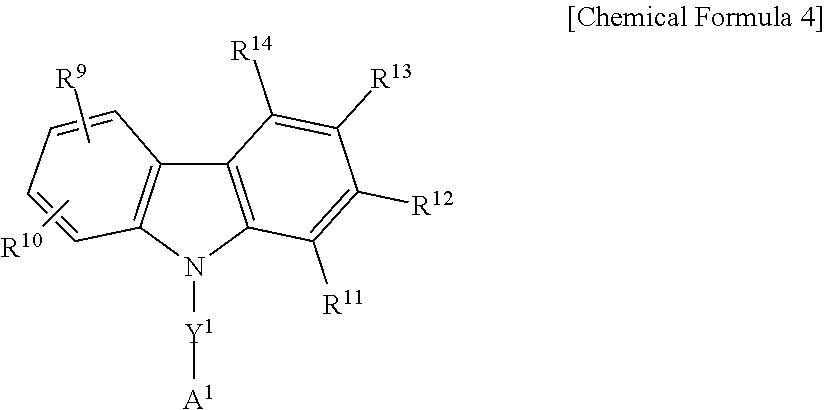

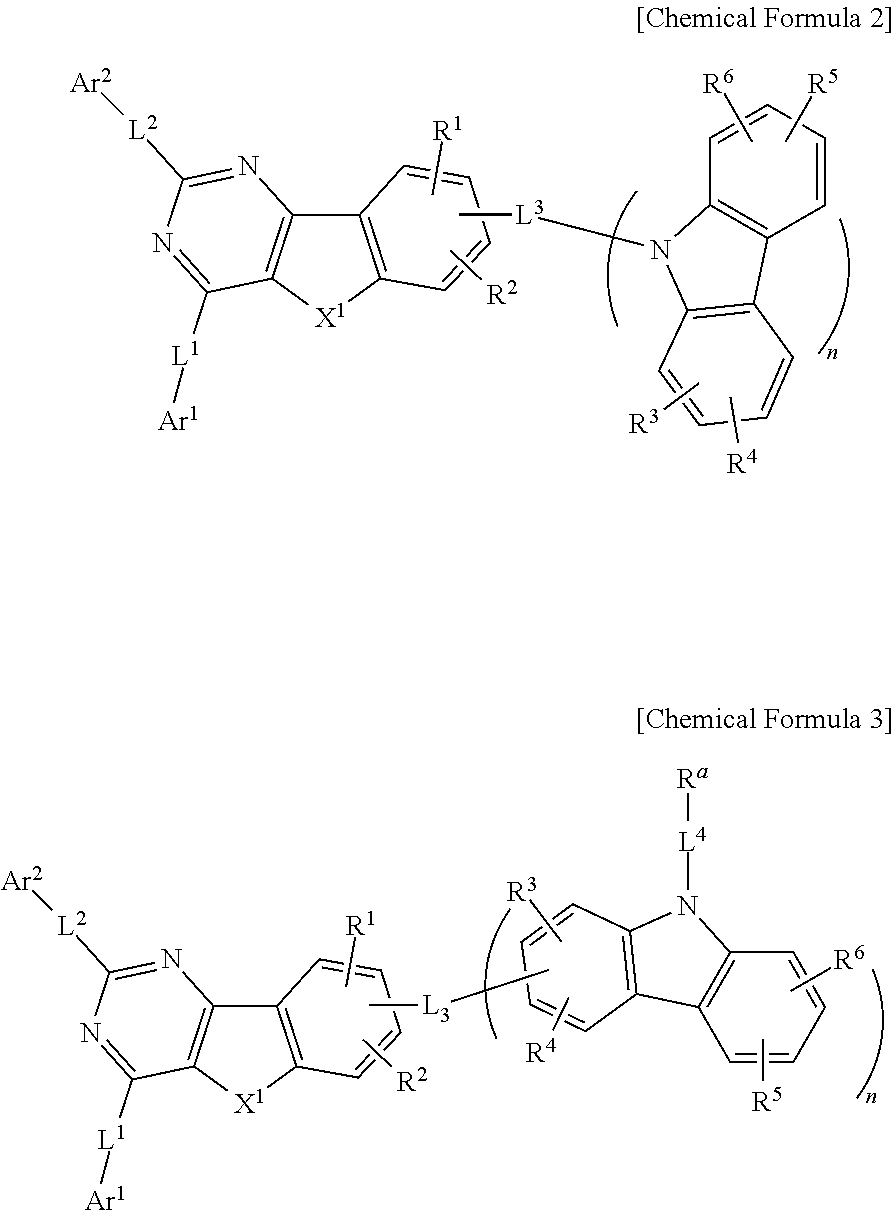


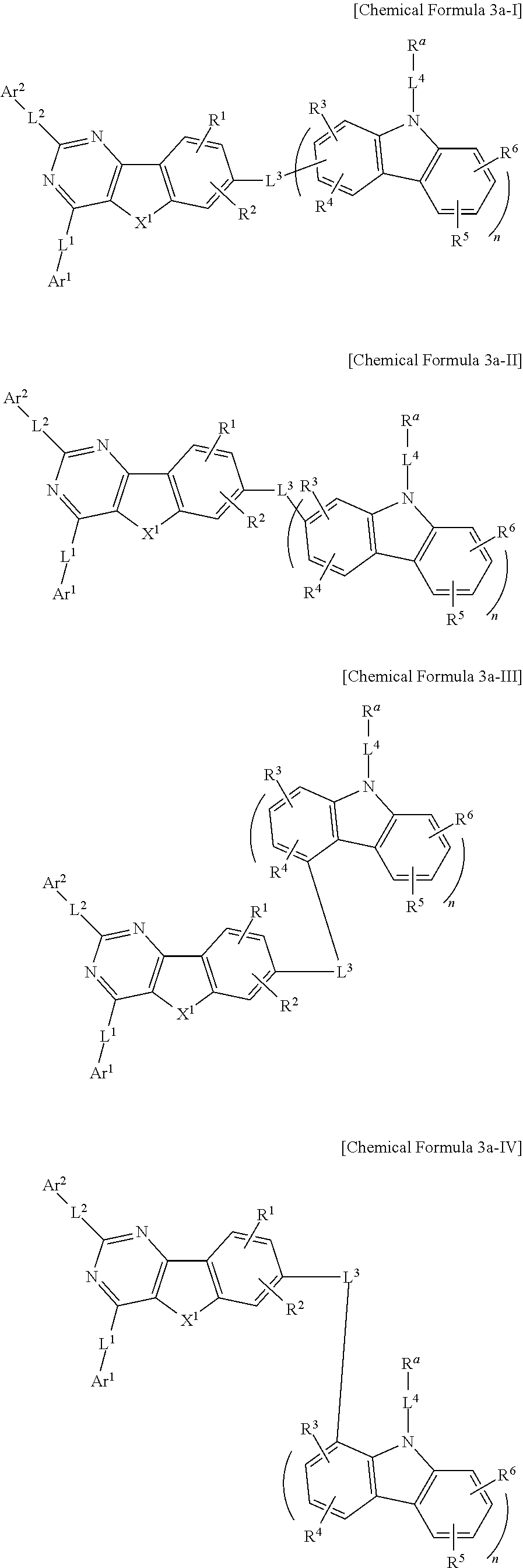
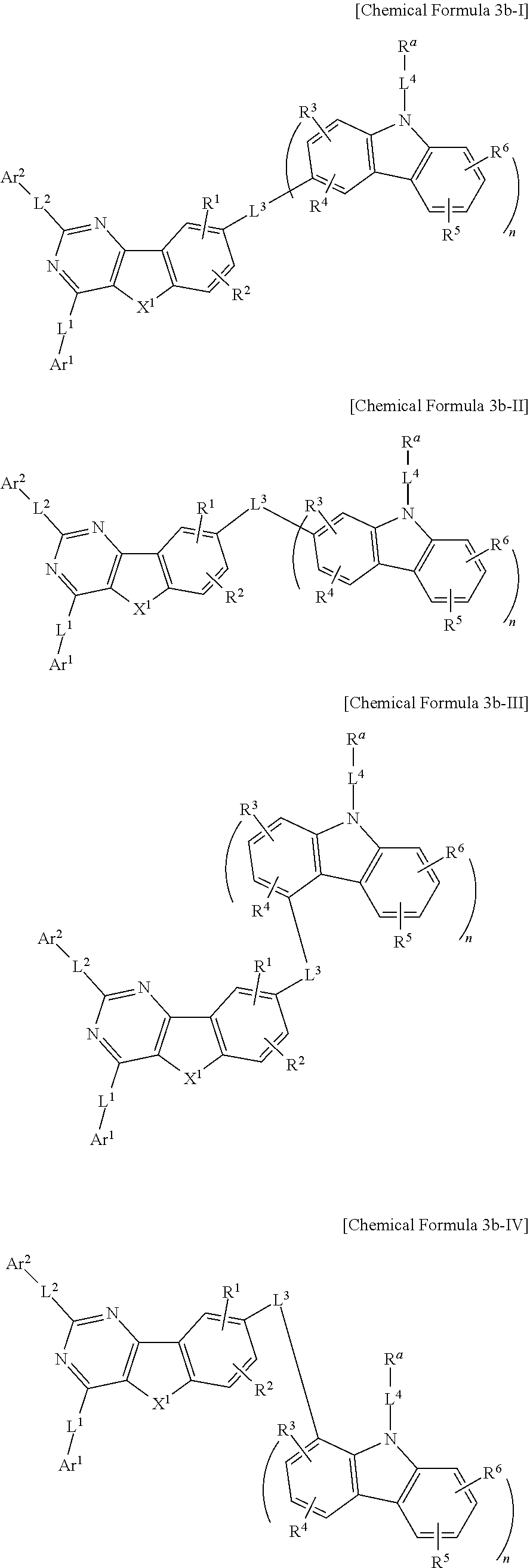
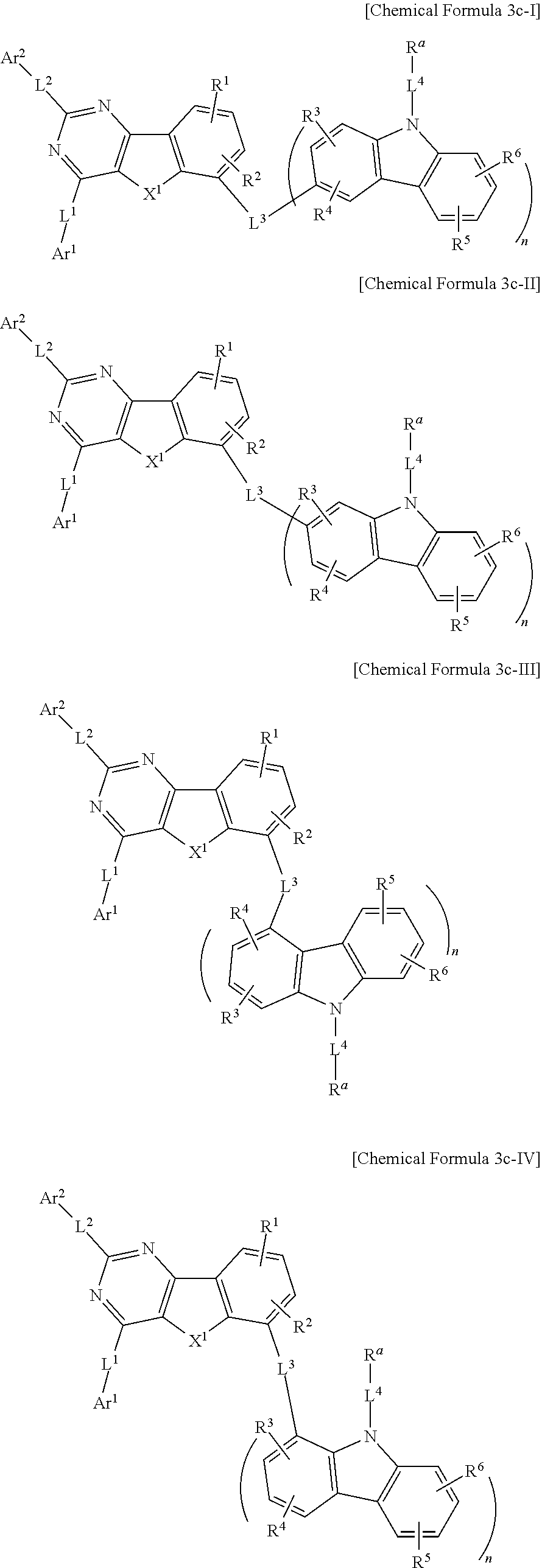

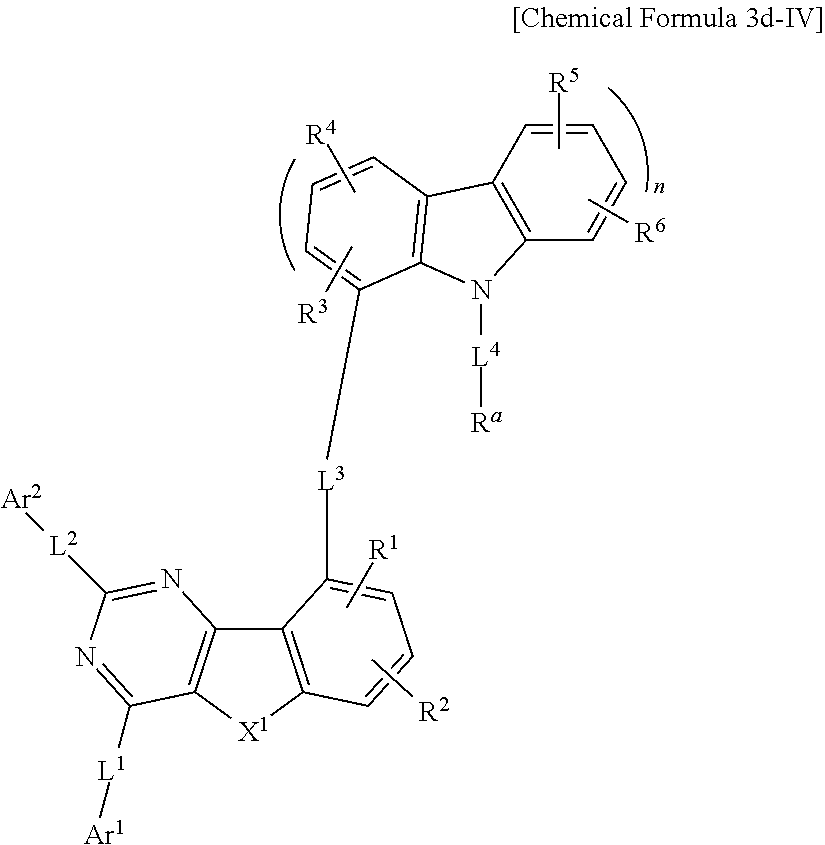
View All Diagrams
| United States Patent Application | 20200161564 |
| Kind Code | A1 |
| KIM; Byungku ; et al. | May 21, 2020 |
ORGANIC COMPOUND, COMPOSITION, ORGANIC OPTOELECTRONIC DEVICE, AND DISPLAY DEVICE
Abstract
Disclosed are an organic compound represented by Chemical Formula 1, a composition including the same, an organic optoelectronic device, and a display device. ##STR00001## In Chemical Formula 1, X.sup.1, Ar.sup.1, Ar.sup.2, L.sup.1 to L.sup.3, R.sup.1, R.sup.2, CBZ, and n are the same as described in the specification.
| Inventors: | KIM; Byungku; (Suwon-si, Gyeonggi-do, KR) ; KANG; Giwook; (Suwon-si, Gyeonggi-do, KR) ; LEE; Hanill; (Suwon-si, Gyeonggi-do, KR) ; JANG; Kipo; (Suwon-si, Gyeonggi-do, KR) ; JUNG; Sung-Hyun; (Suwon-si, Gyeonggi-do, KR) ; SEO; Min Seok; (Suwon-si, Gyeonggi-do, KR) ; SHIN; Ji Hun; (Suwon-si, Gyeonggi-do, KR) ; LEE; Hyungyu; (Suwon-si, Gyeonggi-do, KR) ; JANG; Jinseok; (Suwon-si, Gyeonggi-do, KR) ; JUNG; Ho Kuk; (Suwon-si, Gyeonggi-do, KR) ; HUH; Dalho; (Suwon-si, Gyeonggi-do, KR) | ||||||||||
| Applicant: |
|
||||||||||
|---|---|---|---|---|---|---|---|---|---|---|---|
| Family ID: | 65900909 | ||||||||||
| Appl. No.: | 16/630893 | ||||||||||
| Filed: | September 4, 2018 | ||||||||||
| PCT Filed: | September 4, 2018 | ||||||||||
| PCT NO: | PCT/KR2018/010304 | ||||||||||
| 371 Date: | January 14, 2020 |
| Current U.S. Class: | 1/1 |
| Current CPC Class: | H01L 2251/5384 20130101; H01L 51/5016 20130101; H01L 51/0071 20130101; C07D 495/04 20130101; H01L 51/0072 20130101; C07D 491/048 20130101 |
| International Class: | H01L 51/00 20060101 H01L051/00; C07D 495/04 20060101 C07D495/04; C07D 491/048 20060101 C07D491/048 |
Foreign Application Data
| Date | Code | Application Number |
|---|---|---|
| Sep 26, 2017 | KR | 10-2017-0124370 |
Claims
1. An organic compound represented by Chemical Formula 1: ##STR00310## wherein, in Chemical Formula 1, X.sup.1 is O or S, Ar.sup.1 and Ar.sup.2 are independently a substituted or unsubstituted C1 to C20 alkyl group, a substituted or unsubstituted C6 to C30 aryl group, a substituted or unsubstituted carbazolyl group, or a combination thereof, L.sup.1 and L.sup.2 are independently a single bond, a substituted or unsubstituted C1 to C20 alkylene group, a substituted or unsubstituted C6 to C30 arylene group, or a combination thereof, L.sup.3 is a substituted or unsubstituted C1 to C20 alkylene group, a substituted or unsubstituted C6 to C30 arylene group, or a combination thereof, R.sup.1 and R.sup.2 are independently hydrogen, deuterium, a substituted or unsubstituted C1 to C20 alkyl group, a substituted or unsubstituted C6 to C30 aryl group, a substituted or unsubstituted C3 to C30 heterocyclic group, a cyano group, or a combination thereof, CBZ is a substituted or unsubstituted carbazolyl group (except a carbazolyl group substituted with a carbazolyl group), and n is an integer of 0 to 3, provided that when n is 0, at least one of Ar.sup.1 and Ar.sup.2 is a substituted or unsubstituted carbazolyl group.
2. The organic compound of claim 1, wherein the organic compound is represented by Chemical Formula 2 or 3: ##STR00311## wherein, in Chemical Formula 2 or 3, X.sup.1 is O or S, Ar.sup.1 and Ar.sup.2 are independently a substituted or unsubstituted C1 to C20 alkyl group, a substituted or unsubstituted C6 to C30 aryl group, a substituted or unsubstituted carbazolyl group, or a combination thereof, L.sup.1 and L.sup.2 are independently a single bond, a substituted or unsubstituted C1 to C20 alkylene group, a substituted or unsubstituted C6 to C30 arylene group, or a combination thereof, L.sup.3 is a substituted or unsubstituted C1 to C20 alkylene group, a substituted or unsubstituted C6 to C30 arylene group, or a combination thereof, L.sup.4 is a single bond, a substituted or unsubstituted C1 to C20 alkylene group, a substituted or unsubstituted C6 to C30 arylene group, divalent substituted or unsubstituted C2 to C30 heterocyclic group (except a carbazolylene group), or a combination thereof, R.sup.1 to R.sup.6 and R.sup.a are independently hydrogen, deuterium, a substituted or unsubstituted C1 to C20 alkyl group, a substituted or unsubstituted C6 to C30 aryl group, a substituted or unsubstituted C3 to C30 heterocyclic group (except a carbazolyl group), a cyano group, or a combination thereof, and n is an integer of 0 to 3, provided that when n is 0, at least one of Ar.sup.1 and Ar.sup.2 is a substituted or unsubstituted carbazolyl group.
3. The organic compound of claim 2, wherein the organic compound represented by Chemical Formula 2 is represented by one of Chemical Formulae 2a to 2d: ##STR00312## wherein, in Chemical Formulae 2a to 2d, X.sup.1 is O or S, Ar.sup.1 and Ar.sup.2 are independently a substituted or unsubstituted C1 to C20 alkyl group, a substituted or unsubstituted C6 to C30 aryl group, a substituted or unsubstituted carbazolyl group, or a combination thereof, L.sup.1 and L.sup.2 are independently a single bond, a substituted or unsubstituted C1 to C20 alkylene group, a substituted or unsubstituted C6 to C30 arylene group, or a combination thereof, L.sup.3 is a substituted or unsubstituted C1 to C20 alkylene group, a substituted or unsubstituted C6 to C30 arylene group, or a combination thereof, R.sup.1 to R.sup.6 are independently hydrogen, deuterium, a substituted or unsubstituted C1 to C20 alkyl group, a substituted or unsubstituted C6 to C30 aryl group, a substituted or unsubstituted C3 to C30 heterocyclic group (except, a carbazolyl group), a cyano group, or a combination thereof, and n is an integer of 0 to 3, provided that when n is 0, at least one of A.sup.1 and Ar.sup.2 is a substituted or unsubstituted carbazolyl group.
4. The organic compound of claim 2, wherein the organic compound represented by Chemical Formula 3 is represented by one of Chemical Formulae 3a to 3d: ##STR00313## ##STR00314## wherein, in Chemical Formulae 3a to 3d, X.sup.1 is O or S, Ar.sup.1 and Ar.sup.2 are independently a substituted or unsubstituted C1 to C20 alkyl group, a substituted or unsubstituted C6 to C30 aryl group, a substituted or unsubstituted carbazolyl group, or a combination thereof, L.sup.1 and L.sup.2 are independently a single bond, a substituted or unsubstituted C1 to C20 alkylene group, a substituted or unsubstituted C6 to C30 arylene group, or a combination thereof, L.sup.3 is a substituted or unsubstituted C1 to C20 alkylene group, a substituted or unsubstituted C6 to C30 arylene group, or a combination thereof, L.sup.4 is a single bond, a substituted or unsubstituted C1 to C20 alkylene group, a substituted or unsubstituted C6 to C30 arylene group, a divalent substituted or unsubstituted C2 to C30 heterocyclic group (except a carbazolylene group), or a combination thereof, R.sup.1 to R.sup.6 and R.sup.a are independently hydrogen, deuterium, a substituted or unsubstituted C1 to C20 alkyl group, a substituted or unsubstituted C6 to C30 aryl group, a substituted or unsubstituted C3 to C30 heterocyclic group (except a carbazolyl group), a cyano group, or a combination thereof, and n is an integer of 0 to 3, provided that when n is 0, at least one of Ar.sup.1 and Ar.sup.2 is a substituted or unsubstituted carbazolyl group.
5. The organic compound of claim 1, wherein Ar.sup.1 and Ar.sup.2 are independently a substituted or unsubstituted phenyl group, a substituted or unsubstituted biphenyl group, a substituted or unsubstituted terphenyl group, a substituted or unsubstituted naphthyl group, a substituted or unsubstituted phenanthrenyl group, a substituted or unsubstituted anthracenyl group or a substituted or unsubstituted triphenylenyl group, wherein the "substituted" refers to replacement of at least one hydrogen by deuterium, a C1 to C20 alkyl group, a C6 to C12 aryl group, or a cyano group.
6. The organic compound of claim 1, wherein R.sup.1 to R.sup.6 and R.sup.a are independently hydrogen, deuterium, a substituted or unsubstituted phenyl group, a substituted or unsubstituted biphenyl group, a substituted or unsubstituted terphenyl group, a substituted or unsubstituted naphthyl group, a substituted or unsubstituted anthracenyl group, a substituted or unsubstituted phenanthrenyl group, a substituted or unsubstituted fluorenyl group, a substituted or unsubstituted triphenylene group, a substituted or unsubstituted dibenzothiophenyl group, a substituted or unsubstituted dibenzo furanyl group, or a combination thereof.
7. The organic compound of claim 1, wherein the organic compound is one of compounds listed in Group 1: ##STR00315## ##STR00316## ##STR00317## ##STR00318## ##STR00319## ##STR00320## ##STR00321## ##STR00322## ##STR00323## ##STR00324## ##STR00325## ##STR00326## ##STR00327## ##STR00328## ##STR00329## ##STR00330## ##STR00331## ##STR00332## ##STR00333## ##STR00334## ##STR00335## ##STR00336## ##STR00337## ##STR00338## ##STR00339## ##STR00340## ##STR00341## ##STR00342## ##STR00343## ##STR00344## ##STR00345## ##STR00346## ##STR00347## ##STR00348## ##STR00349## ##STR00350## ##STR00351## ##STR00352## ##STR00353## ##STR00354## ##STR00355## ##STR00356## ##STR00357## ##STR00358## ##STR00359## ##STR00360## ##STR00361## ##STR00362## ##STR00363## ##STR00364## ##STR00365## ##STR00366## ##STR00367## ##STR00368## ##STR00369## ##STR00370## ##STR00371## ##STR00372## ##STR00373## ##STR00374## ##STR00375## ##STR00376## ##STR00377## ##STR00378## ##STR00379## ##STR00380## ##STR00381## ##STR00382## ##STR00383## ##STR00384## ##STR00385## ##STR00386## ##STR00387## ##STR00388## ##STR00389## ##STR00390## ##STR00391## ##STR00392## ##STR00393## ##STR00394## ##STR00395## ##STR00396## ##STR00397## ##STR00398## ##STR00399## ##STR00400## ##STR00401## ##STR00402## ##STR00403## ##STR00404## ##STR00405## ##STR00406## ##STR00407## ##STR00408## ##STR00409## ##STR00410## ##STR00411## ##STR00412## ##STR00413## ##STR00414## ##STR00415## ##STR00416## ##STR00417## ##STR00418## ##STR00419## ##STR00420## ##STR00421## ##STR00422## ##STR00423## ##STR00424## ##STR00425## ##STR00426## ##STR00427## ##STR00428## ##STR00429## ##STR00430## ##STR00431## ##STR00432## ##STR00433## ##STR00434## ##STR00435## ##STR00436## ##STR00437## ##STR00438## ##STR00439## ##STR00440## ##STR00441## ##STR00442## ##STR00443## ##STR00444## ##STR00445## ##STR00446## ##STR00447## ##STR00448## ##STR00449## ##STR00450## ##STR00451##
8. A composition comprising the first organic compound, the first organic compound being the organic compound according to claim 1, and a second organic compound including a carbazole moiety represented by Chemical Formula 4. ##STR00452## wherein, in Chemical Formula 4, Y.sup.1 is a single bond, a substituted or unsubstituted C6 to C30 arylene group or divalent substituted or unsubstituted C2 to C30 heterocyclic group, A.sup.1 is a substituted or unsubstituted C6 to C30 aryl group, or a substituted or unsubstituted C2 to C30 heterocyclic group, R.sup.9 to R.sup.14 are independently hydrogen, deuterium, a substituted or unsubstituted C1 to C20 alkyl group, a substituted or unsubstituted C6 to C30 aryl group, or a substituted or unsubstituted C2 to C30 heterocyclic group, and R.sup.11 to R.sup.14 are independently present or adjacent groups of R.sup.11 to R.sup.14 are linked with each other to form a ring.
9. The composition of claim 8, wherein the second organic compound is represented by Chemical Formula 4A or a combination of Chemical Formulae 4B-1 and 4B-2: ##STR00453## wherein, in Chemical Formula 4A, Chemical Formula 4B-1, or Chemical Formula 4B-2, Y.sup.1 to Y.sup.3 are independently a single bond, a substituted or unsubstituted C6 to C30 arylene group, a divalent substituted or unsubstituted C2 to C30 heterocyclic group, or a combination thereof, A.sup.1 to A.sup.3 are independently a substituted or unsubstituted C6 to C30 aryl group, a substituted or unsubstituted C2 to C30 heterocyclic group, or a combination thereof, adjacent two *'s of Chemical Formula 4B-1 are bonded with two *'s of Chemical Formula 4B-2, the remaining two *'s of Chemical Formula 4B-1 are independently CR.sup.11, wherein R.sup.11 is the same or different, R.sup.9 to R.sup.11 and R.sup.15 to R.sup.19 are independently hydrogen, deuterium, a substituted or unsubstituted C1 to C20 alkyl group, a substituted or unsubstituted C6 to C30 aryl group, a substituted or unsubstituted C2 to C30 heterocyclic group, or a combination thereof, and m is an integer of 0 to 2.
10. The composition of claim 9, wherein A.sup.1 to A.sup.3 of Chemical Formula 4A, Chemical Formula 4B-1, and Chemical Formula 4B-2 are independently a substituted or unsubstituted phenyl group, a substituted or unsubstituted biphenyl group, a substituted or unsubstituted terphenyl group, a substituted or unsubstituted naphthyl group, a substituted or unsubstituted anthracenyl group, a substituted or unsubstituted phenanthrenyl group, a substituted or unsubstituted triphenylene group, a substituted or unsubstituted pyridinyl group, a substituted or unsubstituted dibenzothiophenyl group, a substituted or unsubstituted dibenzofuranyl group, a substituted or unsubstituted carbazolyl group, a substituted or unsubstituted fluorenyl group, or a combination thereof.
11. The composition of claim 9, wherein the second organic compound is represented by Chemical Formula 4A-1 or 4B-c: ##STR00454## wherein, in Chemical Formula 4A-1 and Chemical Formula 4B-c, Y.sup.1 to Y.sup.3 are independently a single bond, a substituted or unsubstituted C6 to C30 arylene group, a divalent substituted or unsubstituted C2 to C30 heterocyclic group, or a combination thereof, A.sup.1 to A.sup.3 are independently a substituted or unsubstituted phenyl group, a substituted or unsubstituted biphenyl group, a substituted or unsubstituted terphenyl group, a substituted or unsubstituted naphthyl group, a substituted or unsubstituted anthracenyl group, a substituted or unsubstituted phenanthrenyl group, a substituted or unsubstituted triphenylene group, a substituted or unsubstituted pyridinyl group, a substituted or unsubstituted dibenzothiophenyl group, a substituted or unsubstituted dibenzofuranyl group, a substituted or unsubstituted carbazolyl group, a substituted or unsubstituted fluorenyl group, or a combination thereof, and R.sup.9 to R.sup.11 and R.sup.15 to R.sup.19 are independently hydrogen, deuterium, a substituted or unsubstituted C1 to C20 alkyl group, a substituted or unsubstituted C6 to C30 aryl group, a substituted or unsubstituted C2 to C30 heterocyclic group or a combination thereof.
12. An organic optoelectronic device, comprising an anode and a cathode facing each other, and an organic layer disposed between the anode and the cathode wherein the organic layer comprises the organic compound of claim 1.
13. The organic optoelectronic device of claim 12, wherein the organic layer comprises a light emitting layer, and the organic compound is included as a host of the light emitting layer.
14. The organic optoelectronic device of claim 12, wherein the organic layer comprises a light emitting layer, and an electron auxiliary layer disposed between the cathode and the light emitting layer, wherein the electron auxiliary layer comprises the organic compound of claim 1.
15. A display device comprising the organic optoelectronic device of claim 12.
16. An organic optoelectronic device, comprising an anode and a cathode facing each other, and an organic layer disposed between the anode and the cathode wherein the organic layer comprises the composition of claim 8.
17. The organic optoelectronic device of claim 16, wherein the organic layer comprises a light emitting layer, and the composition is included as a host of the light emitting layer.
18. A display device comprising the organic optoelectronic device of claim 16.
Description
BACKGROUND OF THE INVENTION
(a) Field of the Invention
[0001] An organic compound, a composition, an organic optoelectronic device, and a display device are disclosed.
(b) Description of the Related Art
[0002] An organic optoelectronic device (organic optoelectronic diode) is a device that converts electrical energy into photoenergy, and vice versa.
[0003] An organic optoelectronic device may be classified as follows in accordance with its driving principles. One is a photoelectric device where excitons are generated by photoenergy, separated into electrons and holes, and are transferred to different electrodes to generate electrical energy, and the other is a light emitting device where a voltage or a current is supplied to an electrode to generate photoenergy from electrical energy.
[0004] Examples of the organic optoelectronic device may be an organic photoelectric device, an organic light emitting diode, an organic solar cell, and an organic photo conductor drum.
[0005] Of these, an organic light emitting diode (OLED) has recently drawn attention due to an increase in demand for flat panel displays. The organic light emitting diode converts electrical energy into light by applying current to an organic light emitting material and Performance of an organic light emitting diode may be affected by organic materials disposed between electrodes.
SUMMARY OF THE INVENTION
[0006] An embodiment provides an organic compound capable of realizing an organic optoelectronic device having high efficiency and a long life-span.
[0007] Another embodiment provides a composition capable of realizing an organic optoelectronic device having high efficiency and a long life-span.
[0008] Yet another embodiment provides an organic optoelectronic device including the organic compound or the composition.
[0009] Still another embodiment provides a display device including the organic optoelectronic device.
[0010] According to one embodiment, an organic compound represented by Chemical Formula 1 is provided.
##STR00002##
[0011] In Chemical Formula 1,
[0012] X.sup.1 is O or S,
[0013] Ar.sup.1 and Ar.sup.2 are independently a substituted or unsubstituted C1 to C20 alkyl group, a substituted or unsubstituted C6 to C30 aryl group, a substituted or unsubstituted carbazolyl group, or a combination thereof,
[0014] L.sup.1 and L.sup.2 are independently a single bond, a substituted or unsubstituted C1 to C20 alkylene group, a substituted or unsubstituted C6 to C30 arylene group, or a combination thereof,
[0015] L.sup.3 is a substituted or unsubstituted C1 to C20 alkylene group, a substituted or unsubstituted C6 to C30 arylene group, or a combination thereof,
[0016] R.sup.1 and R.sup.2 are independently hydrogen, deuterium, a substituted or unsubstituted C1 to C20 alkyl group, a substituted or unsubstituted C6 to C30 aryl group, a substituted or unsubstituted C3 to C30 heterocyclic group, a cyano group, or a combination thereof,
[0017] CBZ is a substituted or unsubstituted carbazolyl group (except a carbazolyl group substituted with a carbazolyl group), and
[0018] n is an integer of 0 to 3, provided that when n is 0, at least one of Ar.sup.1 and Ar.sup.2 is a substituted or unsubstituted carbazolyl group.
[0019] According to another embodiment, a composition includes the first organic compound and a second organic compound including a carbazole moiety represented by Chemical Formula 4.
##STR00003##
[0020] In Chemical Formula 4,
[0021] Y.sup.1 is a single bond, a substituted or unsubstituted C6 to C30 arylene group or divalent substituted or unsubstituted C2 to C30 heterocyclic group,
[0022] A.sup.1 is a substituted or unsubstituted C6 to C30 aryl group, or a substituted or unsubstituted C2 to C30 heterocyclic group,
[0023] R.sup.9 to R.sup.14 are independently hydrogen, deuterium, a substituted or unsubstituted C1 to C20 alkyl group, a substituted or unsubstituted C6 to C30 aryl group, or a substituted or unsubstituted C2 to C30 heterocyclic group,
[0024] R.sup.9 and R.sup.10 are independently present or fused to each other to form a ring, and
[0025] R.sup.11 to R.sup.14 are independently present or adjacent groups of R.sup.11 to R.sup.14 are linked with each other to form a ring.
[0026] According to another embodiment, an organic optoelectronic device includes an anode and a cathode facing each other, and at least one organic layer disposed between the anode and the cathode, wherein the organic layer includes the organic compound or the composition.
[0027] According to yet another embodiment, a display device includes the organic optoelectronic device.
[0028] An organic optoelectronic device having a low driving voltage, high efficiency, and long life-span may be realized.
BRIEF DESCRIPTION OF THE DRAWINGS
[0029] FIGS. 1 and 2 are cross-sectional views showing organic light emitting diodes according to embodiments.
DETAILED DESCRIPTION OF THE EMBODIMENTS
[0030] Hereinafter, embodiments of the present invention are described in detail. However, these embodiments are exemplary, the present invention is not limited thereto and the present invention is defined by the scope of claims.
[0031] In the present specification, when a definition is not otherwise provided, the "substituted" refers to replacement of at least one hydrogen of a substituent or a compound by deuterium, a halogen, a hydroxyl group, an amino group, a substituted or unsubstituted C1 to C30 amine group, a nitro group, a substituted or unsubstituted C1 to C40 silyl group, a C1 to C30 alkyl group, a C1 to C10 alkylsilyl group, a C6 to C30 arylsilyl group, a C3 to C30 cycloalkyl group, a C3 to C30 heterocycloalkyl group, a C6 to C30 aryl group, a C2 to C30 heteroaryl group, a C1 to C20 alkoxy group, a C1 to C10 trifluoroalkyl group, a cyano group, or a combination thereof.
[0032] In one example of the present invention, the "substituted" refers to replacement of at least one hydrogen of a substituent or a compound by deuterium, a C1 to C30 alkyl group, a C1 to C10 alkylsilyl group, a C6 to C30 arylsilyl group, a C3 to C30 cycloalkyl group, a C3 to C30 heterocycloalkyl group, a C6 to C30 aryl group, or a C2 to C30 heteroaryl group. In addition, in specific examples of the present invention, the "substituted" refers to replacement of at least one hydrogen of a substituent or a compound by deuterium, a C1 to C20 alkyl group, a C6 to C30 aryl group, or a C2 to C30 heteroaryl group. In addition, in specific examples of the present invention, the "substituted" refers to replacement of at least one hydrogen of a substituent or a compound by deuterium, a C1 to C5 alkyl group, a C6 to C18 aryl group, a pyridinyl group, a quinolinyl group, an isoquinolinyl group, a dibenzofuranyl group, a dibenzothiophenyl group, or a carbazolyl group. In addition, in specific examples of the present invention, the "substituted" refers to replacement of at least one hydrogen of a substituent or a compound by deuterium, a C1 to C5 alkyl group, a C6 to C18 aryl group, a dibenzofuranyl group, or a dibenzothiophenyl group. In addition, in specific examples of the present invention, the "substituted" refers to replacement of at least one hydrogen of a substituent or a compound by deuterium, a methyl group, an ethyl group, a propanyl group, a butyl group, a phenyl group, a biphenyl group, a terphenyl group, a naphthyl group, a triphenyl group, a dibenzofuranyl group, or a dibenzothiophenyl group.
[0033] In the present specification, when a definition is not otherwise provided, "hetero" refers to one including one to three heteroatoms selected from N, O, S, P, and Si, and remaining carbons in one functional group.
[0034] In the present specification, the "aryl group" refers to a group including at least one hydrocarbon aromatic moiety, and all the elements of the hydrocarbon aromatic moiety have p-orbitals which form conjugation, for example a phenyl group, a naphthyl group, and the like, two or more hydrocarbon aromatic moieties may be linked by a sigma bond and may be, for example a biphenyl group, a terphenyl group, a quarterphenyl group, and the like, and two or more hydrocarbon aromatic moieties are fused directly or indirectly to provide a non-aromatic fused ring, for example a fluorenyl group.
[0035] The aryl group may include a monocyclic, polycyclic or fused ring polycyclic (i.e., rings sharing adjacent pairs of carbon atoms) functional group.
[0036] In the present specification, the "heterocyclic group" is a generic concept of a heteroaryl group, and may include at least one hetero atom selected from N, O, S, P, and Si instead of carbon (C) in a cyclic compound such as aryl group, a cycloalkyl group, a fused ring thereof, or a combination thereof. When the heterocyclic group is a fused ring, the entire ring or each ring of the heterocyclic group may include one or more heteroatoms.
[0037] For example, a "heteroaryl group" may refer to an aryl group including at least one hetero atom selected from N, O, S, P, and Si instead of carbon (C). Two or more heteroaryl groups are linked by a sigma bond directly, or when the C2 to C60 heteroaryl group includes two or more rings, the two or more rings may be fused. When the heteroaryl group is a fused ring, each ring may include 1 to 3 hetero atoms.
[0038] Specific examples of the heterocyclic group may be a pyridinyl group, a pyrimidinyl group, a pyrazinyl group, a pyridazinyl group, a triazinyl group, a quinolinyl group, an isoquinolinyl group, and the like.
[0039] More specifically, the substituted or unsubstituted C6 to C30 aryl group and/or the substituted or unsubstituted C2 to C30 heterocyclic group may be a substituted or unsubstituted phenyl group, a substituted or unsubstituted naphthyl group, a substituted or unsubstituted anthracenyl group, a substituted or unsubstituted phenanthrenyl group, a substituted or unsubstituted naphthacenyl group, a substituted or unsubstituted pyrenyl group, a substituted or unsubstituted biphenyl group, a substituted or unsubstituted p-terphenyl group, a substituted or unsubstituted m-terphenyl group, a substituted or unsubstituted o-terphenyl group, a substituted or unsubstituted chrysenyl group, a substituted or unsubstituted triphenylene group, a substituted or unsubstituted perylenyl group, a substituted or unsubstituted fluorenyl group, a substituted or unsubstituted indenyl group, a substituted or unsubstituted furanyl group, a substituted or unsubstituted thiophenyl group, a substituted or unsubstituted pyrrolyl group, a substituted or unsubstituted pyrazolyl group, a substituted or unsubstituted imidazolyl group, a substituted or unsubstituted triazolyl group, a substituted or unsubstituted oxazolyl group, a substituted or unsubstituted thiazolyl group, a substituted or unsubstituted oxadiazolyl group, a substituted or unsubstituted thiadiazolyl group, a substituted or unsubstituted pyridyl group, a substituted or unsubstituted pyrimidinyl group, a substituted or unsubstituted pyrazinyl group, a substituted or unsubstituted triazinyl group, a substituted or unsubstituted benzofuranyl group, a substituted or unsubstituted benzothiophenyl group, a substituted or unsubstituted benzimidazolyl group, a substituted or unsubstituted indolyl group, a substituted or unsubstituted quinolinyl group, a substituted or unsubstituted isoquinolinyl group, a substituted or unsubstituted quinazolinyl group, a substituted or unsubstituted quinoxalinyl group, a substituted or unsubstituted naphthyridinyl group, a substituted or unsubstituted benzoxazinyl group, a substituted or unsubstituted benzothiazinyl group, a substituted or unsubstituted acridinyl group, a substituted or unsubstituted phenazinyl group, a substituted or unsubstituted phenothiazinyl group, a substituted or unsubstituted phenoxazinyl group, a substituted or unsubstituted dibenzofuranyl group, or a substituted or unsubstituted dibenzothiophenyl group, or a combination thereof, but are not limited thereto.
[0040] In the present specification, hole characteristics refer to an ability to donate an electron to form a hole when an electric field is applied, and that a hole formed in the anode may be easily injected into a light emitting layer, and a hole formed in a light emitting layer may be easily transported into an anode and transported in the light emitting layer due to conductive characteristics according to a highest occupied molecular orbital (HOMO) level.
[0041] In addition, electron characteristics refer to an ability to accept an electron when an electric field is applied, and that an electron formed in a cathode may be easily injected into a light emitting layer, and an electron formed in a light emitting layer may be easily transported into a cathode and transported in the light emitting layer due to conductive characteristics according to a lowest unoccupied molecular orbital (LUMO) level.
[0042] Hereinafter, an organic compound according to an embodiment is described.
[0043] An organic compound according to an embodiment is represented by Chemical Formula 1.
##STR00004##
[0044] In Chemical Formula 1,
[0045] X.sup.1 is O or S,
[0046] Ar.sup.1 and Ar.sup.2 are independently a substituted or unsubstituted C1 to C20 alkyl group, a substituted or unsubstituted C6 to C30 aryl group, a substituted or unsubstituted carbazolyl group, or a combination thereof,
[0047] L.sup.1 and L.sup.2 are independently a single bond, a substituted or unsubstituted C1 to C20 alkylene group, a substituted or unsubstituted C6 to C30 arylene group, or a combination thereof,
[0048] L.sup.3 is a substituted or unsubstituted C1 to C20 alkylene group, a substituted or unsubstituted C6 to C30 arylene group, or a combination thereof,
[0049] R.sup.1 and R.sup.2 are independently hydrogen, deuterium, a substituted or unsubstituted C1 to C20 alkyl group, a substituted or unsubstituted C6 to C30 aryl group, a substituted or unsubstituted C3 to C30 heterocyclic group, a cyano group, or a combination thereof,
[0050] CBZ is a substituted or unsubstituted carbazolyl group (except a carbazolyl group substituted with a carbazolyl group), and
[0051] n is an integer of 0 to 3, provided that when n is 0, at least one of Ar.sup.1 and Ar.sup.2 is a substituted or unsubstituted carbazolyl group.
[0052] In one example of the present invention, the "substituted" may refer to replacement of at least one hydrogen by a C1 to C5 alkyl group, a C6 to C18 aryl group, or a cyano group.
[0053] The organic compound represented by Chemical Formula 1 includes a fused ring in which a substituted pyrimidine ring is combined with benzofuran or benzothiophene and thus exhibits fast electron transport characteristics, and in addition, the electron transport characteristics become much faster, since a substituted or unsubstituted carbazolyl group is bonded with the benzofuran or benzothiophene of the fused ring. Accordingly, when the organic compound is applied to a device, the device may have a low driving voltage and high efficiency.
[0054] In addition, when the organic compound represented by Chemical Formula 1 has a relatively high glass transition temperature and thus is applied to a device, thermal stability of the device may be increased, and a life-span of the device may be improved by reducing or preventing degradation of the organic compound during the process or the operation. For example, the organic compound may have a glass transition temperature of about 50 to 300.degree. C.
[0055] For example, Ar.sup.1 and Ar.sup.2 of Chemical Formula 1 may independently be a substituted or unsubstituted C6 to C30 aryl group, for example a substituted or unsubstituted phenyl group, a substituted or unsubstituted biphenyl group, a substituted or unsubstituted terphenyl group, a substituted or unsubstituted naphthyl group, a substituted or unsubstituted phenanthrenyl group, a substituted or unsubstituted anthracenyl group, or a substituted or unsubstituted triphenylenyl group. Herein the "substituted" may refer to replacement of at least one hydrogen by deuterium, a C1 to C20 alkyl group, a C6 to C12 aryl group, or a cyano group.
[0056] For example, L.sup.1 and L.sup.2 of Chemical Formula 1 may independently be a single bond or a substituted or unsubstituted C6 to C30 arylene group. For example L.sup.1 and L.sup.2 are independently a single bond, a substituted or unsubstituted phenylene group, a substituted or unsubstituted biphenylene group, a substituted or unsubstituted terphenylene group, a substituted or unsubstituted naphthylene group, a substituted or unsubstituted phenanthrenylene group, or a substituted or unsubstituted anthracenylene group. For example, L.sup.1 and L.sup.2 may independently be a single bond, a substituted or unsubstituted m-phenylene group, a substituted or unsubstituted p-phenylene group, a substituted or unsubstituted m-biphenylene group, a substituted or unsubstituted p-biphenylene group, or a substituted or unsubstituted naphthylene group. Herein the "substituted" may refer to replacement of at least one hydrogen by deuterium, a C1 to C20 alkyl group, a C6 to C12 aryl group, or a cyano group.
[0057] For example, L.sup.3 of Chemical Formula 1 may be a substituted or unsubstituted C6 to C30 arylene group. For example, L.sup.1 may be a substituted or unsubstituted phenylene group, a substituted or unsubstituted biphenylene group, a substituted or unsubstituted terphenylene group, a substituted or unsubstituted naphthylene group, a substituted or unsubstituted phenanthrenylene group, or a substituted or unsubstituted anthracenylene group. For example, L.sup.3 may be a substituted or unsubstituted m-phenylene group, a substituted or unsubstituted p-phenylene a group, a substituted or unsubstituted m-biphenylene group, a substituted or unsubstituted p-biphenylene group, or a substituted or unsubstituted naphthylene group. Herein the "substituted" may refer to replacement of at least one hydrogen by deuterium, a C1 to C20 alkyl group, a C6 to C12 aryl group, or a cyano group.
[0058] For example, R.sup.1 and R.sup.2 of Chemical Formula 1 may independently be hydrogen, deuterium, a substituted or unsubstituted phenyl group, a substituted or unsubstituted biphenyl group, a substituted or unsubstituted terphenyl group, a substituted or unsubstituted naphthyl group, a substituted or unsubstituted anthracenyl group, a substituted or unsubstituted phenanthrenyl group, a substituted or unsubstituted fluorenyl group, a substituted or unsubstituted triphenylene group, a substituted or unsubstituted dibenzothiophenyl group, a substituted or unsubstituted dibenzofuranyl group, a cyano group, or a combination thereof.
[0059] For example, CBZ of Chemical Formula 1 may be a carbazolyl group or a carbazolyl group substituted with an aryl group, for example a carbazolyl group or a phenyl-substituted carbazolyl group.
[0060] For example, n of Chemical Formula 1 may be 1, 2, or 3.
[0061] For example, n of Chemical Formula 1 may be 1 or 2.
[0062] For example, n of Chemical Formula 1 may be 0 and one of Ar.sup.1 and Ar.sup.2 may be a substituted or unsubstituted carbazolyl group.
[0063] For example, n of Chemical Formula 1 may be 1 or 2 and Ar.sup.1 and Ar.sup.2 may independently be a C6 to C30 aryl group.
[0064] The organic compound may be for example represented by Chemical Formula 2 or 3.
##STR00005##
[0065] In Chemical Formula 2 or 3,
[0066] X.sup.1 is O or S,
[0067] Ar.sup.1 and Ar.sup.2 are independently a substituted or unsubstituted C1 to C20 alkyl group, a substituted or unsubstituted C6 to C30 aryl group, a substituted or unsubstituted carbazolyl group, or a combination thereof,
[0068] L.sup.1 and L.sup.2 are independently a single bond, a substituted or unsubstituted C1 to C20 alkylene group, a substituted or unsubstituted C6 to C30 arylene group, or a combination thereof,
[0069] L.sup.3 is a substituted or unsubstituted C1 to C20 alkylene group, a substituted or unsubstituted C6 to C30 arylene group, or a combination thereof,
[0070] L.sup.4 is a single bond, a substituted or unsubstituted C1 to C20 alkylene group, a substituted or unsubstituted C6 to C30 arylene group, a divalent substituted or unsubstituted C2 to C30 heterocyclic group (except a carbazolylene group), or a combination thereof,
[0071] R.sup.1 to R.sup.6 and R.sup.a are independently hydrogen, deuterium, a substituted or unsubstituted C1 to C20 alkyl group, a substituted or unsubstituted C6 to C30 aryl group, a substituted or unsubstituted C3 to C30 heterocyclic group (except a carbazolyl group), a cyano group, or a combination thereof, and
[0072] n is an integer of 0 to 3, provided that when n is 0, at least one of Ar.sup.1 and Ar.sup.2 is a substituted or unsubstituted carbazolyl group.
[0073] For example, Ar.sup.1 and Ar.sup.2 of Chemical Formula 2 or 3 may independently be a substituted or unsubstituted C6 to C30 aryl group, for example a substituted or unsubstituted phenyl group, a substituted or unsubstituted biphenyl group, a substituted or unsubstituted terphenyl group, a substituted or unsubstituted naphthyl group, a substituted or unsubstituted phenanthrenyl group, a substituted or unsubstituted anthracenyl group, or a substituted or unsubstituted triphenylenyl group. Herein, the "substituted" may refer to replacement of at least one hydrogen by deuterium, a C1 to C20 alkyl group, a C6 to C12 aryl group, or a cyano group.
[0074] For example, L.sup.1, L.sup.2, and L.sup.4 of Chemical Formula 2 or 3 may independently be a single bond or a substituted or unsubstituted C6 to C30 arylene group. For example, L.sup.1, L.sup.2, and L.sup.4 may independently be a single bond, a substituted or unsubstituted phenylene group, a substituted or unsubstituted biphenylene group, a substituted or unsubstituted terphenylene group, a substituted or unsubstituted naphthylene group, a substituted or unsubstituted phenanthrenylene group, or a substituted or unsubstituted anthracenylene group. For example L.sup.1, L.sup.2, and L.sup.4 may independently be a single bond, a substituted or unsubstituted m-phenylene group, a substituted or unsubstituted p-phenylene group, a substituted or unsubstituted m-biphenylene group, a substituted or unsubstituted p-biphenylene group, or a substituted or unsubstituted naphthylene group. Herein the "substituted" may refer to replacement of at least one hydrogen by deuterium, a C1 to C20 alkyl group, a C6 to C12 aryl group, or a cyano group.
[0075] For example, L.sup.3 of Chemical Formula 2 or 3 may be a substituted or unsubstituted C6 to C30 arylene group. For example, L.sup.3 of Chemical Formula 2 or 3 may be a substituted or unsubstituted phenylene group, a substituted or unsubstituted biphenylene group, a substituted or unsubstituted terphenylene group, a substituted or unsubstituted naphthylene group, or a substituted or unsubstituted anthracenylene group. For example, L.sup.3 of Chemical Formula 2 or 3 may be a substituted or unsubstituted m-phenylene group, a substituted or unsubstituted p-phenylene group, a substituted or unsubstituted m-biphenylene group, a substituted or unsubstituted p-biphenylene group, or a substituted or unsubstituted naphthylene group. Herein, the "substituted" may refer to replacement of at least one hydrogen by deuterium, a C1 to C20 alkyl group, a C6 to C12 aryl group, or a cyano group.
[0076] For example, R.sup.1 to R.sup.6 of Chemical Formula 2 or 3 may independently be hydrogen, deuterium, a substituted or unsubstituted phenyl group, a substituted or unsubstituted biphenyl group, a substituted or unsubstituted terphenyl group, a substituted or unsubstituted naphthyl group, a substituted or unsubstituted anthracenyl group, a substituted or unsubstituted phenanthrenylene group, a substituted or unsubstituted fluorenyl group, a substituted or unsubstituted triphenylene group, a substituted or unsubstituted dibenzothiophenyl group, a substituted or unsubstituted dibenzofuranyl group, a cyano group, or a combination thereof.
[0077] For example, R.sup.a of Chemical Formula 3 may be hydrogen, deuterium, a substituted or unsubstituted phenyl group, a substituted or unsubstituted biphenyl group, a substituted or unsubstituted terphenyl group, a substituted or unsubstituted naphthyl group, a substituted or unsubstituted anthracenyl group, a substituted or unsubstituted phenanthrenylene group, a substituted or unsubstituted fluorenyl group, a substituted or unsubstituted triphenylene group, a substituted or unsubstituted dibenzothiophenyl group, a substituted or unsubstituted dibenzofuranyl group, a cyano group, or a combination thereof. For example, R.sup.a may be hydrogen or a substituted or unsubstituted phenyl group.
[0078] For example, the organic compound represented by Chemical Formula 2 may be for example represented by Chemical Formulae 2a to 2d depending on bonding positions.
##STR00006##
[0079] In Chemical Formulae 2a to 2d, X.sup.1, Ar.sup.1, Ar.sup.2, L.sup.1 to L.sup.3, R.sup.1 to R.sup.6, and n are the same as described above.
[0080] For example, the organic compound represented by Chemical Formula 3 may be for example represented by Chemical Formulae 3a to 3d depending on bonding positions.
##STR00007##
[0081] In Chemical Formulae 3a to 3d, X.sup.1, Ar.sup.1, Ar.sup.2, L.sup.1 to L.sup.4, R.sup.1 to R.sup.6, and R.sup.1 are the same as described above.
[0082] For example, the organic compound represented by Chemical Formula 3a may be for example represented by Chemical Formulae 3a-I to 3a-IV depending on bonding positions.
##STR00008##
[0083] For example, the organic compound represented by Chemical Formula 3b may be for example represented by Chemical Formulae 3b-I to 3b-IV depending on bonding positions.
##STR00009##
[0084] For example, the organic compound represented by Chemical Formula 3c may be for example represented by Chemical Formulae 3c-I to 3c-IV depending on bonding positions.
##STR00010##
[0085] For example, the organic compound represented by Chemical Formula 3d may be for example represented by Chemical Formulae 3d-I to 3d-IV depending on bonding positions.
##STR00011## ##STR00012##
[0086] In Chemical Formulae 3a-I to 3a-IV, 3b-I to 3b-IV, 3c-I to 3c-IV, and 3d-I to 3d-IV, X.sup.1, Ar.sup.1, Ar.sup.2, L.sup.1 to L.sup.4, R.sup.1 to R.sup.6, and R.sup.a are the same as described above.
[0087] The organic compound may be for example selected from compounds of Group 1, but is not limited thereto.
##STR00013## ##STR00014## ##STR00015## ##STR00016## ##STR00017## ##STR00018## ##STR00019## ##STR00020## ##STR00021## ##STR00022## ##STR00023## ##STR00024## ##STR00025## ##STR00026## ##STR00027## ##STR00028## ##STR00029## ##STR00030## ##STR00031## ##STR00032## ##STR00033## ##STR00034## ##STR00035## ##STR00036## ##STR00037## ##STR00038## ##STR00039## ##STR00040## ##STR00041## ##STR00042## ##STR00043## ##STR00044## ##STR00045## ##STR00046## ##STR00047## ##STR00048## ##STR00049## ##STR00050## ##STR00051## ##STR00052## ##STR00053## ##STR00054## ##STR00055## ##STR00056## ##STR00057## ##STR00058## ##STR00059## ##STR00060## ##STR00061## ##STR00062## ##STR00063## ##STR00064## ##STR00065## ##STR00066##
##STR00067## ##STR00068## ##STR00069## ##STR00070## ##STR00071## ##STR00072## ##STR00073## ##STR00074## ##STR00075## ##STR00076## ##STR00077## ##STR00078## ##STR00079## ##STR00080## ##STR00081## ##STR00082## ##STR00083## ##STR00084## ##STR00085## ##STR00086## ##STR00087## ##STR00088## ##STR00089## ##STR00090## ##STR00091## ##STR00092## ##STR00093## ##STR00094## ##STR00095## ##STR00096## ##STR00097## ##STR00098## ##STR00099## ##STR00100## ##STR00101## ##STR00102## ##STR00103## ##STR00104## ##STR00105## ##STR00106## ##STR00107## ##STR00108## ##STR00109## ##STR00110## ##STR00111## ##STR00112## ##STR00113## ##STR00114## ##STR00115## ##STR00116## ##STR00117## ##STR00118## ##STR00119## ##STR00120## ##STR00121## ##STR00122## ##STR00123## ##STR00124## ##STR00125## ##STR00126## ##STR00127## ##STR00128## ##STR00129## ##STR00130## ##STR00131## ##STR00132## ##STR00133## ##STR00134## ##STR00135## ##STR00136## ##STR00137## ##STR00138## ##STR00139## ##STR00140## ##STR00141## ##STR00142## ##STR00143## ##STR00144## ##STR00145## ##STR00146## ##STR00147## ##STR00148## ##STR00149##
[0088] The organic compound may be applied to an organic optoelectronic device alone or with other organic compound. When the organic compound is used with other organic compound, they may be applied in a form of a composition.
[0089] Hereinafter, a composition according to another embodiment is described.
[0090] A composition according to an embodiment may include the organic compound (hereinafter, referred to as "a first organic compound") and an organic compound having hole characteristics (hereinafter, referred to as "a second organic compound").
[0091] The second organic compound may include for example a carbazole moiety, for example a substituted or unsubstituted carbazole compound, a substituted or unsubstituted biscarbazole compound, or a substituted or unsubstituted indolocarbazole compound, but is not limited thereto.
[0092] For example, the second organic compound may include for example a carbazole moiety represented by Chemical Formula 4.
##STR00150##
[0093] In Chemical Formula 4,
[0094] Y.sup.1 is a single bond, a substituted or unsubstituted C6 to C30 arylene group or divalent substituted or unsubstituted C2 to C30 heterocyclic group,
[0095] A.sup.1 is a substituted or unsubstituted C6 to C30 aryl group, or a substituted or unsubstituted C2 to C30 heterocyclic group,
[0096] R.sup.9 to R.sup.14 are independently hydrogen, deuterium, a substituted or unsubstituted C1 to C20 alkyl group, a substituted or unsubstituted C6 to C30 aryl group, or a substituted or unsubstituted C2 to C30 heterocyclic group,
[0097] R.sup.9 and R.sup.10 are independently present or fused to each other to form a ring, and
[0098] R.sup.11 to R.sup.14 are independently present or adjacent groups of R.sup.11 to R.sup.14 are linked with each other to form a ring.
[0099] For example, in the definitions of Chemical Formula 4, the substituted may refer to replacement of at least one hydrogen by deuterium, a C1 to C10 alkyl group, a C6 to C12 aryl group, or a C2 to C10 heteroaryl group, for example replacement of at least one hydrogen by deuterium, a phenyl group, an ortho-biphenyl group, a meta-biphenyl group, a para-biphenyl group, a terphenyl group, a naphthyl group, a dibenzofuranyl group, or a dibenzothiophenyl group.
[0100] For example, the second organic compound may be a compound represented by Chemical Formula 4A.
##STR00151##
[0101] In Chemical Formula 4A,
[0102] Y.sup.1 and Y.sup.2 are independently a single bond, a substituted or unsubstituted C6 to C30 arylene group, a divalent substituted or unsubstituted C2 to C30 heterocyclic group, or a combination thereof,
[0103] A.sup.1 and A.sup.2 are independently a substituted or unsubstituted C6 to C30 aryl group, a substituted or unsubstituted C2 to C30 heterocyclic group, or a combination thereof,
[0104] R.sup.9 to R.sup.11 and R.sup.15 to R.sup.17 are independently hydrogen, deuterium, a substituted or unsubstituted C1 to C20 alkyl group, a substituted or unsubstituted C6 to C30 aryl group, a substituted or unsubstituted C2 to C30 heterocyclic group, or a combination thereof, and
[0105] m is an integer of 0 to 2.
[0106] For example, Y.sup.1 and Y.sup.2 of Chemical Formula 4A may independently be a single bond, a substituted or unsubstituted phenylene group, or a substituted or unsubstituted biphenylene group, for example a single bond, a meta-phenylene group, a para-phenylene group, a meta-biphenylene group, or a para-biphenylene group.
[0107] For example, A.sup.1 and A.sup.2 of Chemical Formula 4A may independently be a substituted or unsubstituted phenyl group, a substituted or unsubstituted biphenyl group, a substituted or unsubstituted terphenyl group, a substituted or unsubstituted naphthyl group, a substituted or unsubstituted anthracenyl group, or a substituted or unsubstituted triphenylene group, a substituted or unsubstituted pyridinyl group, a substituted or unsubstituted dibenzothiophenyl group, a substituted or unsubstituted dibenzofuranyl group, a substituted or unsubstituted carbazolyl group, a substituted or unsubstituted fluorenyl group, or a combination thereof. For example, A.sup.1 and A.sup.2 of Chemical Formula 4A may independently be a substituted or unsubstituted phenyl group, a substituted or unsubstituted biphenyl group, a substituted or unsubstituted dibenzothiophenyl group, a substituted or unsubstituted dibenzofuranyl group, or a substituted or unsubstituted carbazolyl group.
[0108] For example, R.sup.9 to R.sup.11 and R.sup.15 to R.sup.17 of Chemical Formula 4A may be hydrogen, a substituted or unsubstituted C6 to C30 aryl group, or a substituted or unsubstituted C2 to C30 heterocyclic group, and may be for example all hydrogen.
[0109] For example, m of Chemical Formula 4A may be 0 or 1, and m may be for example 0.
[0110] For example, in Chemical Formula 4A, bonds of two carbazole groups may be a 2,3-bond, a 3,3-bond, or a 2,2-bond, and may be for example a 3,3-bond.
[0111] For example, the compound represented by Chemical Formula 4A may be represented by Chemical Formula 4A-1.
##STR00152##
[0112] In Chemical Formula 4A-1, Y.sup.1, Y.sup.2, A.sup.1, A.sup.2, R.sup.9 to R.sup.11, and R.sup.15 to R.sup.17 are the same as described above.
[0113] For example, the compound represented by Chemical Formula 4A may be a compound formed by combining one of carbazole cores listed in Group 2 and substituents (*--Y.sup.1-A.sup.1 and *--Y.sup.2-A.sup.2) listed in Group 3, but is not limited thereto.
##STR00153## ##STR00154## ##STR00155## ##STR00156## ##STR00157## ##STR00158## ##STR00159## ##STR00160##
[0114] In Groups 2 and 3, * is a linking point.
[0115] For example, the compound represented by Chemical Formula 4A may be for example one of compounds of Group 4, but is not limited thereto.
##STR00161## ##STR00162## ##STR00163## ##STR00164## ##STR00165## ##STR00166## ##STR00167## ##STR00168## ##STR00169## ##STR00170## ##STR00171## ##STR00172## ##STR00173## ##STR00174## ##STR00175## ##STR00176## ##STR00177## ##STR00178## ##STR00179## ##STR00180## ##STR00181## ##STR00182## ##STR00183## ##STR00184## ##STR00185## ##STR00186## ##STR00187## ##STR00188## ##STR00189## ##STR00190## ##STR00191## ##STR00192## ##STR00193## ##STR00194## ##STR00195## ##STR00196## ##STR00197## ##STR00198## ##STR00199## ##STR00200## ##STR00201## ##STR00202## ##STR00203## ##STR00204## ##STR00205## ##STR00206##
[0116] For example, the second organic compound may be an indolocarbazole compound represented by a combination of Chemical Formulae 4B-1 and 4B-2.
##STR00207##
[0117] In Chemical Formulae 4B-1 and 4B-2,
[0118] Y.sup.1 and Y.sup.3 are independently a single bond, a substituted or unsubstituted C6 to C30 arylene group, a divalent substituted or unsubstituted C2 to C30 heterocyclic group, or a combination thereof,
[0119] A.sup.1 and A.sup.3 are independently a substituted or unsubstituted C6 to C30 aryl group, a substituted or unsubstituted C2 to C30 heterocyclic group, or a combination thereof,
[0120] adjacent two *'s of Chemical Formula 4B-1 are bonded with two *'s of Chemical Formula 4B-2,
[0121] the remaining two *'s of Chemical Formula 4B-1 are independently CR.sup.11, wherein R.sup.11 is the same or different, and
[0122] R.sup.9 to R.sup.11, R.sup.18, and R.sup.19 are independently hydrogen, deuterium, a substituted or unsubstituted C1 to C20 alkyl group, a substituted or unsubstituted C6 to C30 aryl group, a substituted or unsubstituted C2 to C30 heterocyclic group, or a combination thereof.
[0123] For example, Y.sup.1 and Y.sup.3 of Chemical Formulae 4B-1 and 4B-2 may independently be a single bond, a substituted or unsubstituted phenylene group, or a substituted or unsubstituted biphenylene group.
[0124] For example, A.sup.1 and A.sup.3 of Chemical Formulae 4B-1 and 4B-2 may independently be a substituted or unsubstituted C6 to C30 aryl group and for example the aryl group may be a phenyl group, a biphenyl group, a naphthyl group, a terphenyl group, an anthracenyl group, or a phenanthrenyl group, and more preferably a biphenyl group, a naphthyl group, a terphenyl group, or a phenyl group. For example, A.sup.1 and A.sup.3 of Chemical Formulae 4B-1 and 4B-2 may independently be a substituted or unsubstituted phenyl group, a substituted or unsubstituted biphenyl group, a substituted or unsubstituted terphenyl group, a substituted or unsubstituted naphthyl group, a substituted or unsubstituted anthracenyl group, a substituted or unsubstituted phenanthrenyl group, a substituted or unsubstituted triphenylene group, a substituted or unsubstituted pyridinyl group, a substituted or unsubstituted dibenzothiophenyl group, a substituted or unsubstituted dibenzofuranyl group, a substituted or unsubstituted carbazolyl group, a substituted or unsubstituted fluorenyl group, or a combination thereof.
[0125] For example, the indolocarbazole compound represented by a combination of Chemical Formulae 4B-1 and 4B-2 may be represented by one of Chemical Formulae 4B-a to 4B-e.
##STR00208##
[0126] In Chemical Formulae 4B-a to 4B-e, Y.sup.1, Y.sup.3, A.sup.1, A.sup.3, R.sup.9 to R.sup.11, R.sup.18 and R.sup.19 are the same as described above.
[0127] For example, the indolocarbazole compound represented by a combination of Chemical Formulae 4B-1 and 4B-2 may be represented by Chemical Formula 4B-c or 4B-d.
[0128] For example, the indolocarbazole compound represented by a combination of Chemical Formulae 4B-1 and 4B-2 may be represented by Chemical Formula 4B-c.
[0129] For example, the indolocarbazole compound represented by a combination of Chemical Formulae 4B-1 and 4B-2 may be for example one of compounds of Group 5, but is not limited thereto.
##STR00209## ##STR00210## ##STR00211## ##STR00212## ##STR00213## ##STR00214## ##STR00215## ##STR00216## ##STR00217## ##STR00218## ##STR00219## ##STR00220## ##STR00221## ##STR00222## ##STR00223## ##STR00224## ##STR00225## ##STR00226## ##STR00227## ##STR00228## ##STR00229## ##STR00230## ##STR00231## ##STR00232## ##STR00233## ##STR00234## ##STR00235## ##STR00236## ##STR00237## ##STR00238## ##STR00239## ##STR00240##
[0130] The first organic compound and the second organic compound may variously be combined to prepare various compositions. The composition may include the first organic compound and the second compound in a weight ratio of about 1:99 to 99:1, for example about 10:90 to 90:10, about 20:80 to 80:20, about 30:70 to 70:30, about 40:60 to 60:40 or about 50:50.
[0131] The composition may further include at least one organic compound in addition to the first organic compound and the second organic compound.
[0132] The composition may further include a dopant. The dopant may be a red, green, or blue dopant. The dopant is mixed in a small amount to cause light emission, and may be generally a material such as a metal complex that emits light by multiple excitation into a triplet or more. The dopant may be for example an inorganic, organic, or organic/inorganic compound, and one or more kinds thereof may be used. The dopant may be included in an amount of about 0.1 to 20 wt % based on a total amount of the composition.
[0133] Examples of the dopant may be a phosphorescent dopant and examples of the phosphorescent dopant may be an organic metal compound including Ir, Pt, Os, Ti, Zr, Hf, Eu, Tb, Tm, Fe, Co, Ni, Ru, Rh, Pd, or a combination thereof. The phosphorescent dopant may be for example a compound represented by Chemical Formula Z, but is not limited thereto.
L.sub.2MX [Chemical Formula Z]
[0134] In Chemical Formula Z, M is a metal, and L and X are the same or different, and are a ligand to form a complex compound with M.
[0135] The M may be for example Ir, Pt, Os, Ti, Zr, Hf, Eu, Tb, Tm, Fe, Co, Ni, Ru, Rh, Pd, or a combination thereof, and the L and X may be, for example a bidendate ligand.
[0136] Hereinafter, an organic optoelectronic device including the organic compound or the composition is described.
[0137] The organic optoelectronic device may be for example an organic light emitting diode, an organic photoelectric device, or an organic solar cell. Examples of the organic optoelectronic device may be an organic light emitting diode.
[0138] The organic optoelectronic device includes an anode and a cathode facing each other and an organic layer disposed between the anode and the cathode, wherein the organic layer includes the organic compound or the composition.
[0139] The organic layer may include an active layer such as a light emitting layer or a light absorbing layer and the organic compound or the composition may be included in the active layer.
[0140] The organic layer may include an auxiliary layer between the anode and the active layer and/or between the cathode and the active layer, and the organic compound or the composition may be included in the auxiliary layer.
[0141] FIG. 1 is a cross-sectional view showing an embodiment of an organic light emitting diode as one example of an organic optoelectronic device.
[0142] Referring to FIG. 1, an organic light emitting diode 100 according to an embodiment includes an anode 110 and a cathode 120 facing each other and an organic layer 105 between the anode 110 and the cathode 120.
[0143] The anode 110 may be made of a conductor having a large work function to help hole injection, and may be for example a metal, a metal oxide and/or a conductive polymer. The anode 110 may be for example a metal nickel, platinum, vanadium, chromium, copper, zinc, gold, and the like or an alloy thereof; metal oxide such as zinc oxide, indium oxide, indium tin oxide (ITO), indium zinc oxide (IZO), and the like; a combination of metal and oxide such as ZnO and Al or SnO.sub.2 and Sb; a conductive polymer such as poly(3-methylthiophene), poly(3,4-(ethylene-1,2-dioxy)thiophene) (PEDT), polypyrrole, and polyaniline, but is not limited thereto.
[0144] The cathode 120 may be made of a conductor having a small work function to help electron injection, and may be for example a metal, a metal oxide and/or a conductive polymer. The cathode 120 may be for example a metal or an alloy thereof such as magnesium, calcium, sodium, potassium, titanium, indium, yttrium, lithium, gadolinium, aluminum silver, tin, lead, cesium, barium, and the like; a multi-layer structure material such as LiF/Al, LiO.sub.2/Al, LiF/Ca, LiF/Al, and BaF.sub.2/Ca, but is not limited thereto.
[0145] The organic layer 105 may include the organic compound or the composition.
[0146] The organic layer 105 may include a light emitting layer 130.
[0147] The light emitting layer 130 may include the organic compound or the composition as a host. The light emitting layer 130 may further include another organic compound. The light emitting layer 130 may further include a dopant and the dopant may be for example a phosphorescent dopant.
[0148] The organic layer 105 may further include an auxiliary layer (not shown) between the anode 110 and the light emitting layer 130 and/or between the cathode 120 and the light emitting layer 130. The auxiliary layer may be a hole injection layer (HIL), a hole transport layer (HTL), an electron blocking layer, an electron injection layer, an electron transport layer, a hole blocking layer, or a combination thereof. The auxiliary layer may include the organic compound or the composition.
[0149] FIG. 2 is a cross-sectional view of an organic light emitting diode according to another embodiment.
[0150] Referring to FIG. 2, an organic light emitting diode 200 according to an embodiment includes an anode 110 and a cathode 120 facing each other and an organic layer 105 disposed between the anode 110 and the cathode 120.
[0151] The organic layer 105 includes an electron auxiliary layer 140 between the light emitting layer 230 and the cathode 120. The electron auxiliary layer 140 may be for example an electron injection layer, an electron transport layer, and/or a hole blocking layer, and may help injection and transport of electrons between the cathode 120 and the light emitting layer 230.
[0152] For example, the organic compound or the composition may be included in the light emitting layer 230. The light emitting layer 230 may further include another organic compound as a host. The light emitting layer 230 may further include a dopant and the dopant may be for example a phosphorescent dopant.
[0153] For example, the organic compound may be included in the electron auxiliary layer 140. The electron auxiliary layer 140 may include the organic compound alone, a mixture of at least two kinds of the organic compounds, or a mixture of the organic compound and another organic compound.
[0154] In FIG. 2, at least one hole auxiliary layer (not shown) may be further included between the anode 110 and the light emitting layer 230 as the organic layer 105.
[0155] The organic light emitting diode may be applied to an organic light emitting display device.
[0156] Hereinafter, the embodiments are illustrated in more detail with reference to examples. However, these examples are exemplary, and the present scope is not limited thereto.
[0157] Hereinafter, starting materials and reaction materials used in Examples and Synthesis Examples may commercially be available from Sigma-Aldrich Co. Ltd., or TCI Inc., or are synthesized by known methods.
(Preparation of Compound for Organic Optoelectronic Device)
[0158] The compound as one specific examples of the present invention was synthesized through the following steps.
First Compound for Organic Optoelectronic Device
Synthesis Example 1: Synthesis of Intermediate A
##STR00241##
[0160] Synthesis of Intermediate A-1
[0161] 4-chloro-2-fluorobenzonitrile (100 g, 0.64 mol), methyl thioglycolate (70.0 ml, 0.77 mol), and 1.2 L of N,N-dimethylformamide were put in a 3 L round flask, and its internal temperature was decreased down to -5.degree. C. Sodium tert-butoxide (93.67 g, 0.96 mol) was slowly added thereto, and herein, the internal temperature was controlled to be 0.degree. C. or lower. The obtained mixture was stirred at room temperature for 2 hours, and the reactant was slowly added to cold water in a dropwise fashion. A solid produced therein was stirred at room temperature, filtered, and dried to obtain Intermediate A-1. (142.9 g, 92%).
[0162] Synthesis of Intermediate A-2
[0163] A mixture of Intermediate A-1 (140.0 g, 0.58 mol) and urea (173.9 g, 2.90 mol) was stirred at 200.degree. C. for 2 hours in a 2 L round flask. The reaction mixture at a high temperature was cooled down to room temperature and poured into a sodium hydroxide solution, impurities therein were filtered and removed, the reactant is acidized (HCl, 2N) to obtain a precipitate, and the precipitate was dried to obtain Intermediate A-2 (114.17 g, 78%).
[0164] Synthesis of Intermediate A
[0165] A mixture of Intermediate A-2 (114 g, 0.45 mol) and phosphorus oxychloride (1000 mL) was stirred and refluxed in a 2000 mL round flask for 8 hours. The reaction mixture was cooled down to room temperature, and a precipitate was produced by pouring ice/water thereinto, while fervently stirred. A reactant obtained therefrom was filtered to obtain Intermediate A (a white solid, 122.8 g, 94%). An element analysis result of Intermediate A is as follows.
[0166] calcd. C10H3C13N2S: C, 41.48; H, 1.04; C1, 36.73; N, 9.67; S, 11.07; found: C, 41.48; H, 1.04; C1, 36.73; N, 9.67; S, 11.07.
Synthesis Example 2: Synthesis of Intermediates B, C, and D
##STR00242## ##STR00243##
[0168] Synthesis of Intermediates B, C, and D
[0169] Intermediates B, C, and D were synthesized according to the same method as Synthesis Example 1 except for changing a starting material as shown in Reaction Scheme 2.
Synthesis Example 3: Synthesis of Intermediate E
##STR00244##
[0171] Synthesis of Intermediate E-1
[0172] 4-chloro-2-hydroxybenzonitrile (100 g, 0.65 mol), ethylbromoacetate (130.5 g, 0.78 mol), and 1.3 L of N,N-dimethylformamide were put in a 3 L round flask, and its internal temperature was decreased down to -5.degree. C. Sodium tert-butoxide (93.88 g, 0.98 mol) was slowly added thereto, and the obtained mixture was controlled not to be higher than 0.degree. C. The obtained mixture was stirred at room temperature for 2 hours, and the reactant was slowly added thereto in a dropwise fashion. A solid produced therein was stirred at room temperature, filtered, and dried to obtain Intermediate E-1. (132.2 g, 90%).
[0173] Synthesis of Intermediate E-2 and Intermediate E
[0174] Intermediate E was synthesized according to the same method as Intermediate A-2 and Intermediate A according to Synthesis Example 1.
Synthesis Example 4: Synthesis of Intermediates F, G, and H
##STR00245## ##STR00246##
[0176] Synthesis of Intermediate F, Intermediate G, and Intermediate H
[0177] Intermediate F, G, and H were synthesized according to the same method as Synthesis Example 3 except for changing a starting material as shown in Reaction Scheme 4.
Synthesis Example 5: Synthesis of Compound 2
##STR00247##
[0179] Synthesis of Intermediate 1-1
[0180] Intermediate A (10.0 g, 34.1 mmol), 3-biphenyl boronic acid (7.83 g, 34.53 mmol), potassium carbonate (11.93 g, 86.33 mmol) tetrakis(triphenylphosphine) palladium (0) (1.2 g, 1.04 mmol), 80 mL of 1,4-dioxane, and 40 mL of water were put in a 250 mL flask and then, heated at 65.degree. C. for 12 hours under a nitrogen flow. An organic layer was separated therefrom and added to 240 mL of methanol, and a solid crystallized therein was dissolved in monochlorobenzene, filtered through silica gel/Celite, and then, recrystallized with monochlorobenzene after removing an organic solvent in an appropriate amount to obtain Intermediate 1-1 (10.83 g, a yield of 77%).
[0181] Synthesis of Intermediate 1-2 Intermediate 1-1 (10.5 g, 25.78 mmol), phenylboronic acid (3.14 g, 25.78 mmol), potassium carbonate (8.91 g, 64.45 mmol), and tetrakis (triphenylphosphine) palladium (0) (0.89 g, 0.77 mmol) were added to 70 mL of 1,4-dioxane and 35 mL of water in a 250 mL flask, and the mixture was heated at 70.degree. C. under a nitrogen flow for 12 hours. An organic layer was separated therefrom and added to 210 mL of methanol, and a solid crystallized therein was dissolved in monochlorobenzene, filtered through silica gel/Celite, and after removing an organic solvent in an appropriate amount, recrystallized with monochlorobenzene to obtain Intermediate 1-2 (8.44 g, a yield of 79%).
[0182] Synthesis of Compound 2
[0183] 8.00 g (17.83 mmol) of Intermediate 1-2, 6.58 g (17.83 mmol) of 9-(3-(4,4,5,5-tetramethyl-1,3,2-dioxaborane-2-yl)phenyl)-9H-carbazole, 3.43 g (35.65 mmol) of sodium t-butoxide, 1.03 g (1.78 mmol) of tris(dibenzylidencacetone) dipalladium, and 3.57 mL of tri t-butylphosphine (50% in toluene) were mixed with 120 ml, of xylene in a 250 mL round flask, and the mixture was heated and refluxed under a nitrogen flow for 12 hours. The obtained mixture was added to 500 mL of methanol, a solid crystallized therein was filtered, dissolved in dichlorobenzene, filtered through silica gel/Celite, and after removing an organic solvent in an appropriate amount, recrystallized with methanol to obtain Compound 2 (8.5 g, a yield of 73%).
[0184] calcd. C46H29N3S: C, 84.25; H, 4.46; N, 6.41; S, 4.89; found: C, 84.25; H, 4.46; N, 6.41; S, 4.89.
Synthesis Examples 6 to 36
[0185] Each final compound was synthesized according to the same method as Synthesis Example 5 except for respectively using the compounds shown in Table 1 as a starting material.
TABLE-US-00001 TABLE 1 Synthesis Starting Amount Data of Final Example material Final Product (yield) Products Synthesis Example 6 Interme- diate A ##STR00248## 5.32 g, (75%) calcd. C40H25N3S: C, 82.87; H, 4.35; N, 7.25; S, 5.53; found: C, 82.87; H, 4.36; N, 7.25; S, 5.53 Synthesis Example 7 Interme- diate A ##STR00249## 4.33 g, (79%) calcd. C46H29N3S: C, 84.25; H, 4.46; N, 6.41; S, 4.89; found: C, 84.25; H, 4.46; N, 6.41; S, 4.89 Synthesis Example 8 Interme- diate A ##STR00250## 5.98 g, (75%) calcd. C46H29N3S: C, 84.25; H, 4.46; N, 6.40; S, 4.89; found: C, 84.25; H, 4.46; N, 6.41; S, 4.89 Synthesis Example 9 Interme- diate A ##STR00251## 4.25 g, (70%) calcd. C46H29N3S: C, 84.25; H, 4.46; N, 6.40; S, 4.89; found: C, 84.25; H, 4.46; N, 6.41; S, 4.89 Synthesis Example 10 Interme- diate A ##STR00252## 5.92 g, (72%) calcd. C46H29N3S: C, 84.25; H, 4.46; N, 6.40; S, 4.89; found: C, 84.25; H, 4.46; N, 6.41; S, 4.89 Synthesis Example 11 Interme- diate A ##STR00253## 5.49 g, (70%) calcd. C46H29N3S: C, 84.25; H, 4.46; N, 6.40; S, 4.89; found: C, 84.25; H, 4.46; N, 6.41; S, 4.89 Synthesis Example 12 Interme- diate A ##STR00254## 5.91 g, (77%) calcd. C50H31N3S: C, 85.08; H, 4.43; N, 5.95; S, 4.54; found: C, 85.08; H, 4.43; N, 5.95; S, 4.54 Synthesis Example 13 Interme- diate A ##STR00255## 4.16 g, (75%) calcd. C46H29N3S: C, 84.25; H, 4.46; N, 6.40; S, 4.89; found: C, 84.25; H, 4.46; N, 6.41; S, 4.89 Synthesis Example 14 Interme- diate A ##STR00256## 5.45 g, (70%) calcd. C41H24N4S: C, 81.43; H, 4.00; N, 9.26; S, 5.30; found: C, 81.43; H, 4.00; N, 9.26; S, 5.30 Synthesis Example 15 Interme- diate A ##STR00257## 4.41 g, (78%) calcd. C46H29N3S: C, 84.25; H, 4.46; N, 6.40; S, 4.89; found: C, 84.25; H, 4.46; N, 6.41; S, 4.89 Synthesis Example 16 Interme- diate A ##STR00258## 6.50 g, (69%) calcd. C50H31N3S: C, 85.08; H, 4.43; N, 5.95; S, 4.54; found: C, 85.08; H, 4.43; N, 5.95; S, 4.54 Synthesis Example 17 Interme- diate B ##STR00259## 9.30 g, (78%) calcd. C40H25N3S; C, 82.87; H, 4.35; N, 7.25; S, 5.53; found: C, 82.87; H, 4.36; N, 7.25; S, 5.53 Synthesis Example 18 Interme- diate B ##STR00260## 7.55 g, (74%) calcd. C46H29N3S: C, 84.25; H, 4.46; N, 6.41; S, 4.89; found: C, 84.25; H, 4.46; N, 6.41; S, 4.89 Synthesis Example 19 Interme- diate B ##STR00261## 5.59 g, (76%) calcd. C40H25N3S; C, 82.87; H, 4.35; N, 7.25; S, 5.53; found: C, 82.87; H, 4.36; N, 7.25; S, 5.53 Synthesis Example 20 Interme- diate C ##STR00262## 6.60 g, (79%) calcd. C40H25N3S: C, 82.87; H, 4.35; N, 7.25; S, 5.53; found: C, 82.87; H, 4.36; N, 7.25; S, 5.53 Synthesis Example 21 Interme- diate C ##STR00263## 4.25 g, (74%) calcd. C44H27N3S: C, 83.91; H, 4.32; N, 6.67; S, 5.09; found: C, 83.91; H, 4.32; N, 6.67; S, 5.09 Synthesis Example 22 Interme- diate C ##STR00264## 5.88 g, (77%) calcd. C46H29N3S: C, 84.25; H, 4.46; N, 6.41; S, 4.89; found: C, 84.25; H, 4.46; N, 6.41; S, 4.89 Synthesis Example 23 Interme- diate D ##STR00265## 6.47 g, (76%) calcd. C40H25N3S: C, 82.87; H, 4.35; N, 7.25; S, 5.53; found: C, 82.87; H, 4.36; N, 7.25; S, 5.53 Synthesis Example 24 Interme- diate D ##STR00266## 6.05 g, (68%) calcd. C40H25N3S: C, 82.87; H, 4.35; N, 7.25; S, 5.53; found: C, 82.87; H, 4.36; N, 7.25; S, 5.53 Synthesis Example 25 Interme- diate D ##STR00267## 5.31 g, (75%) calcd. C46H29N3S: C, 84.25; H, 4.46; N, 6.41; S, 4.89; found: C, 84.25; H, 4.46; N, 6.41; S, 4.89 Synthesis Example 26 Interme- diate D ##STR00268## 7.11 g, (75%) calcd. C44H27N3S: C, 83.91; H, 4.32; N, 6.67; S, 5.09; found: C, 83.91; H, 4.32; N, 6.67; S, 5.09 Synthesis Example 27 Interme- diate E ##STR00269## 6.73 g, (73%) calcd. C46H29N3O; C, 86.36; H, 4.57; N, 6.57; O, 2.50; found: C, 86.36; H, 4.57; N, 6.57; O, 2.49 Synthesis Example 28 Interme- diate E ##STR00270## 5.19 g, (72%) calcd. C44H27N3O; C, 86.11; H, 4.43; N, 6.85; O, 2.61; found: C, 86.11; H, 4.43; N, 6.85; O, 2.61 Synthesis Example 29 Interme- diate F ##STR00271## 5.60 g, (76%) calcd. C40H25N3O; C, 85.24; H, 4.47; N, 7.46; O, 2.84; found: C, 85.24; H, 4.47; N, 7.46; O, 2.84 Synthesis Example 30 Interme- diate F ##STR00272## 7.24 g, (73%) calcd. C52H33N3O; C, 87.25; H, 4.65; N, 5.87; O, 2.24; found: C, 87.25; H, 4.65; N, 5.87; O, 2.24 Synthesis Example 31 Interme- diate G ##STR00273## 5.76 g, (77%) calcd. C40H25N3O; C, 85.24; H, 4.47; N, 7.46; O, 2.84; found: C, 85.24; H, 4.47; N, 7.46; O, 2.84 Synthesis Example 32 Interme- diate G ##STR00274## 8.35 g, (74%) calcd. C50H31N3O; C, 87.06; H, 4.53; N, 6.09; O, 2.32; found: C, 87.05; H, 4.53; N, 6.09; O, 2.32 Synthesis Example 33 Interme- diate H ##STR00275## 5.02 g, (75%) calcd. C46H29N3O; C, 86.36; H, 4.57; N, 6.57; O, 2.50; found: C, 86.36; H, 4.57; N, 6.57; O, 2.49 Synthesis Example 34 Interme- diate H ##STR00276## 4.66 g, (74%) calcd. C50H31N3O; C, 87.06; H, 4.53; N, 6.09; O, 2.32; found: C, 87.05; H, 4.53; N, 6.09; O, 2.32 Synthesis Example 35 Interme- diate H ##STR00277## 6.60 g, (71%) calcd. C41H24N4O; C, 83.65; H, 4.11; N, 9.52; O, 2.72; found: C, 83.65; H, 4.11; N, 9.52; O, 2.72 Synthesis Example 36 Interme- diate H ##STR00278## 5.53 g, (78%) calcd. C46H29N3O; C, 86.36; H, 4.57; N, 6.57; O, 2.50; found: C, 86.36; H, 4.57; N, 6.57; O, 2.49
Second Compound for Organic Optoelectronic Device
Synthesis Example 37: Synthesis of Intermediate I
##STR00279## ##STR00280##
[0187] Synthesis of Intermediate I-1
[0188] 200.0 g (0.8 mol) of Intermediate of 4-bromo-9H-carbazole, 248.7 g (1.2 mol) of iodo benzene, 168.5 g (1.2 mol) of potassium carbonate, 31.0 g (0.2 mol) of copper iodide (1), and 29.3 g (0.2 mol) of 1,10-phenanthroline were added to 2.5 L of N,N-dimethylformamide in a 5 L flask, and the mixture was refluxed under a nitrogen flow for 24 hours. The obtained mixture was added to 4 L of distilled water, and a solid crystallized therein was filtered and washed with water, methanol, and hexane. After removing moisture from an organic layer obtained by extracting the solid with water and dichloromethane by using magnesium sulfate, the organic layer was concentrated and purified through column chromatography to obtain Intermediate I-1 as a white solid (216.2 g, a yield of 83%).
[0189] calcd. C27H18C1N3: C, 67.10; H, 3.75; Br, 24.80; N, 4.35; found: C C, 67.12; H, 3.77; Br, 24.78; N, 4.33.
[0190] Synthesis of Intermediate I-2
[0191] Intermediate I-1 (216.0 g, 0.7 mol), 4,4,4',4',5,5,5',5'-octamethyl-2,2'-bi(1,3,2-dioxaborolane (212.8 g, 0.8 mol), potassium acetate (KOAc, 197.4 g, 2.0 mol), 1,1'-bis(diphenylphosphino) ferrocene-palladium(II)dichloride (21.9 g, 0.03 mol), and tricyclohexylphosphine (45.1 g, 0.2 mol) were added to 3 L of N,N-dimethylformamide in a 5 L flask, and the mixture was stirred at 130.degree. C. for 12 hours. When a reaction was complete, an organic layer obtained by extracting the reaction solution with water and EA was concentrated alter removing moisture therefrom by using magnesium sulfate and then, purified through column chromatography to obtain Intermediate I-2 as a white solid (205.5 g, a yield of 83%).
[0192] calcd. C26H25BN2O2: C, 78.06; H, 6.55; B, 2.93; N, 3.79; 0, 8.67; found: C, 78.08; H, 6.57; B, 2.91; N, 3.77; 0, 8.67.
[0193] Synthesis of Intermediate I-3
[0194] 150.0 g (0.4 mol) of Intermediate I-2, 164.1 g (0.8 mol) of Intermediate of 1-bromo-2-nitro benzene, 278.1 g (2.01 mol) of potassium carbonate, and 23.5 g (0.02 mol) of tetrakis(triphenylphosphine) palladium (0) were added to 2 L of 1,4-dioxane and 1 L of water in a 5 L flask and then, heated at 90.degree. C. under a nitrogen flow for 16 hours. After removing a reaction solvent therefrom, the rest thereof was dissolved in dichloromethane, filtered through silica gel/Celite, and after removing an organic solvent in an appropriate amount, recrystallized with methanol to obtain Intermediate I-3 as a yellow solid (86.3 g, a yield of 58%).
[0195] calcd. C18H12N2O2: C, 79.11; H, 4.43; N, 7.69; 0, 8.78; found: C, 79.13; H, 4.45; N, 7.67; 0, 8.76.
[0196] Synthesis of Intermediate I
[0197] Intermediate I-3 (86.0 g, 0.23 mol) and triphenyl phosphine (309.5 g, 1.18 mol) were mixed with 600 mL of dichloro benzene in a 1000 ml flask, and after substituted with nitrogen, the mixture was stirred at 160.degree. C. for 12 hours. When a reaction was complete, the resultant was purified through column chromatography with hexane after removing a solvent therefrom to obtain Intermediate I as a yellow solid (57.3 g, a yield of 73%).
[0198] Calcd. C18H12N2: C, 86.72; H, 4.85; N, 8.43; found: C, 86.70; H, 4.83; N, 8.47.
Synthesis Examples 38 to 50
[0199] Each final compound was synthesized according to the same method as Synthesis Example 37 except for using the compound shown in Table 2 as a starting material.
TABLE-US-00002 TABLE 2 Data of Synthesis Starting Amount Final Example material Final Product (yield) Products Synthesis Example 38 ##STR00281## ##STR00282## 10.23 g, (45%) calcd. C42H28N2: C, 89.97; H, 5.03; N, 5.00; found: C, 89.97; H, 5.03; N, 5.00 Synthesis Example 39 ##STR00283## ##STR00284## 7.31 g, (77%) calcd. C30H20N2: C, 88.21; H, 4.93; N, 6.86; found: C, 88.21; H, 4.93; N, 6.86 Synthesis Example 40 ##STR00285## ##STR00286## 6.33 g, (76%) calcd. C42H28N2: C, 89.97; H, 5.03; N, 5.00; found: C, 89.97; H, 5.03; N, 5.00 Synthesis Example 41 ##STR00287## ##STR00288## 8.33 g, (74%) calcd. C42H28N2: C, 89.97; H, 5.03; N, 5.00; found: C, 89.97; H, 5.03; N, 5.00 Synthesis Example 42 ##STR00289## ##STR00290## 5.53 g, (79%) calcd. C42H28N2: C, 89.97; H, 5.03; N, 5.00; found: C, 89.97; H, 5.03; N, 5.00 Synthesis Example 43 ##STR00291## ##STR00292## 7.41 g, (73%) calcd. C42H28N2: C, 89.97; H, 5.03; N, 5.00; found: C, 89.97; H, 5.03; N, 5.00 Synthesis Example 44 ##STR00293## ##STR00294## 5.94 g, (76%) calcd. C46H30N2: C, 90.46; H, 4.95; N, 4.59; found: C, 90.46; H, 4.95; N, 4.59 Synthesis Example 45 ##STR00295## ##STR00296## 6.37 g, (76%) calcd. C46H30N2: C, 90.46; H, 4.95; N, 4.59; found: C, 90.46; H, 4.95; N, 4.59 Synthesis Example 46 ##STR00297## ##STR00298## 10.39 g, (79%) calcd. C46H30N2: C, 90.46; H, 4.95; N, 4.59; found: C, 90.46; H, 4.95; N, 4.59 Synthesis Example 47 ##STR00299## ##STR00300## 5.33 g, (69%) calcd. C46H30N2: C, 90.46; H, 4.95; N, 4.59; found: C, 90.46; H, 4.95; N, 4.59 Synthesis Example 48 ##STR00301## ##STR00302## 6.96 g, (77%) calcd. C46H30N2: C, 90.46; H, 4.95; N, 4.59; found: C, 90.46; H, 4.95; N, 4.59 Synthesis Example 49 ##STR00303## ##STR00304## 6.11 g, (77%) calcd. C40H26N2: C, 89.86; H, 4.90; N, 5.24; found: C, 89.86; H, 4.90; N, 5.24 Synthesis Example 50 ##STR00305## ##STR00306## 9.44 g, (75%) calcd. C46H30N2: C, 90.46; H, 4.95; N, 4.59; found: C, 90.46; H, 4.95; N, 4.59
Manufacture of Organic Light Emitting Diode I
Example 1
[0200] A glass substrate disposed with ITO electrode was cut into a size of 50 mm.times.50 mm.times.0.5 mm and then, ultrasonic wave cleaned with acetone isopropyl alcohol and pure water respectively for 15 minutes and UV ozone cleaned for 30 minutes.
[0201] On the ITO electrode, m-MTDATA was vacuum-deposited at 1 .ANG./sec to form a 600 .ANG.-thick hole injection layer, and on the hole injection layer, .alpha.-NPB was vacuum-deposited at a deposition rate of 1 .ANG./sec to form a 300 .ANG. thick hole transport layer. Subsequently, on the hole transport layer, Ir(ppy).sub.3 (Dopant 1) and Compound 2 were codeposited at each deposition rate of 0.1 .ANG./sec and 1 .ANG./sec to form a 400 .ANG.-thick light emitting layer. On the light emitting layer, BAlq was vacuum-deposited at a deposition rate of 1 .ANG./sec to form a hole blocking layer and on the hole blocking layer, Alq3 was vacuum-deposited to form an electron transport layer. On the electron transport layer, LiF 10 .ANG. (an electron injection layer (EIL)) and Al 2000 .ANG. (a cathode) were sequentially vacuum-deposited to manufacture an organic light emitting diode.
Examples 2 to 25
[0202] Each organic light emitting diode was manufactured according to the same method as Example 1 except for respectively using the compounds shown in Table 1 instead of Compound 2 as a host to form a light emitting layer.
Comparative Examples 1 to 6
[0203] Each organic light emitting diode was manufactured according to the same method as Example 1 except for respectively using Comparative Compounds A to F instead of Compound 2 as a host to form a light emitting layer.
##STR00307## ##STR00308##
Evaluation Example I
[0204] Driving voltages, efficiency, and luminance of organic light emitting diodes according to Examples 1 to 25 and Comparative Examples 1 to 6 were measured using a luminance meter, PR650 Spectroscan Source Measurement Unit. (made by PhotoResearch Inc.) by supplying power from a current voltage meter (Kethley SMU 236).
[0205] The results are shown in Table 3.
[0206] Specific measurement methods are as follows.
[0207] (1) Measurement of Current Density Change Depending on Voltage Change
[0208] The organic light emitting diodes were measured regarding a current value flowing in the unit device, while increasing the voltage from 0 V to 10 V using a current-voltage meter (Keithley 2400), and the measured current value was divided by area to provide the results.
[0209] (2) Measurement of Luminance Change Depending on Voltage Change
[0210] Luminance was measured by using a luminance meter (Minolta Cs-1000A), while the voltage of the organic light emitting diodes was increased from 0 V to 10 V.
[0211] (3) Measurement of Luminous Efficiency
[0212] Current efficiency (cd/A) at the same current density (10 mA/cm.sup.2) were calculated by using the luminance, current density, and voltages (V) from the items (1) and (2).
[0213] (4) Measurement of Life-Span
[0214] A T.sub.95 life-span was evaluated as time (hr) taken until 95% of luminance relative to 100% of initial luminance was obtained.
TABLE-US-00003 TABLE 3 Current T.sub.95 Driving efficiency Luminance life-span Examples Host Dopant Voltage (V) (cd/A) (cd/m.sup.2) (hr) Example1 Compound 2 Dopant 1 4.4 43 6000 77 Example2 Compound 1 Dopant 1 4.3 44 6000 79 Example3 Compound 3 Dopant 1 4.2 46 6000 80 Example4 Compound 4 Dopant 1 4.4 43 6000 77 Example5 Compound 11 Dopant 1 4.2 46 6000 80 Example6 Compound 12 Dopant 1 4.4 44 6000 76 Example7 Compound 13 Dopant 1 4.3 44 6000 77 Example8 Compound 22 Dopant 1 4.6 43 6000 75 Example9 Compound 34 Dopant 1 4.4 46 6000 83 Example10 Compound 41 Dopant 1 4.6 44 6000 74 Example11 Compound 49 Dopant 1 4.6 44 6000 76 Example12 Compound 51 Dopant 1 4.2 47 6000 79 Example13 Compound 57 Dopant 1 4.3 46 6000 78 Example14 Compound 105 Dopant 1 4.3 46 6000 79 Example15 Compound 137 Dopant 1 4.7 43 6000 72 Example16 Compound 145 Dopant 1 4.3 46 6000 78 Example17 Compound 153 Dopant 1 4.7 44 6000 72 Example18 Compound 155 Dopant 1 4.2 46 6000 80 Example19 Compound 204 Dopant 1 4.4 45 6000 69 Example20 Compound 249 Dopant 1 4.3 47 6000 75 Example21 Compound 269 Dopant 1 4.4 44 6000 70 Example22 Compound 297 Dopant 1 4.2 48 6000 74 Example23 Compound 347 Dopant 1 4.2 48 6000 75 Example24 Compound 371 Dopant 1 4.3 46 6000 71 Example25 Compound 378 Dopant 1 4.4 45 6000 70 Comparative Comparative Dopant 1 5.7 37 6000 34 Example 1 Compound A Comparative Comparative Dopant 1 6.3 39 6000 30 Example 2 Compound B Comparative Comparative Dopant 1 4.4 42 6000 52 Example 3 Compound C Comparative Comparative Dopant 1 4.3 41 6000 39 Example 4 Compound D Comparative Comparative Dopant 1 6.0 40 6000 31 Example 5 Compound E Comparative Comparative Dopant 1 6.7 43 6000 25 Example 6 Compound F
[0215] Referring to Table 3, the organic light emitting diodes according to Examples 1 to 25 exhibited a low driving voltage, high efficiency, and/or a long life-span compared with the organic light emitting diodes according to Comparative Examples 1 to 6. Accordingly, a host used in a light emitting layer for the organic light emitting diodes according to Examples 1 to 25 had excellent charge transport characteristics as a phosphorescent host material and simultaneously, a light emitting wavelength region overlapped with an absorption spectrum of a dopant and accordingly, improved performance such as increasing efficiency and decreasing an equivalent or excellent driving voltage and thus showed maximized capability as an OLED material. Above all, a driving voltage and a life-span turned out to be superbly improved.
[0216] On the contrary, the comparative compounds used as a host in the organic light emitting diodes according to Comparative Examples 1 to 6 had extremely weak electron transport capability and thus hardly accomplished a balance between hole and electron transports or had a structure that carbon adjacent to N of pyridine, pyrimidine, and quinoxaline in a fused ring was unsubstituted, that is, a structure having CH and thus might weaken thermal stability and electric stability of a light emitting layer of an organic light emitting diode when applied thereto and accordingly, turned out to much decrease driving voltages and life-span characteristics of the organic light emitting diodes according to Comparative Examples using them as a host of a light emitting layer.
Manufacture of Organic Light Emitting Diode II
Examples 26 to 52 and Comparative Examples 7 to 10
[0217] Each organic light emitting diode was manufactured according to the same method as Example 1 except for using a first host and a second host shown in Table 4 as a host for a light emitting layer. Herein, the dopant: the first host: the second host were codeposited in a weight ratio of 10:45:45.
Evaluation Example II
[0218] Driving voltages, efficiency, luminance, and life-span of organic light emitting diodes according to Examples 26 to 51 and Comparative Examples 7 to 10 were measured using a luminance meter, PR650 Spectroscan Source Measurement Unit. (made by PhotoResearch Inc.) by supplying power from a current voltage meter (Kethley SMU 236).
[0219] The results are shown in Table 4.
TABLE-US-00004 TABLE 4 Driving Current Lumi- T.sub.95 Second Voltage Efficiency nance life-span Example First host host Dopant (V) (cd/A) (cd/m.sup.2) (hr) 26 Compound 3 E-31 Dopant 1 4.0 50 6000 87 27 Compound 34 E-31 Dopant 1 4.3 47 6000 89 28 Compound 51 E-31 Dopant 1 4.0 49 6000 87 29 Compound 57 E-31 Dopant 1 4.2 48 6000 84 30 Compound 105 E-31 Dopant 1 4.2 48 6000 85 31 Compound 145 E-31 Dopant 1 4.2 47 6000 85 32 Compound 155 E-31 Dopant 1 4.0 49 6000 87 33 Compound 249 E-31 Dopant 1 4.0 48 6000 83 34 Compound 297 E-31 Dopant 1 3.9 49 6000 84 35 Compound 347 E-31 Dopant 1 4.1 49 6000 82 36 Compound 3 E-99 Dopant 1 4.0 50 6000 86 37 Compound 34 E-99 Dopant 1 4.2 48 6000 88 38 Compound 51 E-99 Dopant 1 3.9 50 6000 88 39 Compound 57 E-99 Dopant 1 4.1 48 6000 86 40 Compound 155 E-99 Dopant 1 3.9 50 6000 88 41 Compound 347 E-99 Dopant 1 3.9 49 6000 84 42 Compound 3 F-43 Dopant 1 3.7 49 6000 87 43 Compound 34 F-43 Dopant 1 4.0 48 6000 87 44 Compound 155 F-43 Dopant 1 3.9 49 6000 87 45 Compound 347 F-43 Dopant 1 3.8 49 6000 85 46 Compound 3 F-99 Dopant 1 3.8 51 6000 90 47 Compound 34 F-99 Dopant 1 3.9 49 6000 88 48 Compound 155 F-99 Dopant 1 3.8 50 6000 91 49 Compound 347 F-99 Dopant 1 3.7 49 6000 87 50 Compound 3 F-73 Dopant 1 4.2 49 6000 84 51 Compound 155 F-73 Dopant 1 4.2 48 6000 84 Compar- Comparative E-31 Dopant 1 4.3 44 6000 61 ative Compound C Example 7 Compar- Comparative E-31 Dopant 1 4.2 43 6000 49 ative Compound D Example 8 Compar- Comparative E-99 Dopant 1 4.2 45 6000 57 ative Compound C Example 9 Compar- Comparative E-99 Dopant 1 4.1 44 6000 47 ative Compound D Example 10
[0220] Referring to Table 4, the organic light emitting diodes according to Examples 26 to 51 showed improved efficiency in equivalent or low driving voltages and an excellent long life-span compared with the organic light emitting diodes according to Comparative Examples 7 to 10.
Manufacture of Organic Light Emitting Diode III
Example 52
[0221] An organic light emitting diode was manufactured by using Compound 11 obtained in Synthesis Example 9 as a host and (piq).sub.2Ir(acac) (Dopant 2) as a dopant.
[0222] As for an anode, 1000 .ANG.-thick ITO was used, and as for a cathode, 1000 .ANG.-thick aluminum was used. Specifically, illustrating a method of manufacturing the organic light emitting diode, the anode was manufactured by cutting an ITO glass substrate having 15 .OMEGA./cm.sup.2 of a sheet resistance into a size of 50 mm.times.50 mm.times.0.7 mm, ultrasonic wave-cleaning them in each acetone, isopropyl alcohol, and pure water for 15 minutes respectively, and UV ozone cleaning them for 30 minutes.
[0223] On the substrate, an 800 .ANG.-thick hole transport layer was formed by depositing N4,N4'-di(naphthalene-1-yl)-N4,N4'-diphenylbiphenyl-4,4'-diamine (NPB) (80 nm) under a vacuum degree of 650.times.10.sup.-7 Pa at a deposition rate of 0.1 to 0.3 nm/s. Subsequently, a 300 .ANG.-thick light emitting layer was formed by using Compound 11 of Synthesis Example 9 under the same vacuum deposition condition, and a phosphorescent dopant of (piq).sub.2Ir(acac) (Dopant 2) was simultaneously deposited. Herein, the phosphorescent dopant was deposited to be 3 wt % based on 100 wt % of a total weight of the light emitting layer by adjusting the deposition rate.
[0224] On the light emitting layer, a 50 .ANG.-thick hole blocking layer was formed by depositing bis(2-methyl-8-quinolinolate)-4-(phenylphenolato)aluminium (BAlq) under the same vacuum deposition condition. Subsequently, a 200 .ANG.-thick electron transport layer was formed by depositing Alq3 under the same vacuum deposition condition. On the electron transport layer, a cathode was formed by sequentially depositing LiF and Al to manufacture an organic light emitting diode.
[0225] A structure of the organic light emitting diode was ITO/NPB (80 nm)/EML (Compound 11 (97 wt %)+(piq).sub.2Ir(acac) (3 wt %), 30 nm)/Balq (5 nm)/Alq3 20 nm/LiF (1 nm)/Al (100 nm).
Examples 53 to 57
[0226] Each organic light emitting diode was manufactured according to the same method as Example 52 except for respectively using Compounds 16, 45, 110, 204, and 304 instead of Compound 11 as a host for a light emitting layer.
Comparative Examples 11 and 12
[0227] Each organic light emitting diode was manufactured according to the same method as Example 52 except for respectively using Comparative Compounds G and C instead of Compound 11 as a host for a light emitting layer.
##STR00309##
Evaluation Example III
[0228] Luminous efficiency and life-span characteristics of the organic light emitting diodes according to Examples 52 to 57 and Comparative Examples 11 and 12 were evaluated.
[0229] Specific measurement methods are as follows, and the results are shown in Table 5.
[0230] (1) Measurement of Current Density Change Depending on Voltage Change
[0231] The obtained organic light emitting diodes were measured regarding a current value flowing in the unit device, while increasing the voltage from 0 V to 10 V using a current-voltage meter (Keithley 2400), and the measured current value was divided by area to provide the results.
[0232] (2) Measurement of Luminance Change Depending on Voltage Change
[0233] Luminance was measured by using a luminance meter (Minolta Cs-1000A), while the voltage of the organic light emitting diodes was increased from 0 V to 10 V.
[0234] (3) Measurement of Luminous Efficiency
[0235] Current efficiency (cd/A) at the same current density (10 mA/cm.sup.2) were calculated by using the luminance, current density, and voltages (V) from the items (1) and (2).
[0236] (4) Measurement of Life-Span
[0237] The results were obtained by measuring a time when current efficiency (cd/A) was decreased down to 90%, while luminance (cd/m.sup.2) was maintained to be 5000 cd/m.sup.2.
[0238] (5) Roll-Off
[0239] An efficiency drop was calculated according to (Max measurement-measurement as 5000 cd/m.sup.2/Max measurement) from the characteristic measurements of the (3).
TABLE-US-00005 TABLE 5 Photo- Driving luminescence Roll- Life- voltage efficiency off spanT90 First host (V) (cd/A) (%) (h) Example 52 Compound 11 4.37 15.4 14.0 140 Example 53 Compound 16 4.30 15.6 13.8 143 Example 54 Compound 45 4.29 15.8 14.1 140 Example 55 Compound 110 4.41 14.8 14.9 136 Example 56 Compound 204 4.45 15.0 14.4 132 Example 57 Compound 304 4.38 16.0 14.6 135 Comparative Comparative 5.71 12.4 12.0 73 Example 11 Compound G Comparative Comparative 4.61 13.9 10.5 110 Example 12 Compound C
[0240] Referring to Table 5, the organic light emitting diodes according to Examples 52 to 57 showed equivalent or low driving voltages, high efficiency, and a long life-span compared with the organic light emitting diodes according to Comparative Examples 11 and 12.
[0241] Accordingly, a host used in a light emitting layer for the organic light emitting diodes according to Examples 52 to 57 as a phosphorescent host material had excellent charge transport characteristics and simultaneously, a light emitting wavelength region overlapped with an absorption spectrum of a dopant and accordingly, turned out to improve performance such as increasing efficiency and decreasing a driving voltage and particularly, a long life-span and thus have maximized capability as an OLED material.
Manufacture of Organic Light Emitting Diode IV
Examples 58 to 73 and Comparative Examples 13 to 16
[0242] An organic light emitting diode was manufactured according to the same method as Example 52 except for using the first and second hosts shown in Table 7 as a host for a light emitting layer. Herein, the dopant:the first host:the second host were codeposited in a weight ratio of 3:48.5:48.5.
Evaluation Example IV
[0243] Driving voltages, efficiency, luminance, and life-span of organic light emitting diodes according to Examples 58 to 72 and Comparative Examples 13 to 16 were measured using a luminance meter, PR650 Spectroscan Source Measurement Unit. (made by PhotoResearch Inc.) by supplying power from a current voltage meter (Kethley SMU 236).
[0244] The results are shown in Table 6.
TABLE-US-00006 TABLE 6 Photolumi- nescence Life-spanT Second Driving efficiency Roll-off 90 First host host Voltage (V) (cd/A) (%) (h) Example 58 Compound 11 E-31 4.26 17.8 10.4 166 Example 59 Compound 11 E-99 4.23 18.2 10.2 162 Example 60 Compound 11 F-104 3.95 19.3 10.0 185 Example 61 Compound 11 F-106 3.89 19.5 10.1 187 Example 62 Compound 11 F-107 3.99 18.9 10.0 179 Example 63 Compound 11 F-110 4.03 18.7 10.2 175 Example 64 Compound 16 F-104 3.93 19.6 10.3 189 Example 65 Compound 45 F-104 3.85 19.8 10.1 190 Example 66 Compound 110 F-104 3.97 18.9 10.2 182 Example 67 Compound 204 F-104 3.99 18.8 10.0 180 Example 68 Compound 304 F-104 3.85 19.5 10.4 180 Example 69 Compound 16 F-106 3.91 19.7 10.0 191 Example 70 Compound 45 F-106 3.84 19.8 10.0 194 Example 71 Compound 110 F-106 3.94 19.2 9.9 186 Example 72 Compound 204 F-106 3.96 19.1 10.1 185 Example 73 Compound 304 F-106 3.83 19.7 10.6 183 Comparative Comparative F-104 4.51 16.7 12.0 105 Example 13 Compound G Comparative Comparative F-104 4.21 17.6 10.5 139 Example 14 Compound C Comparative Comparative F-106 4.46 17.2 11.2 120 Example 15 Compound G Comparative Comparative F-106 4.16 17.8 10.2 145 Example 16 Compound C
[0245] Referring to Table 6, each organic light emitting diode according to Examples 58 to 73 showed equivalent or low driving voltages, equivalent or high efficiency, and a long life-span compared with the organic light emitting diodes according to Comparative Examples 13 to 16.
[0246] While this invention has been described in connection with what is presently considered to be practical example embodiments, it is to be understood that the invention is not limited to the disclosed embodiments, but, on the contrary, is intended to cover various modifications and equivalent arrangements included within the spirit and scope of the appended claims.
* * * * *
















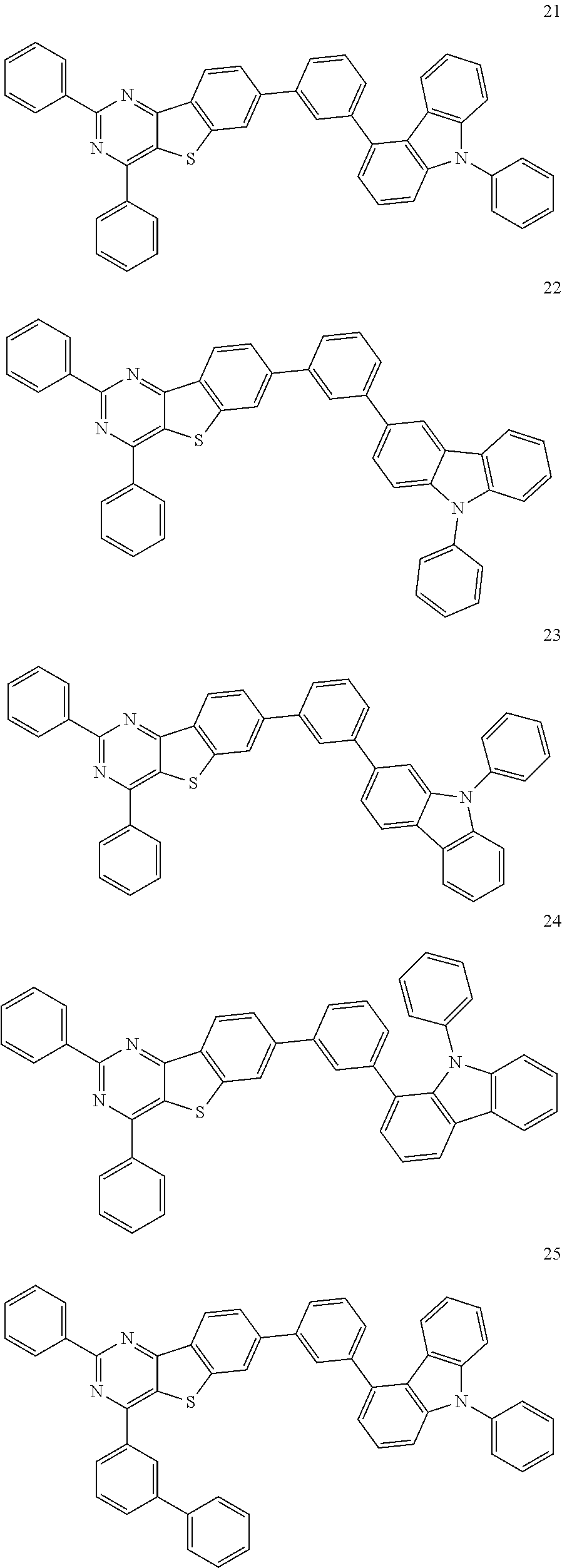

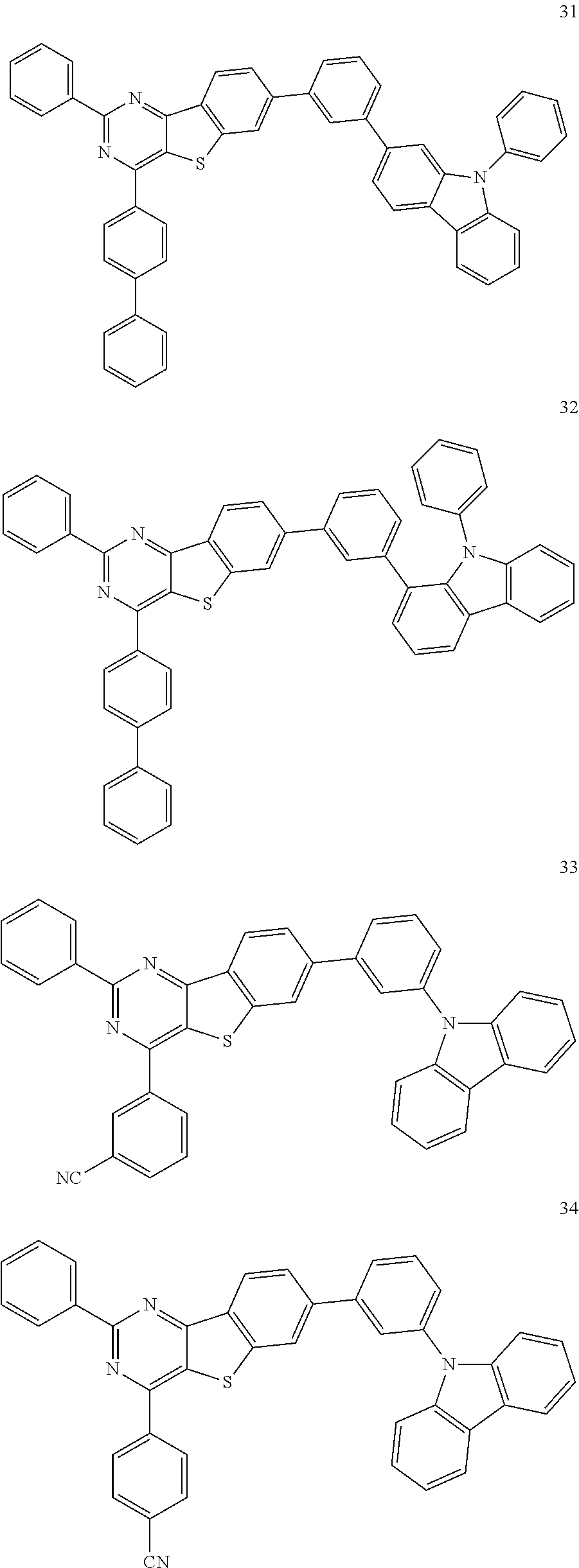

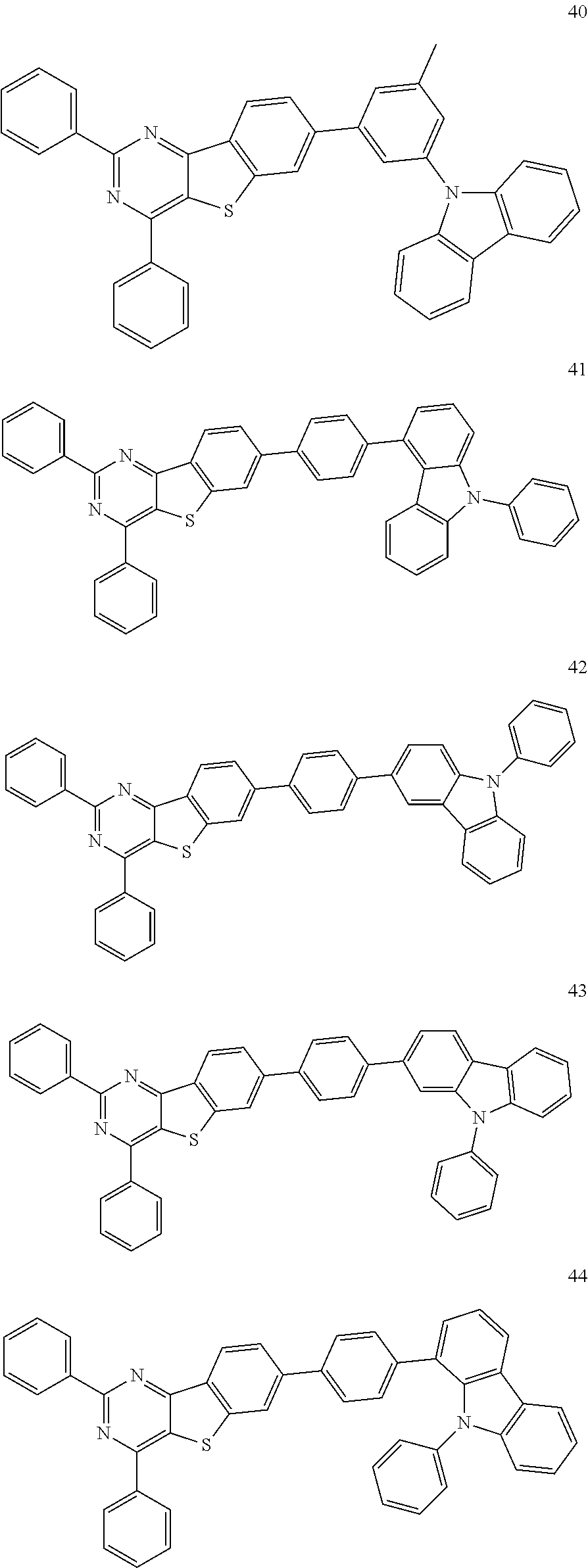

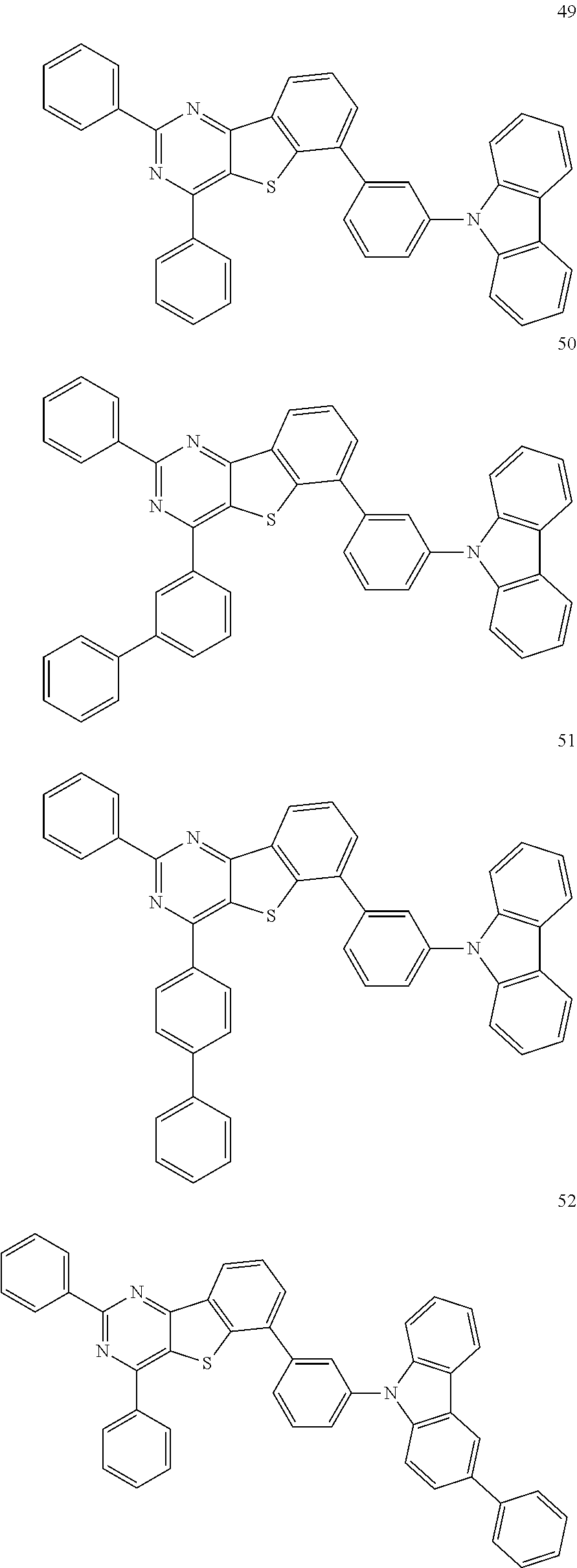
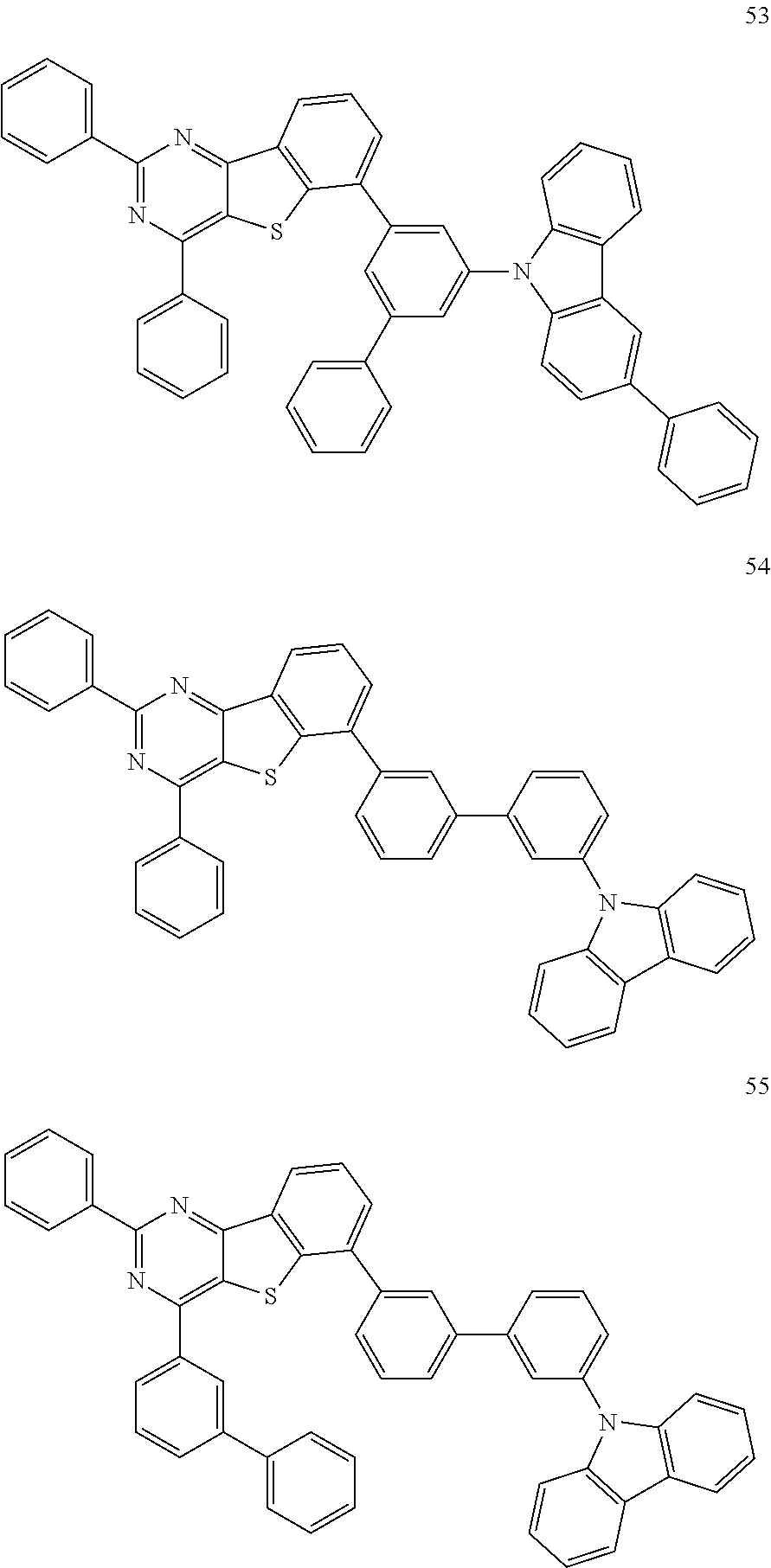
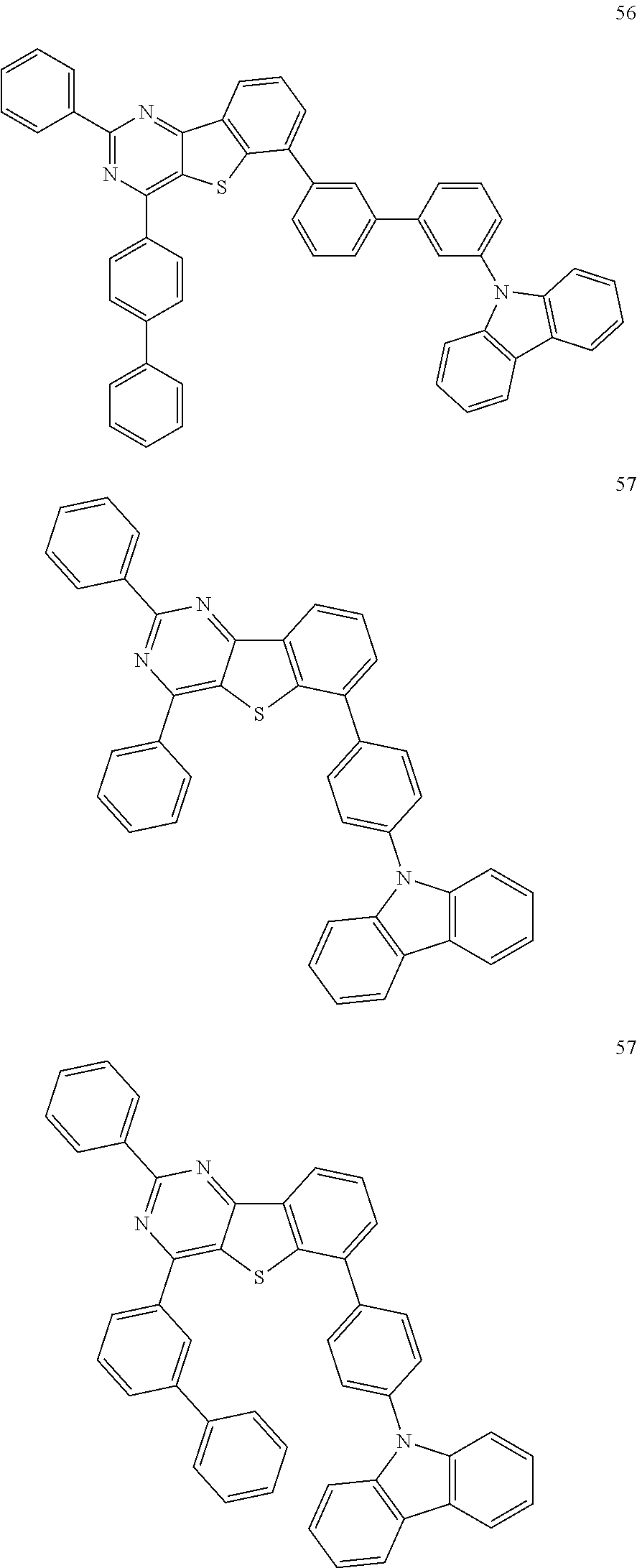
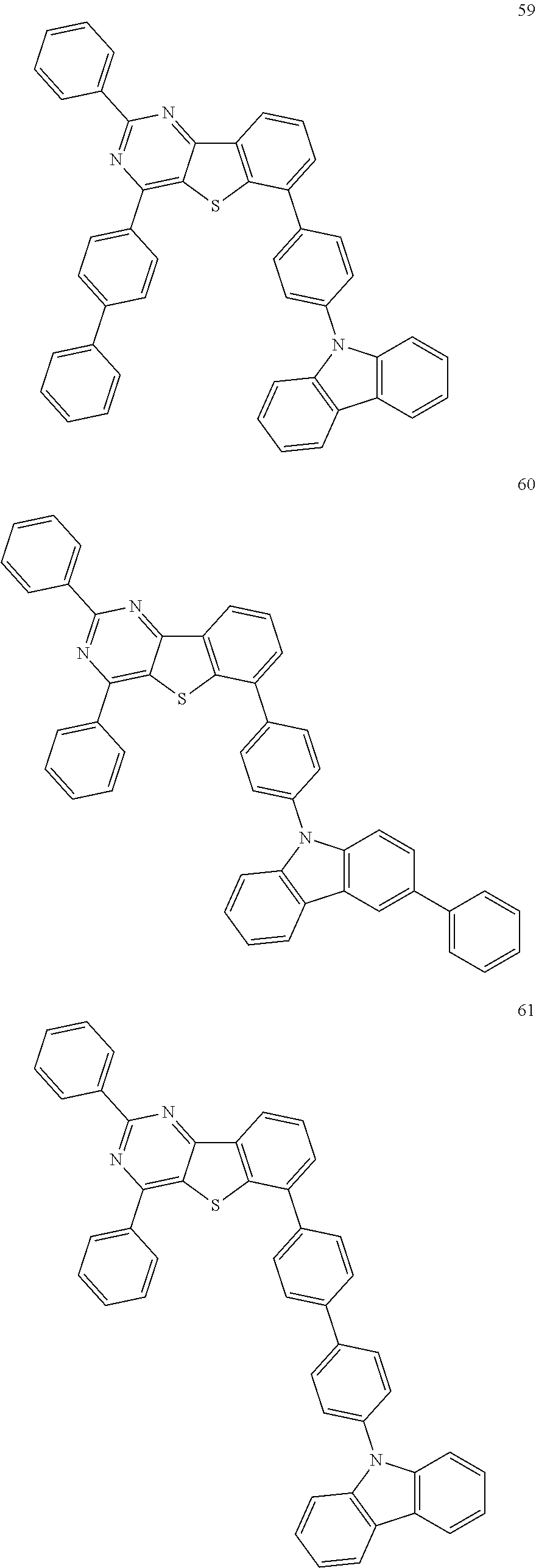




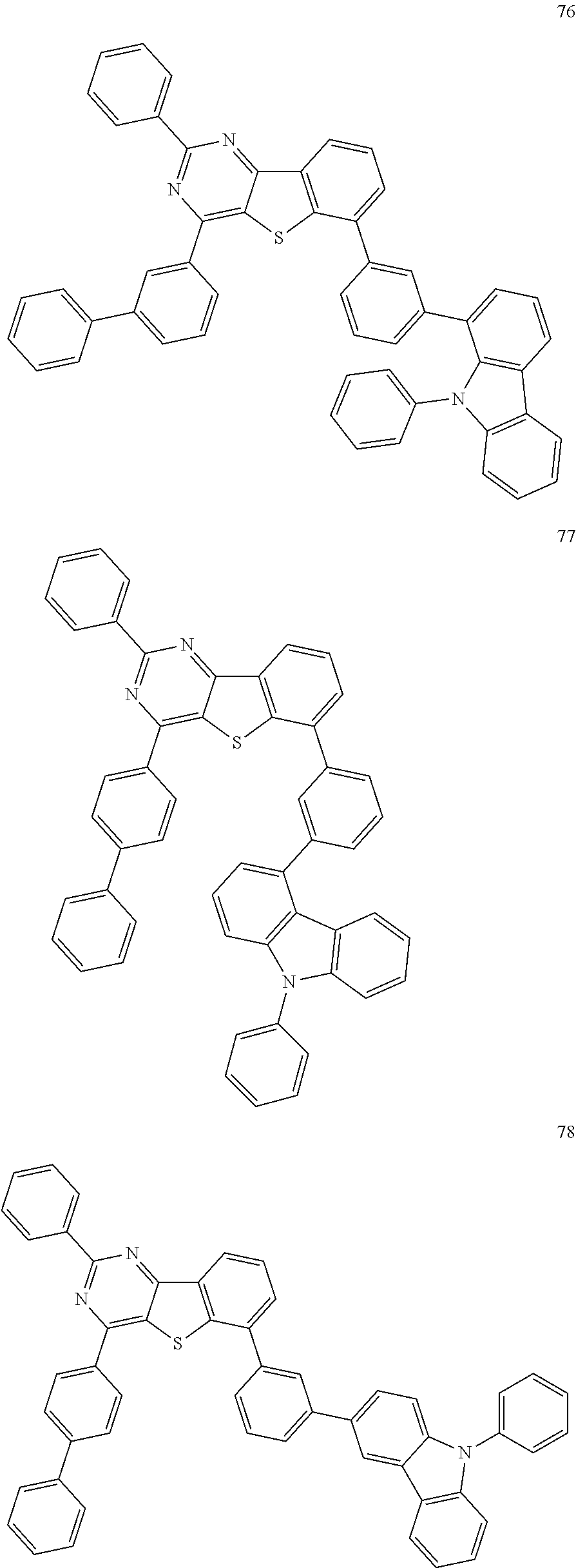


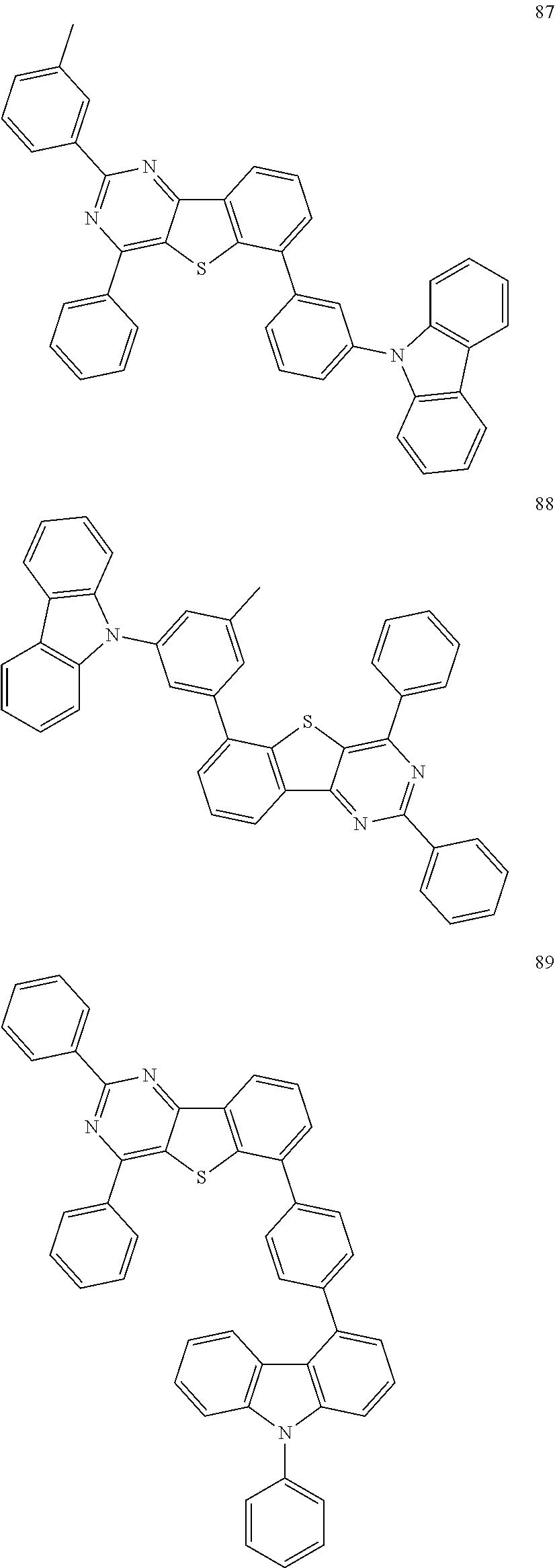

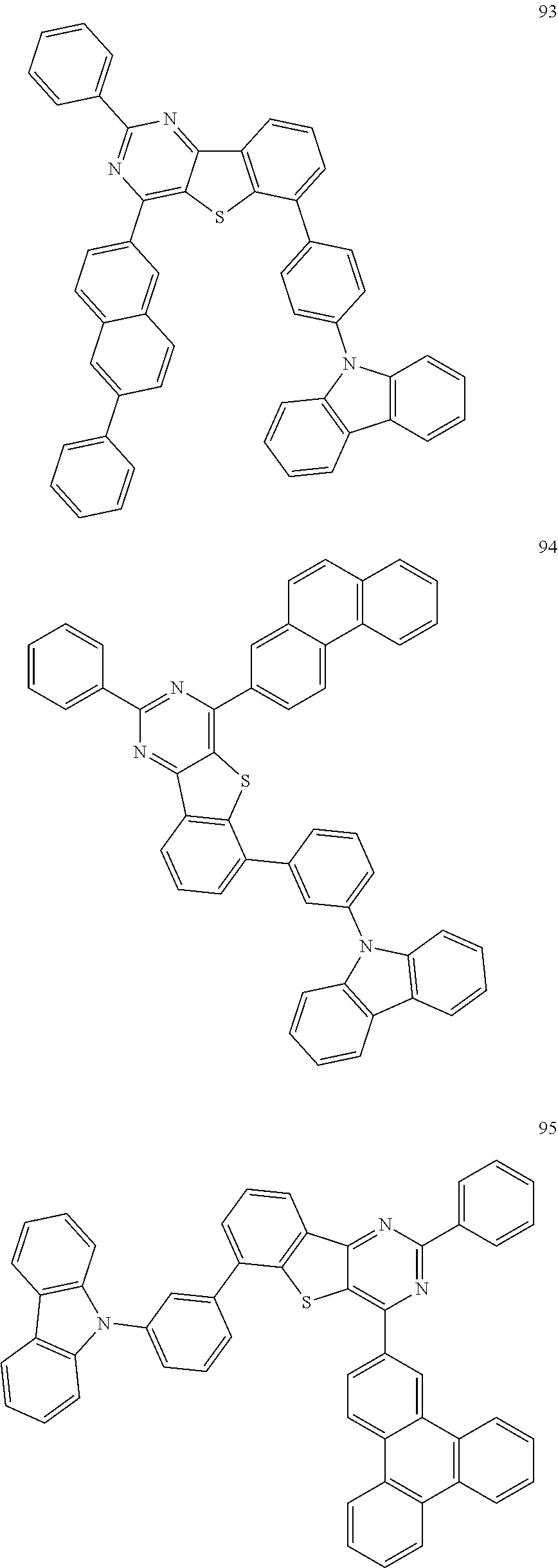
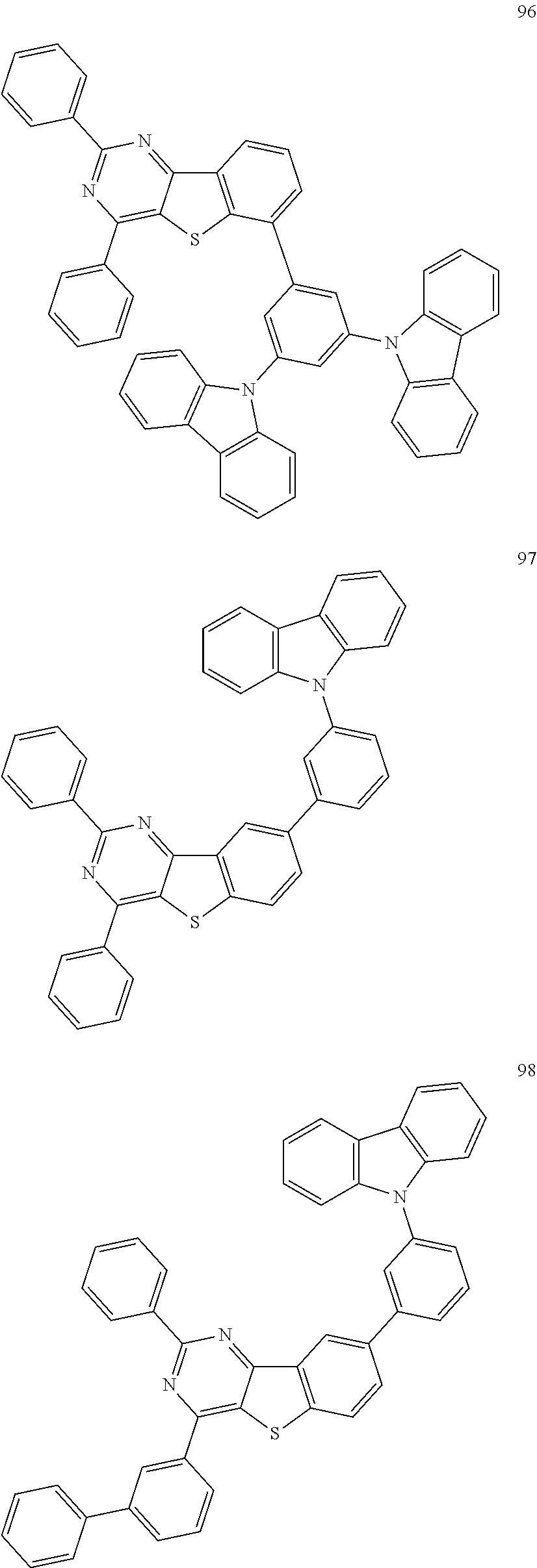



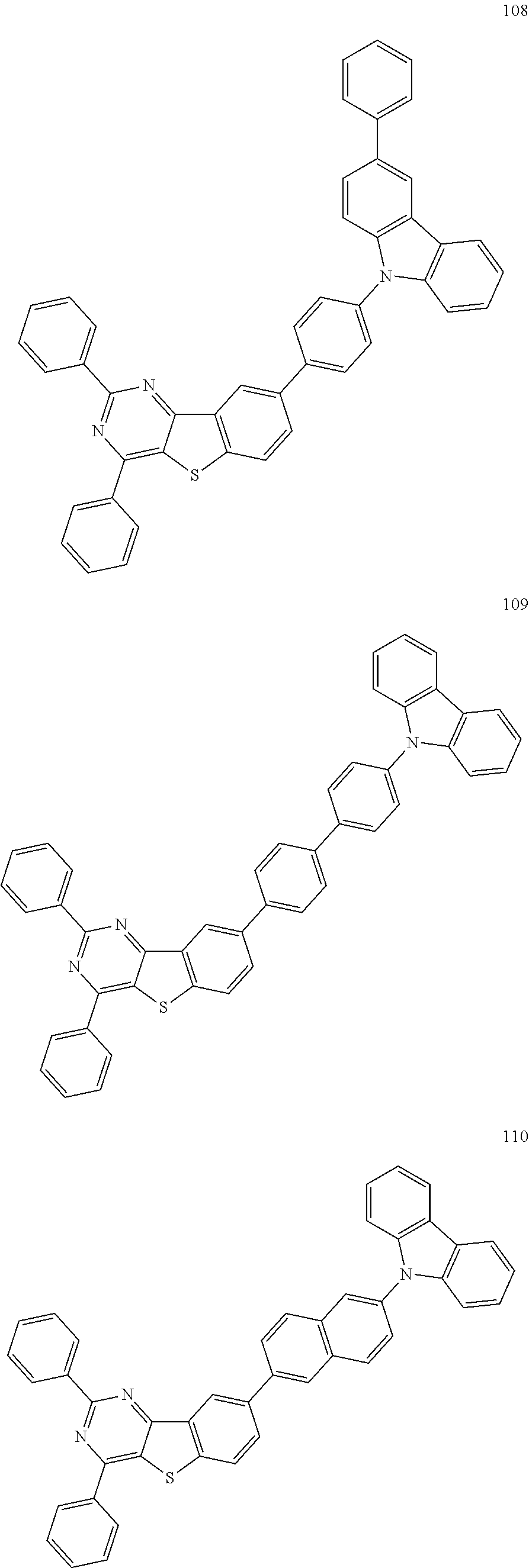








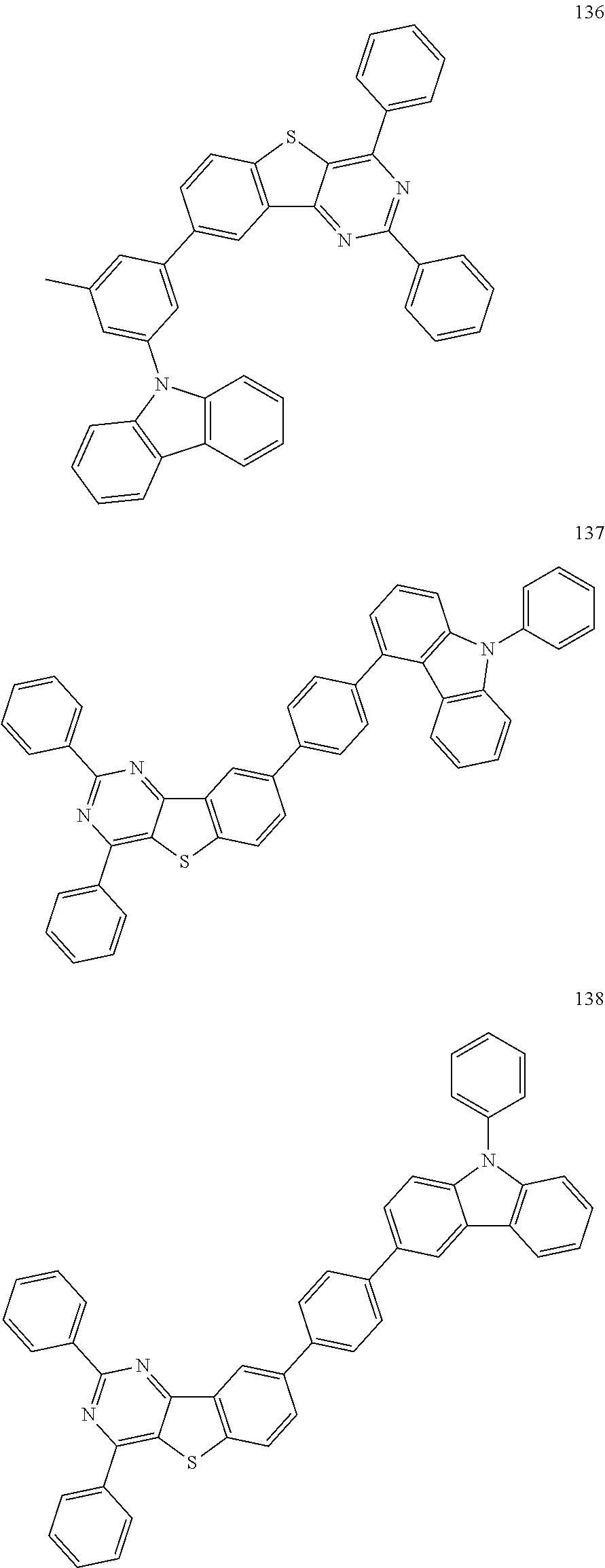
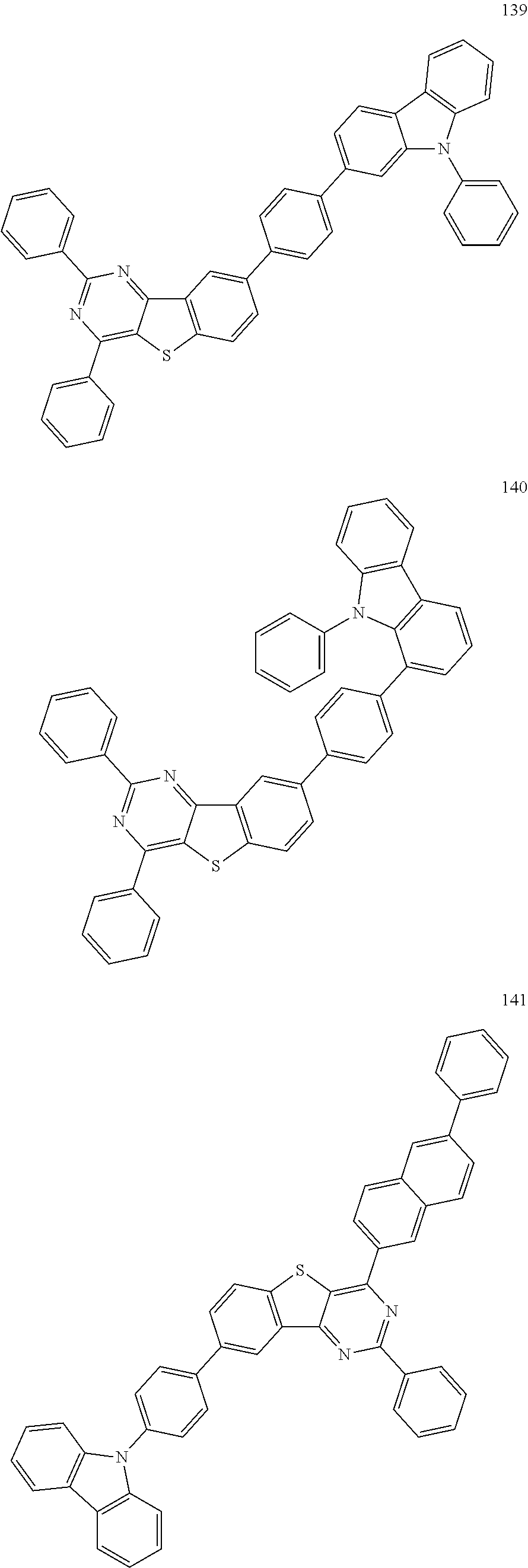












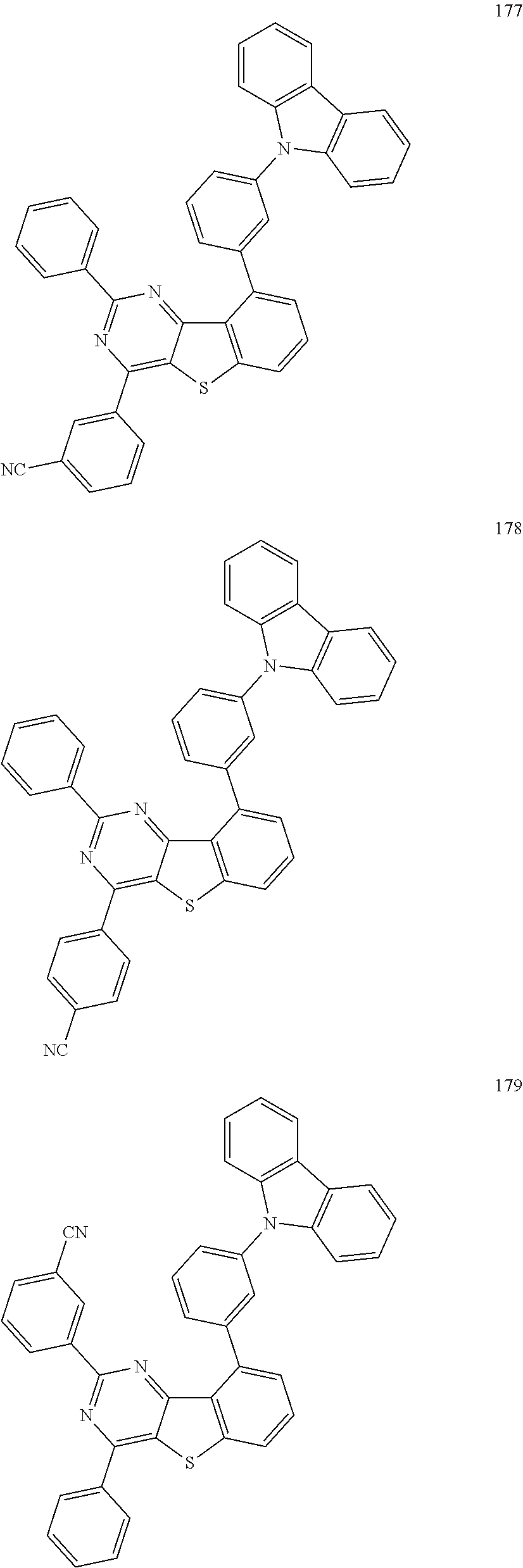
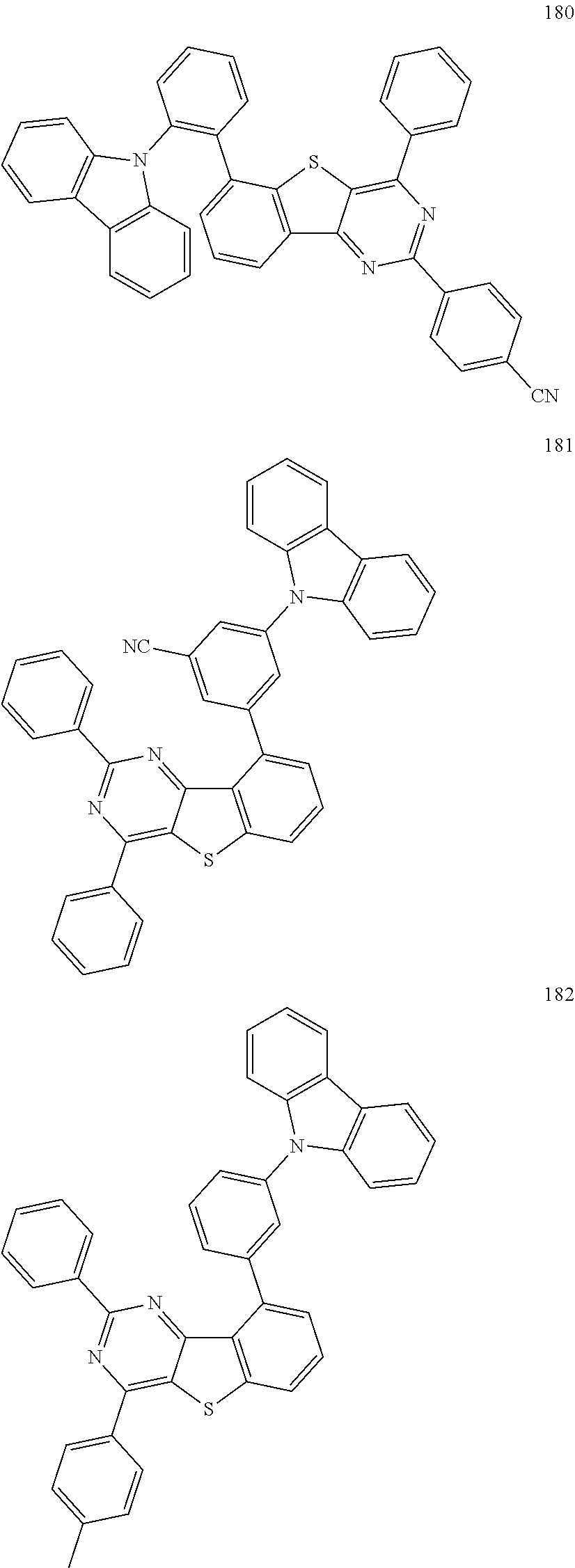

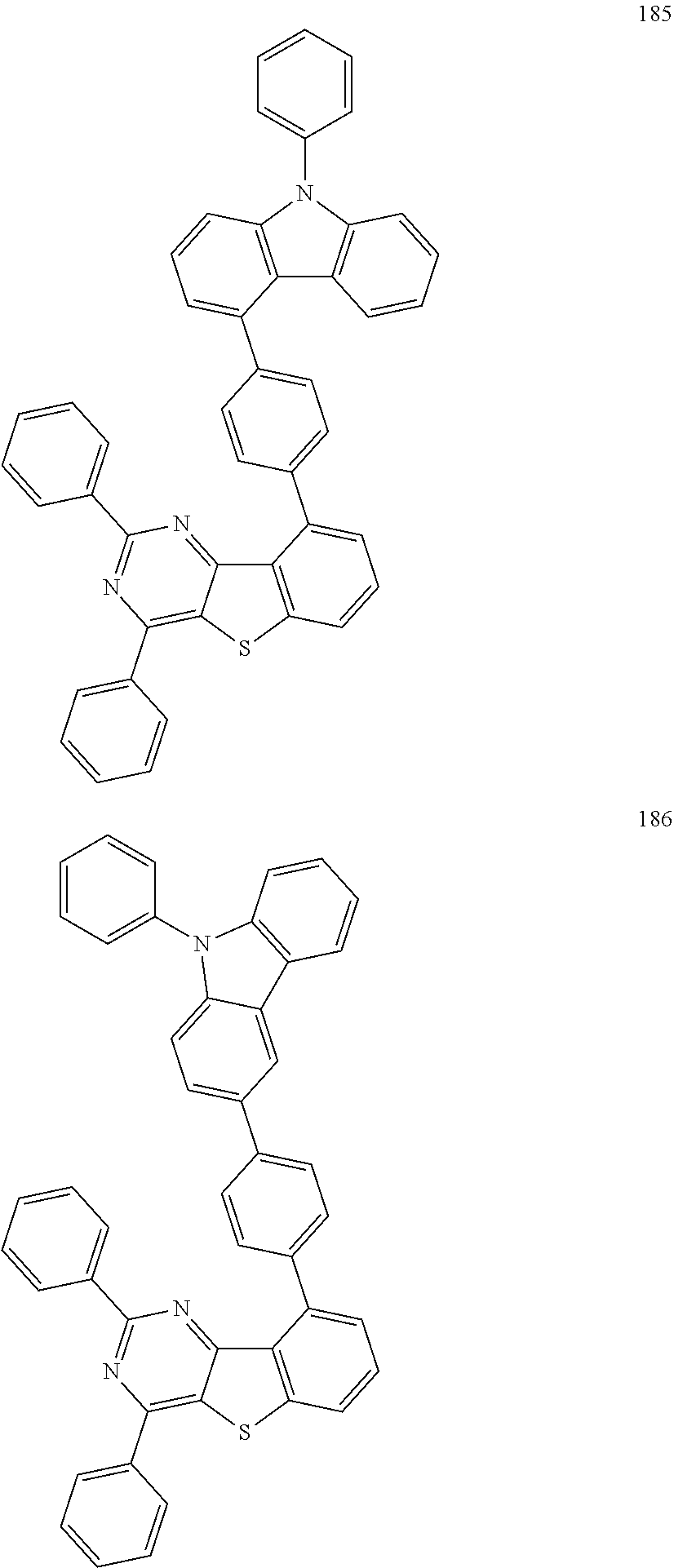

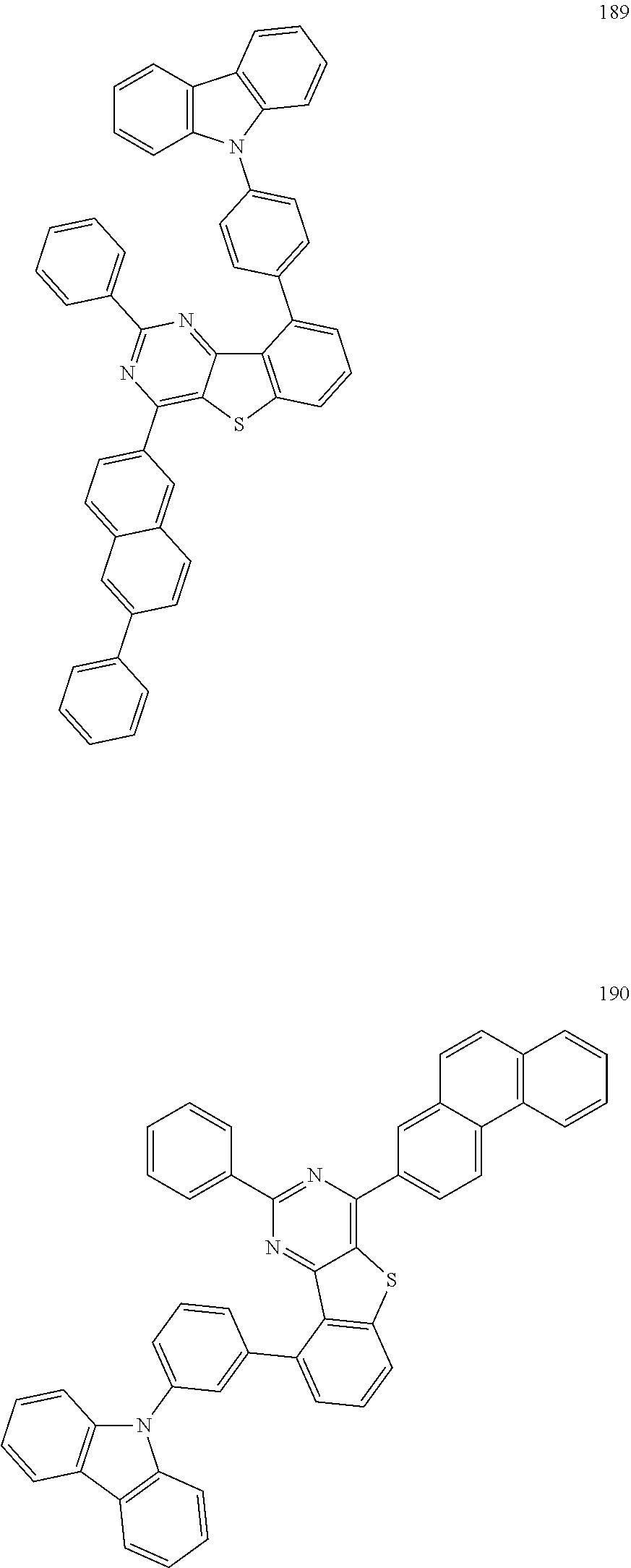
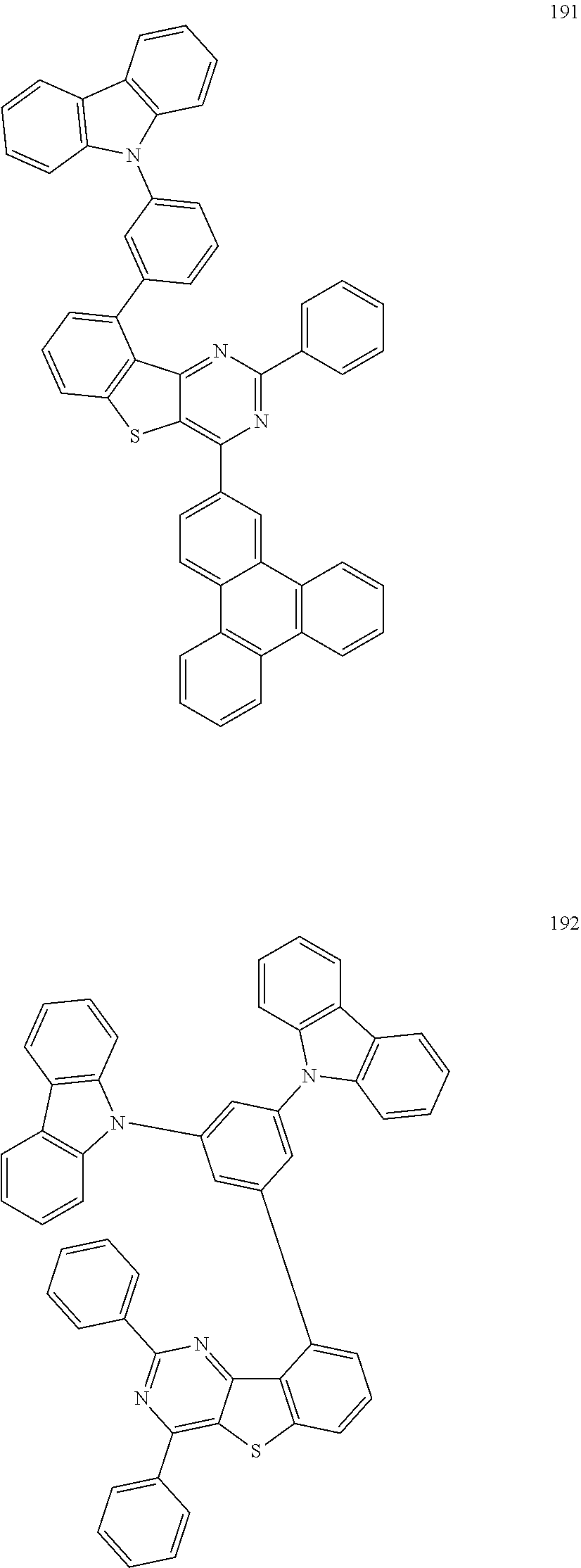
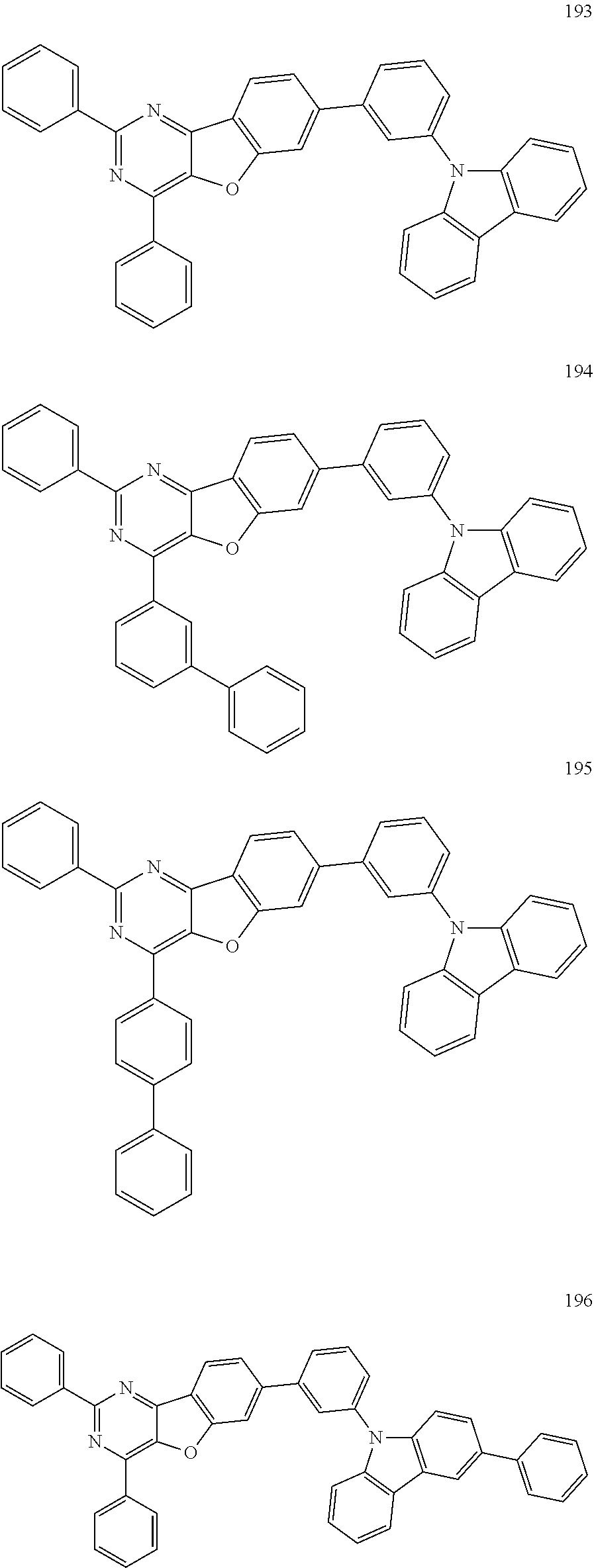


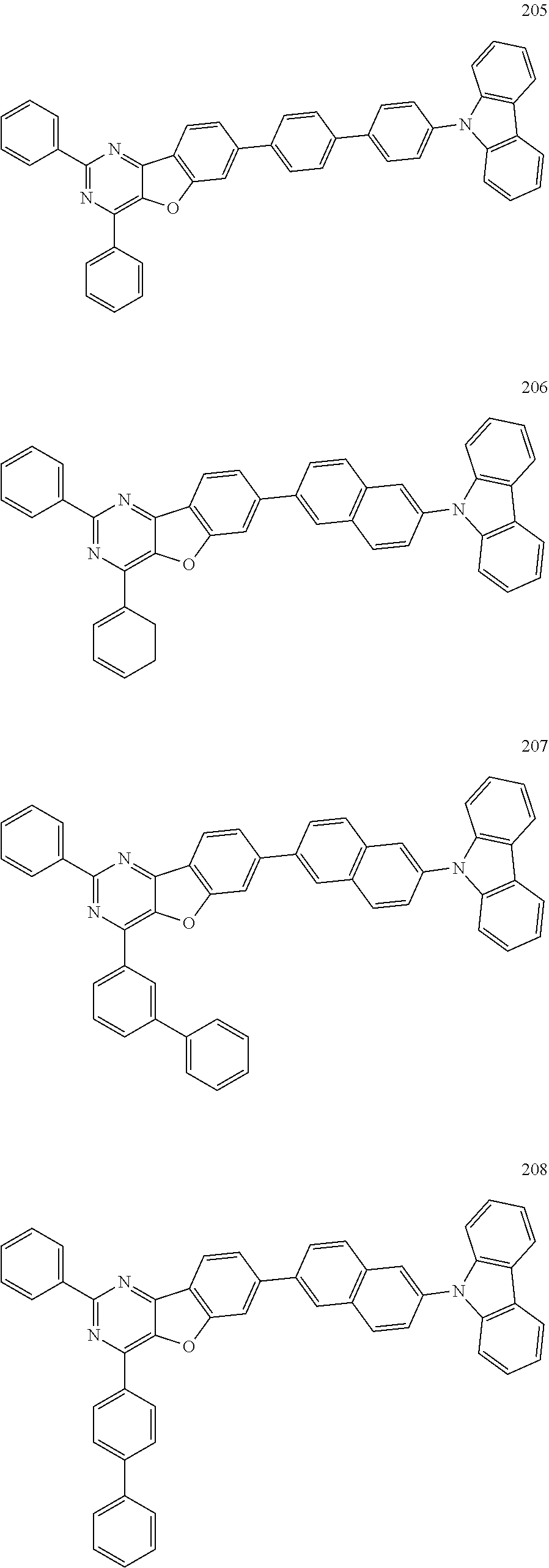
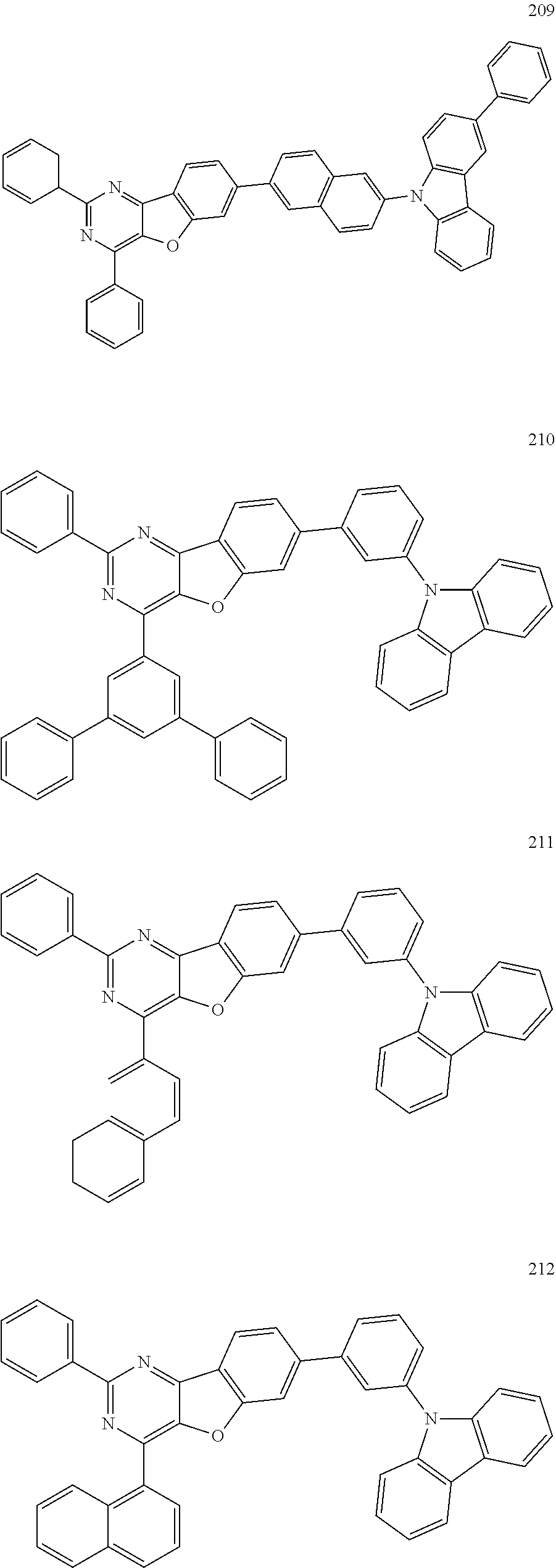

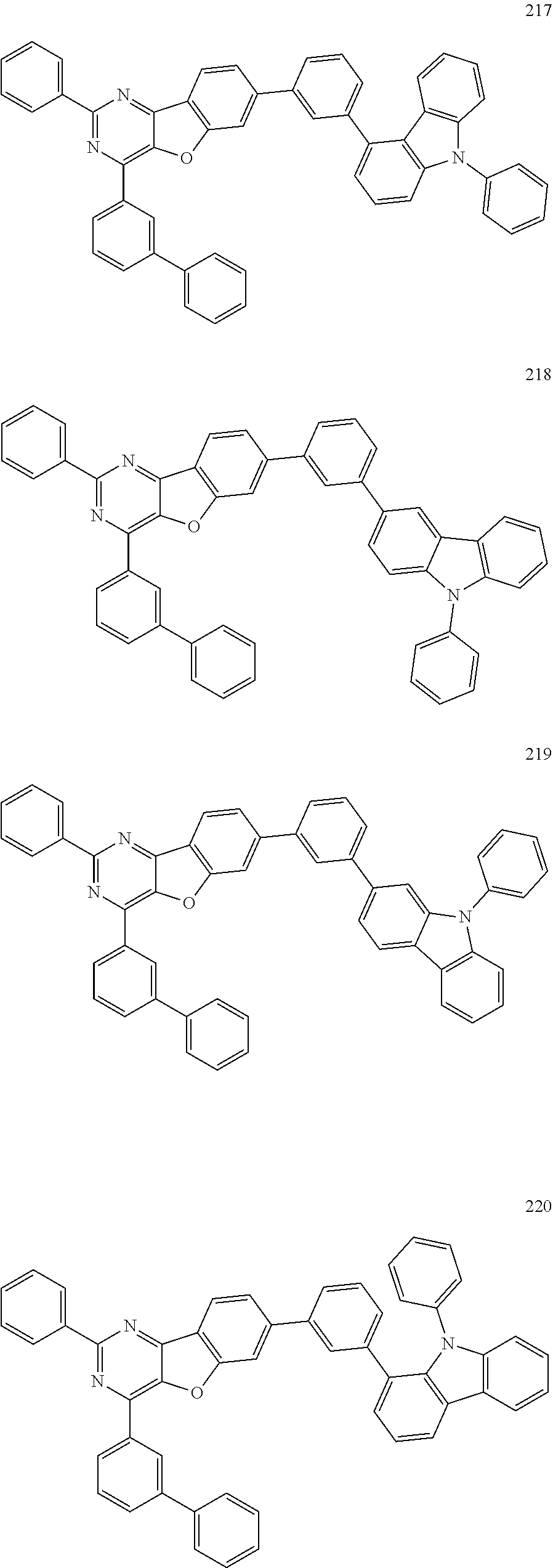





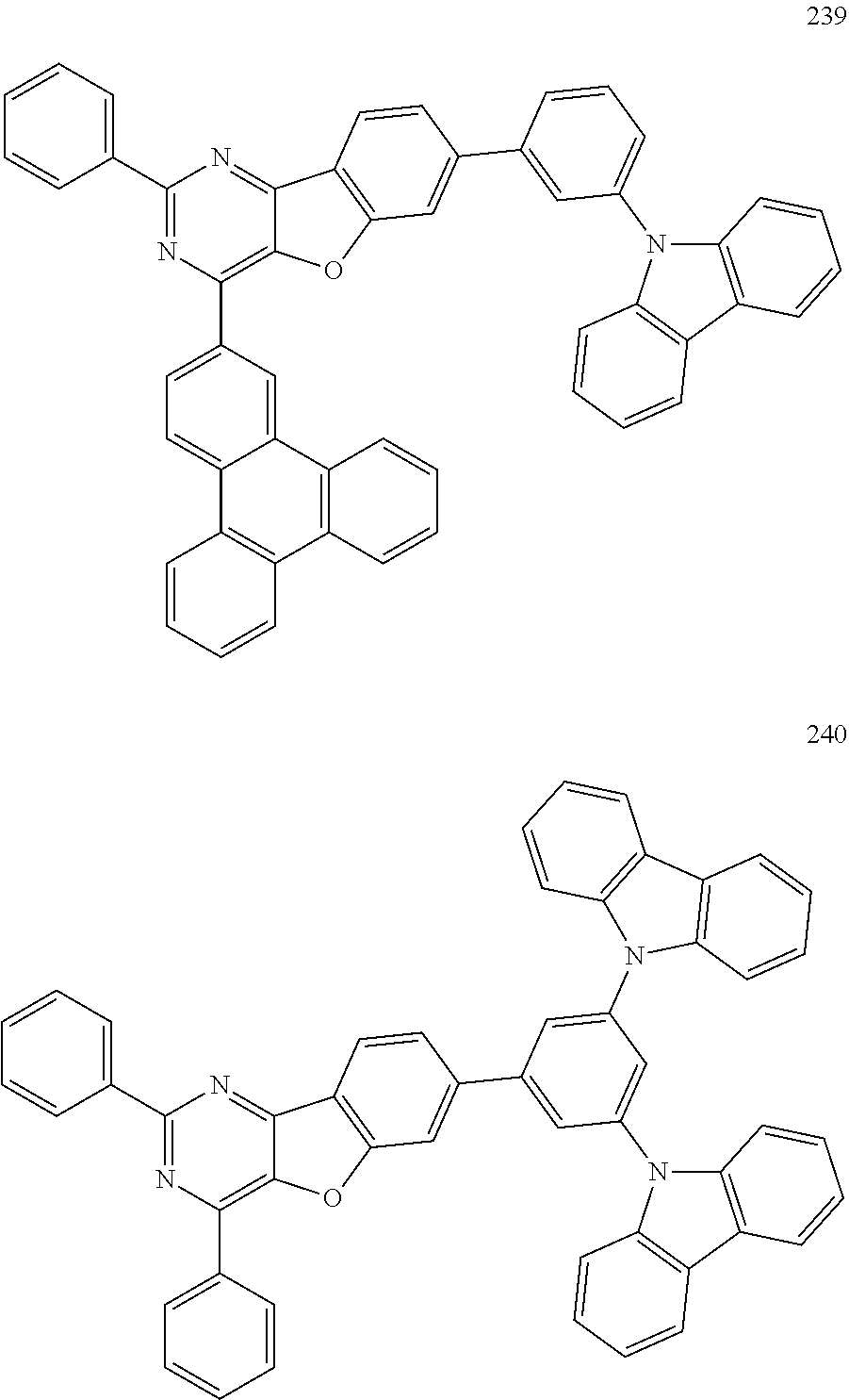






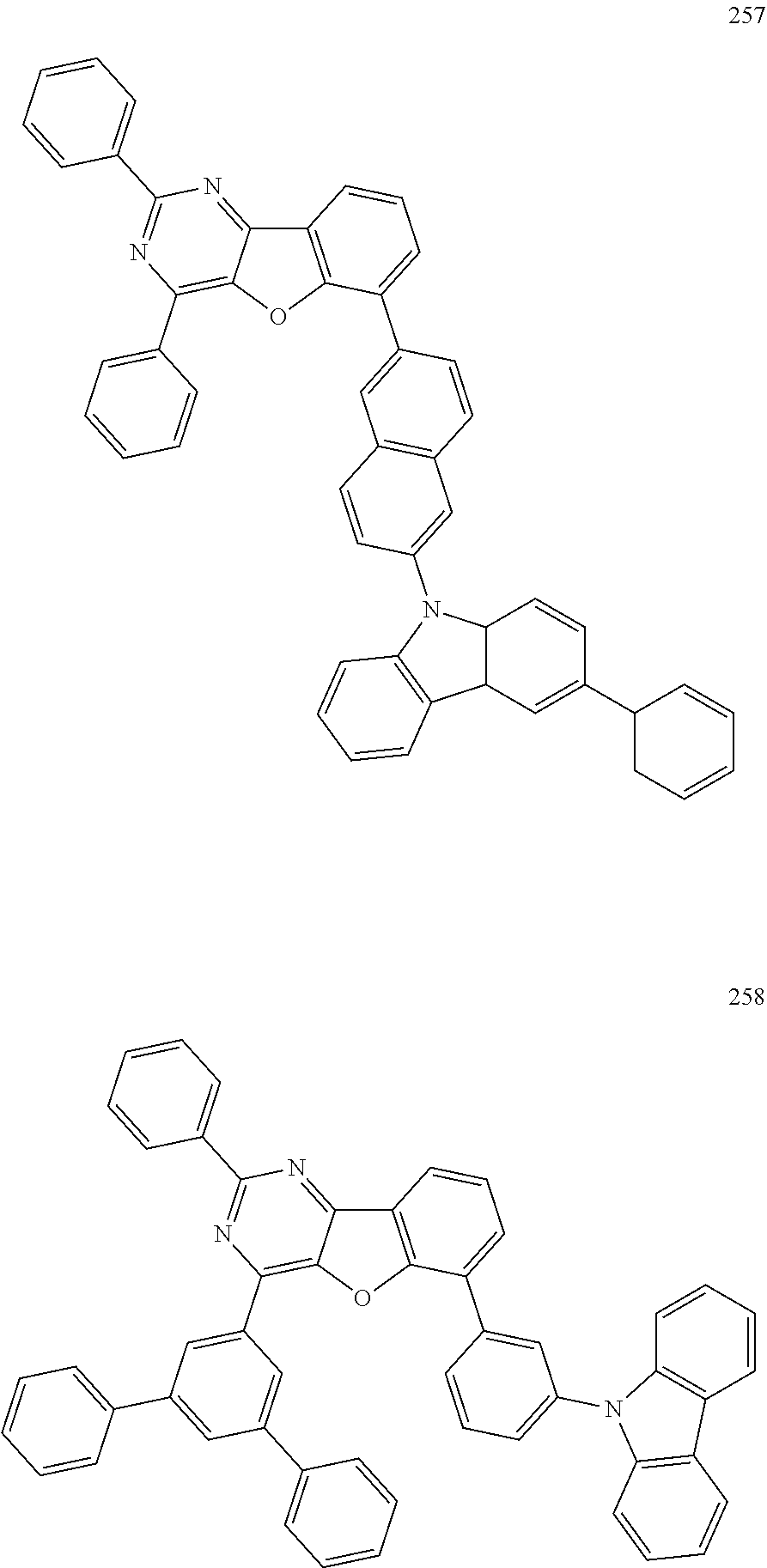


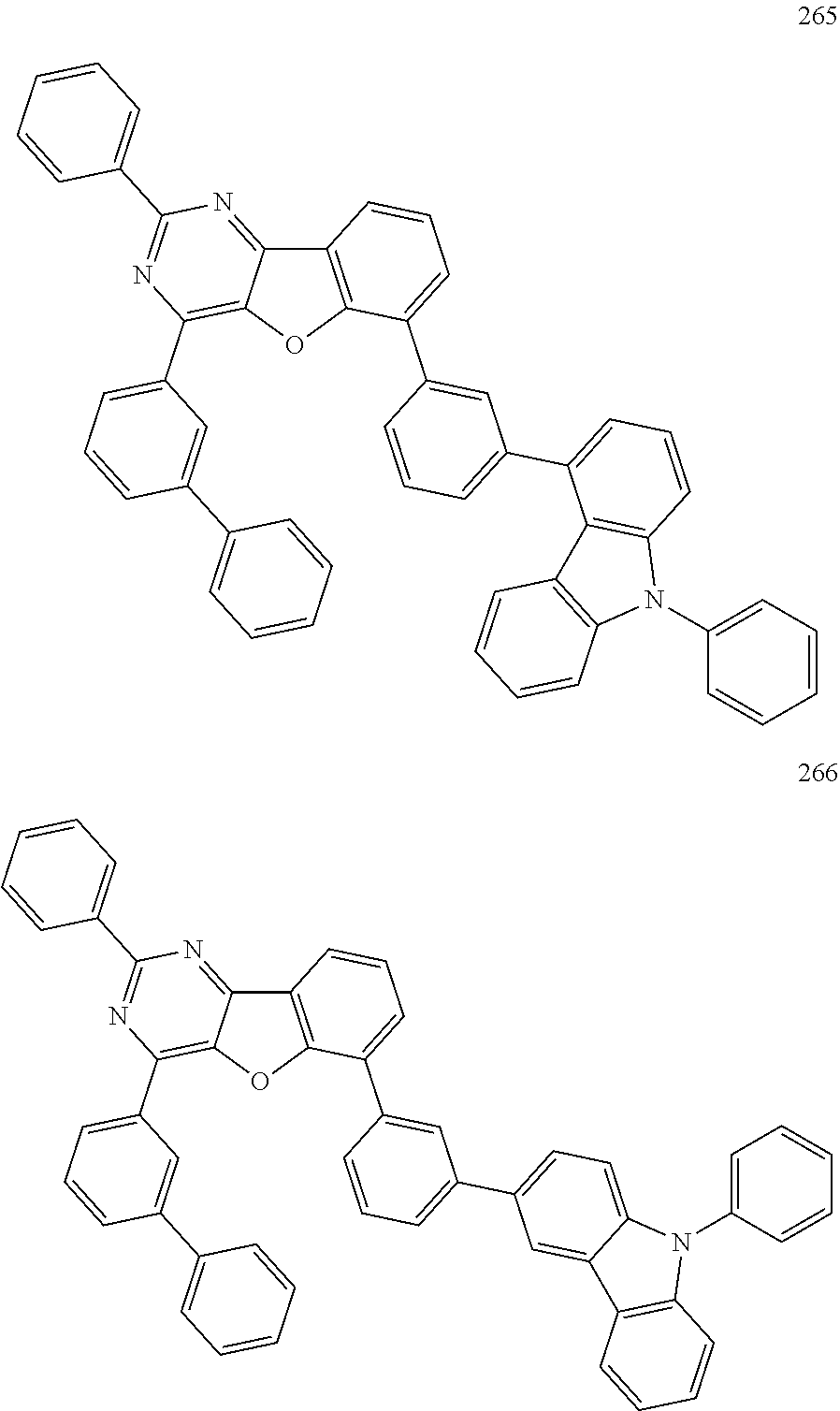


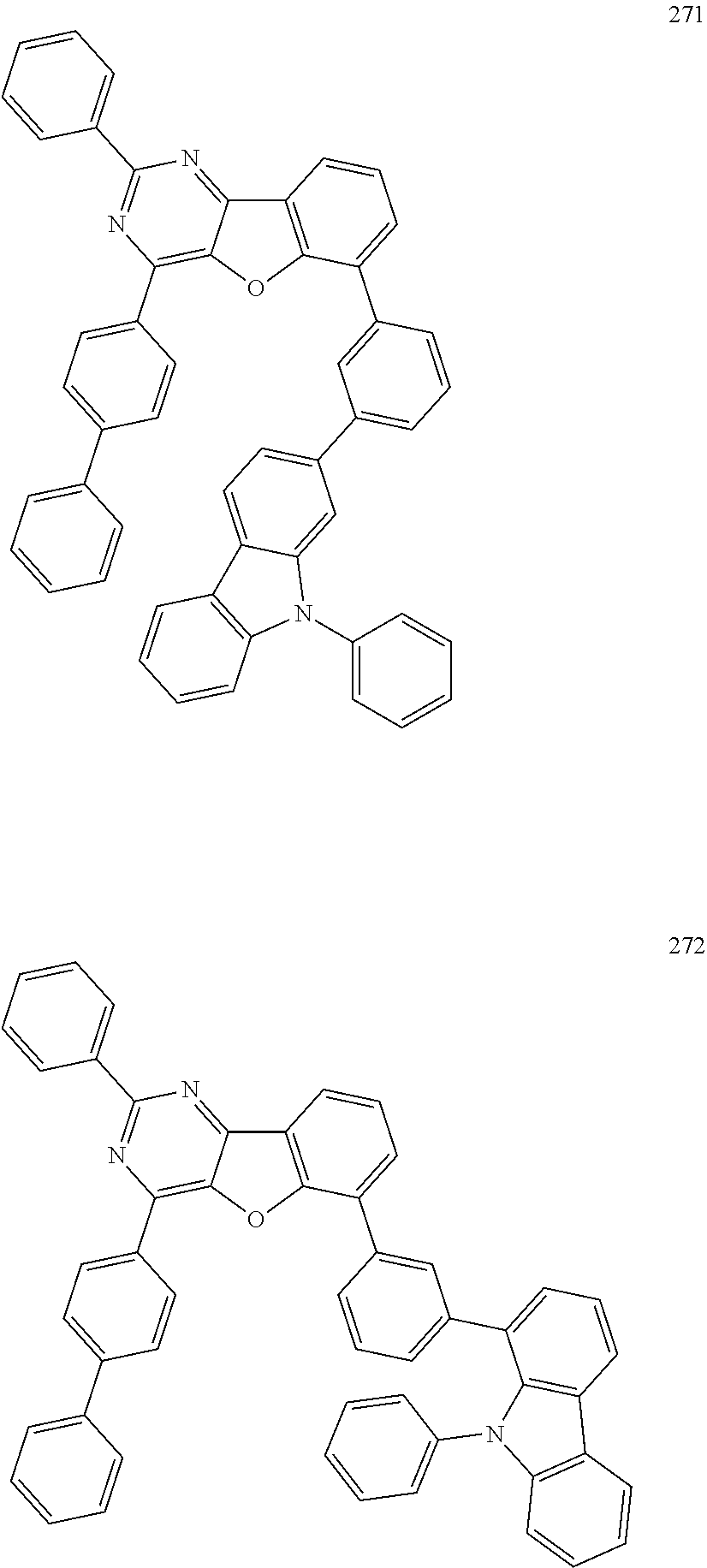


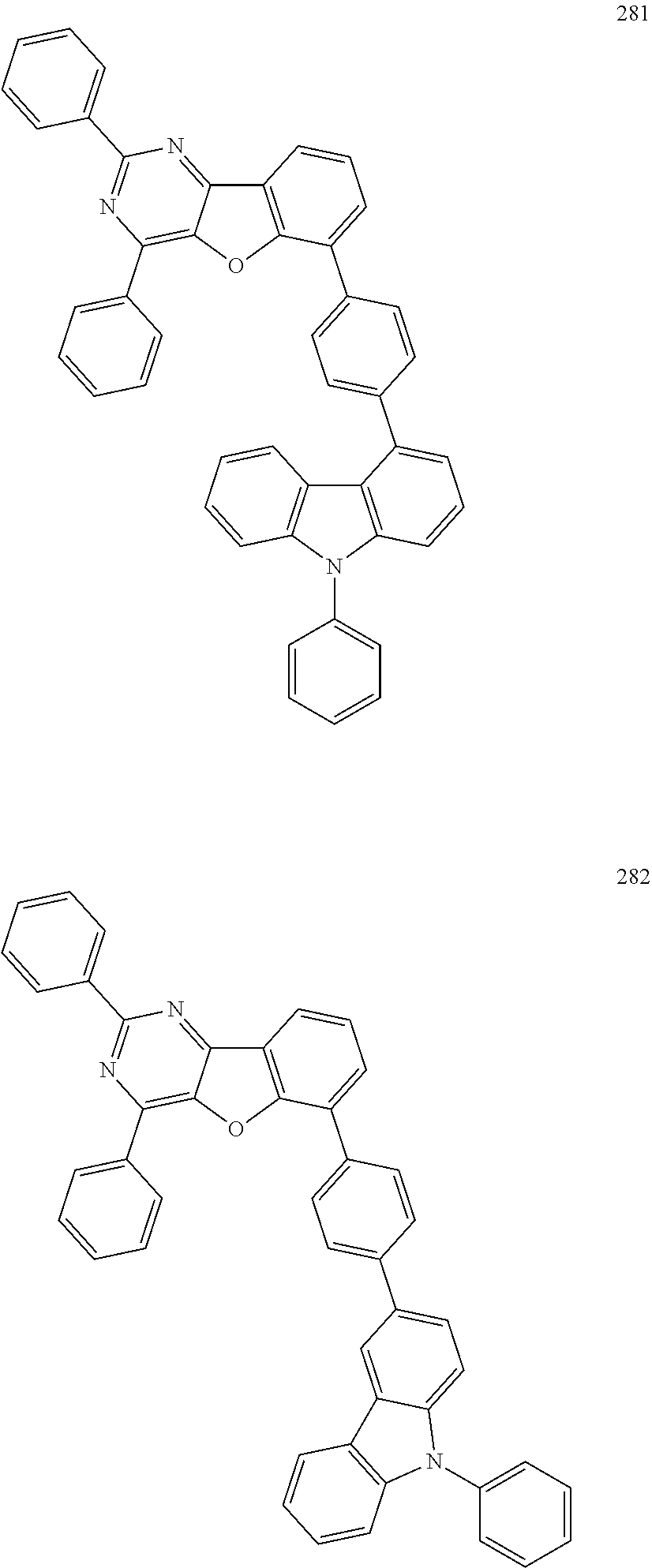
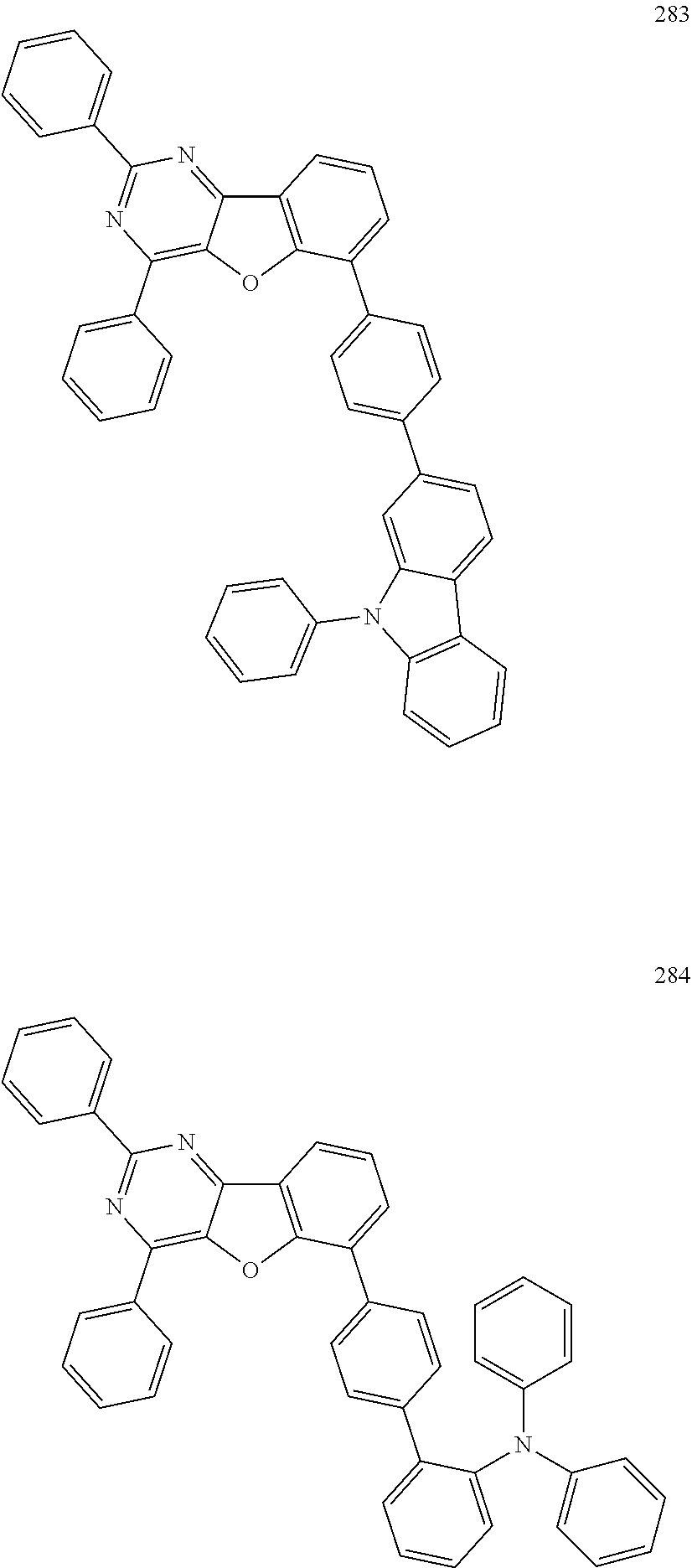

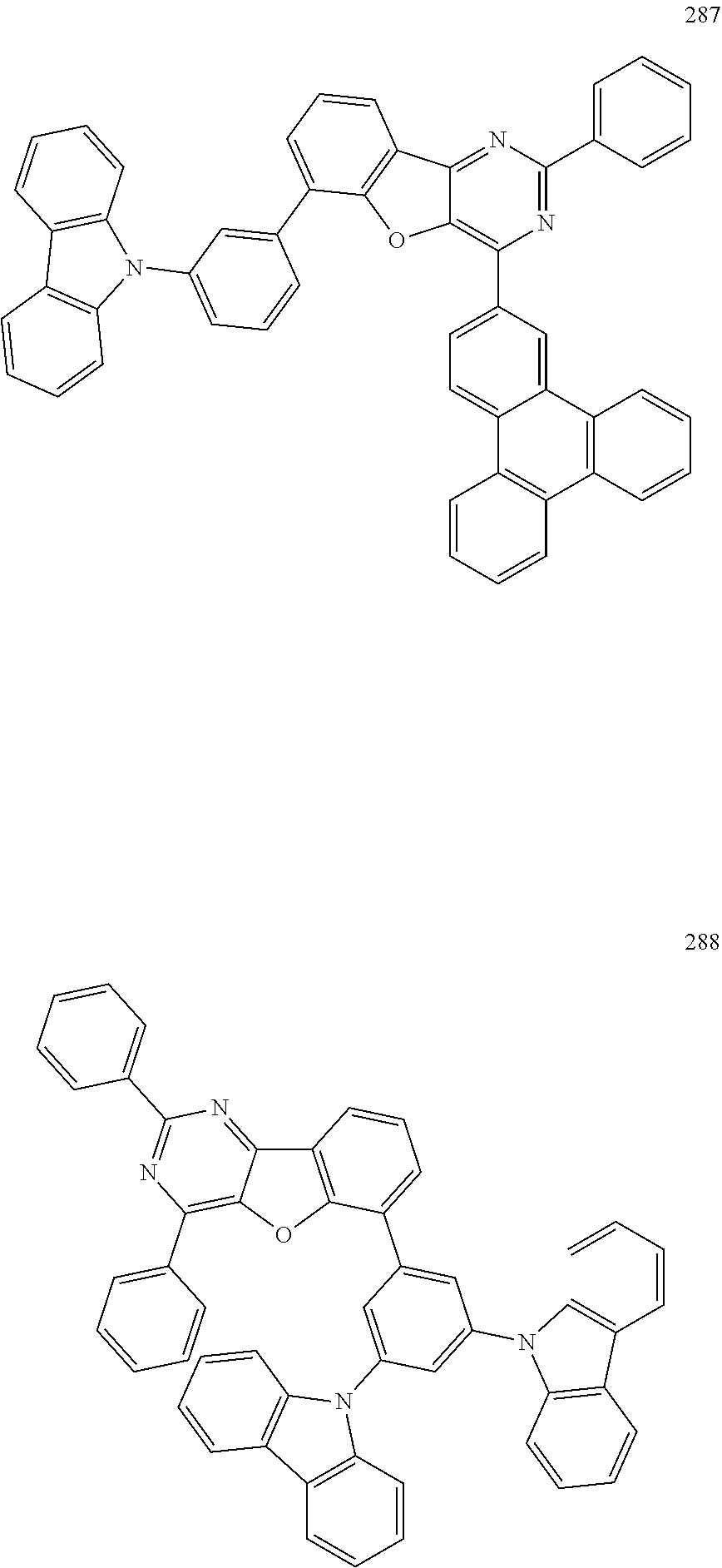

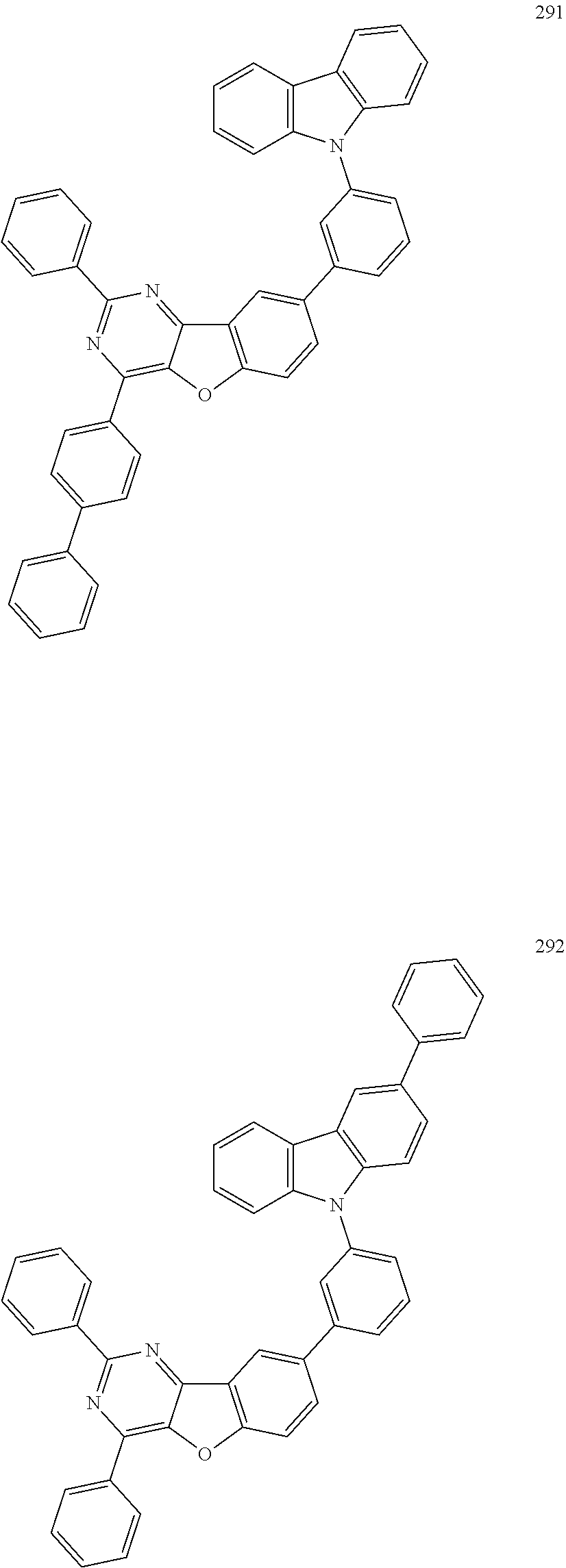


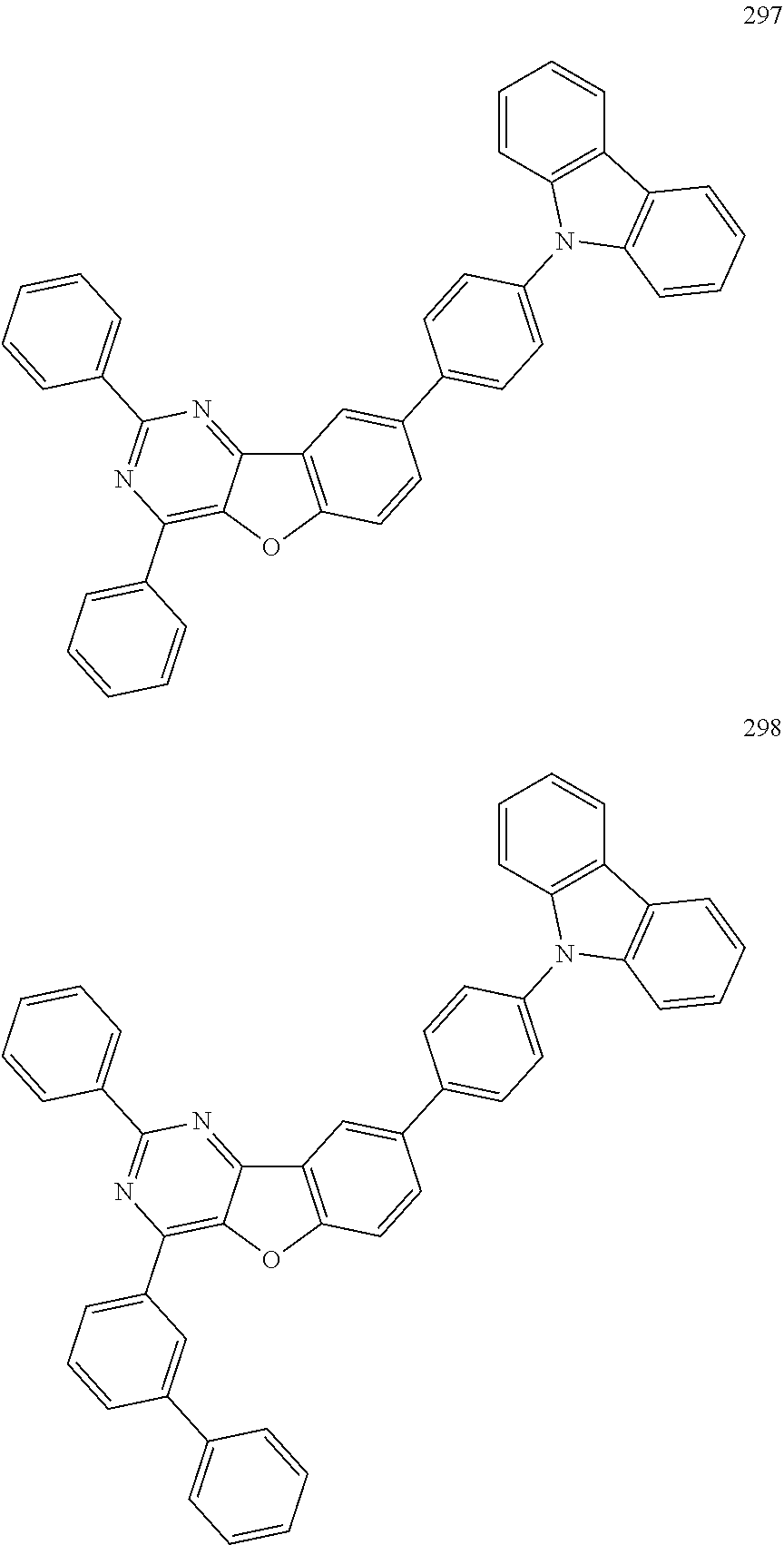

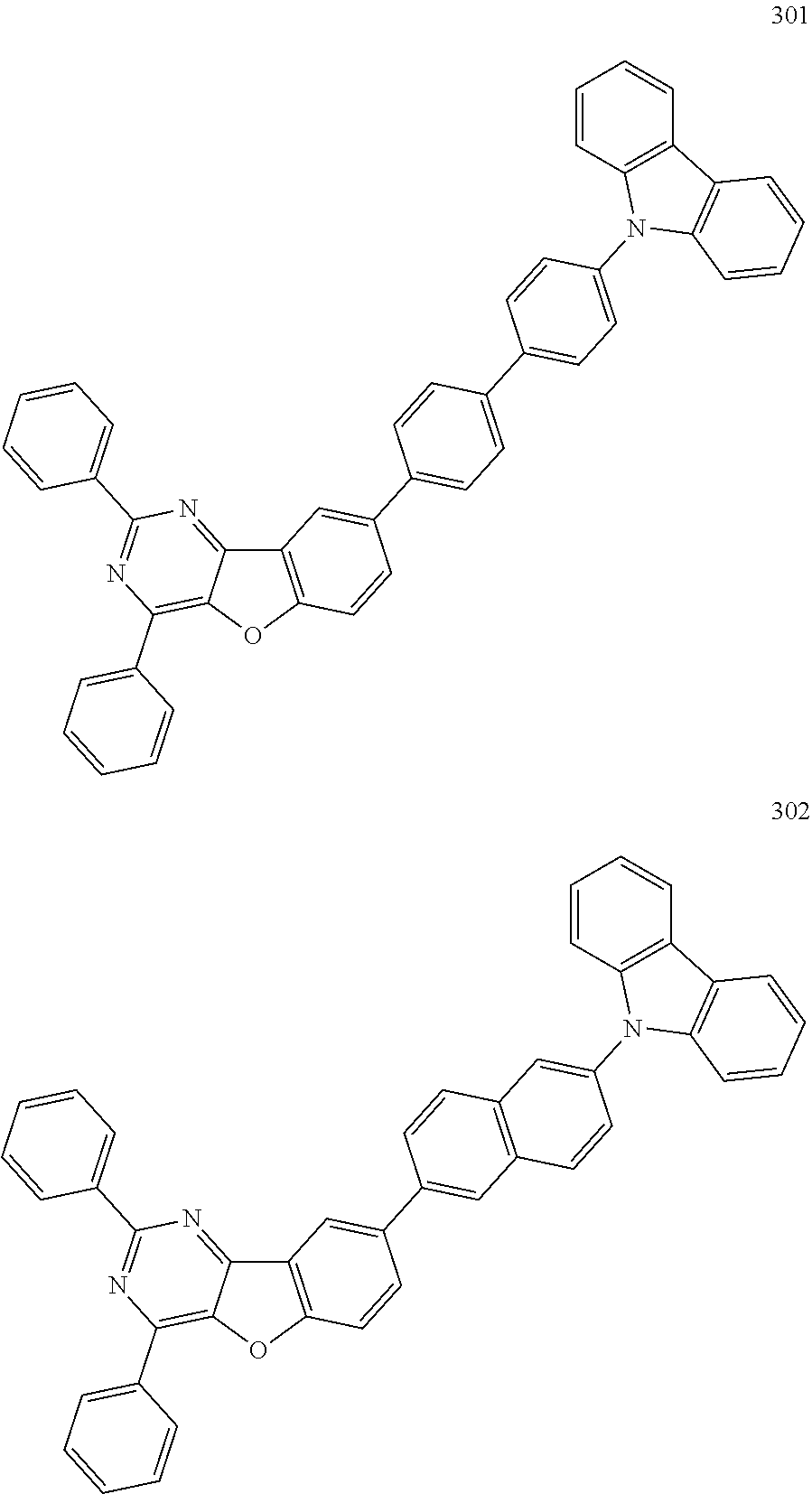
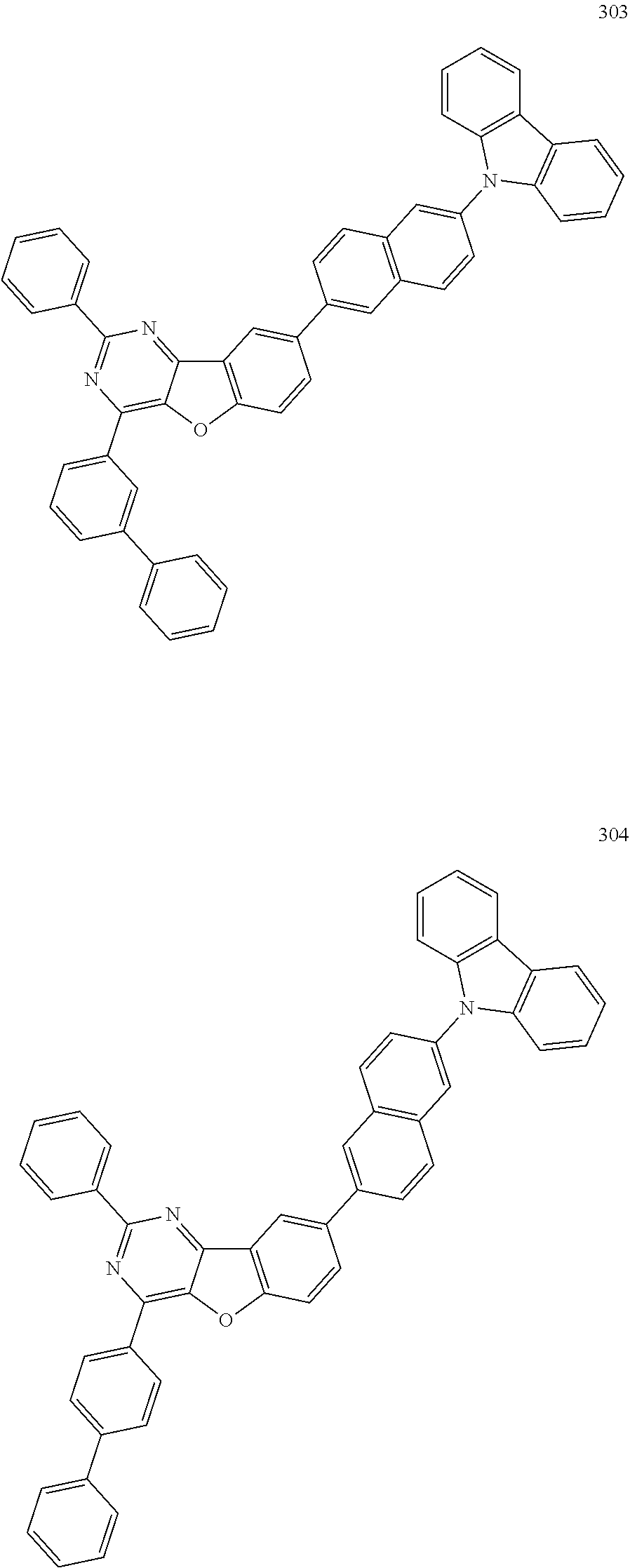

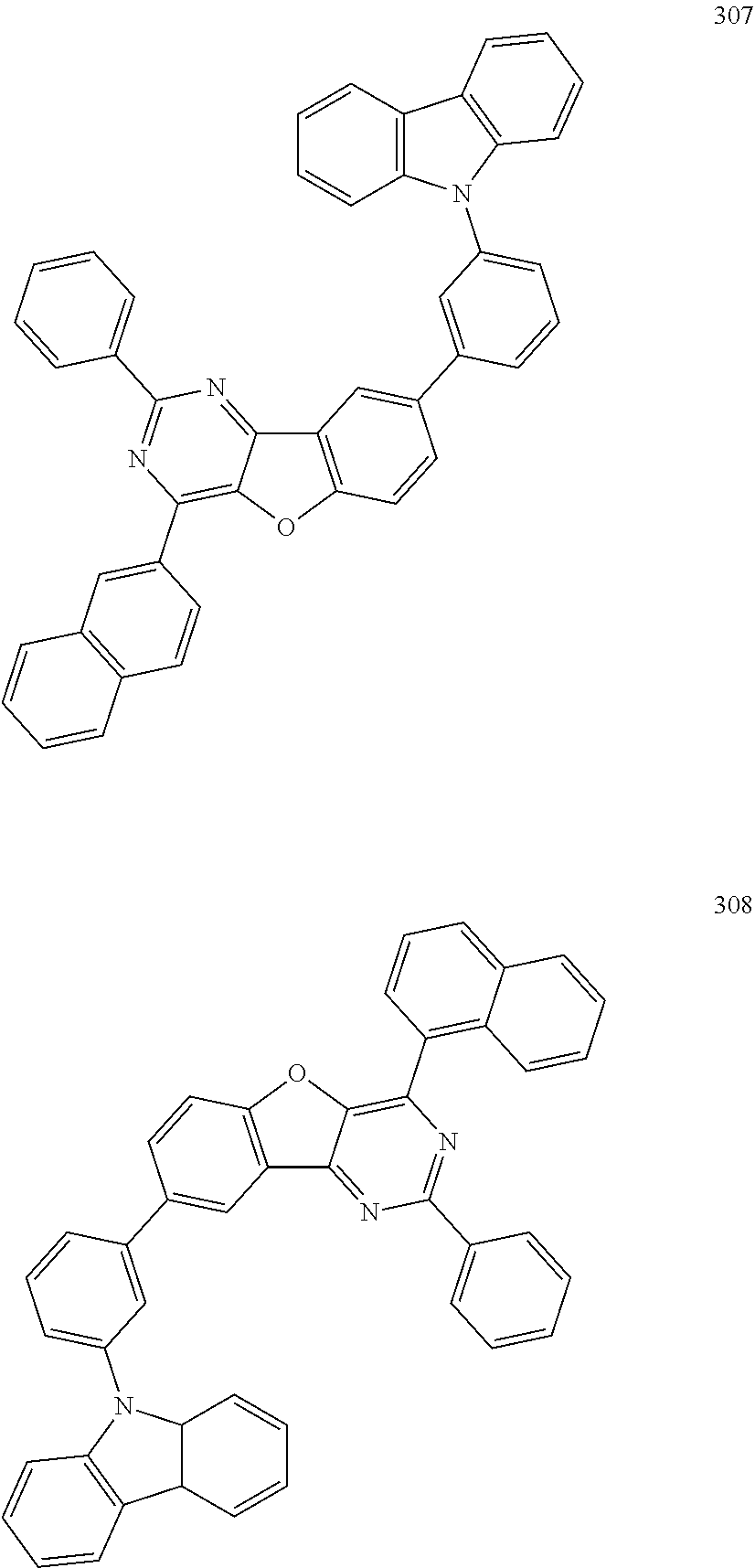


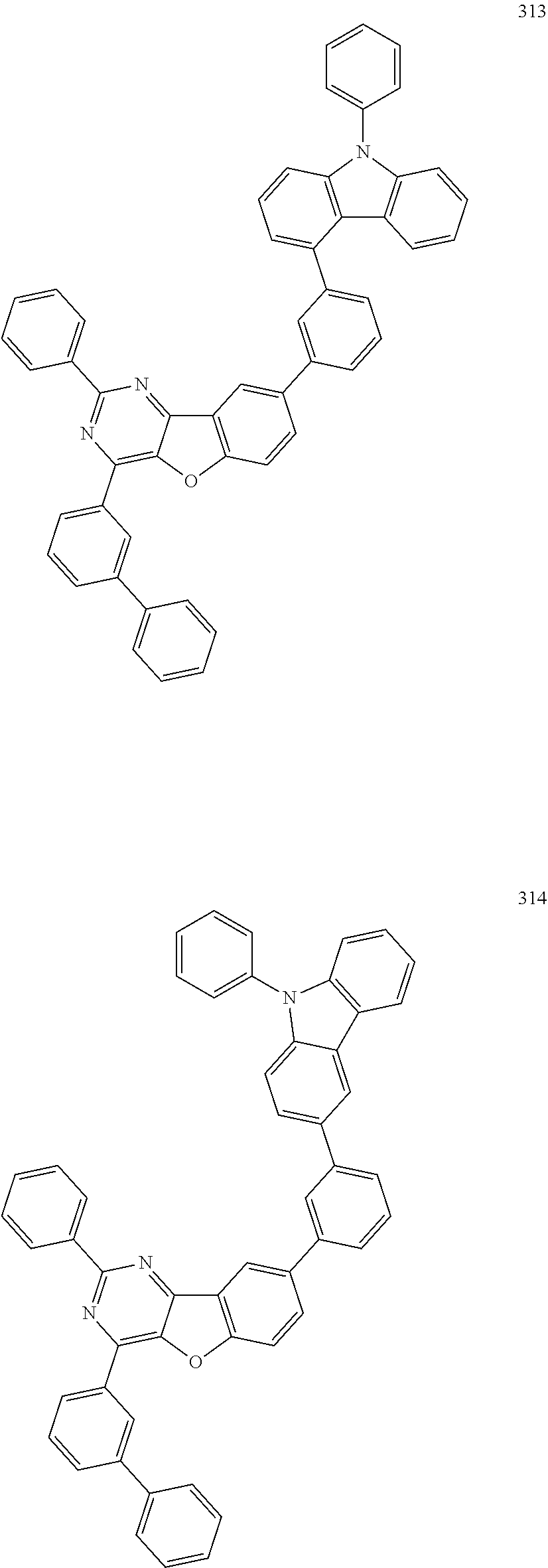
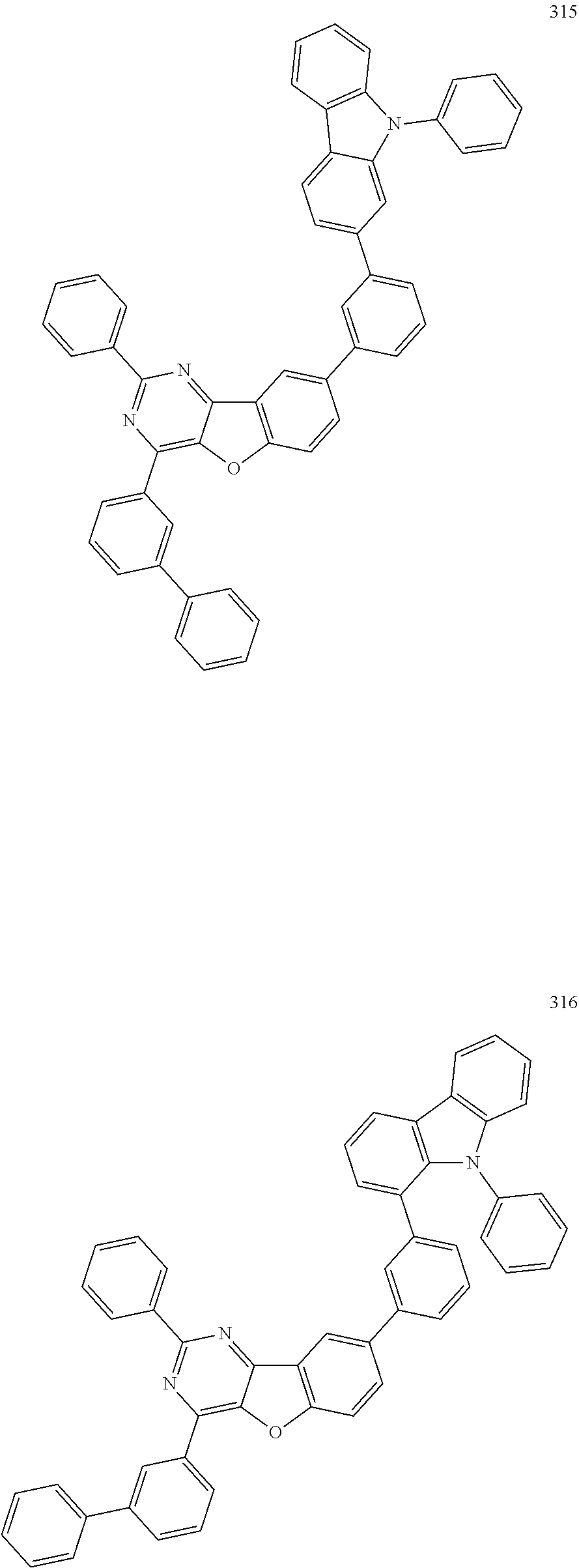
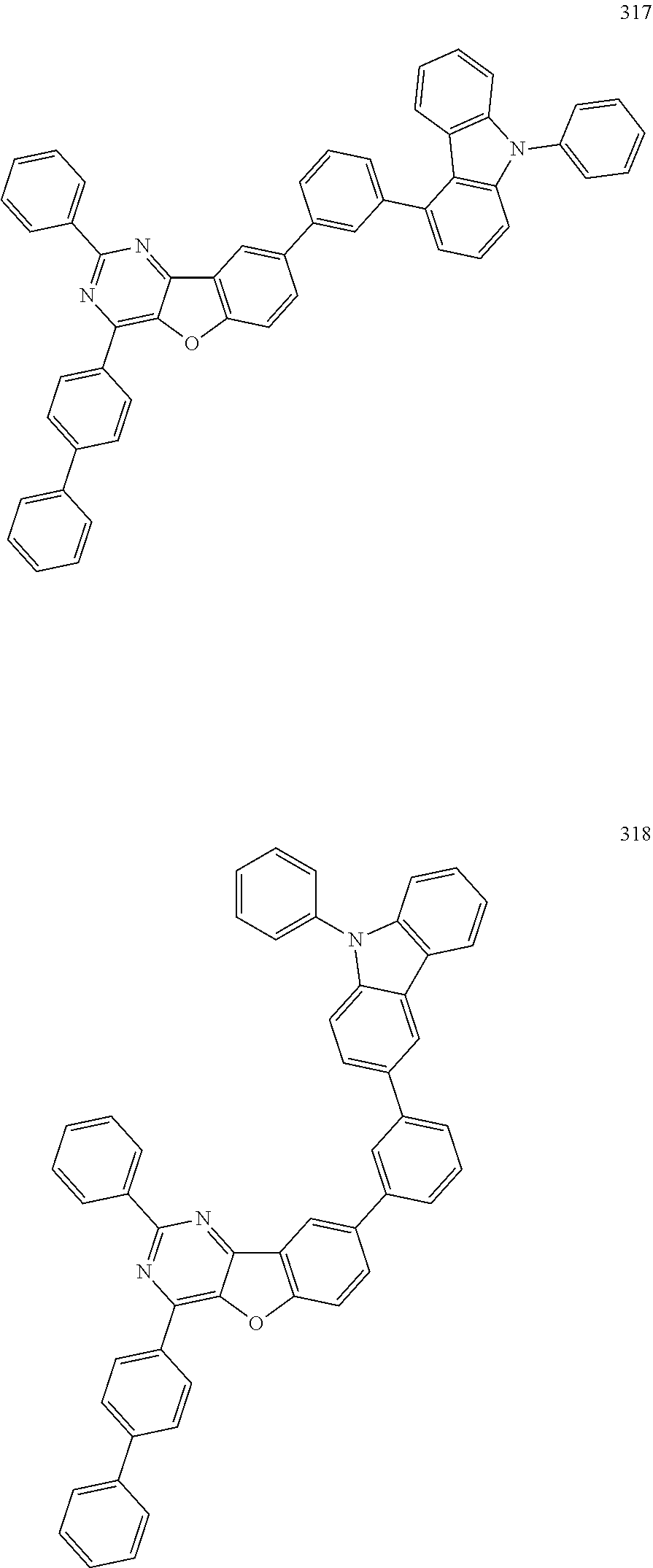
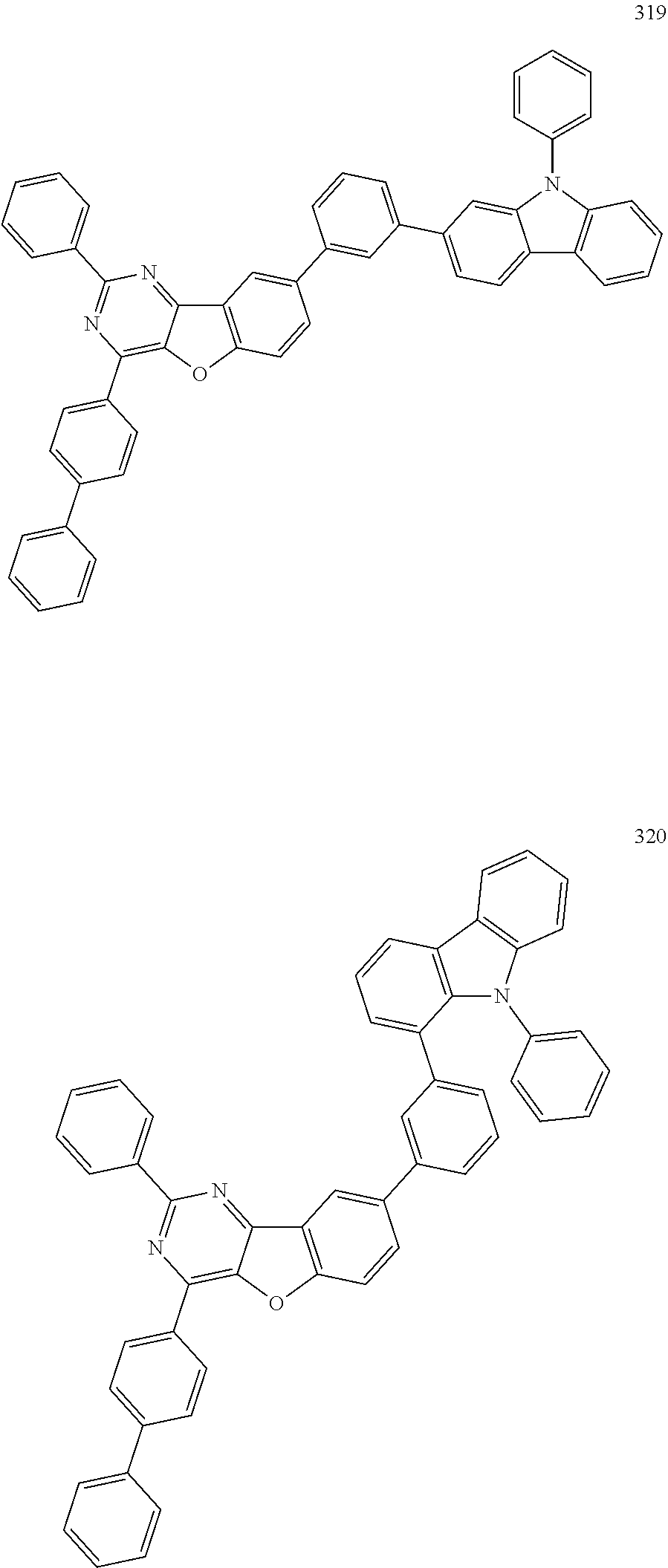


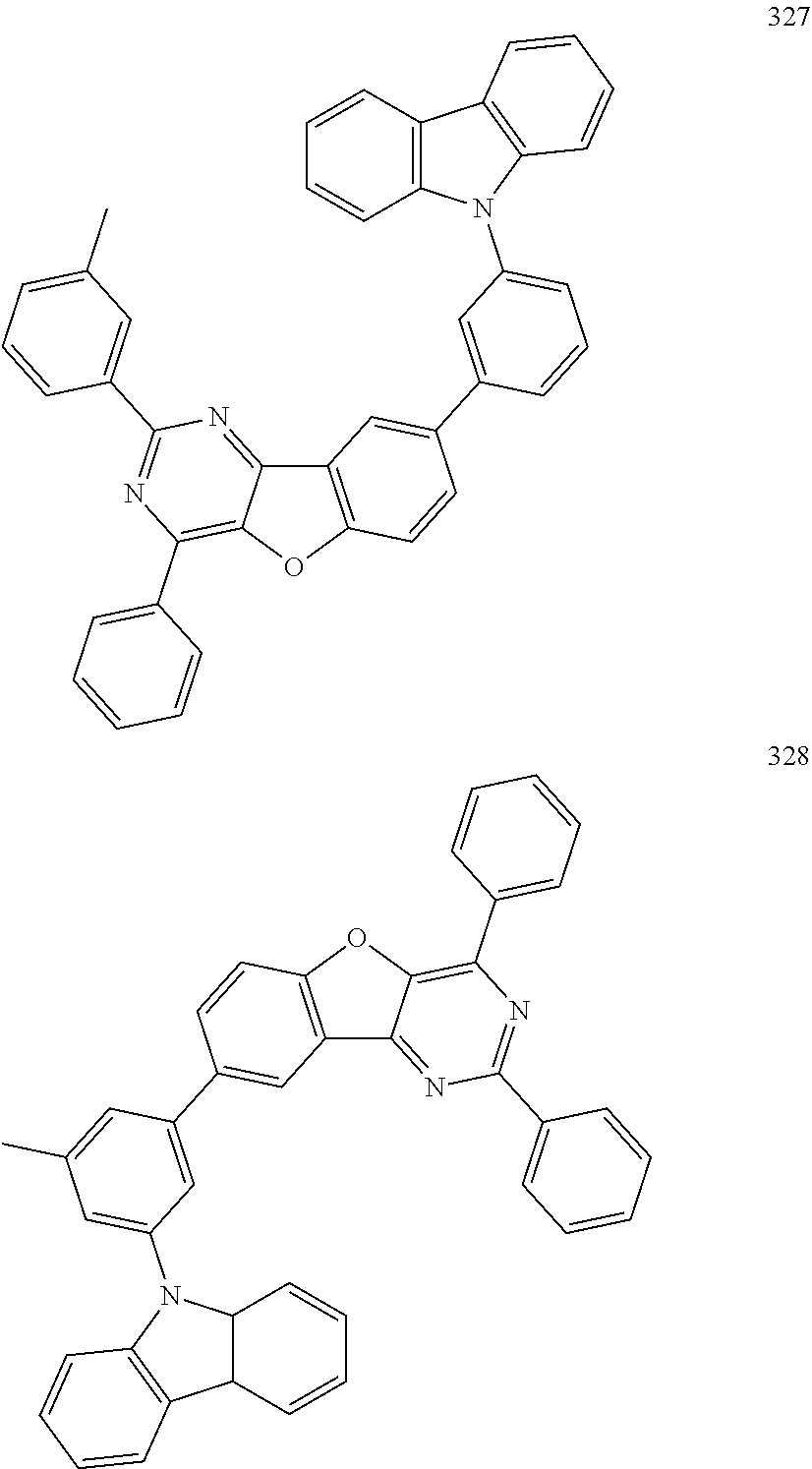
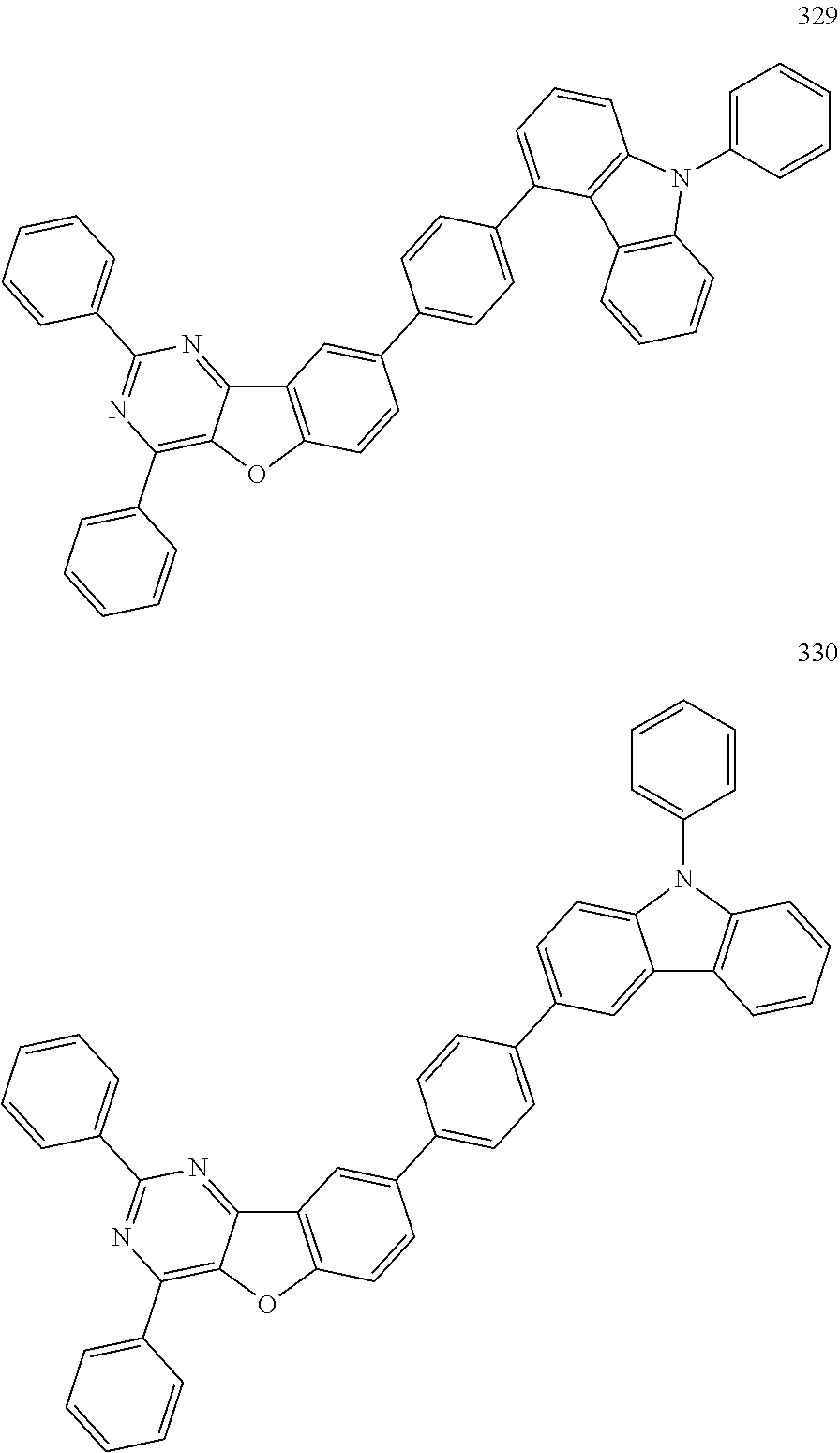


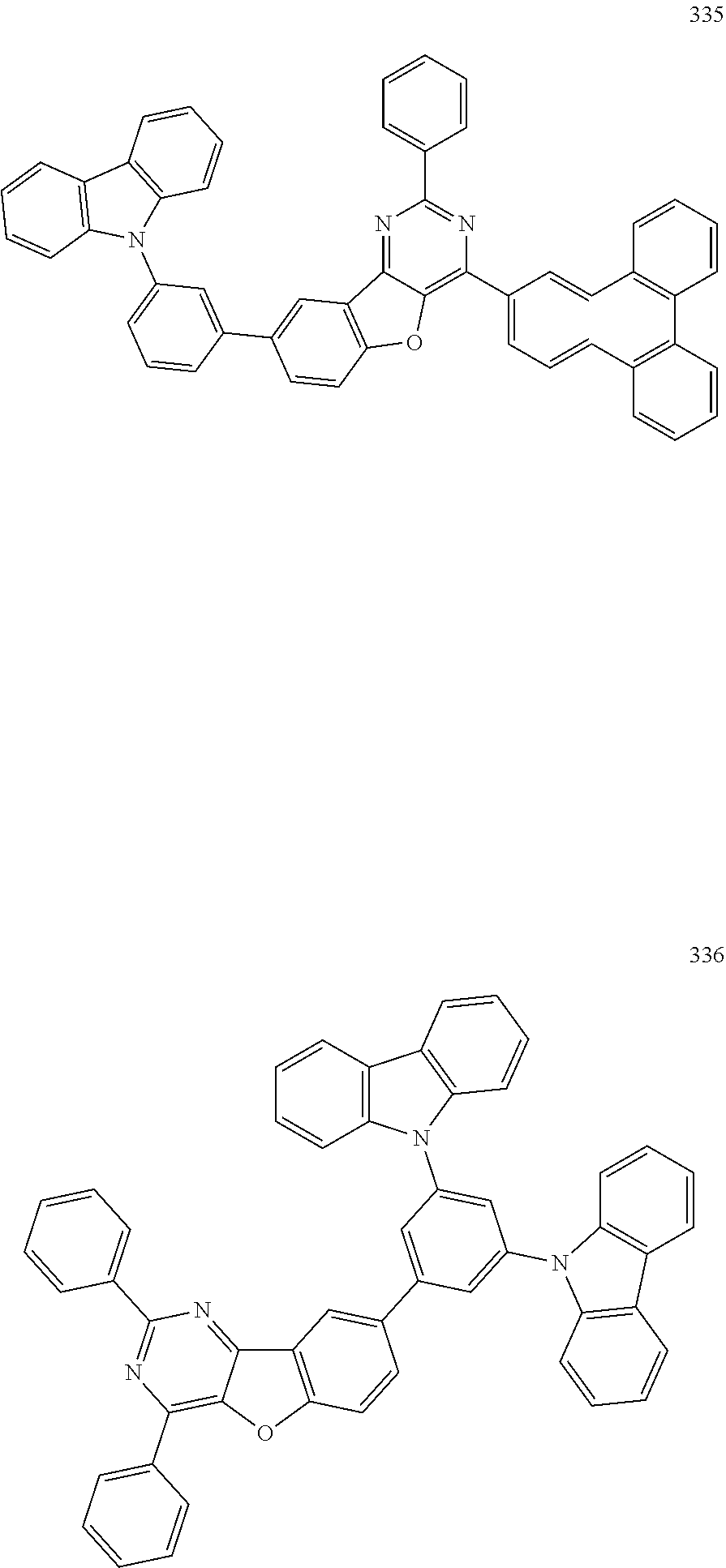

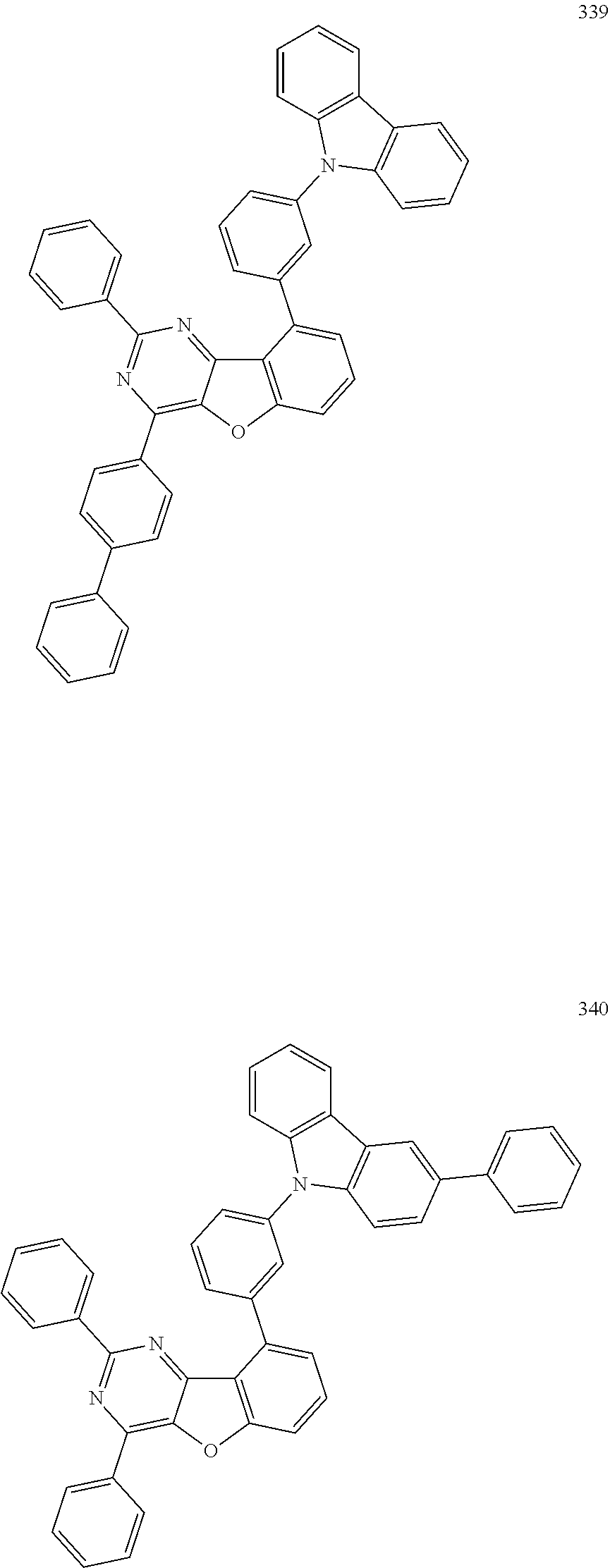

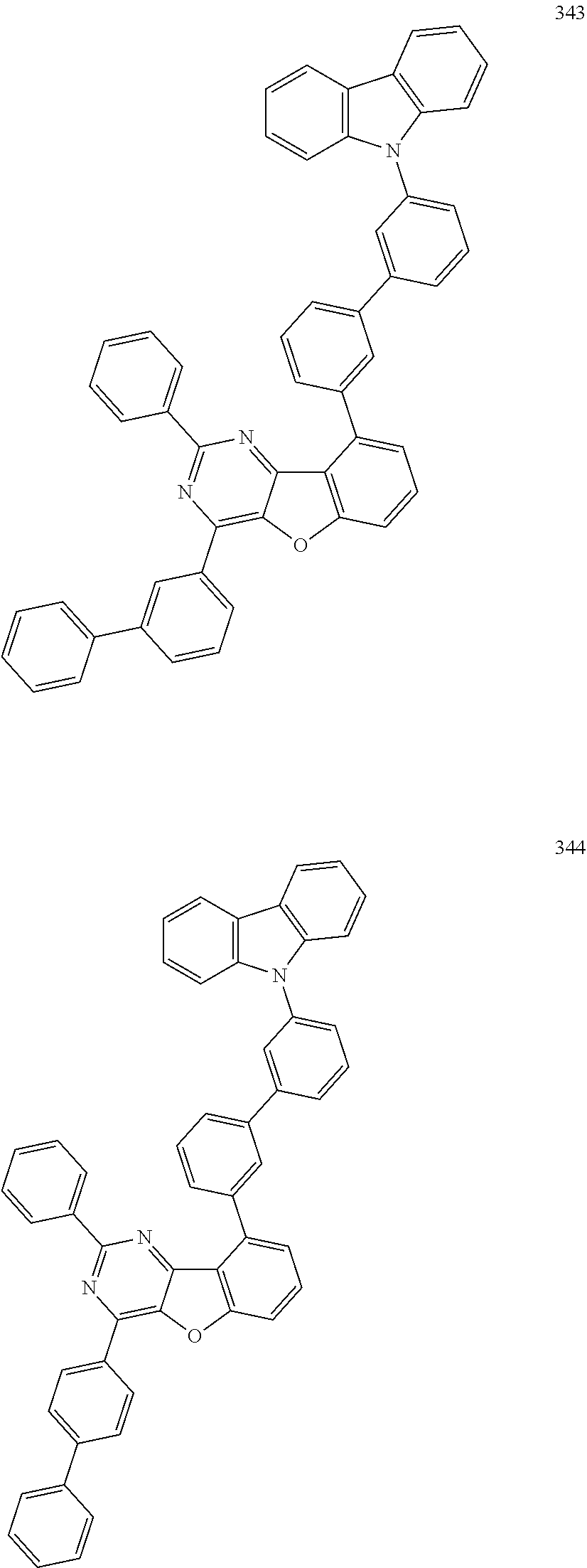

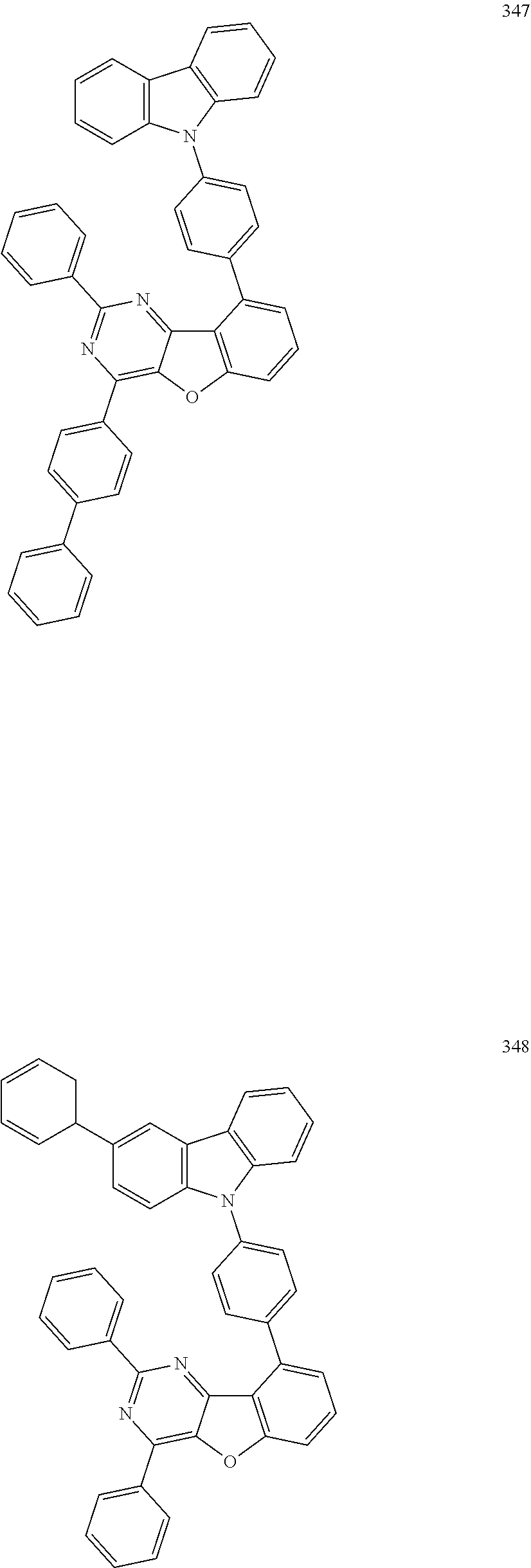

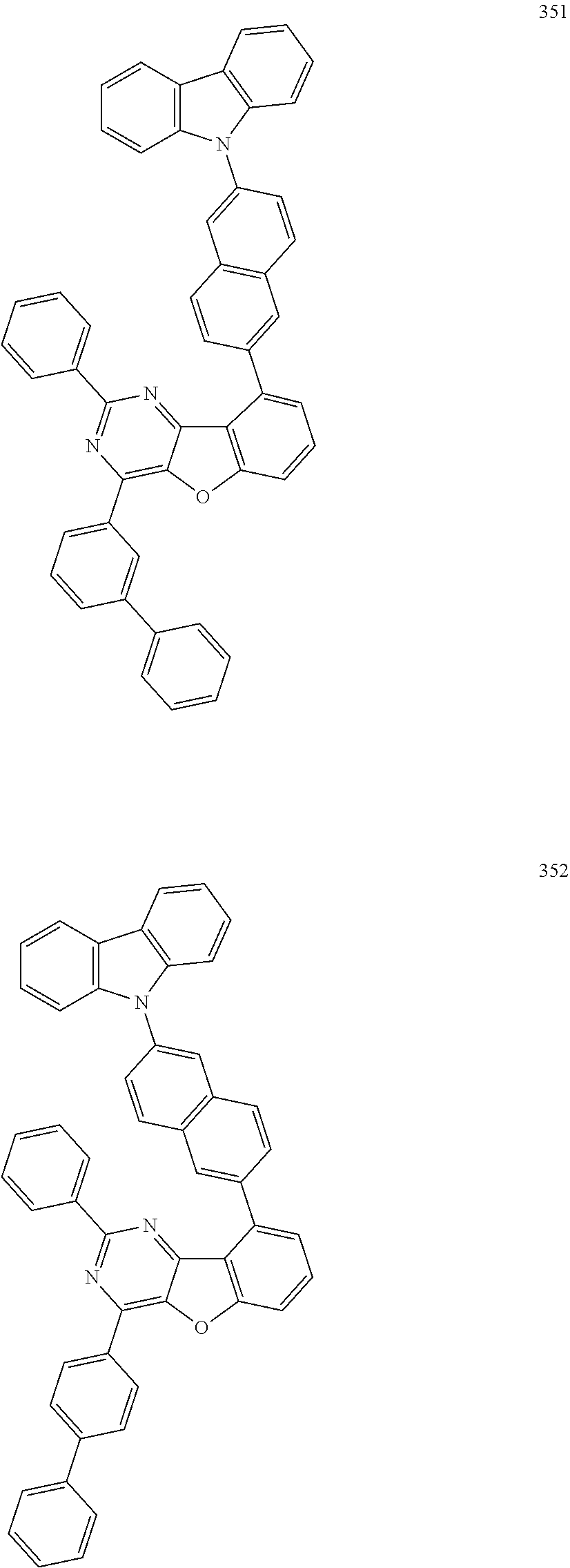
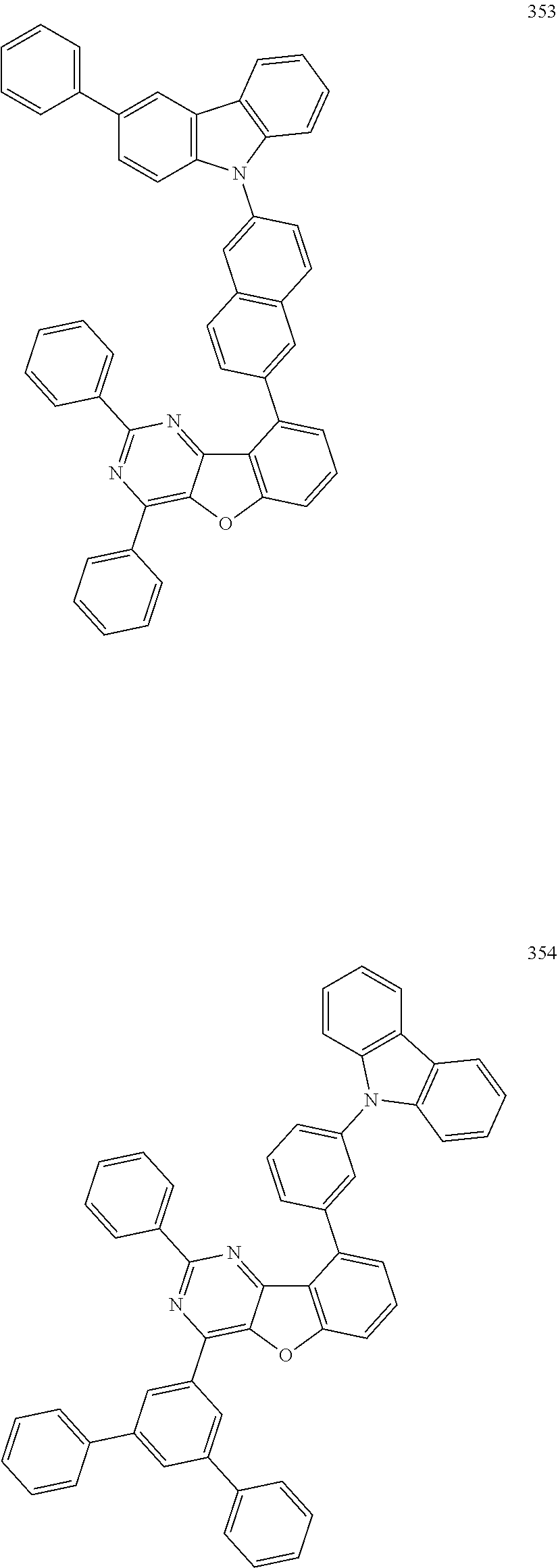


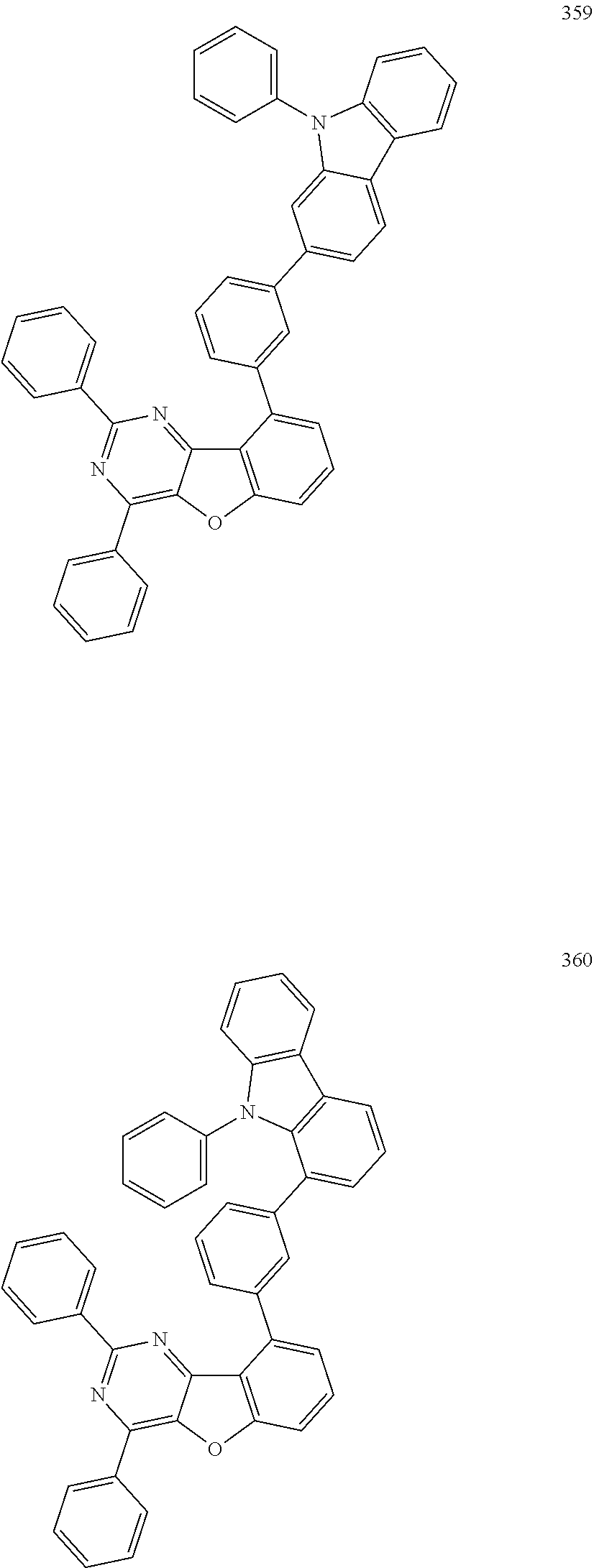

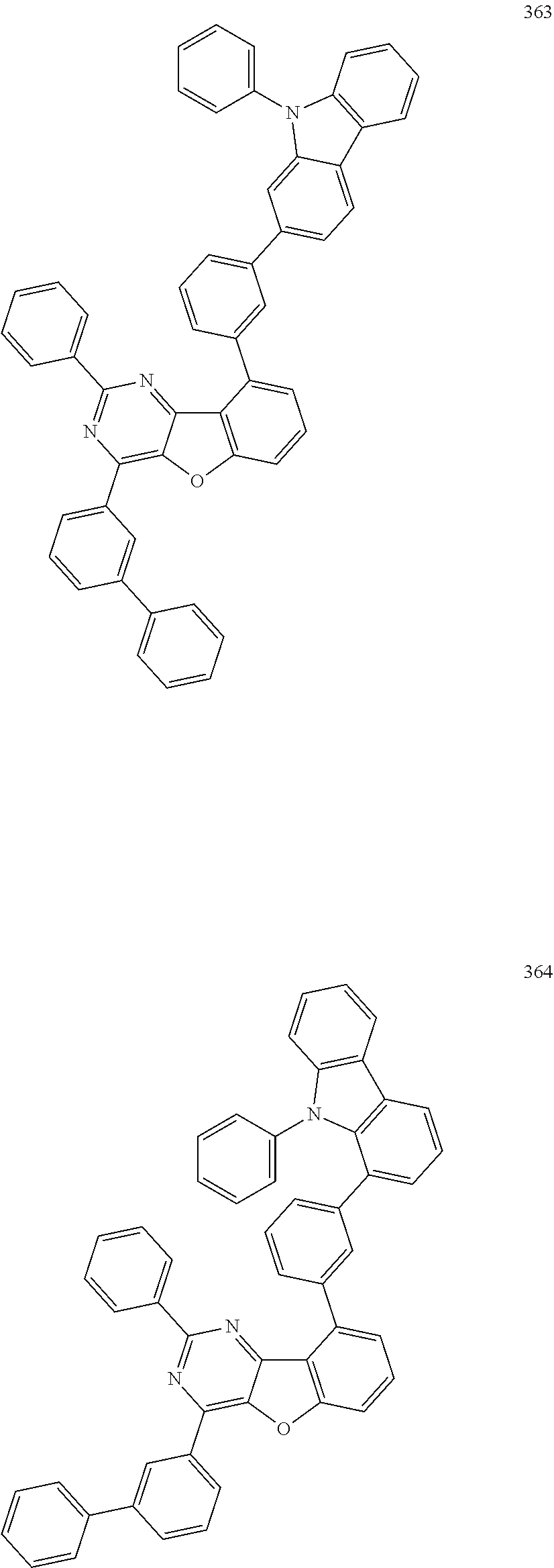

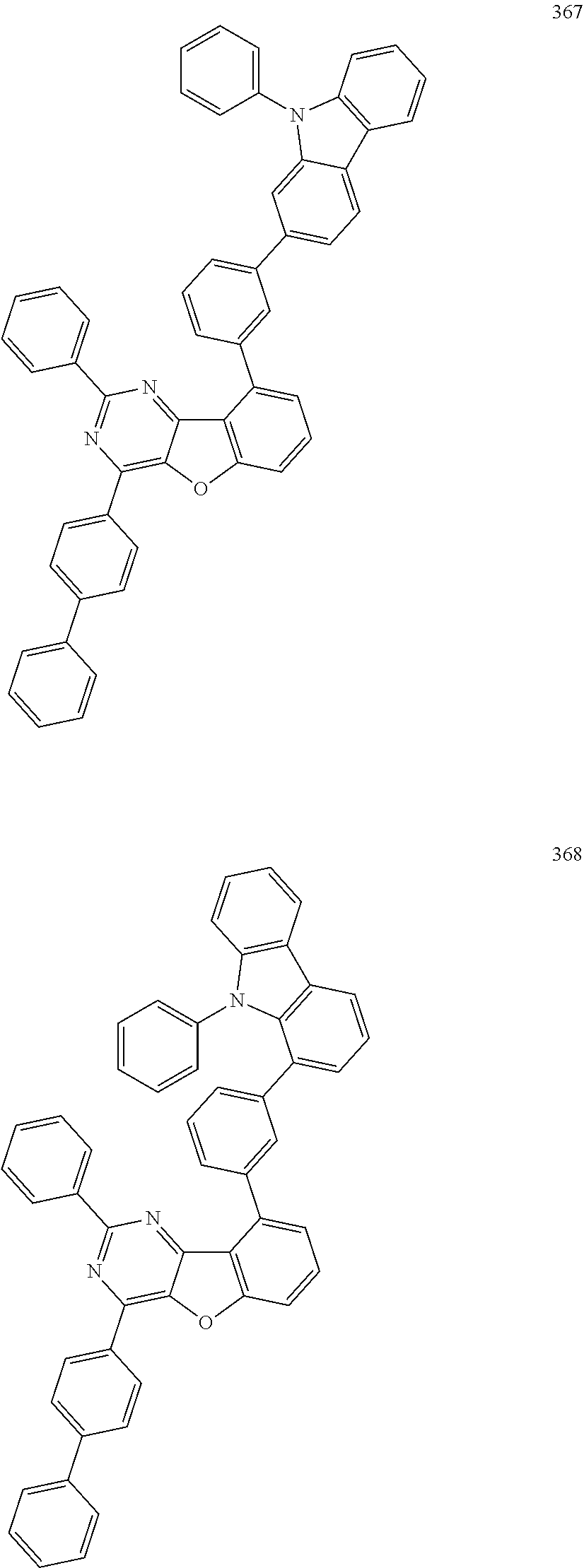

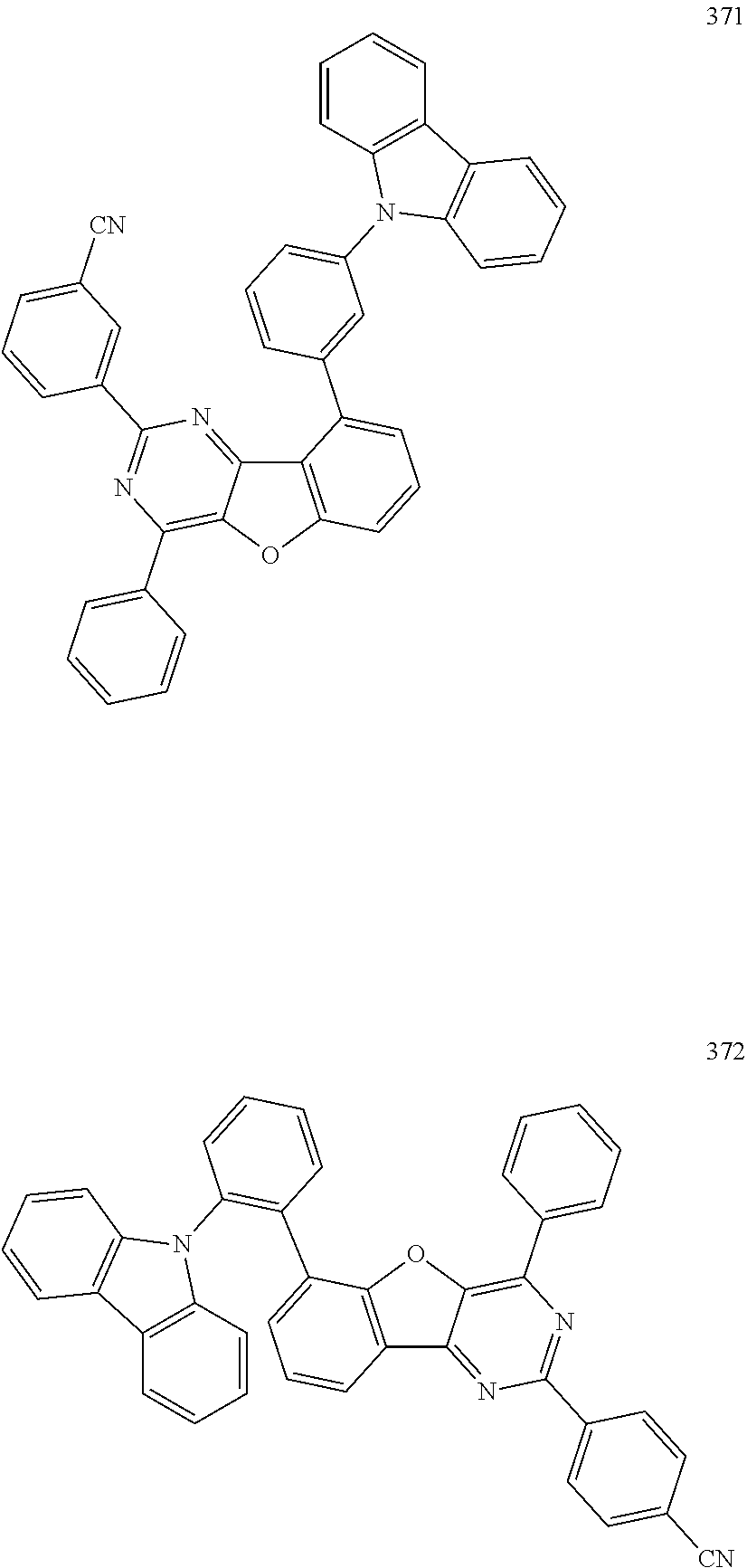



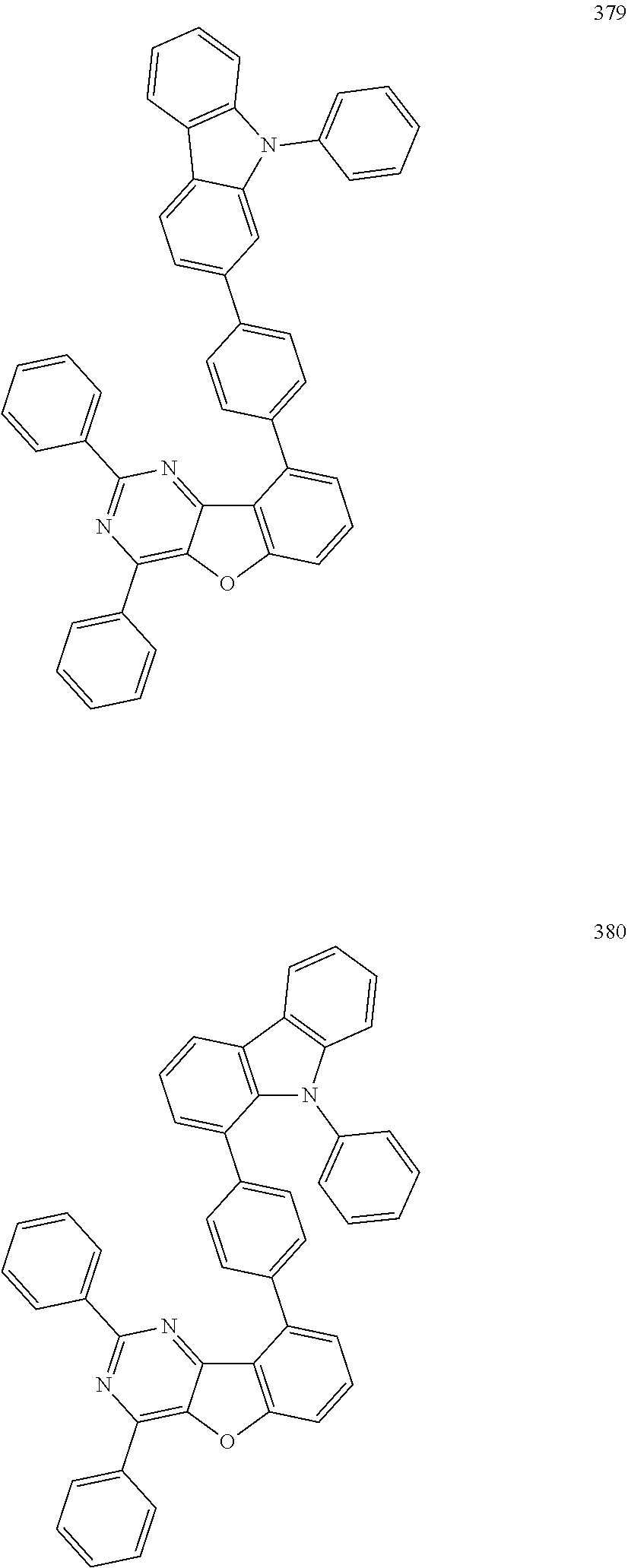
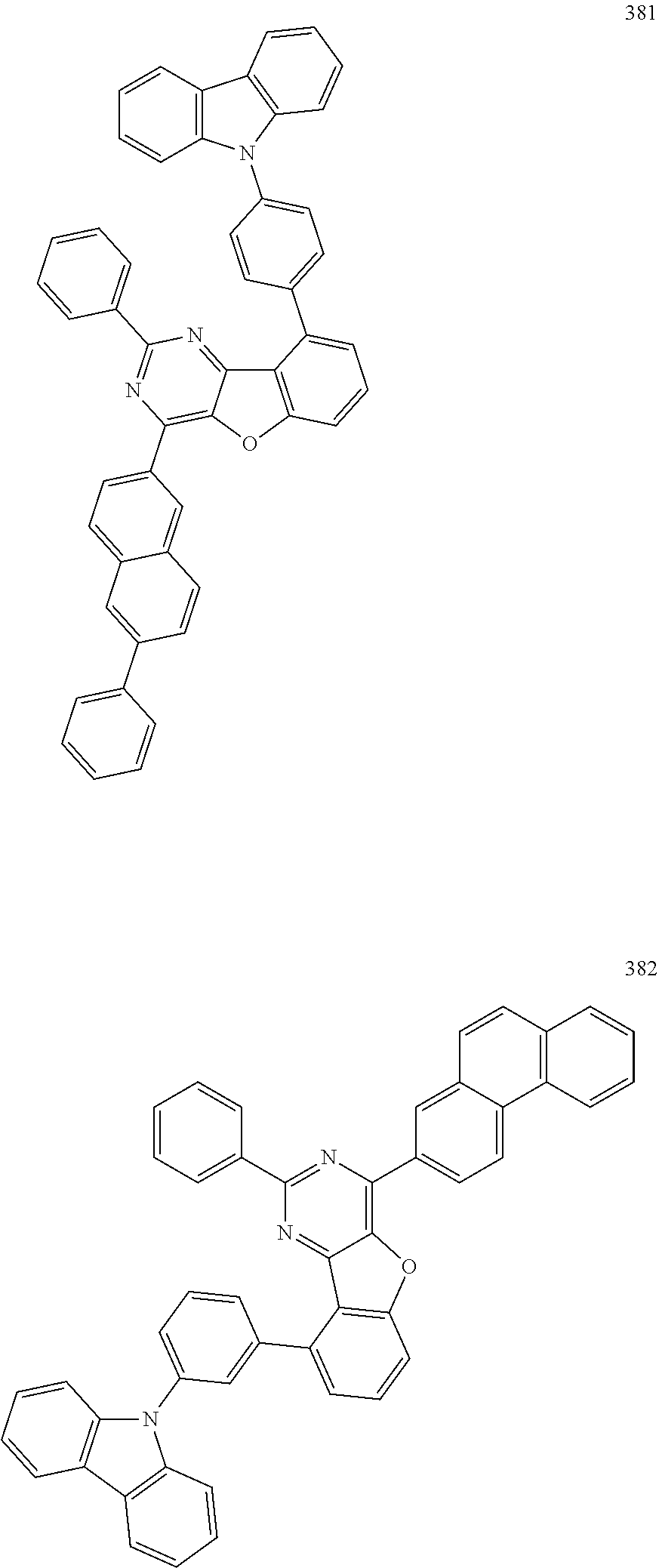
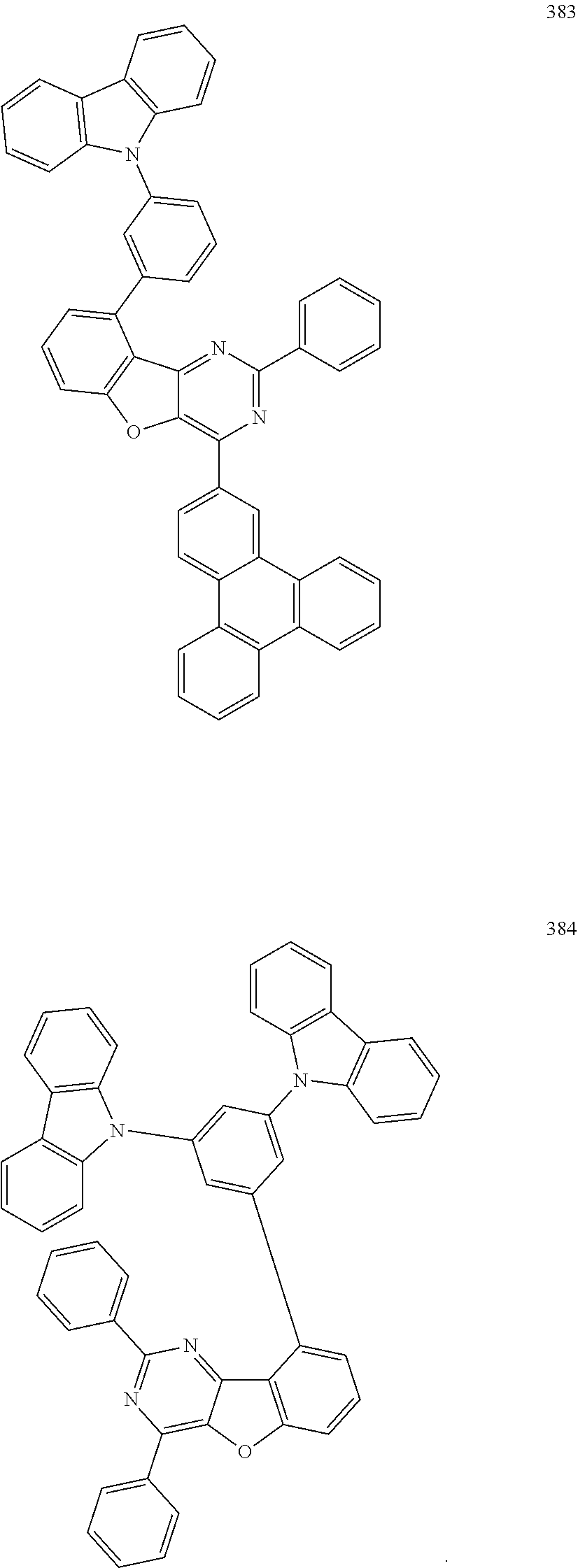
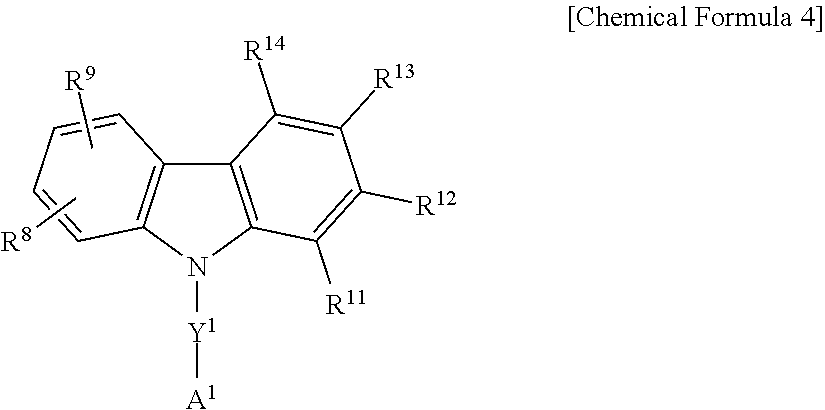
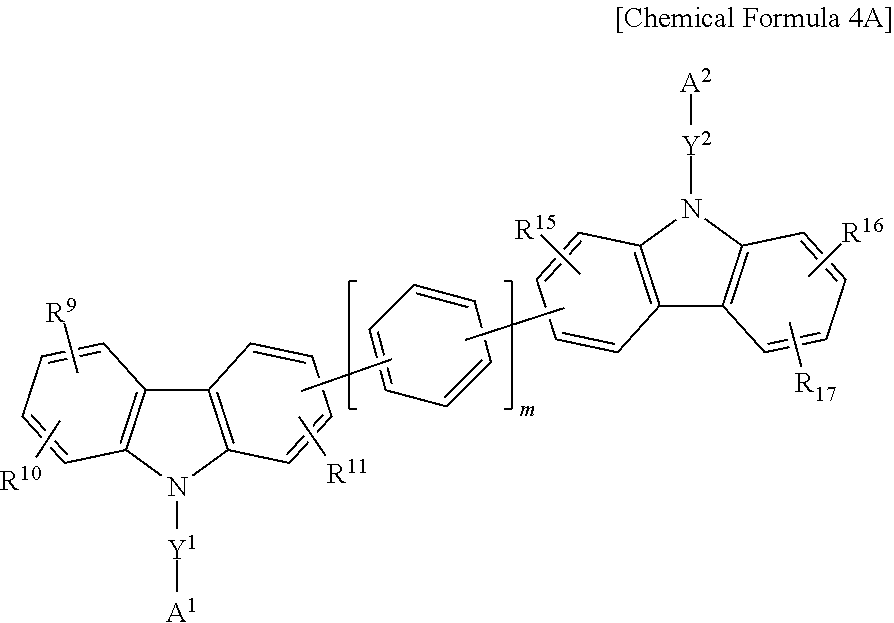








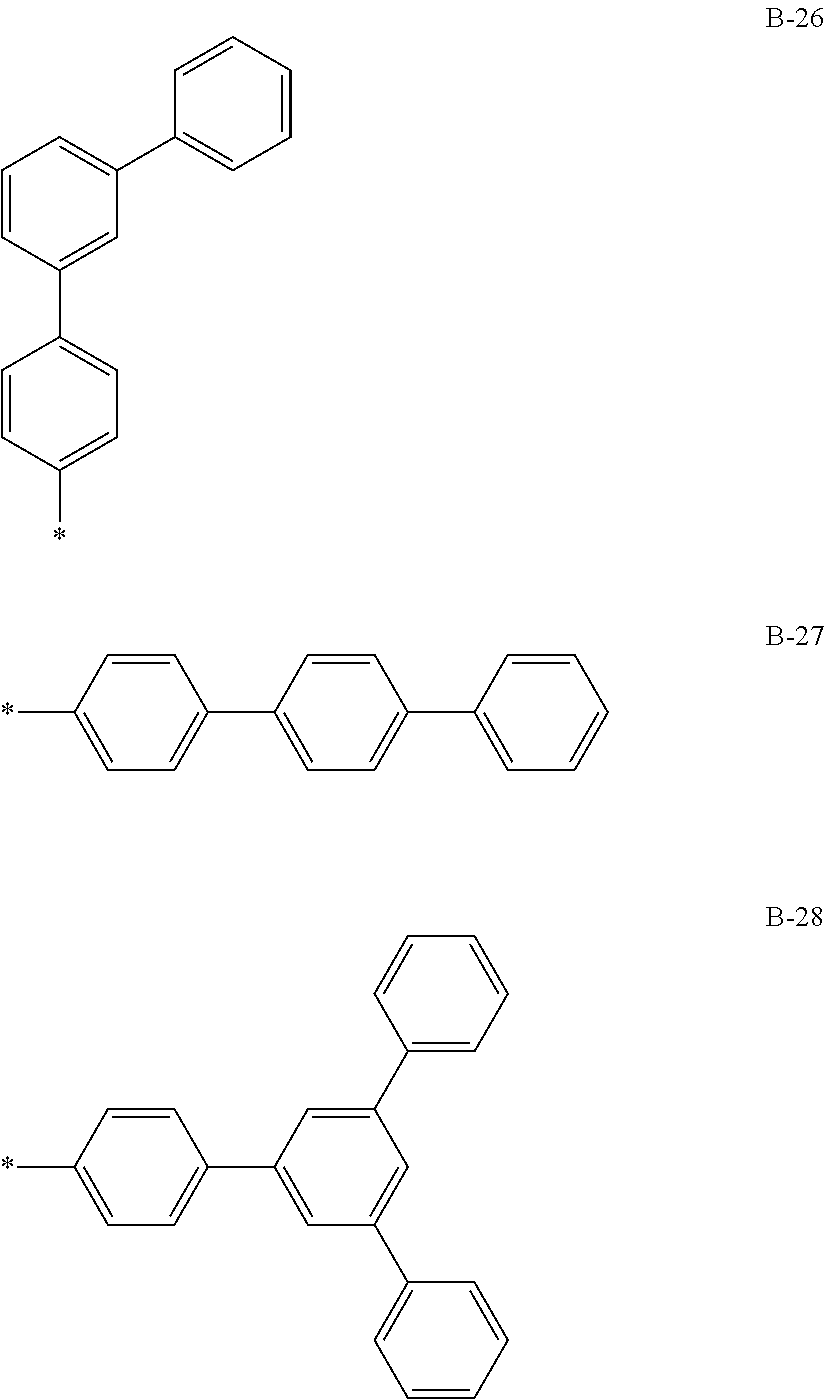
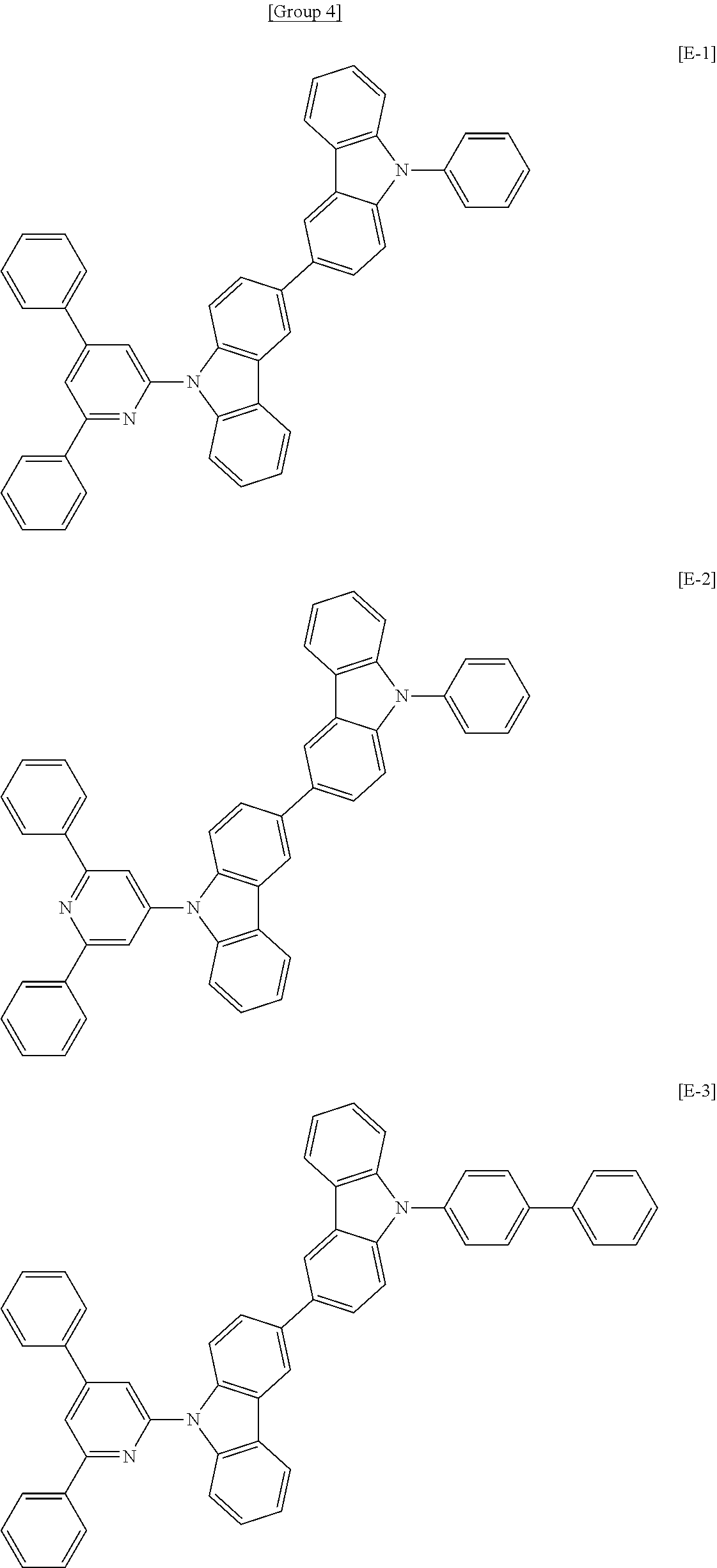
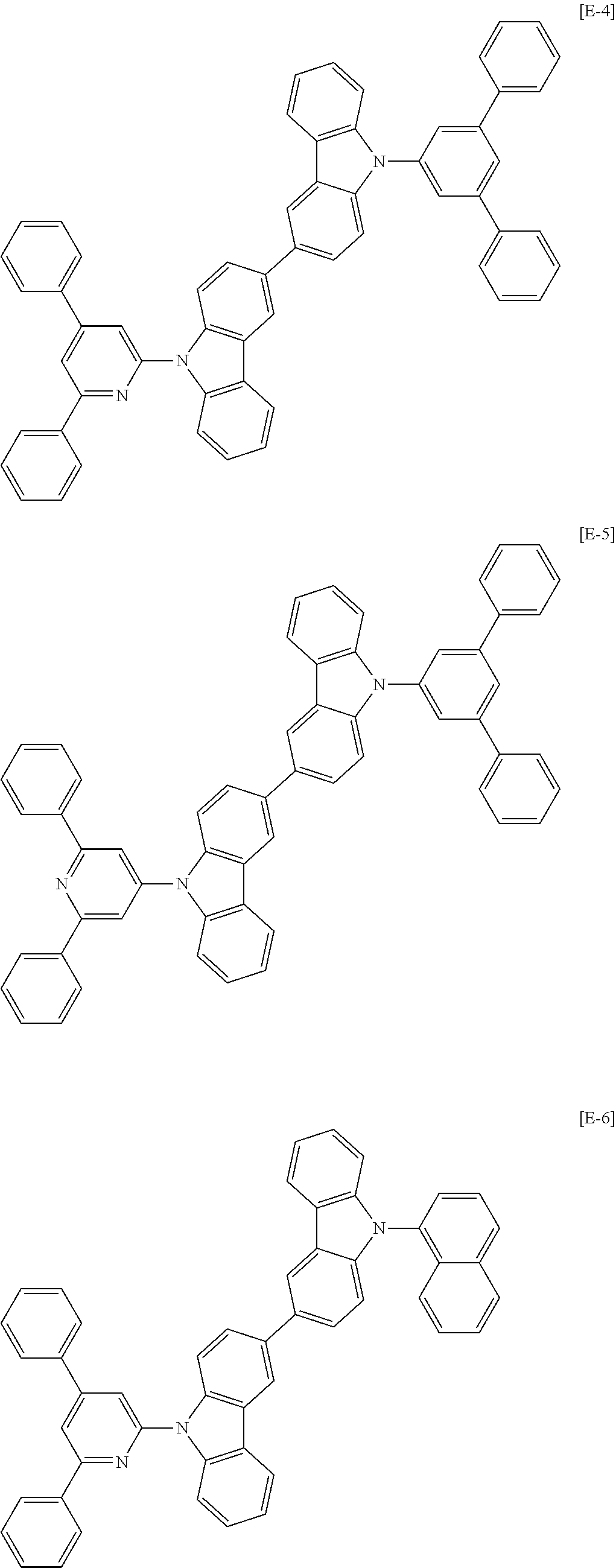
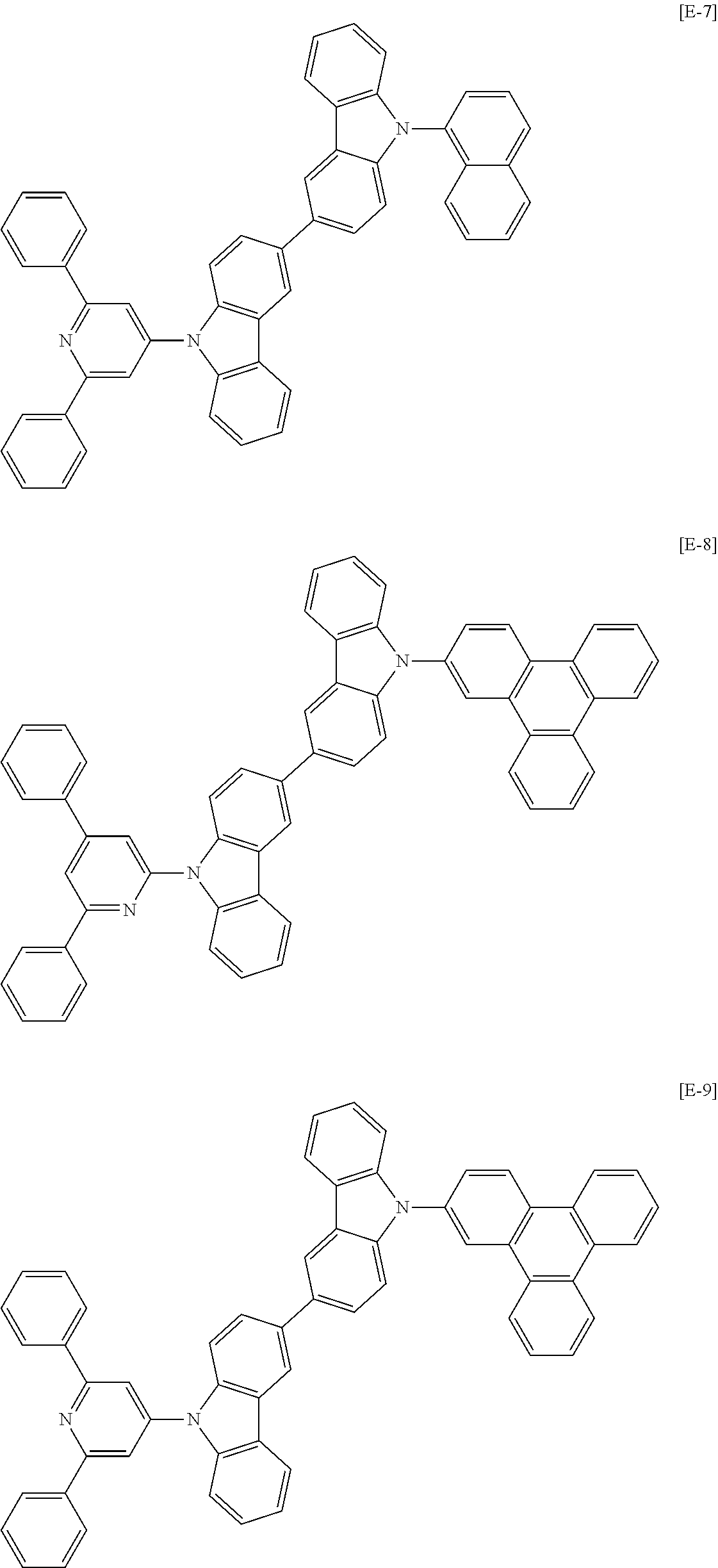
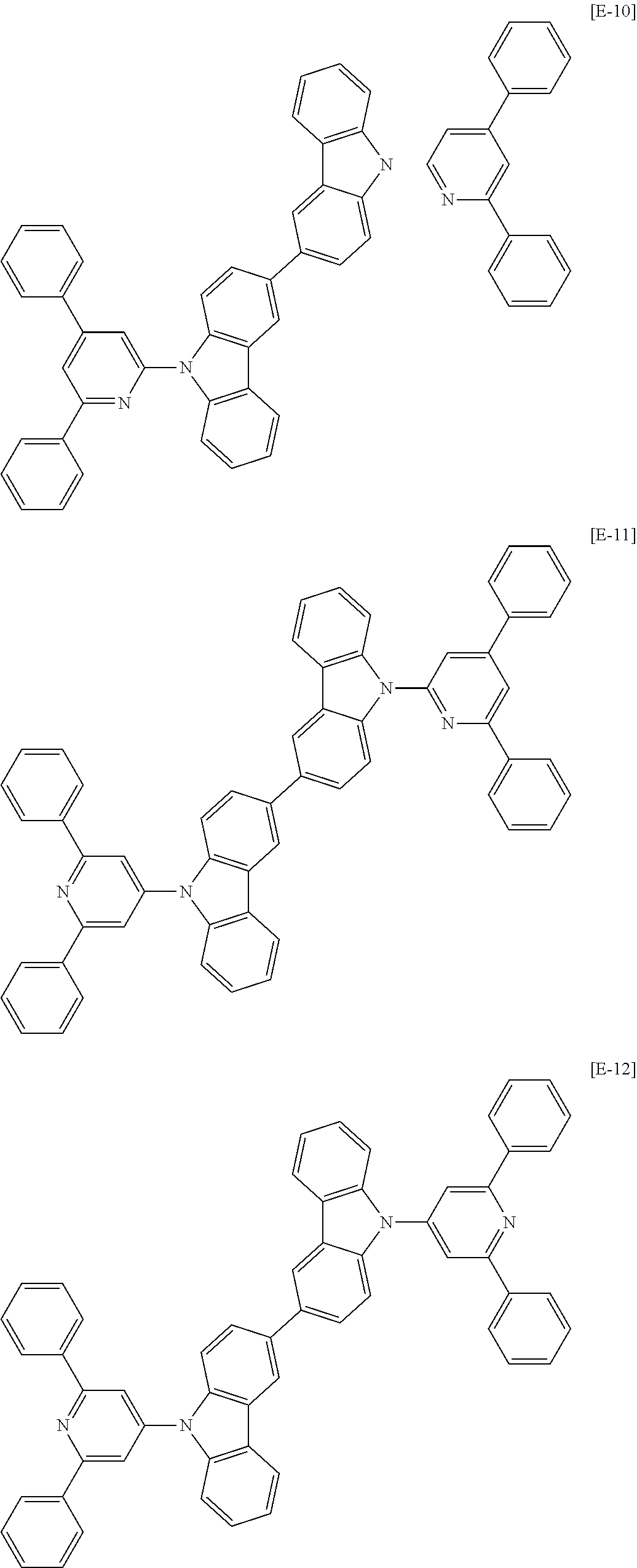
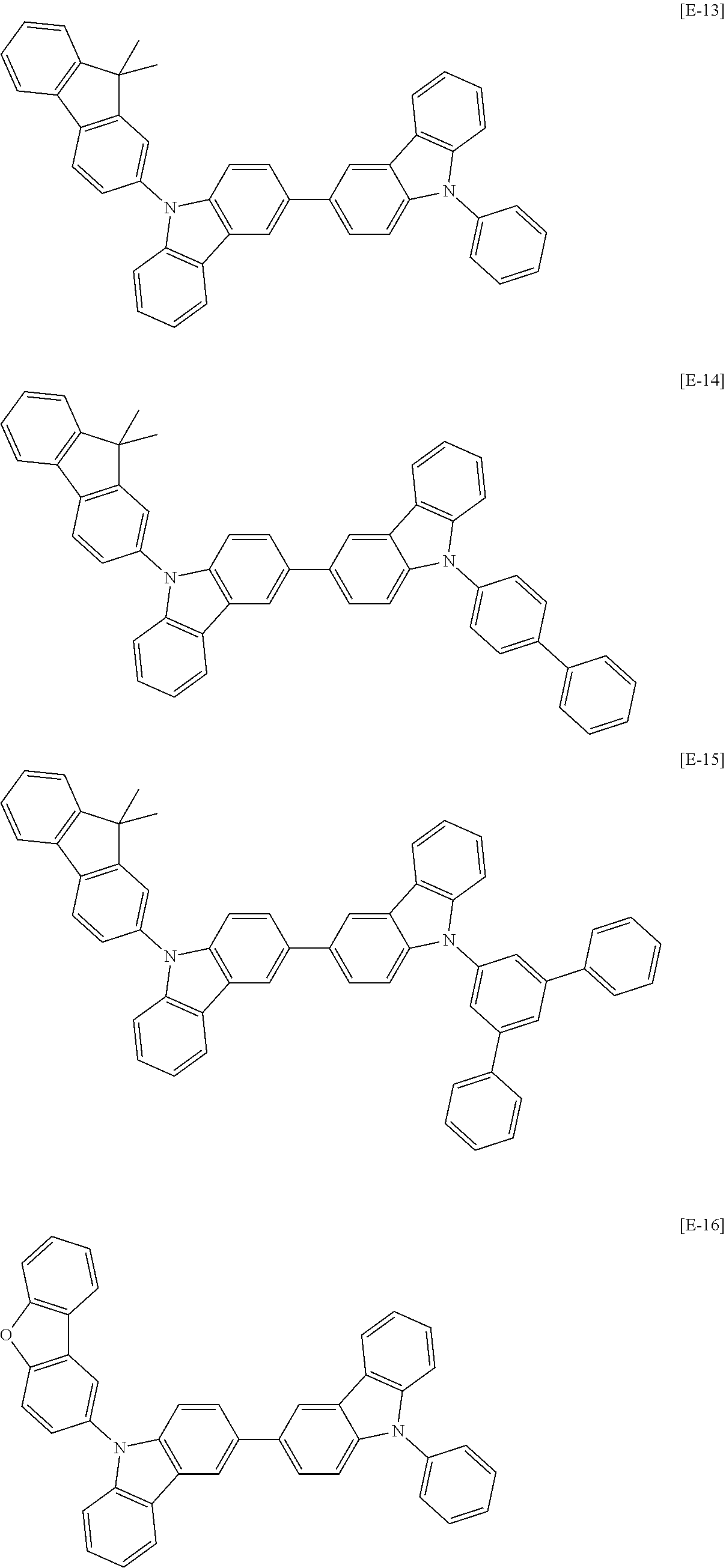
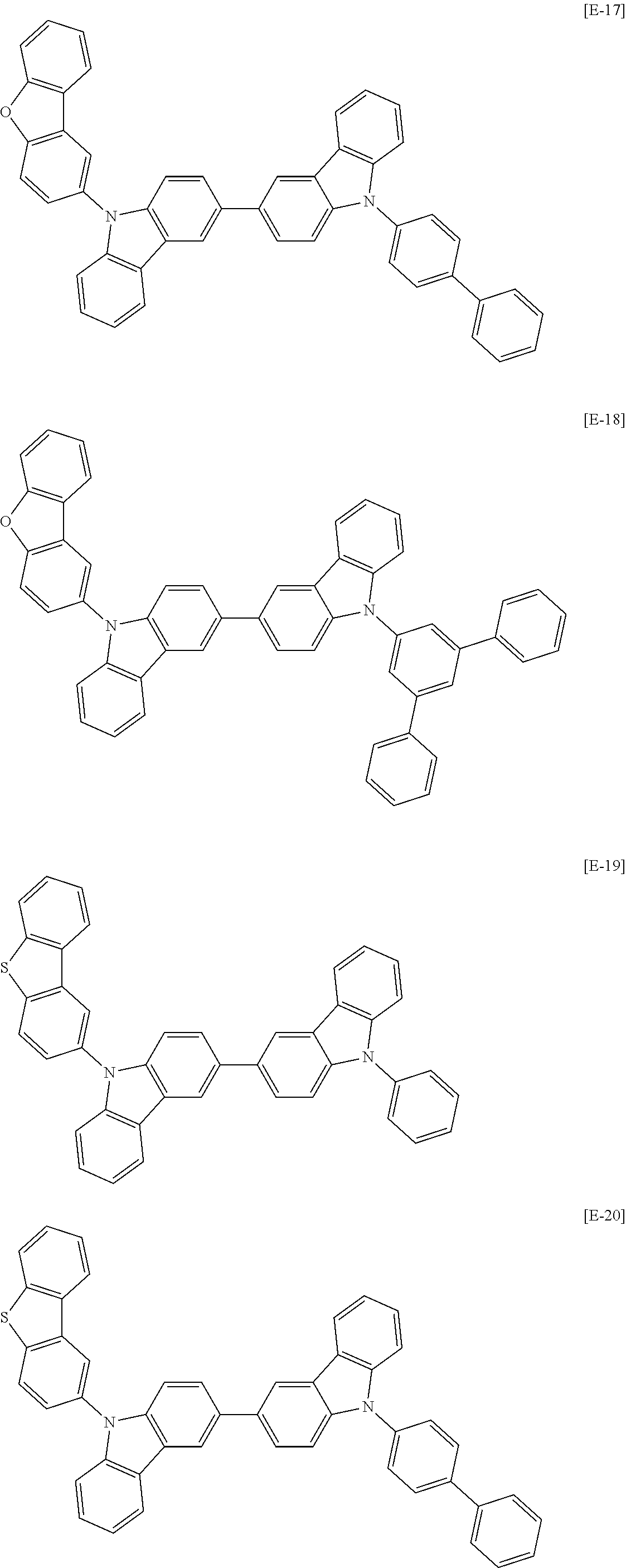




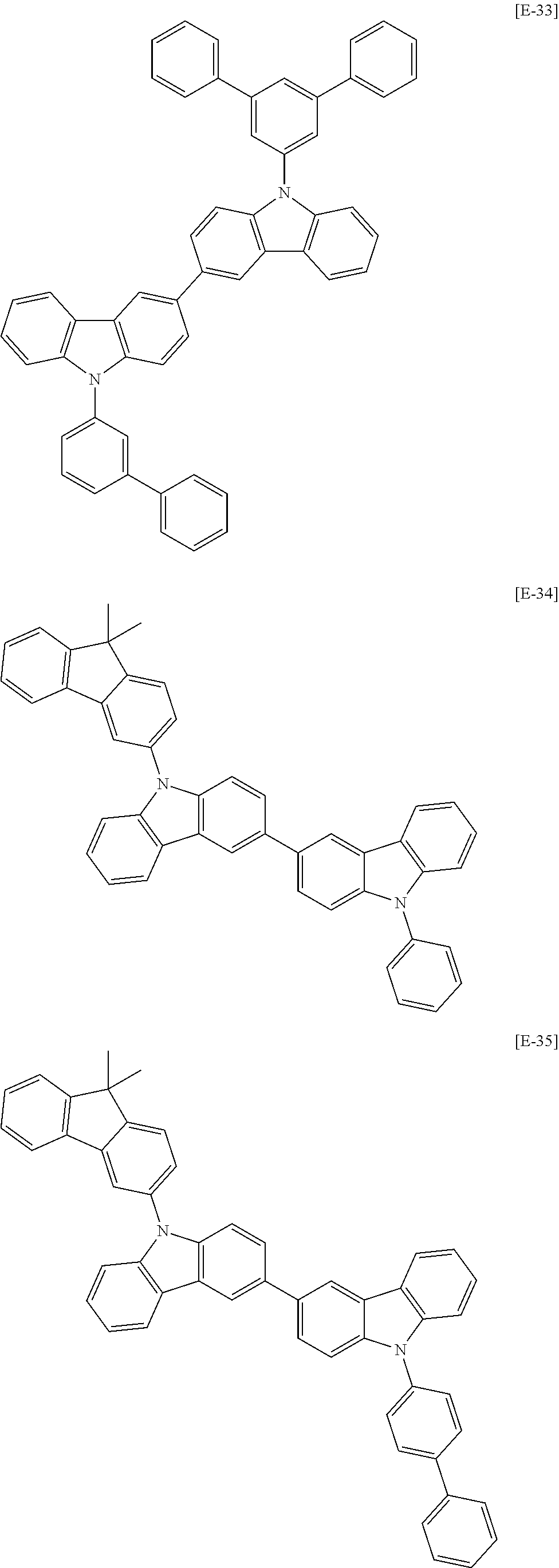
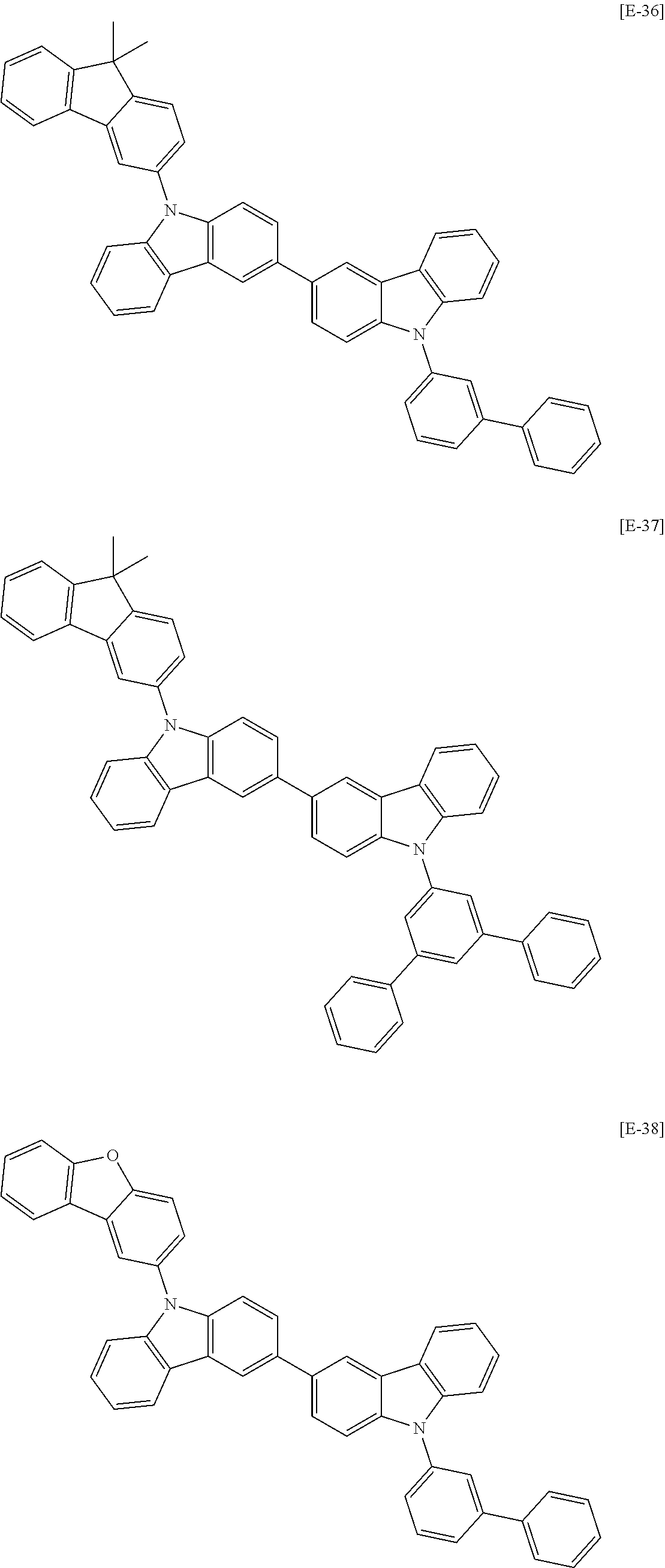



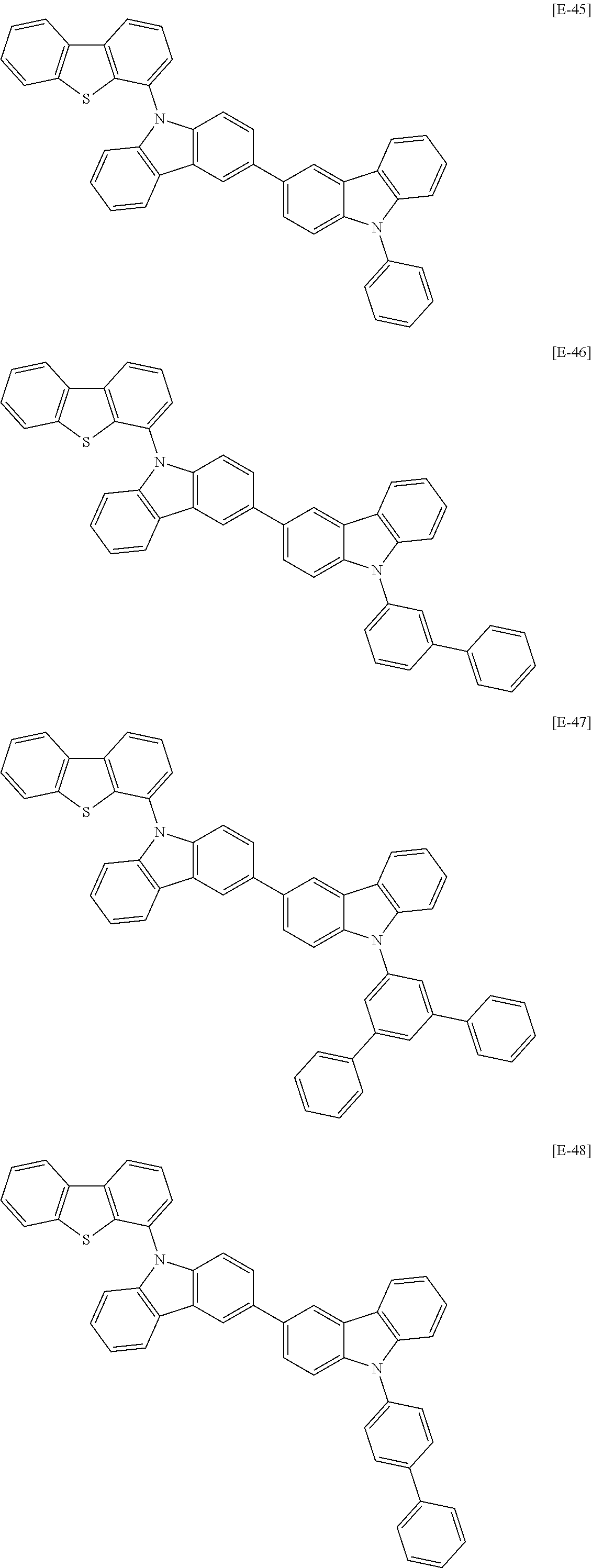
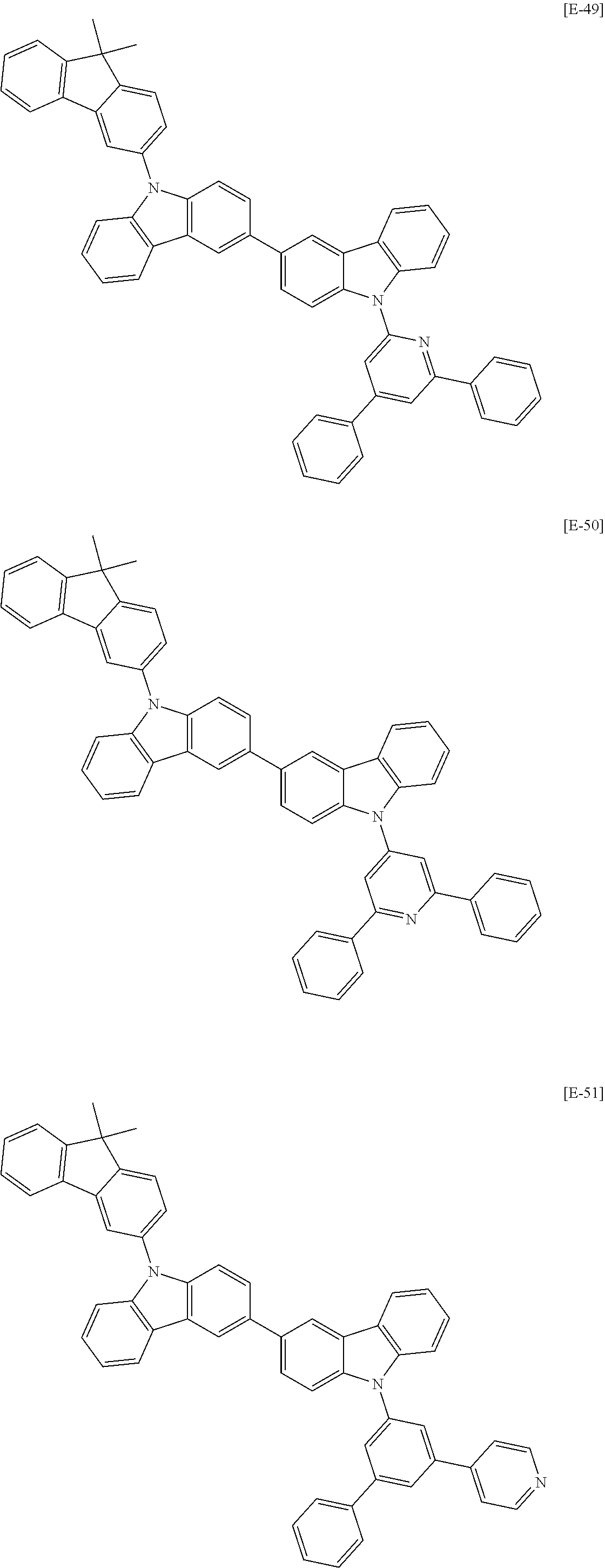
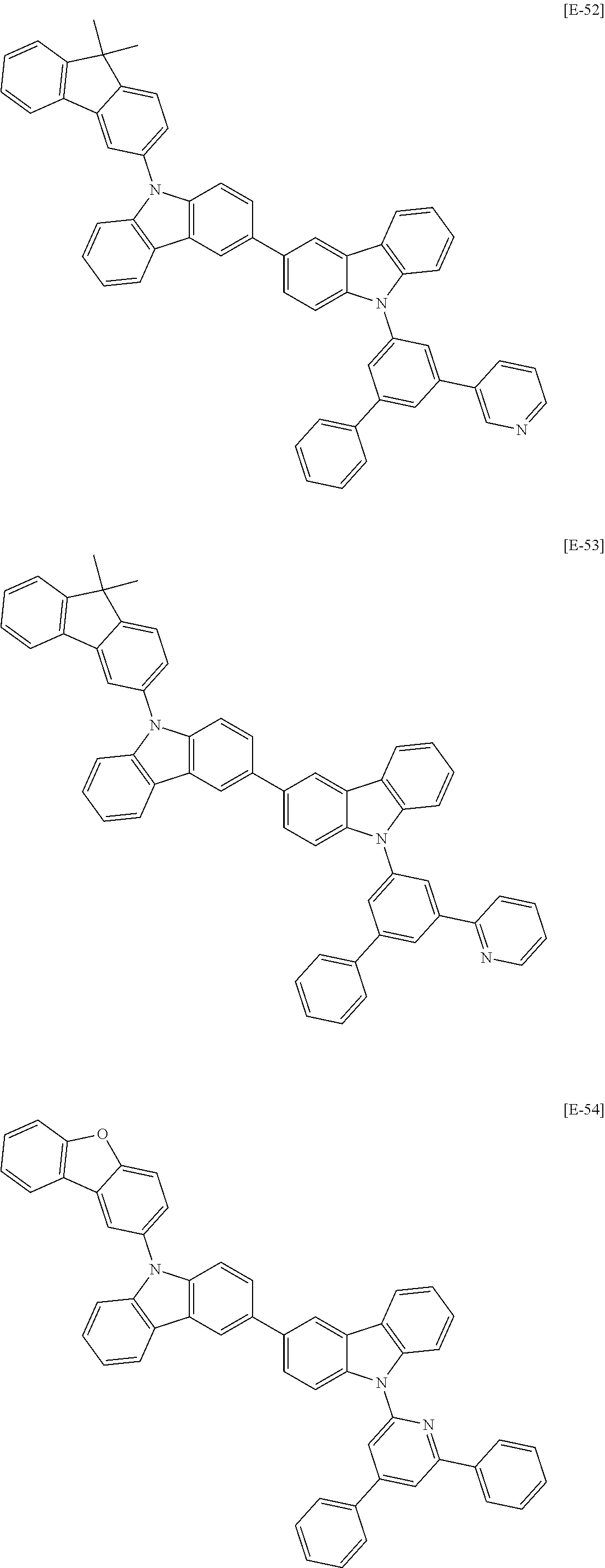
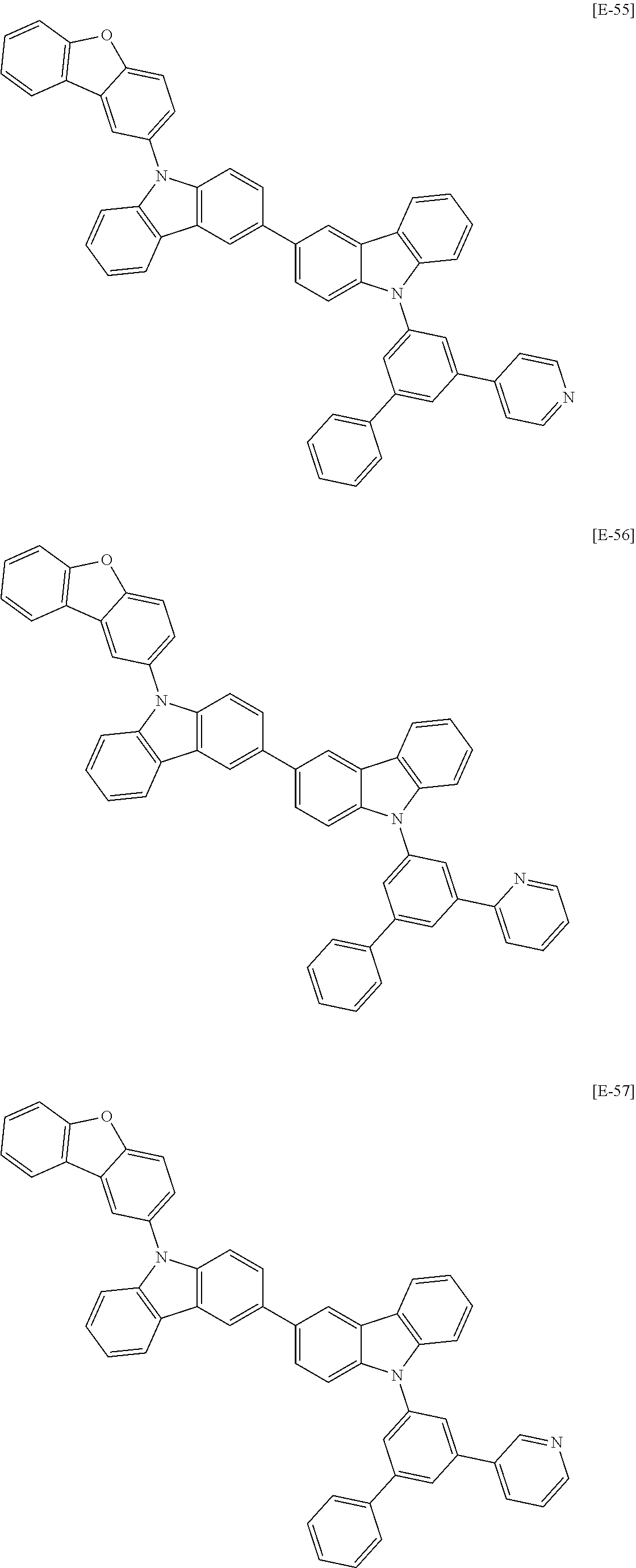
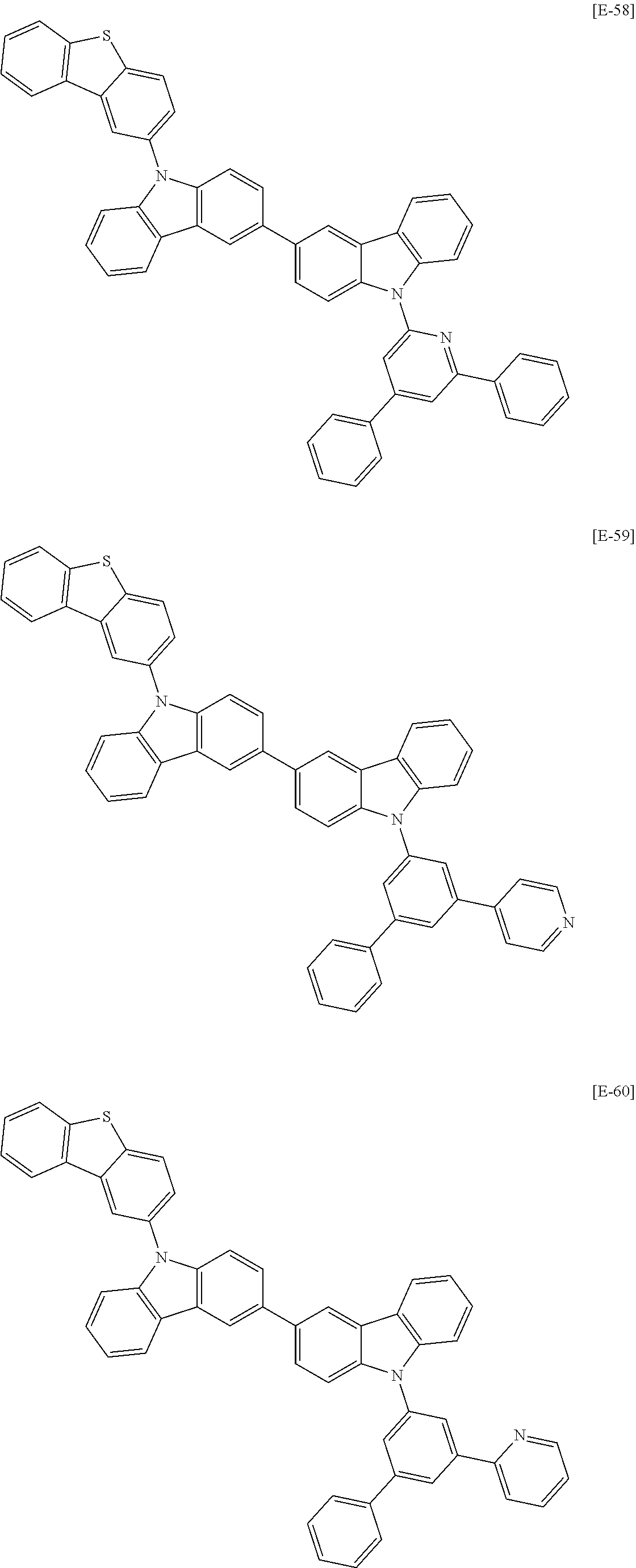
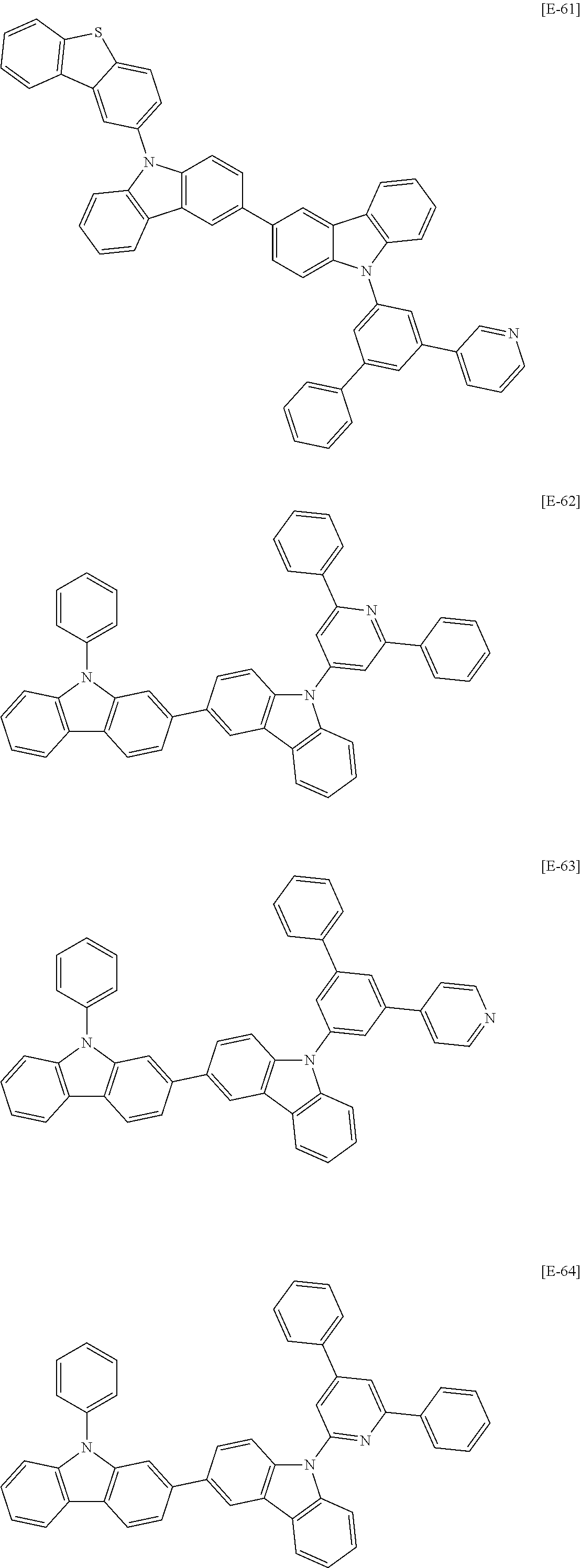
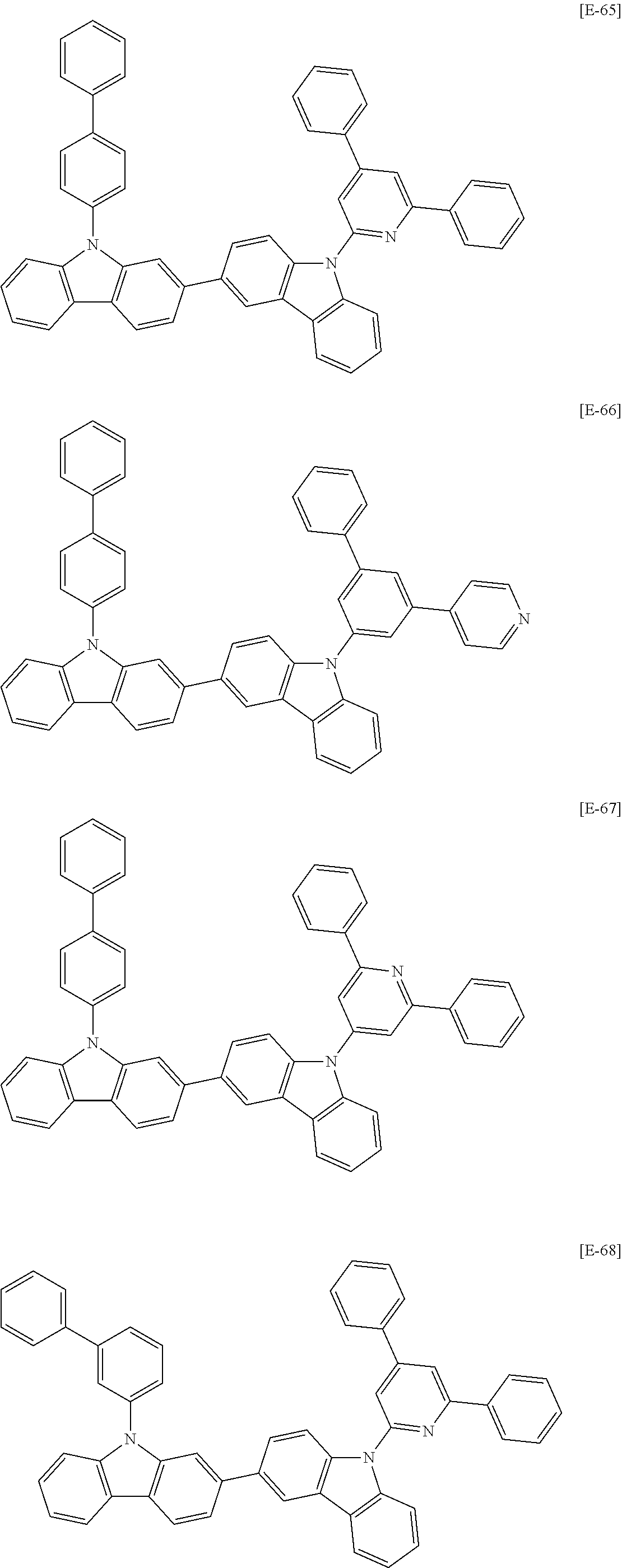
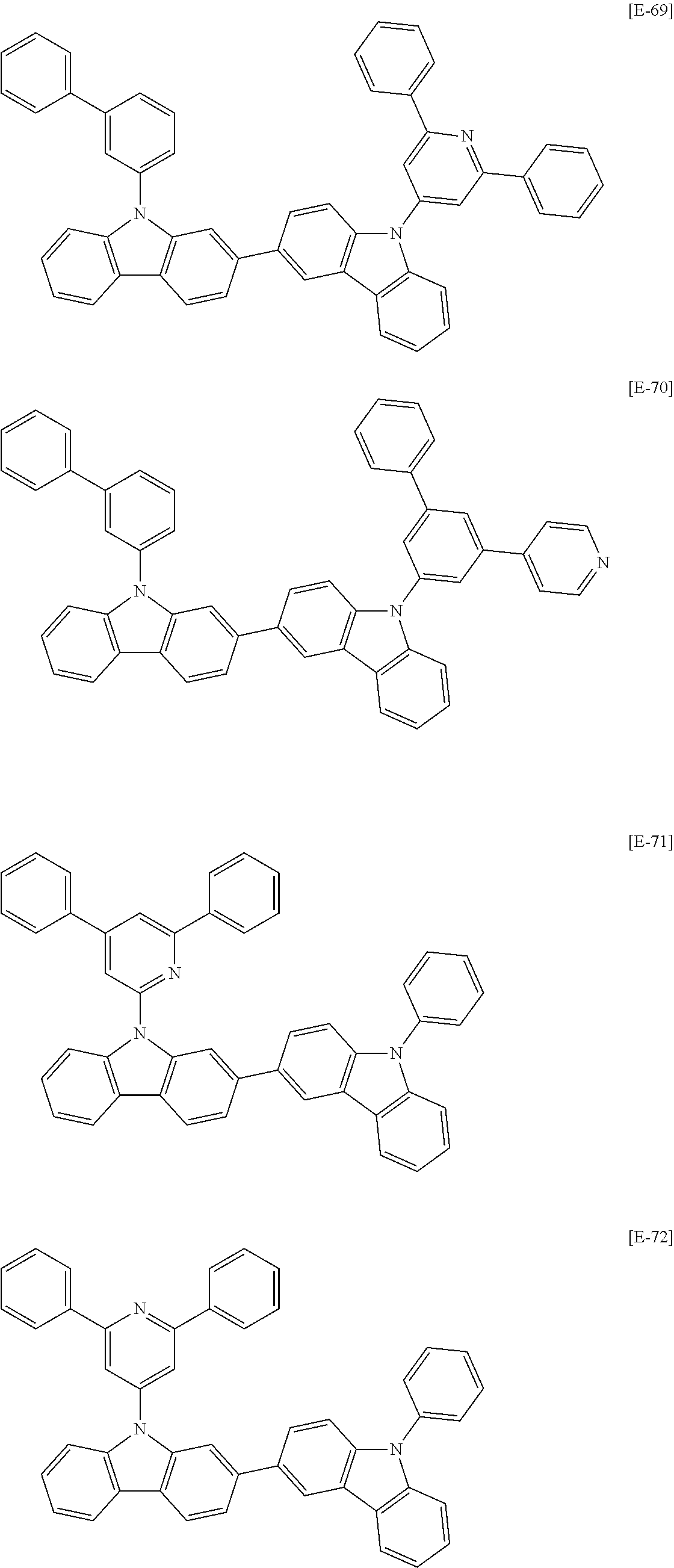
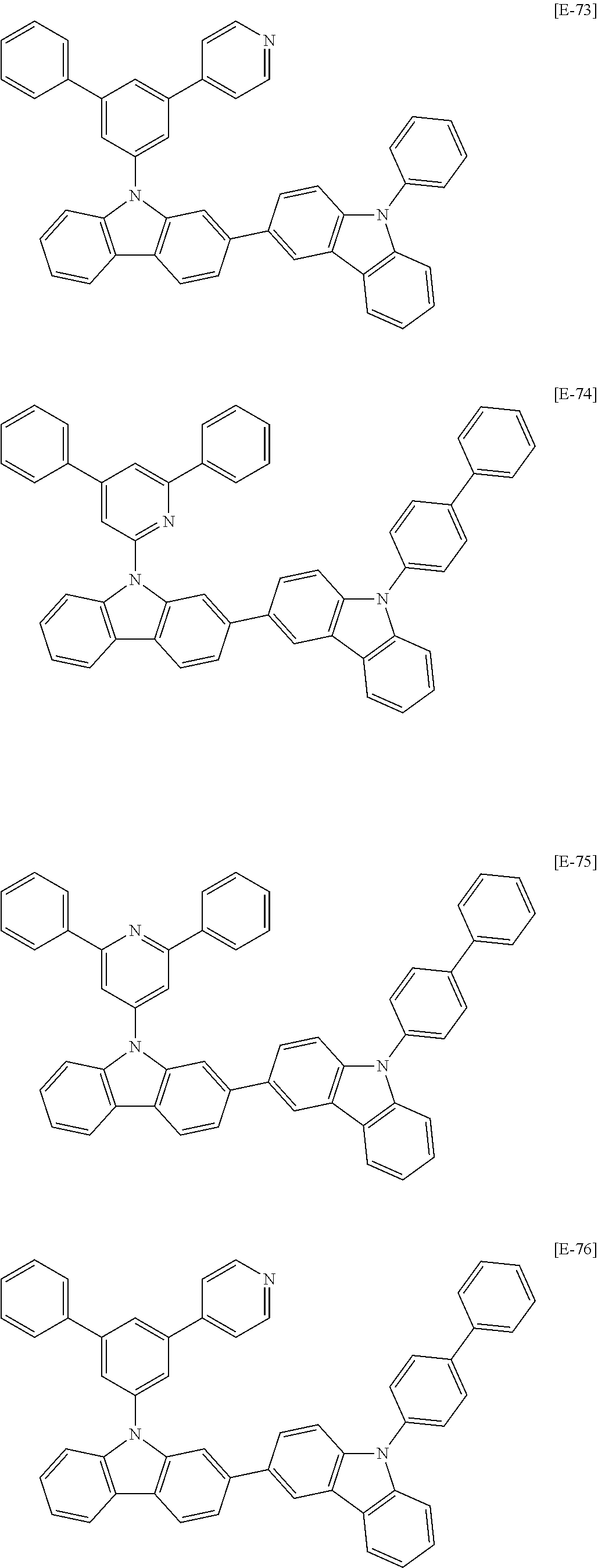


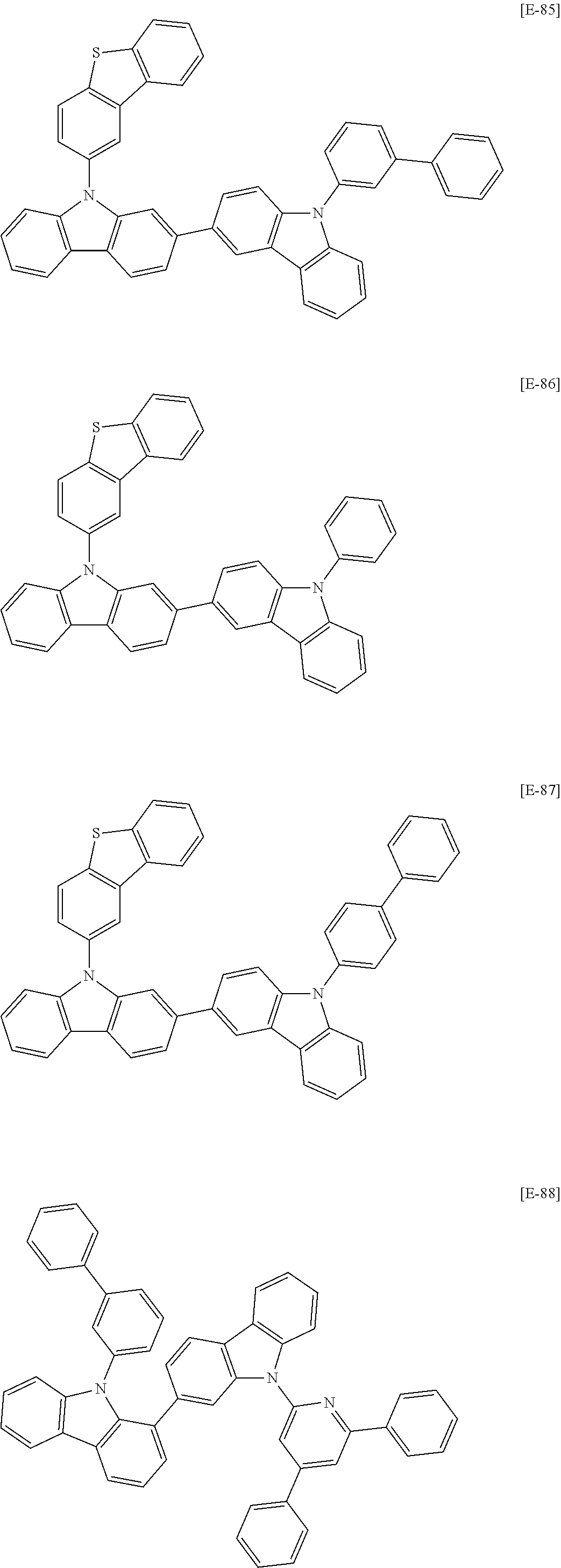
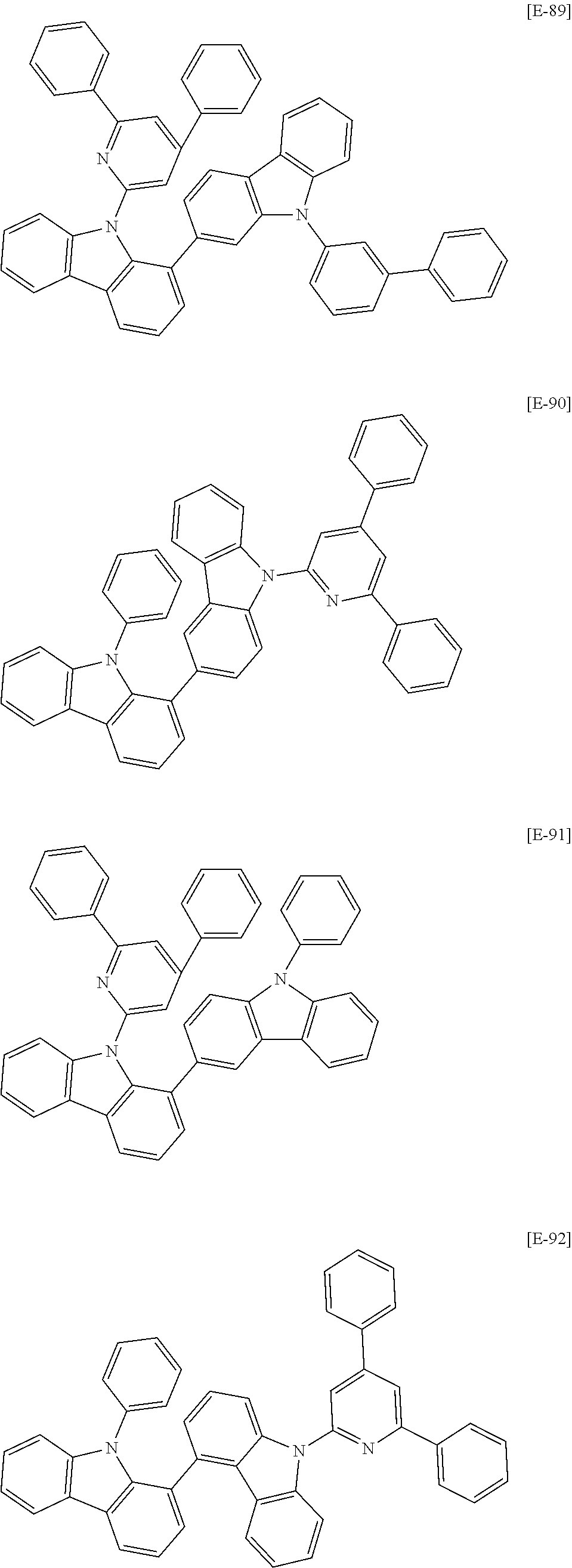
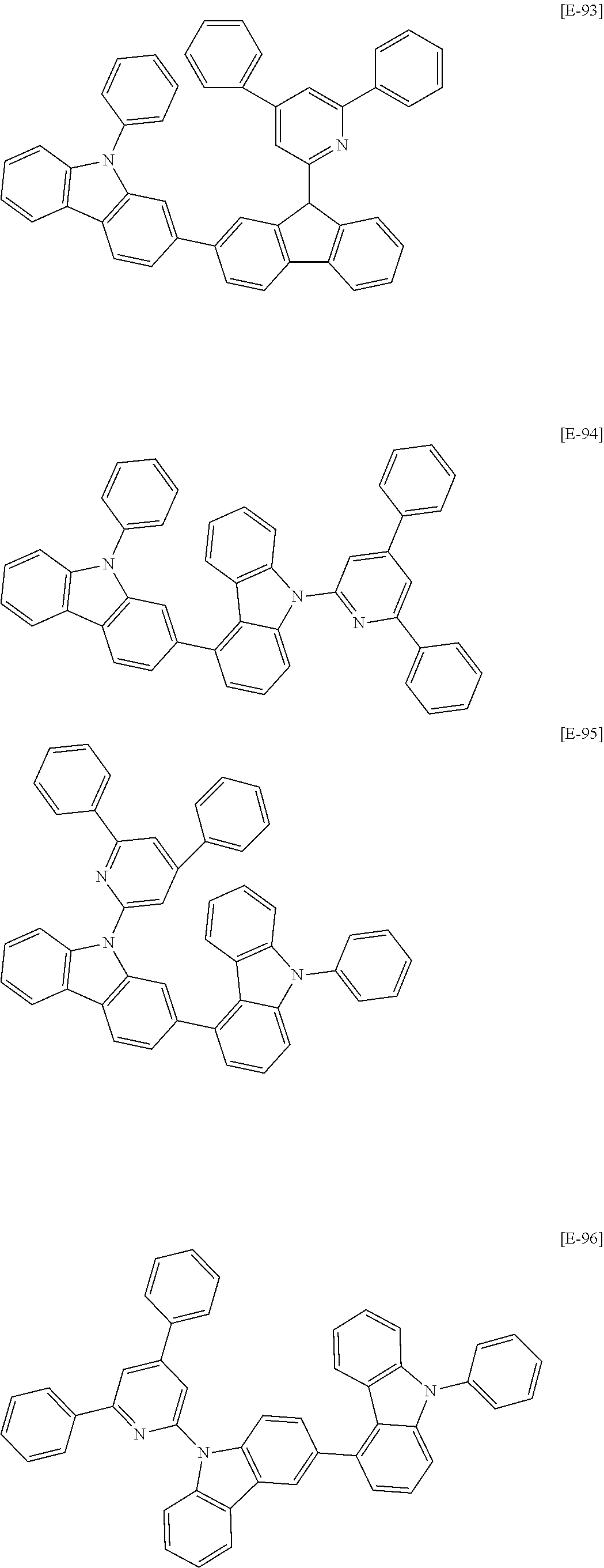


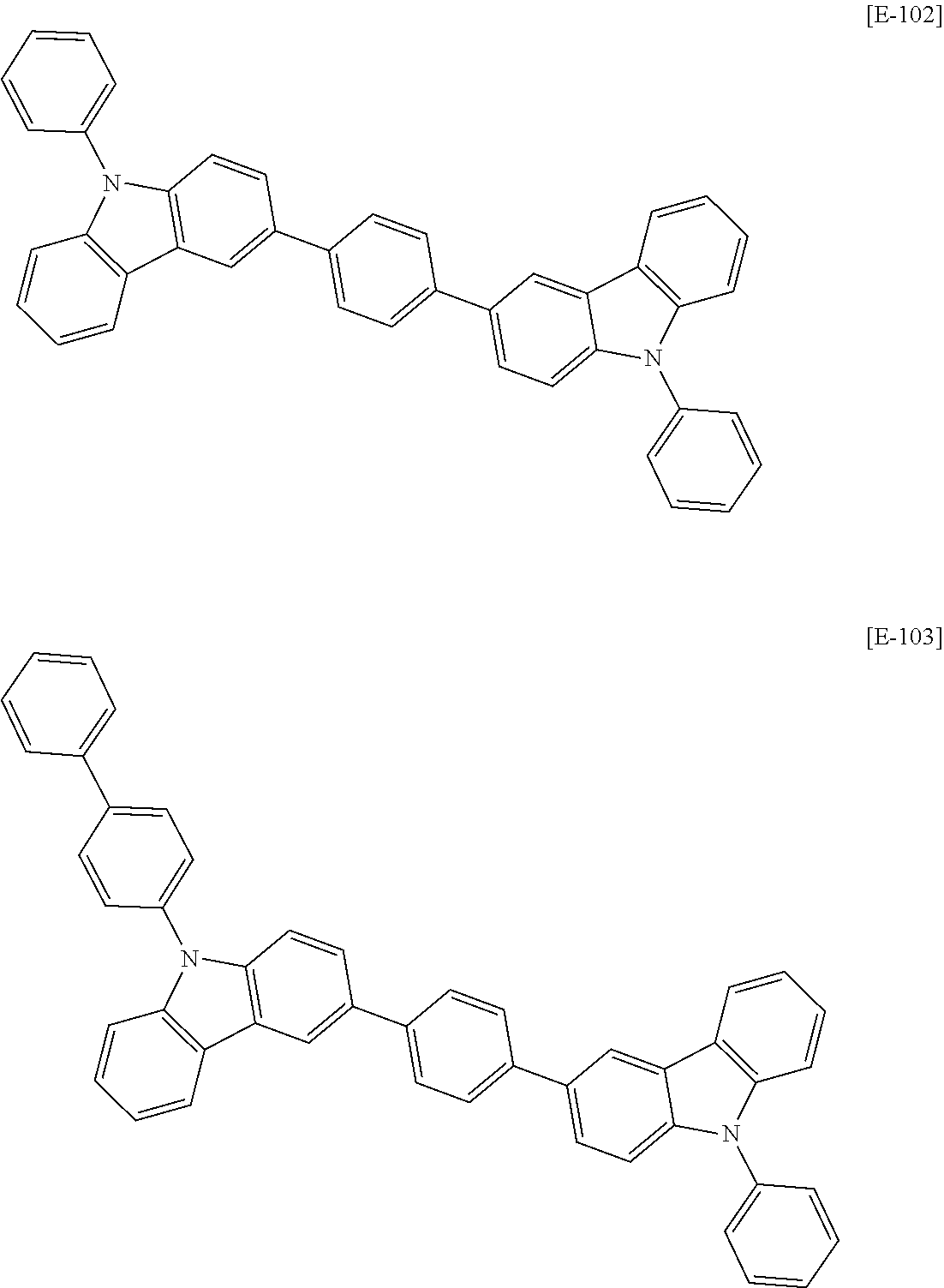

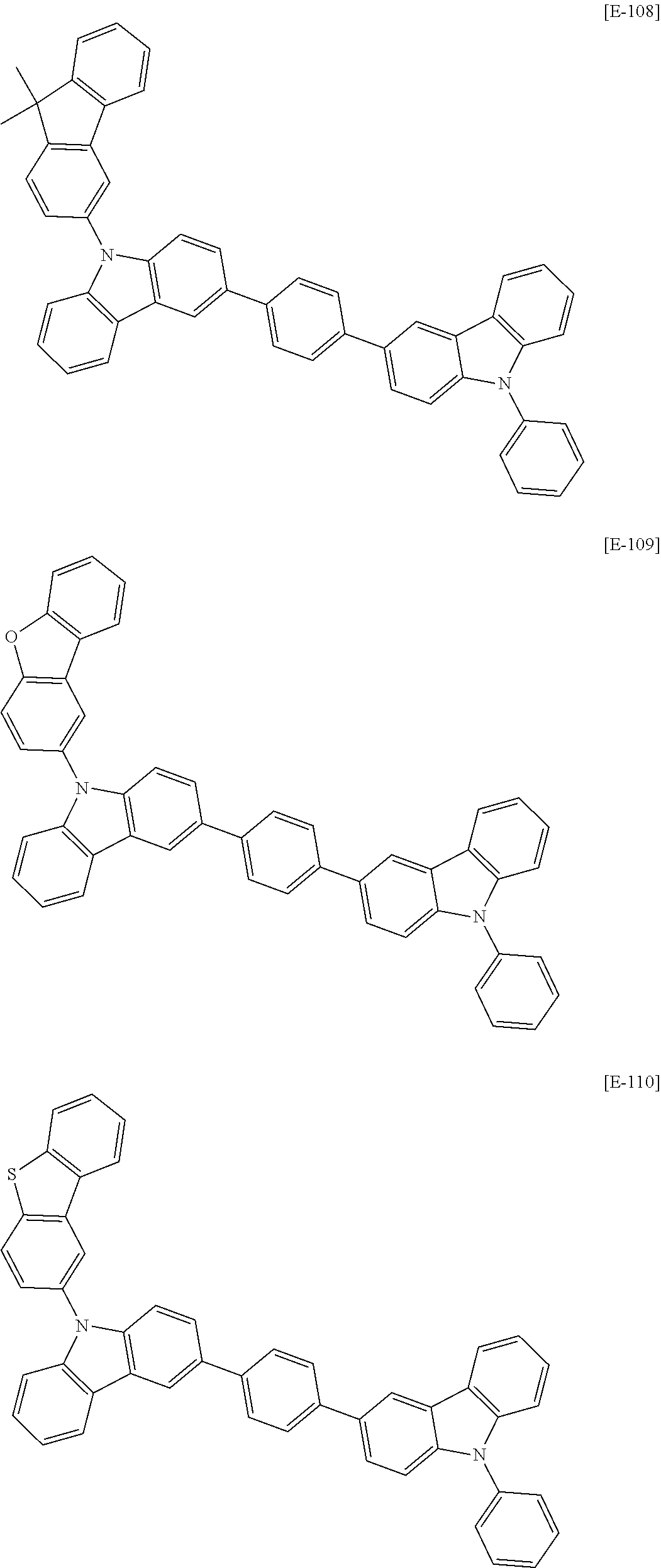

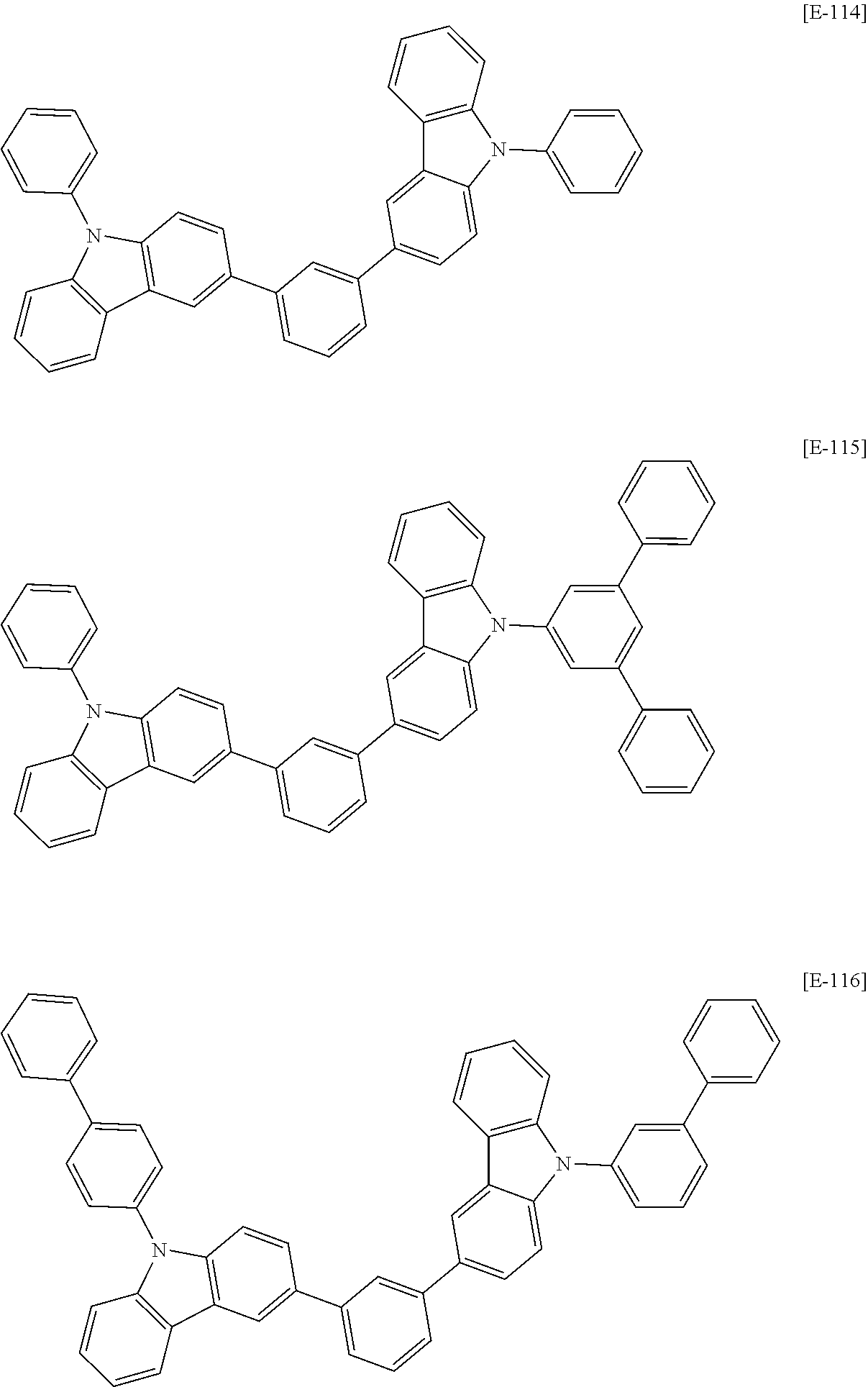

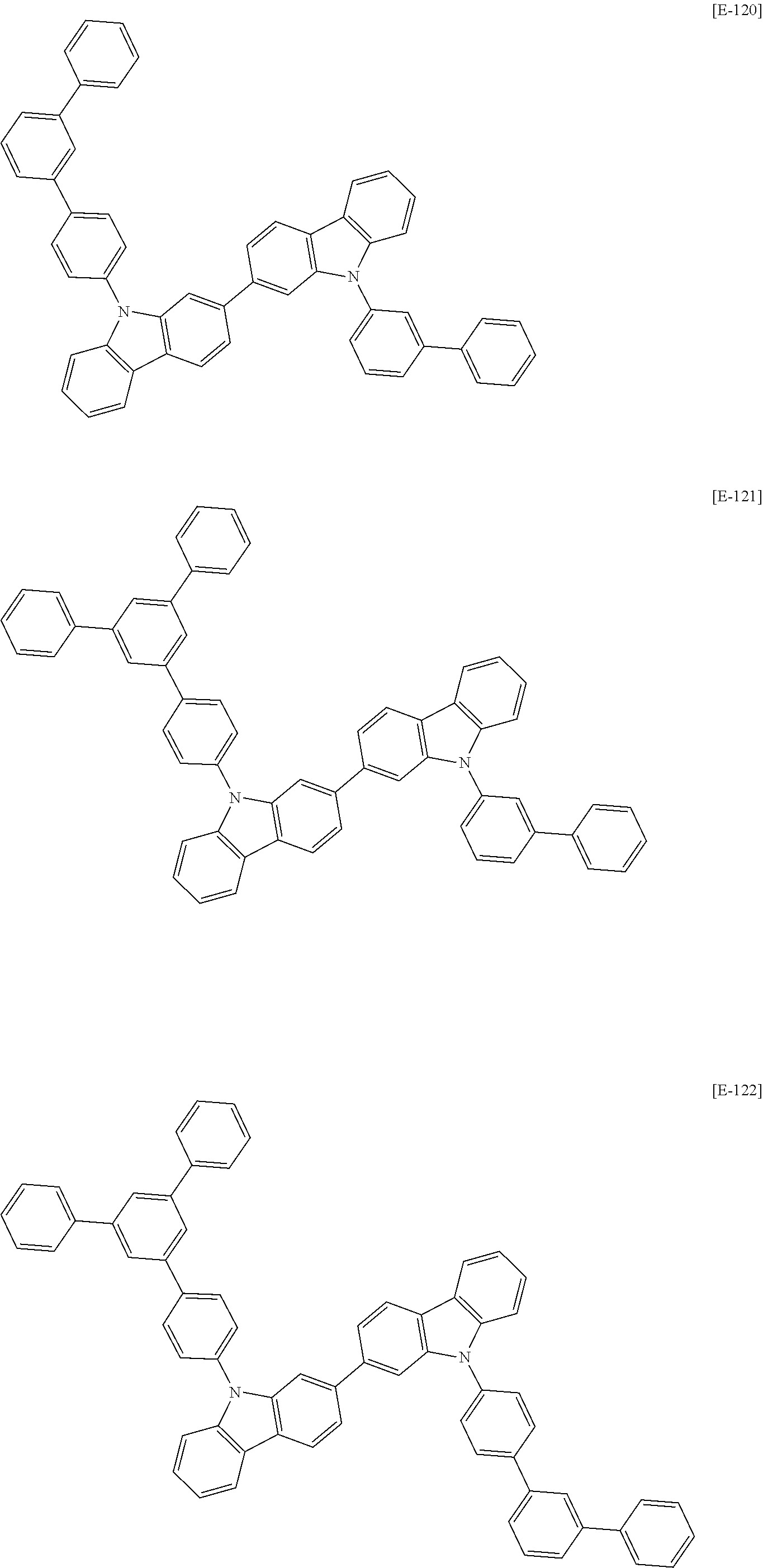
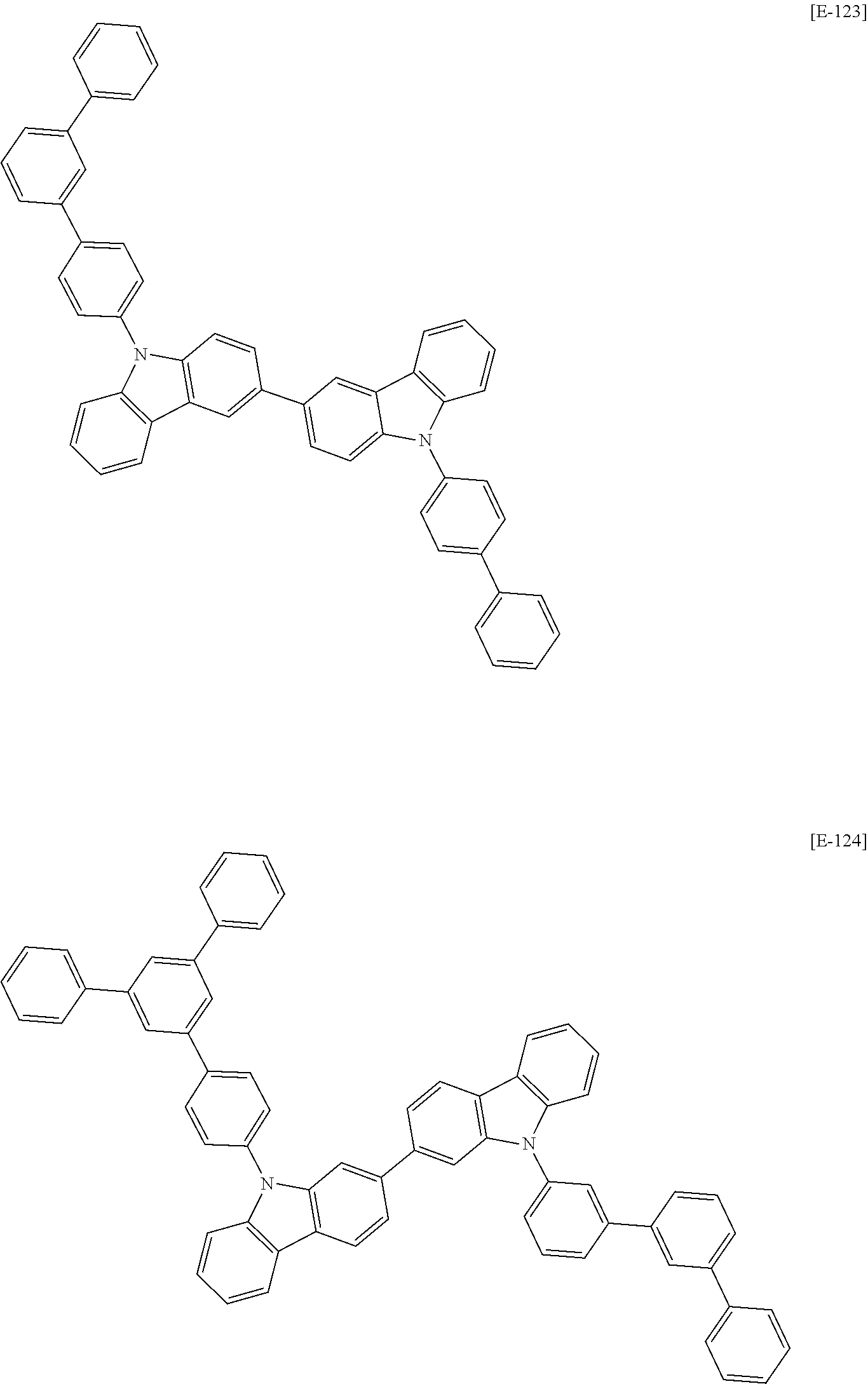

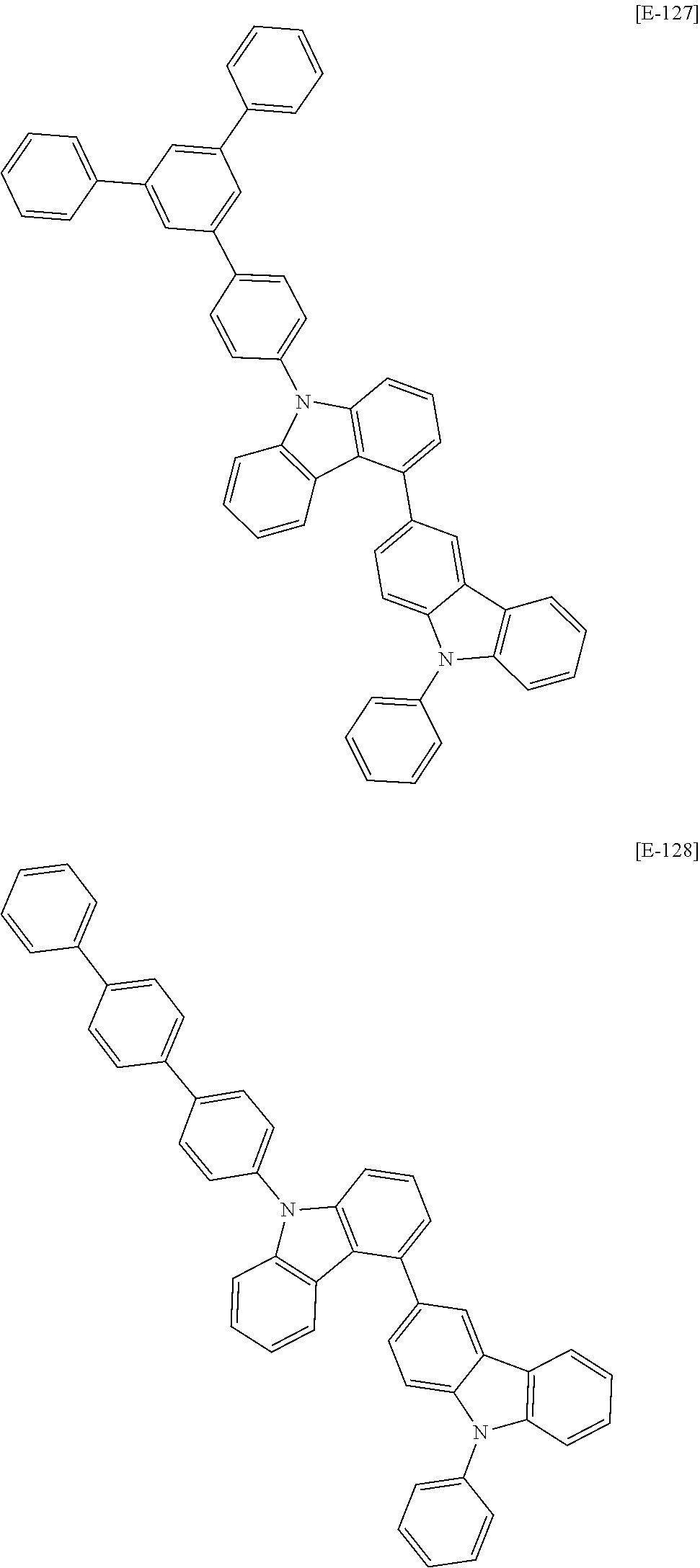
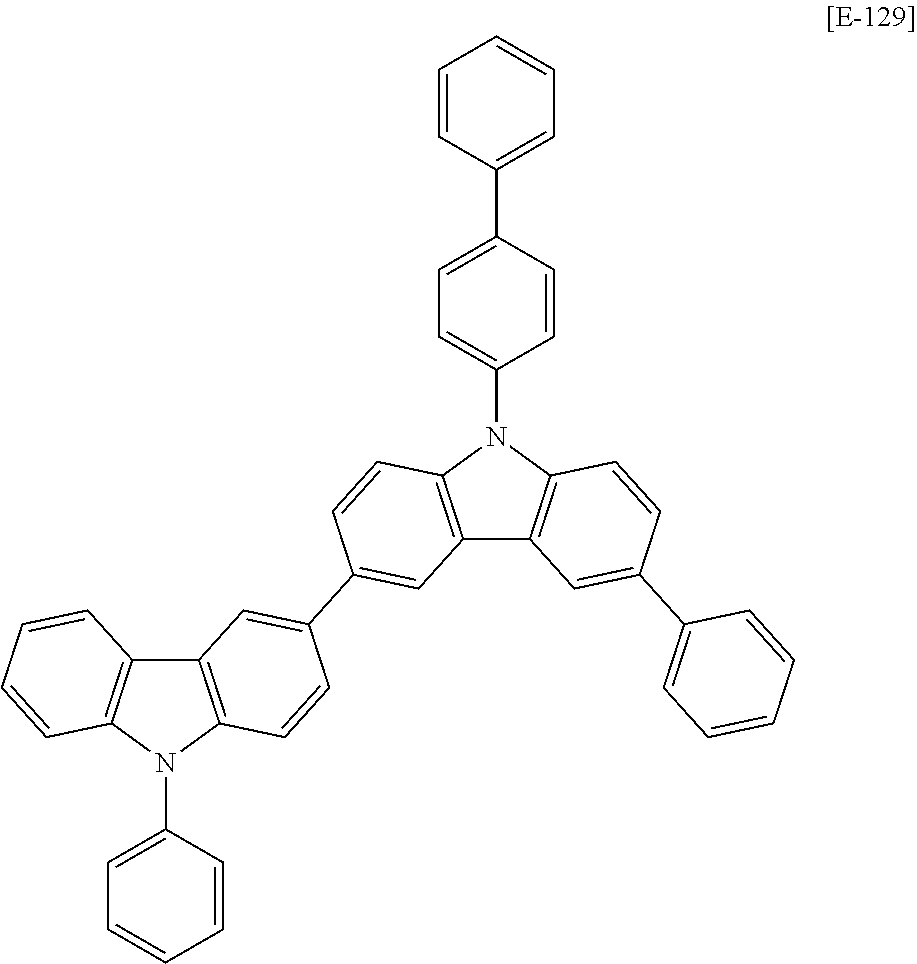
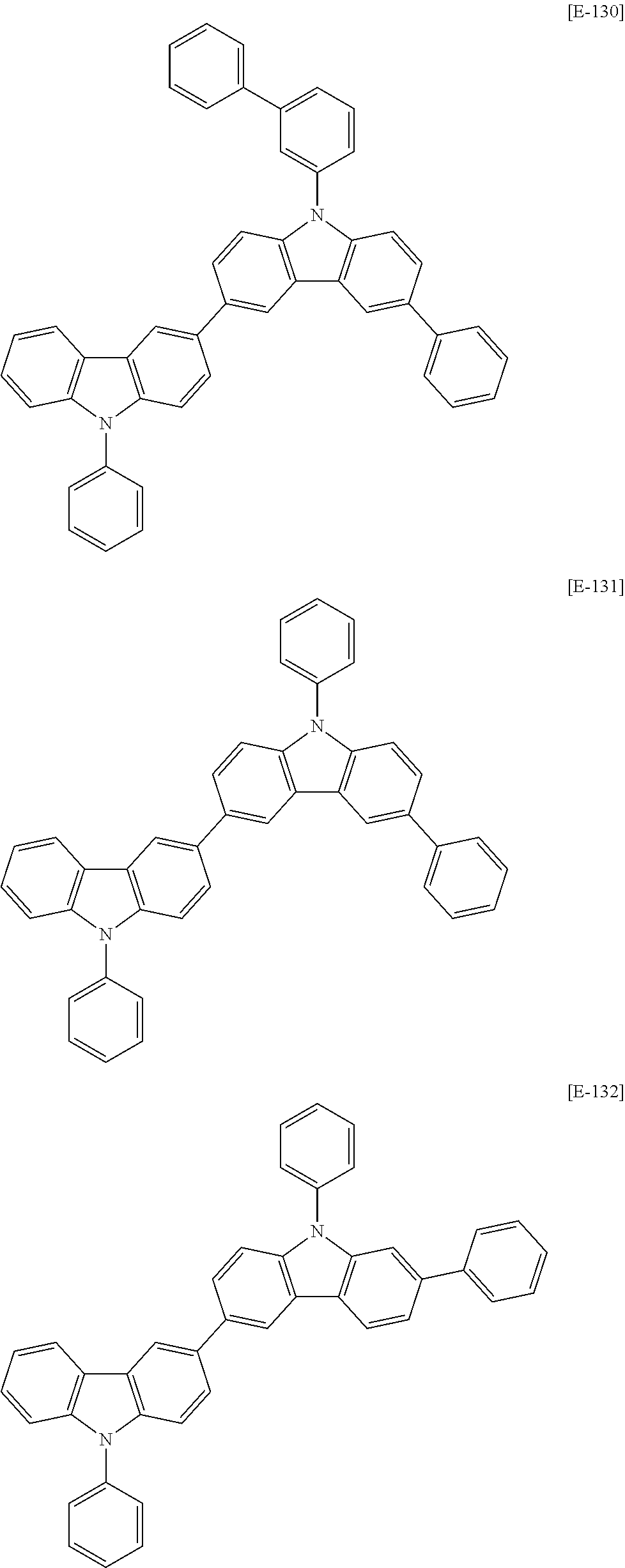
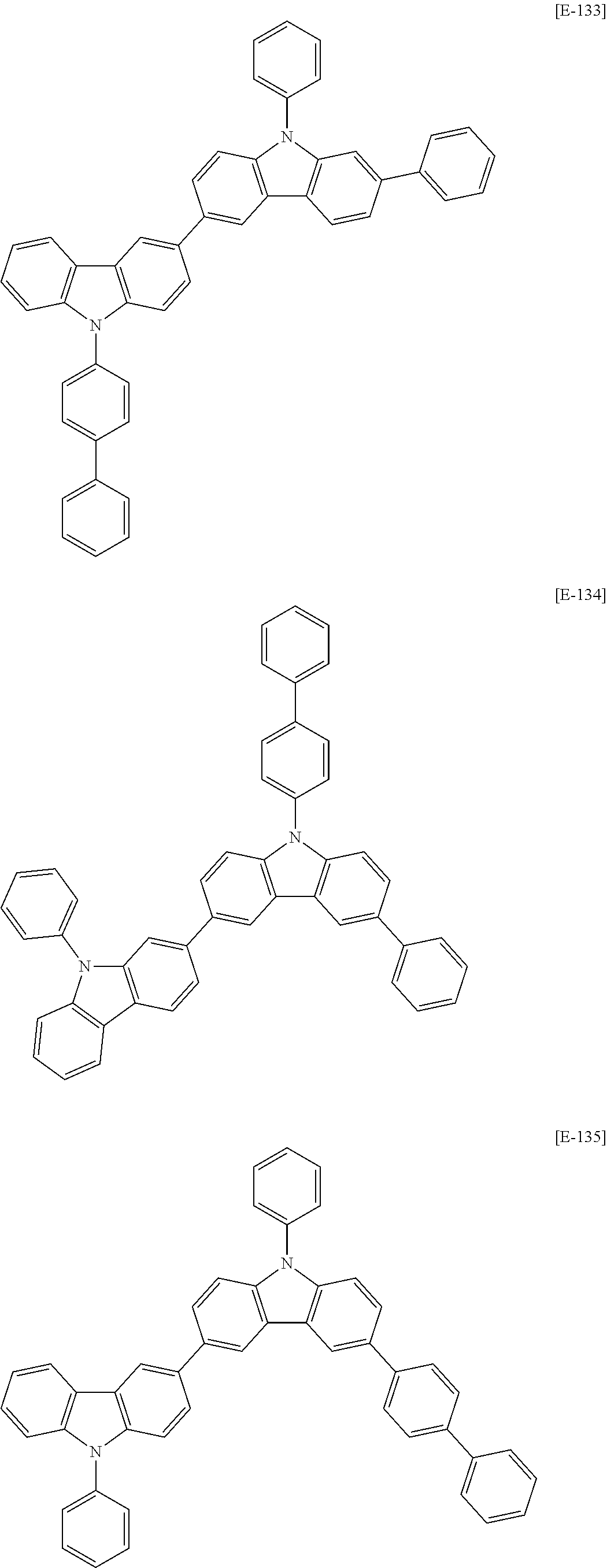

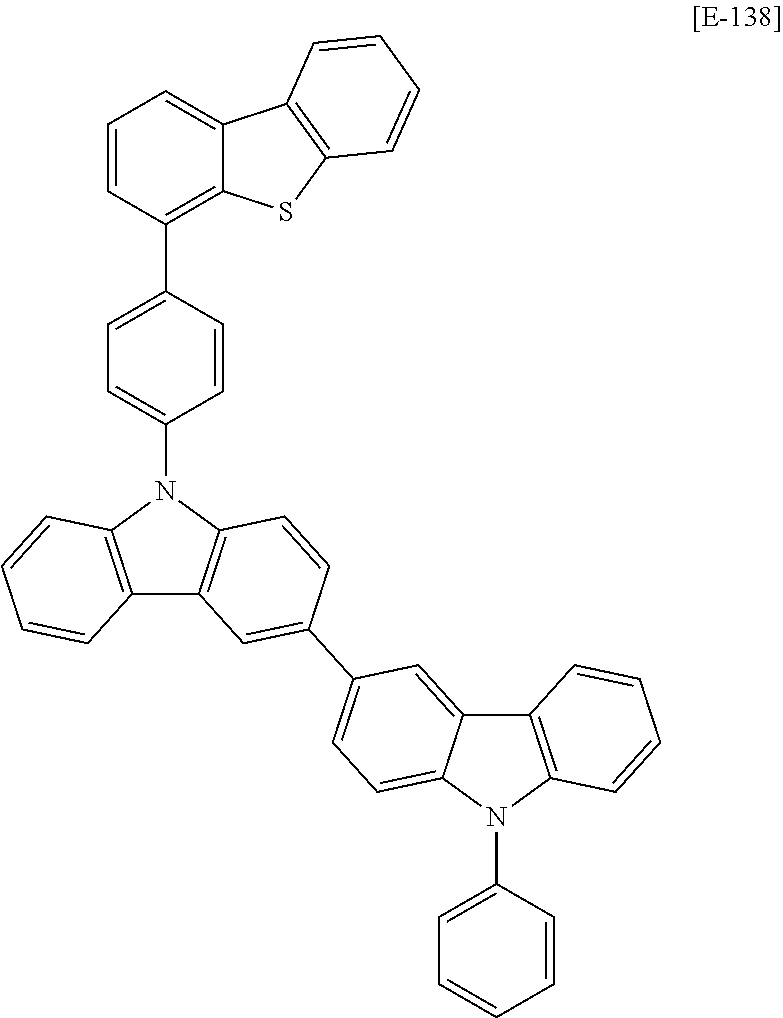
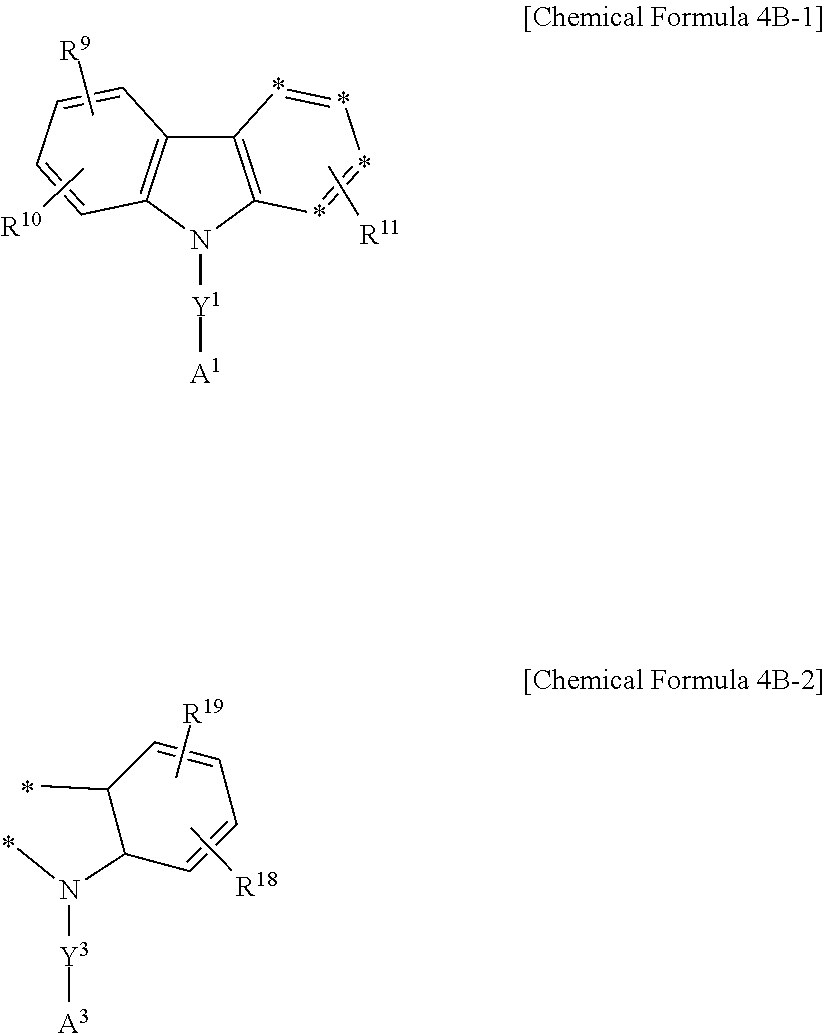










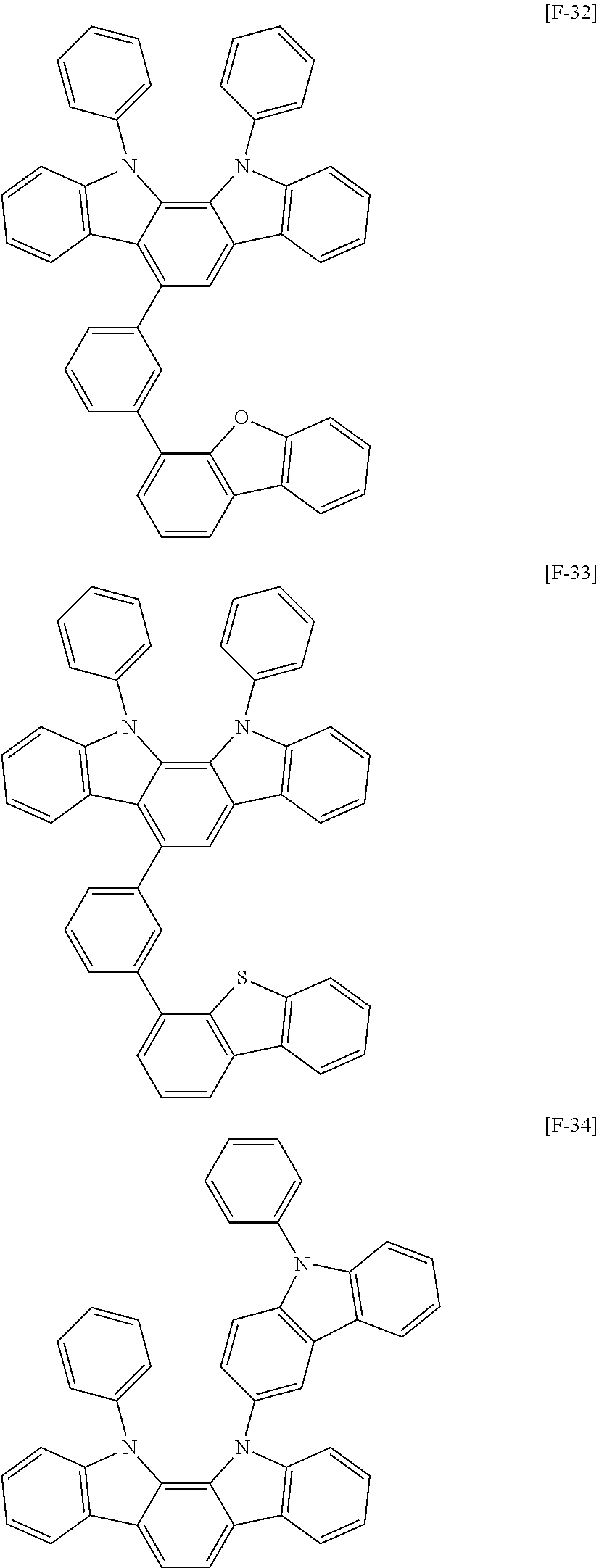










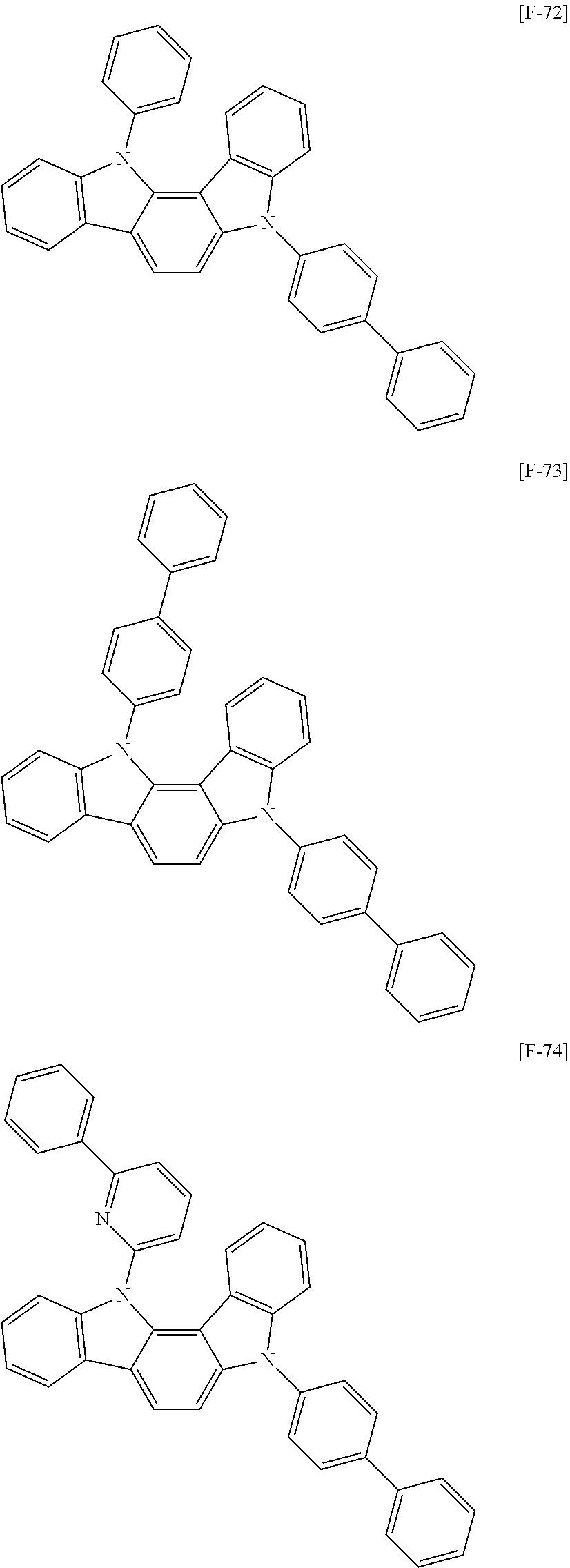
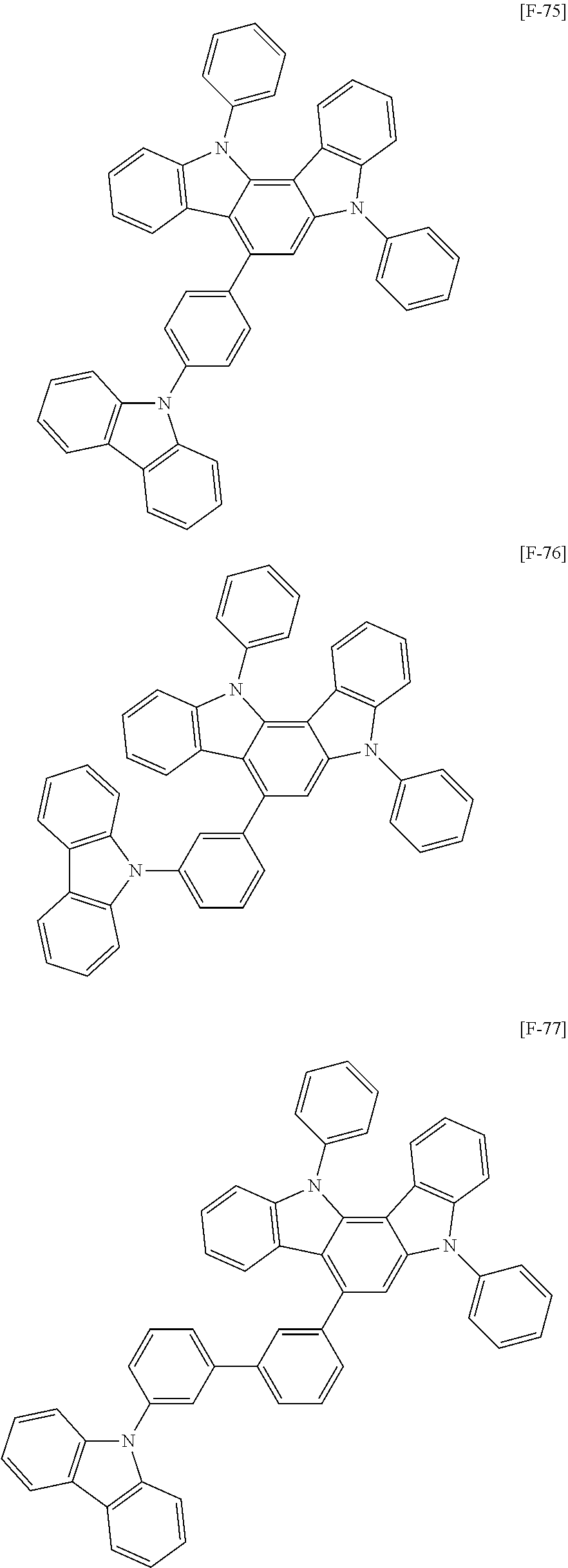

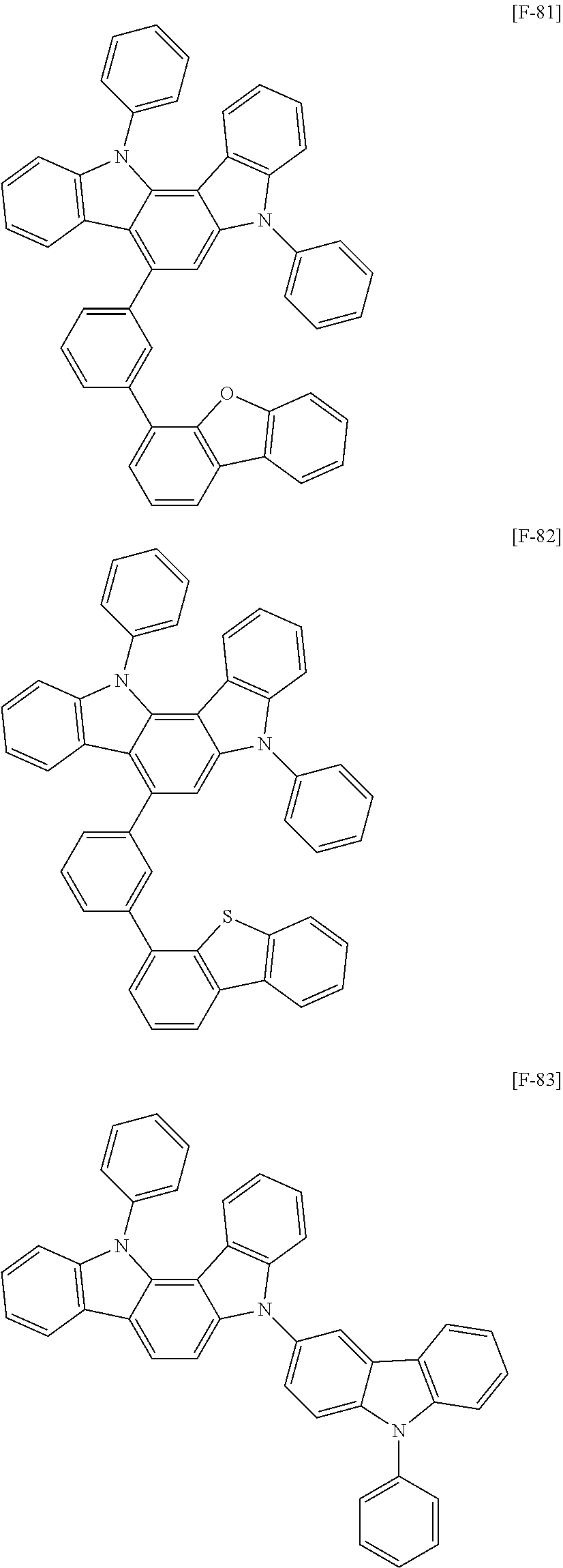
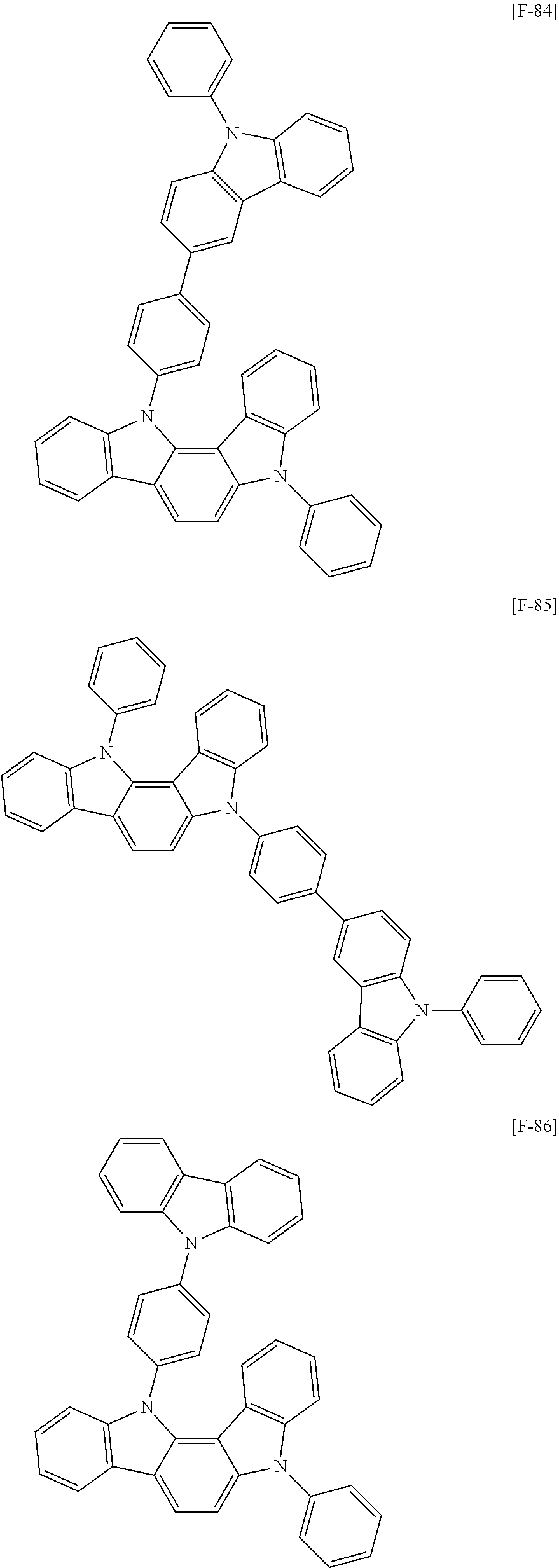




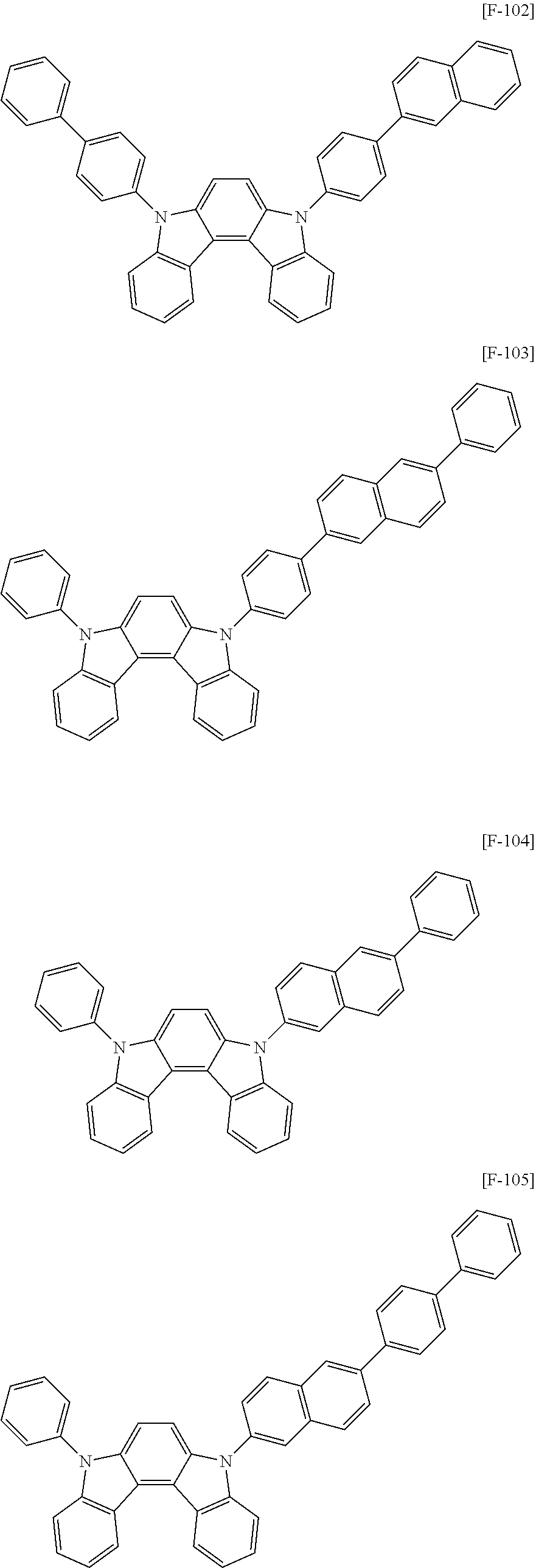
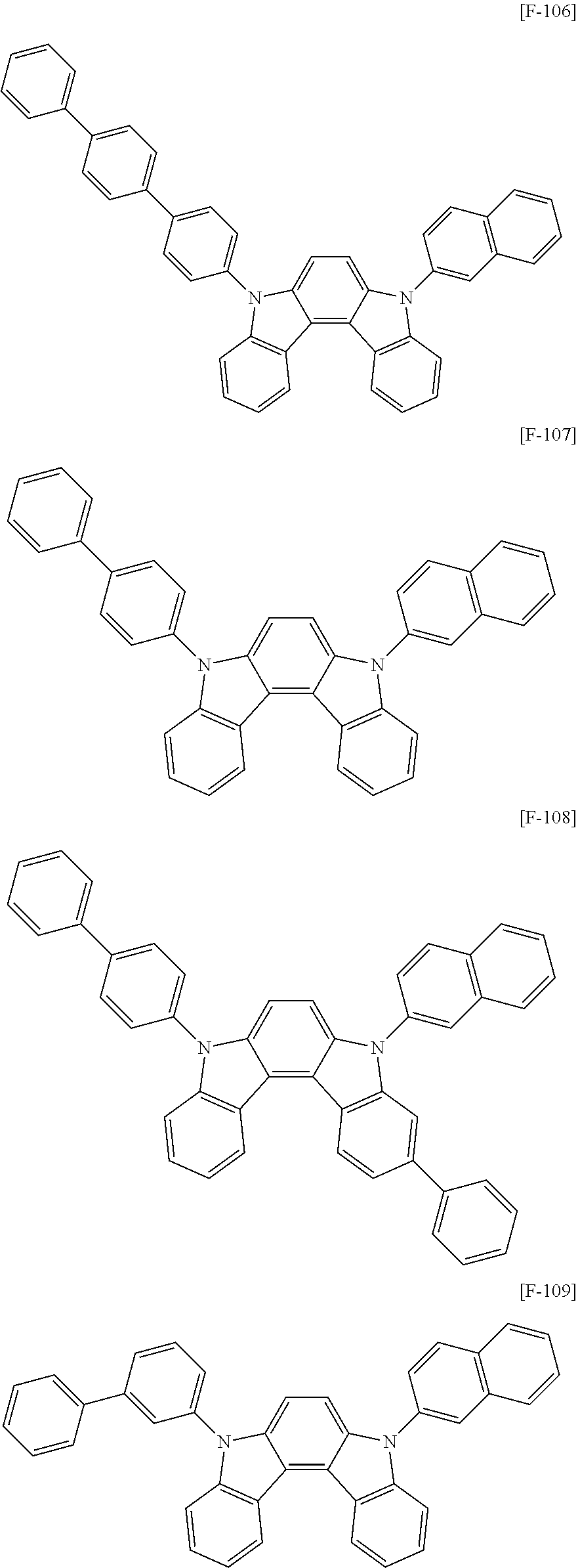
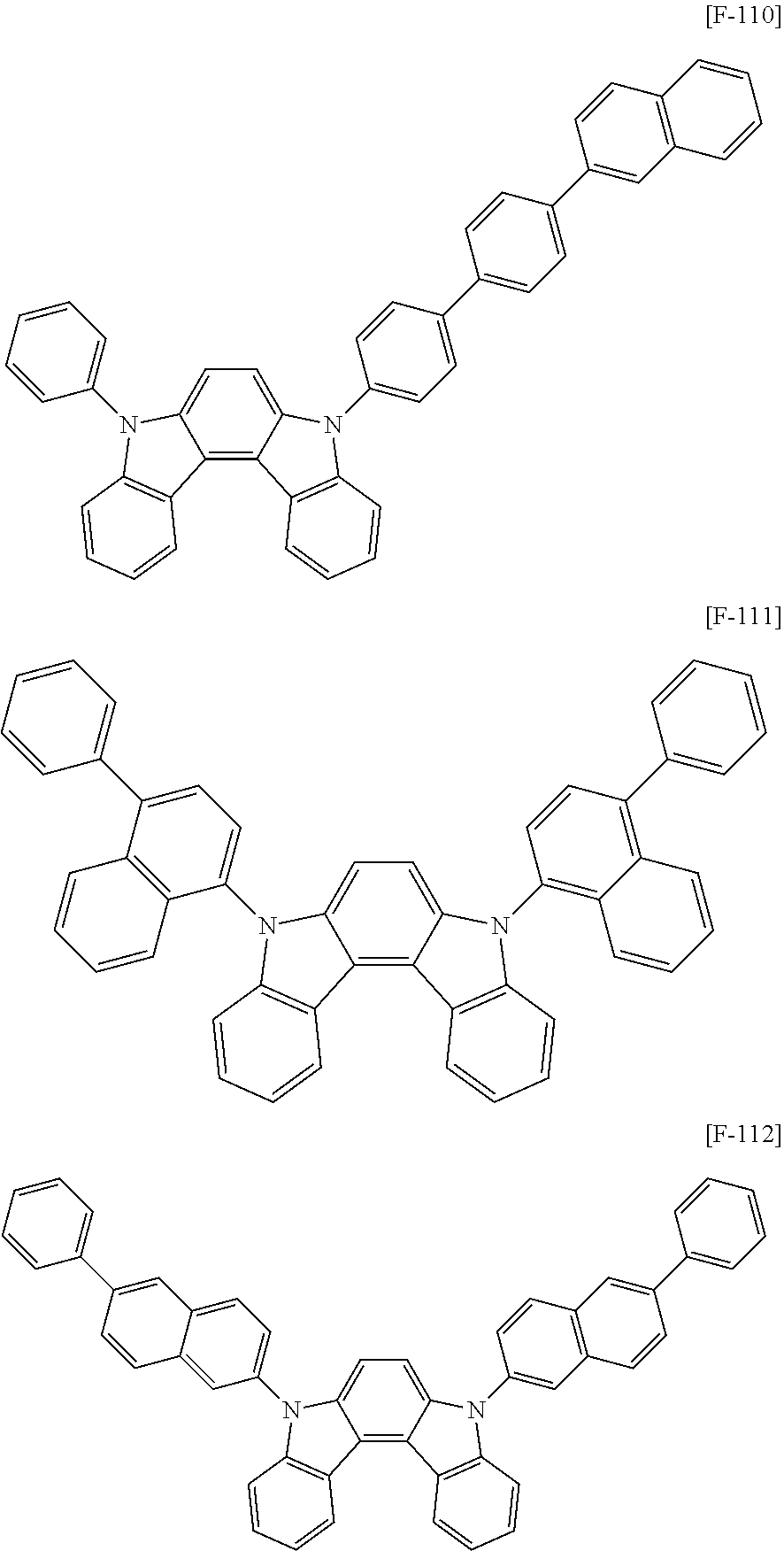
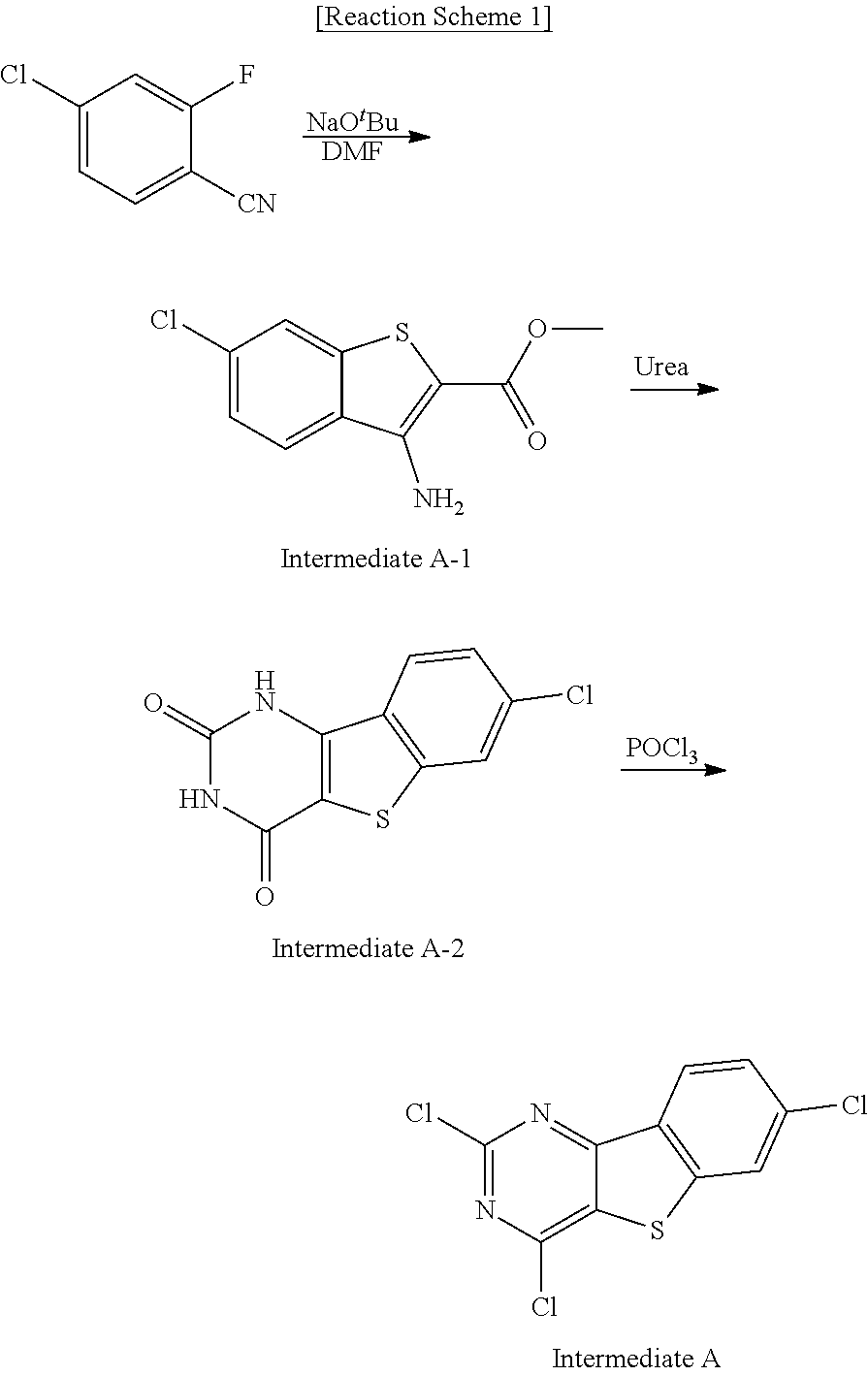

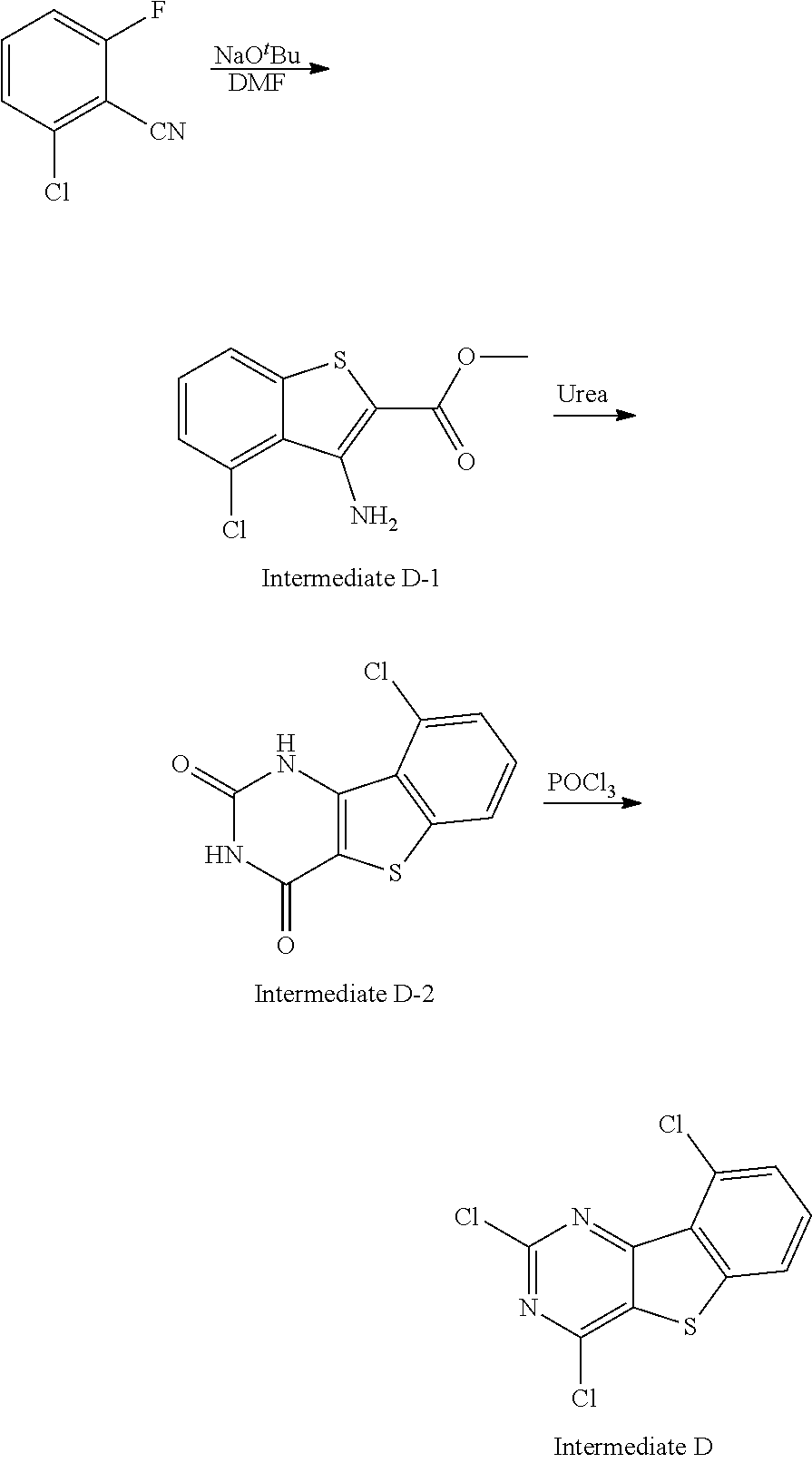
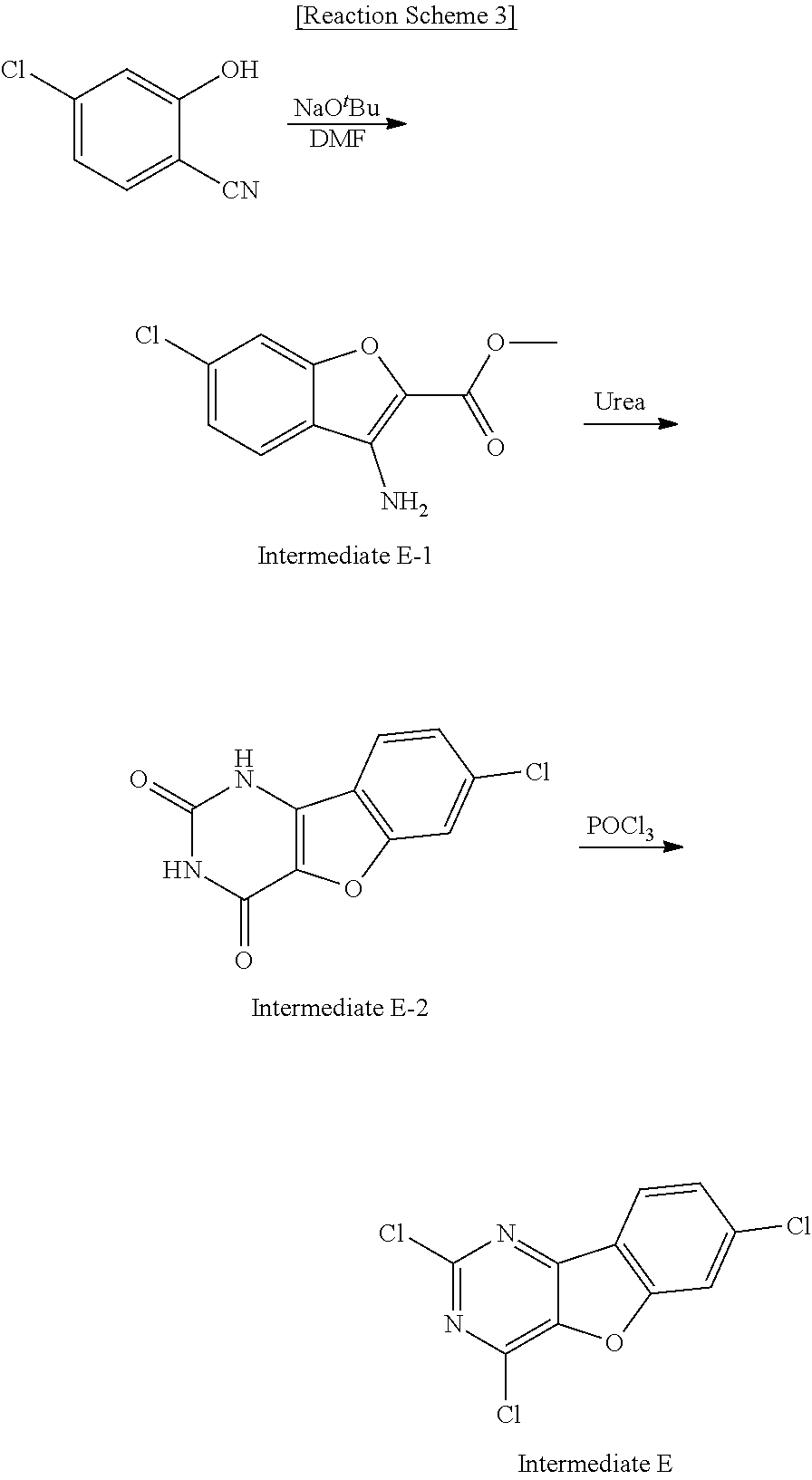

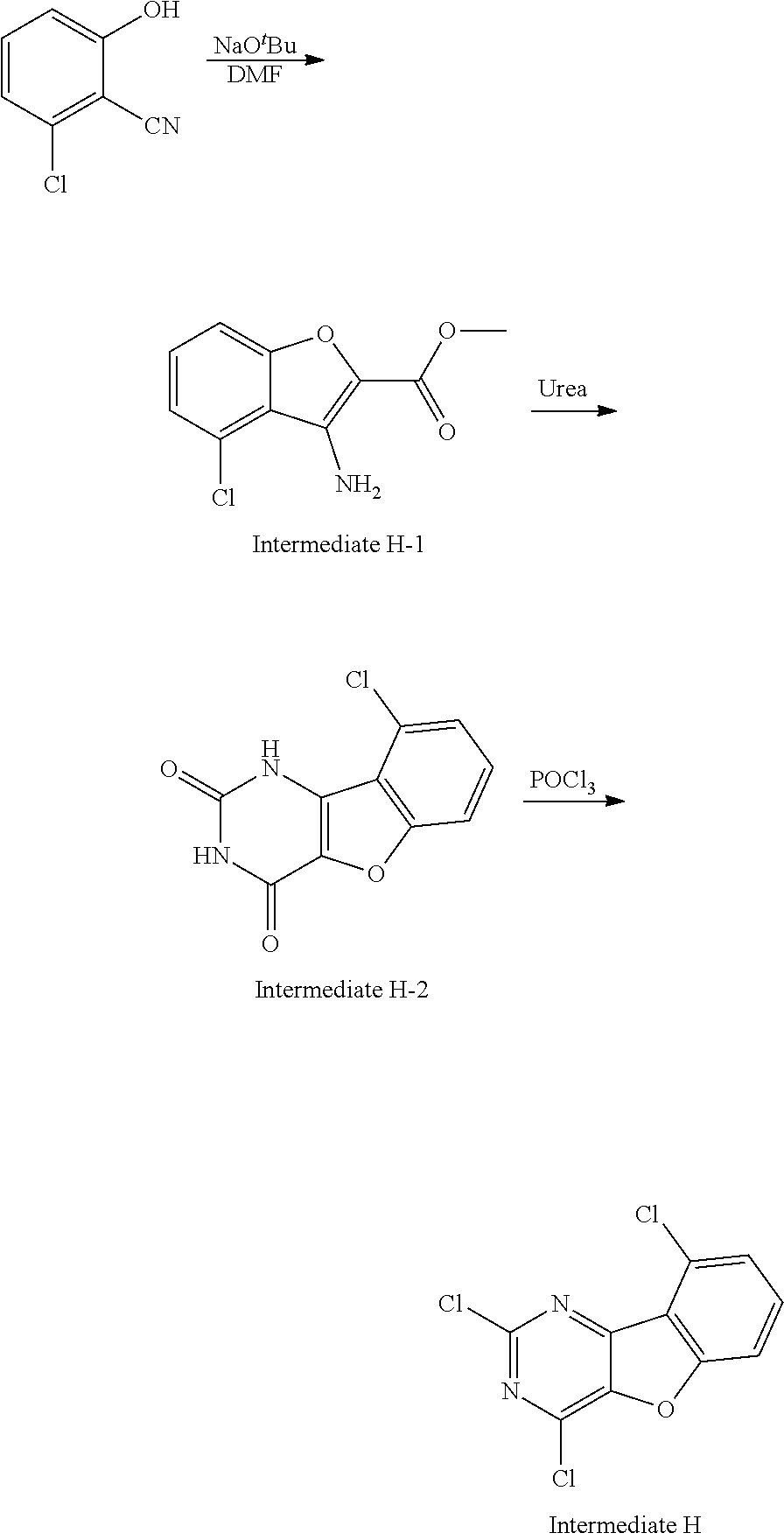

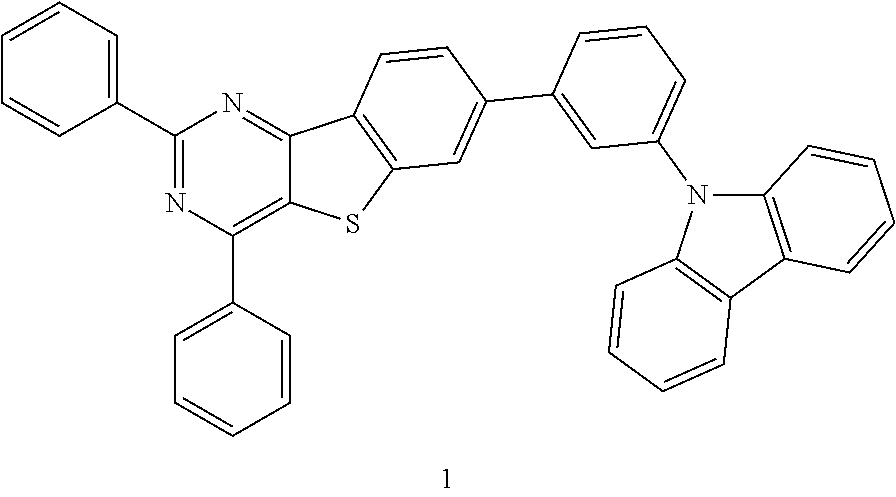
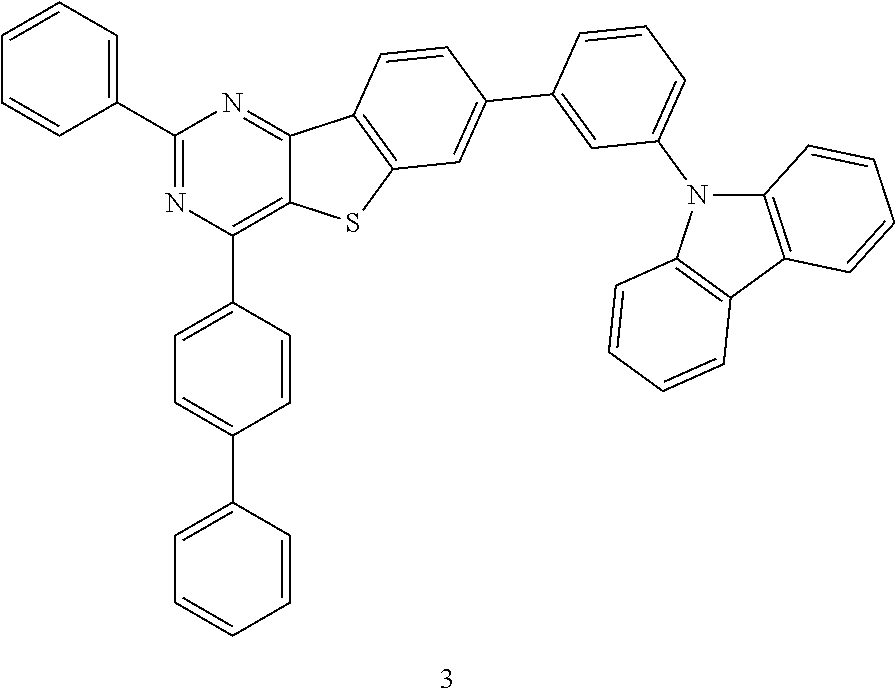





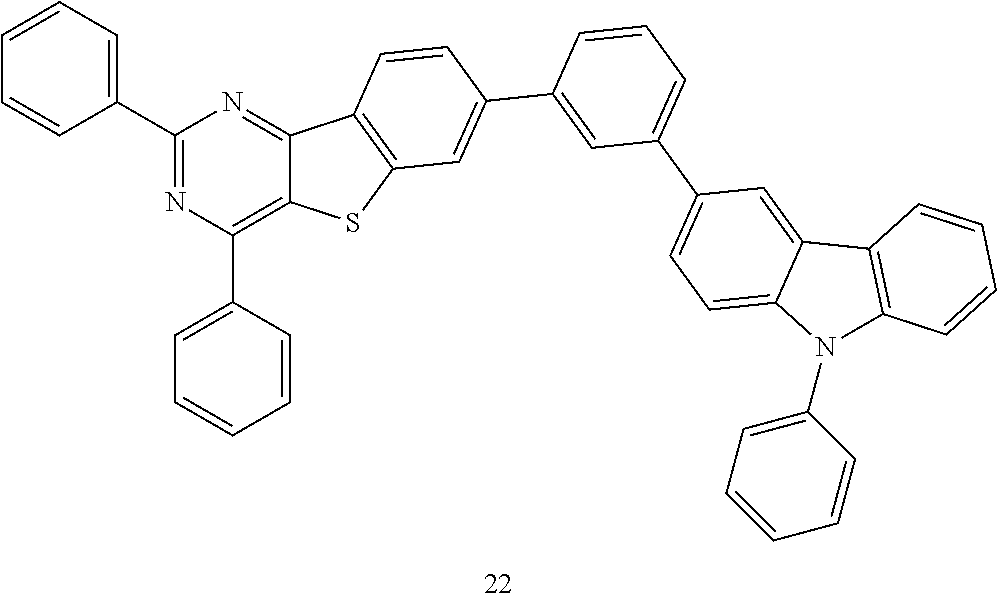

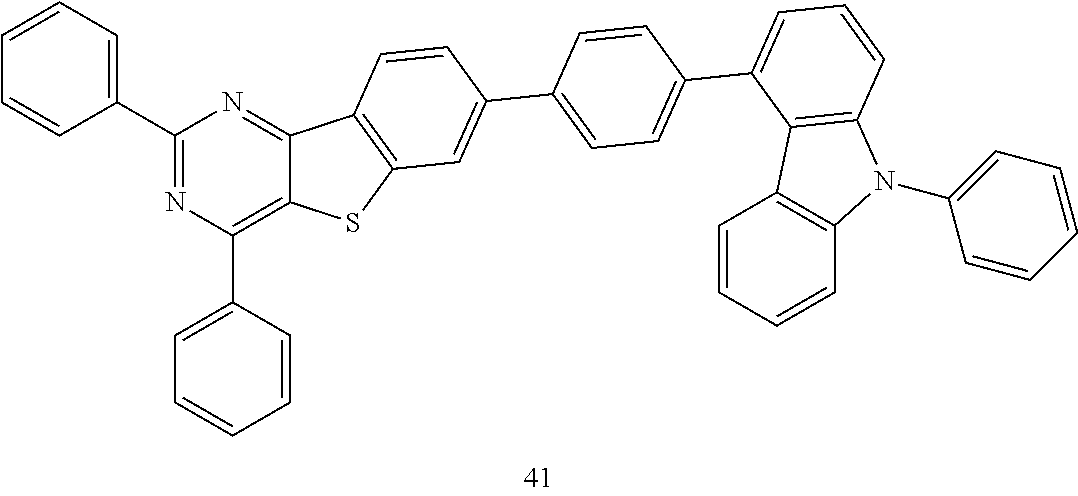

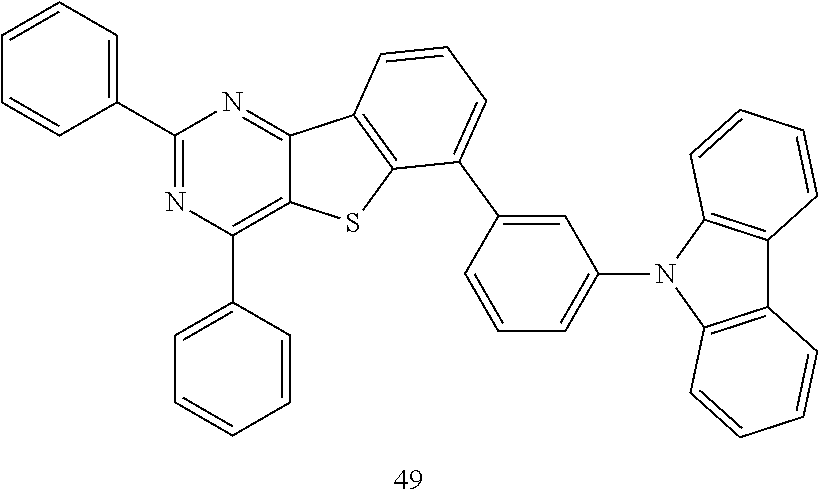
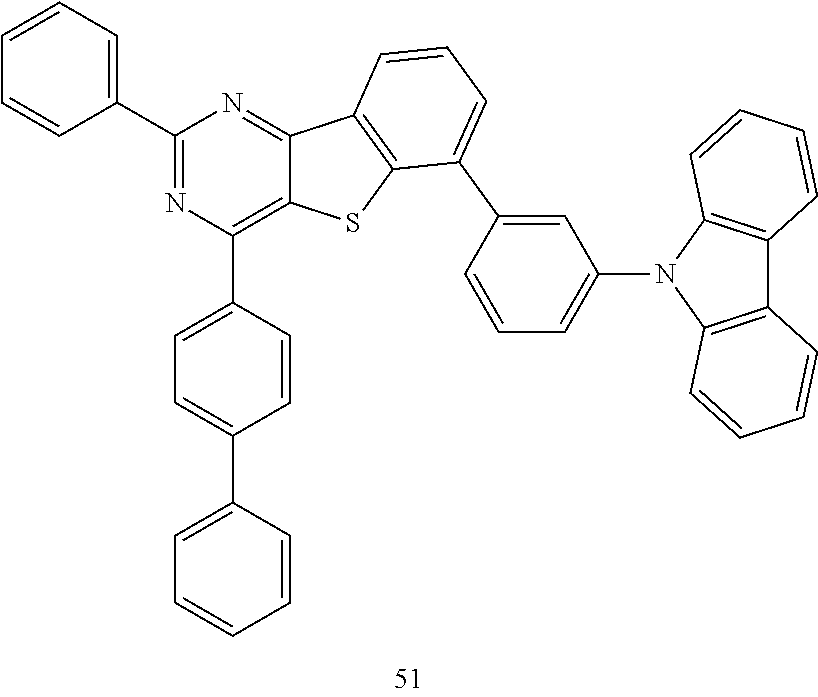





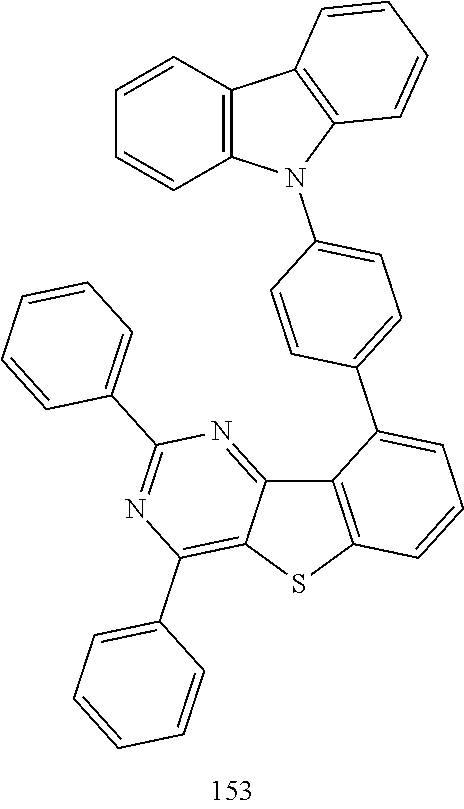
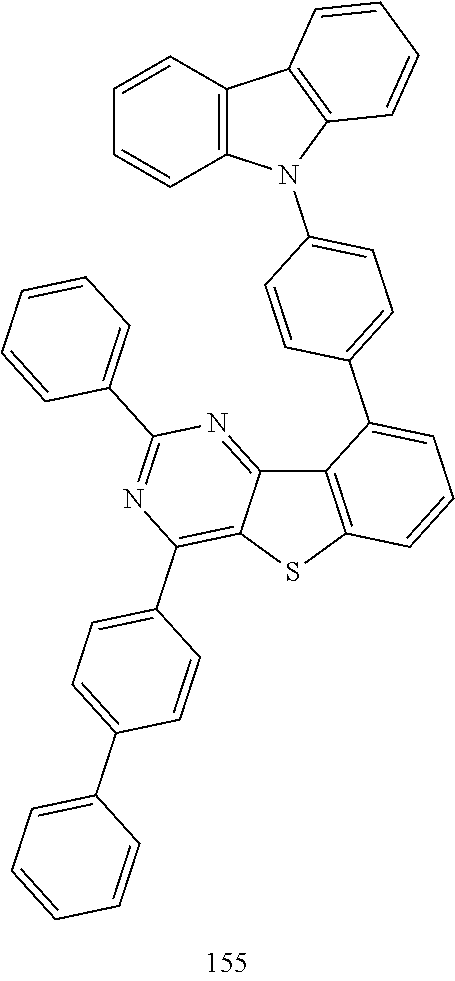

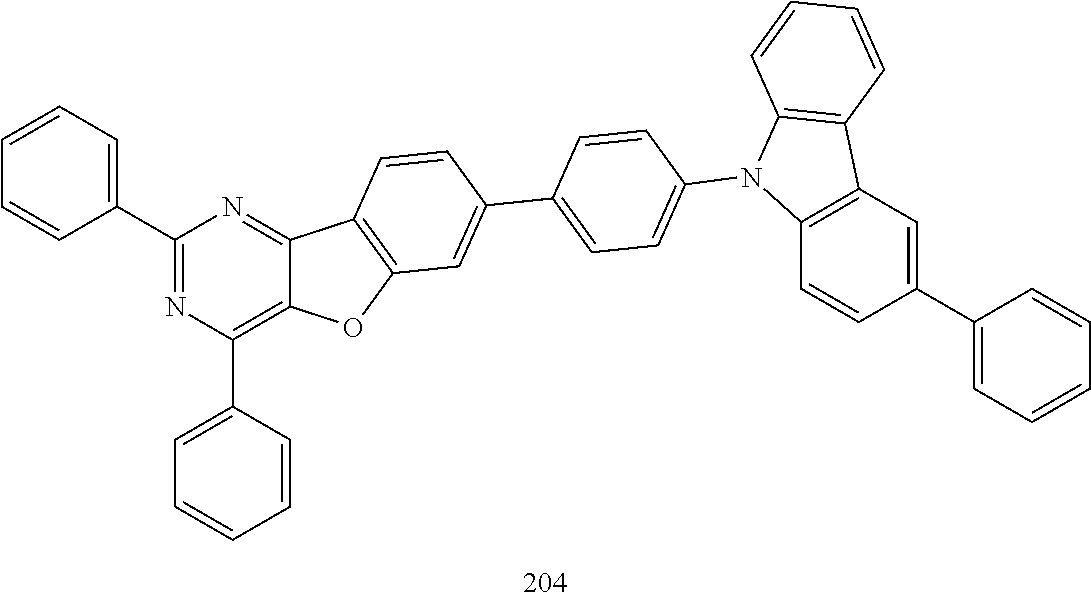

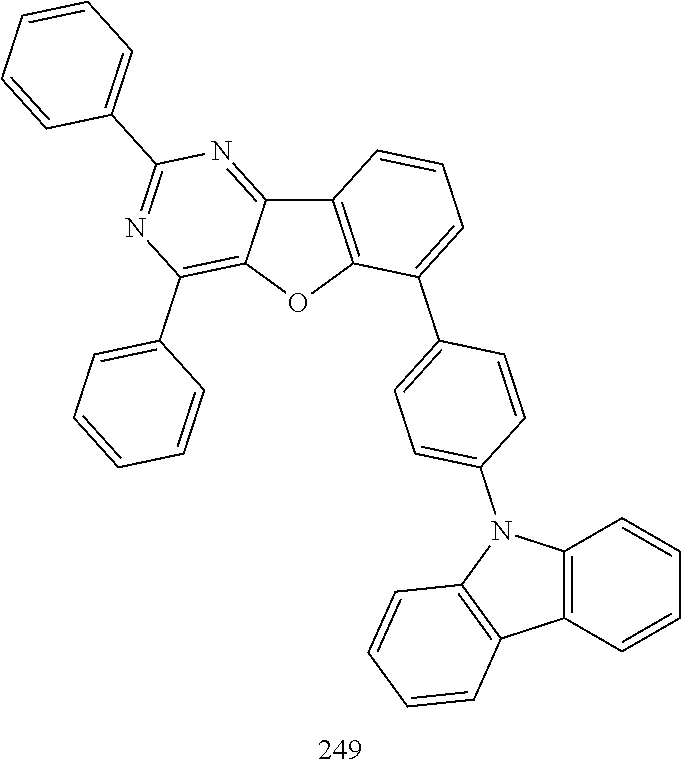
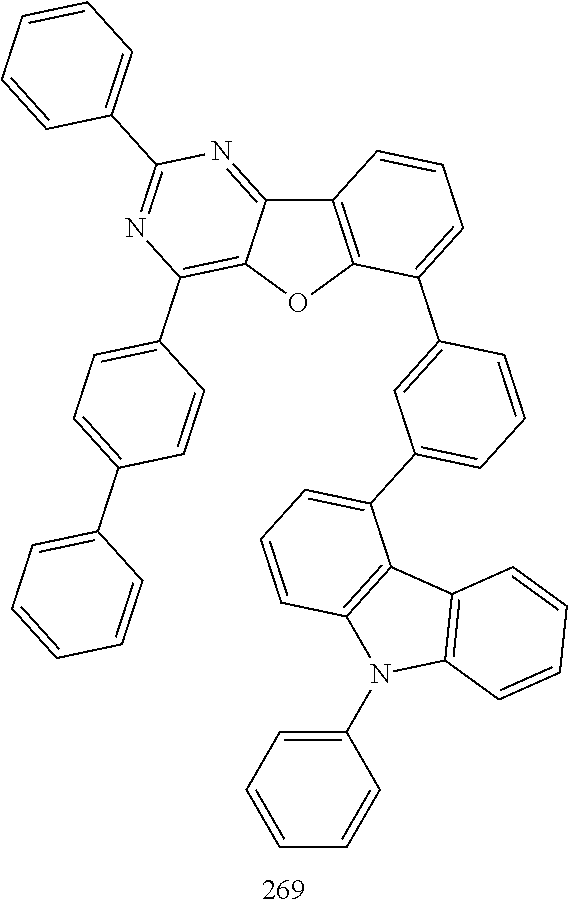
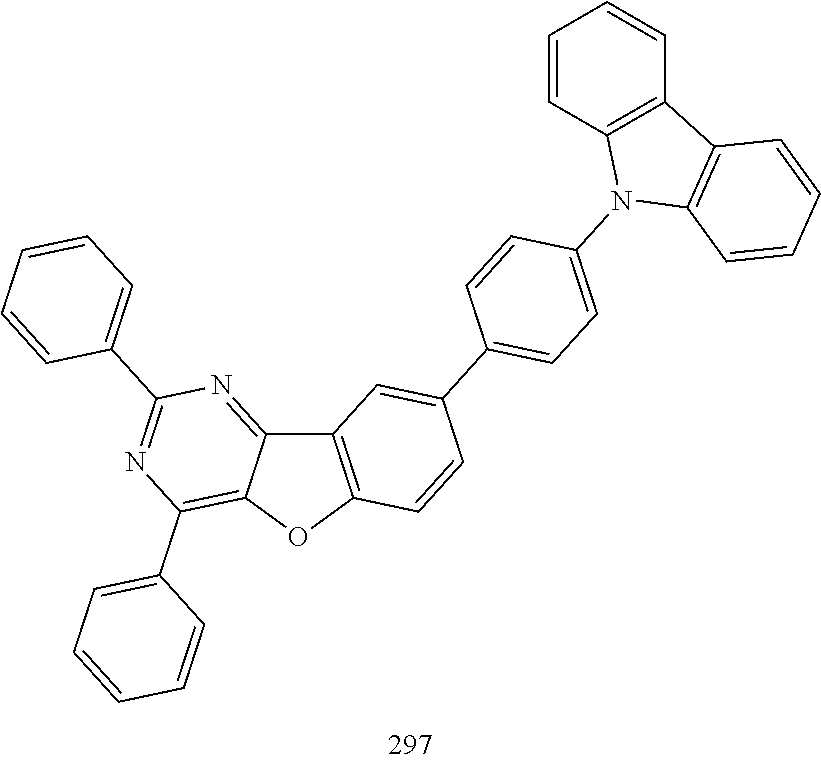

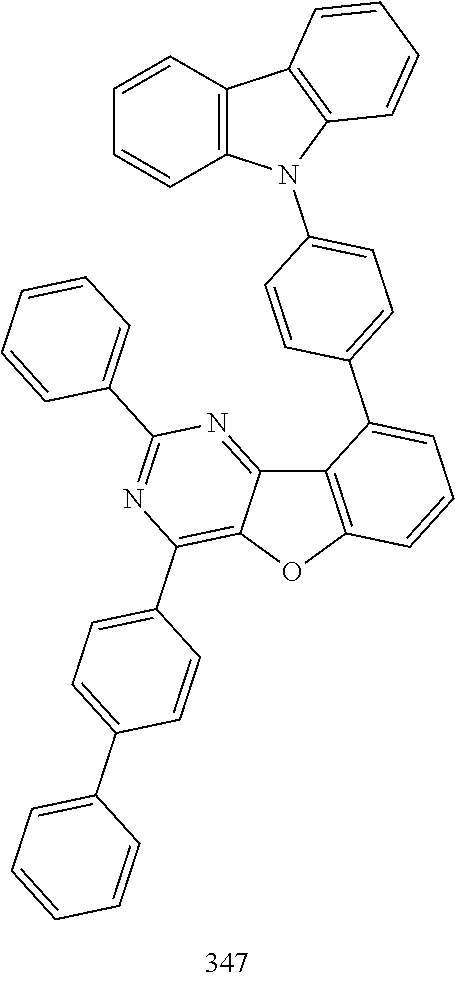

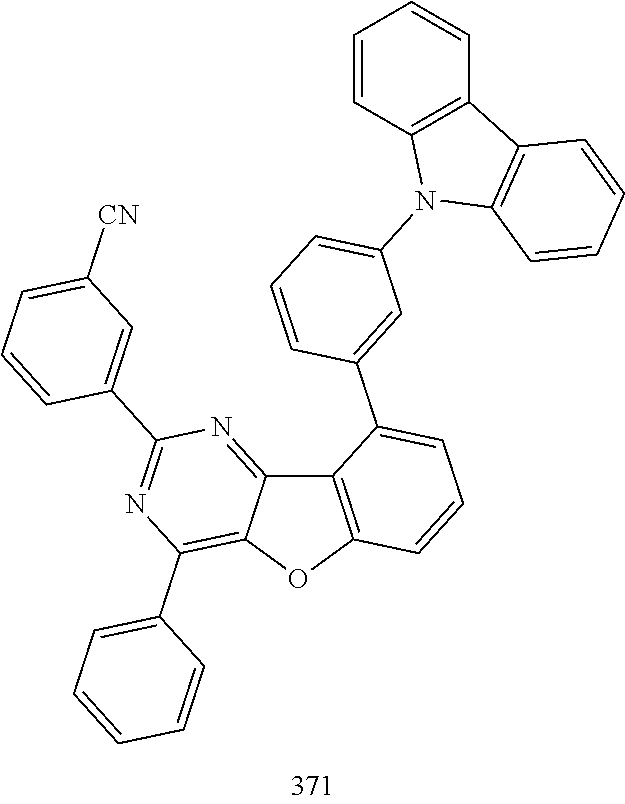


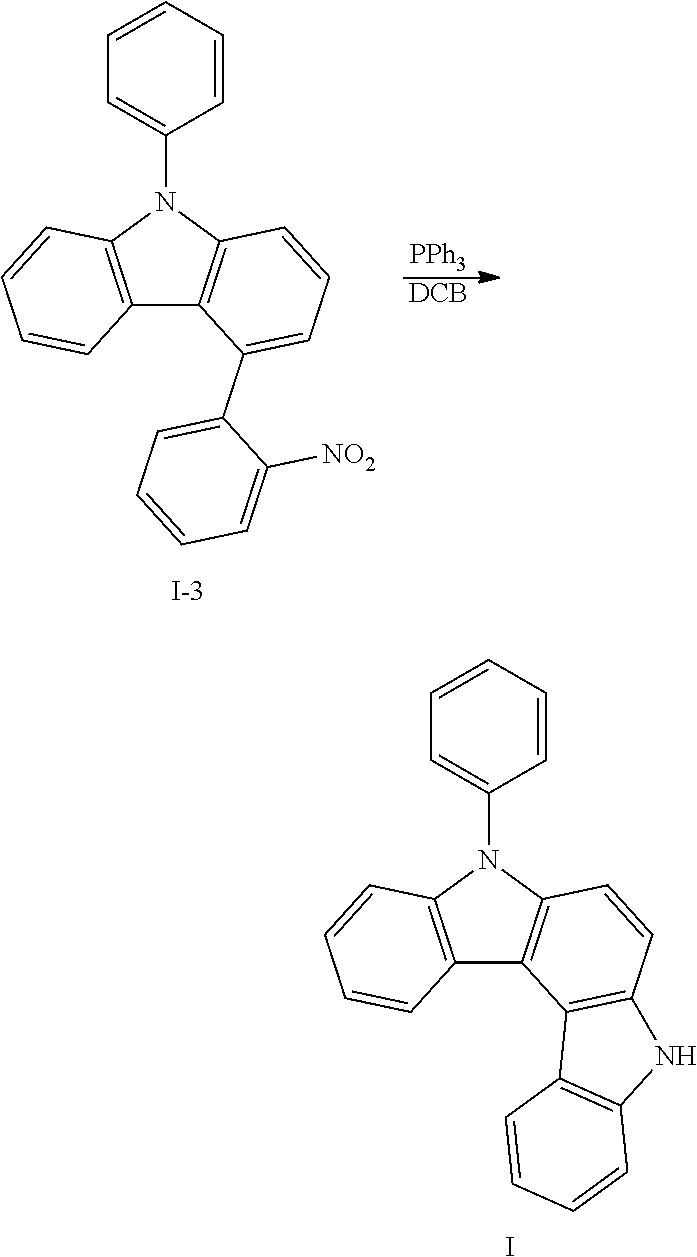
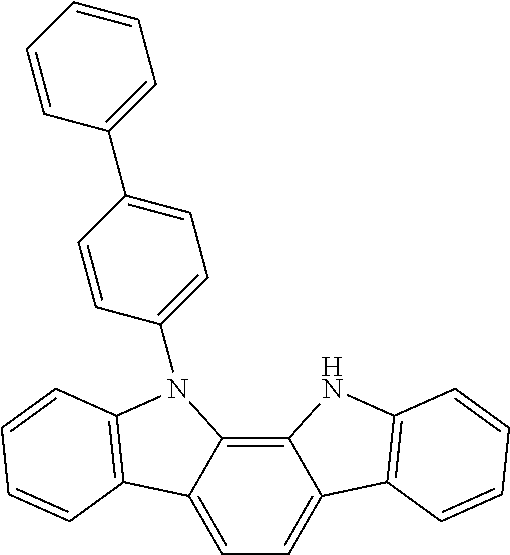


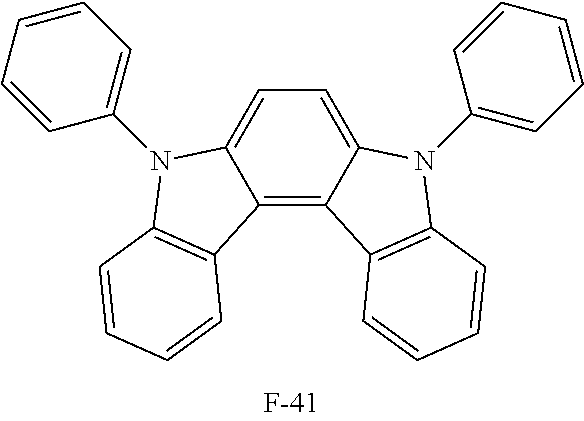



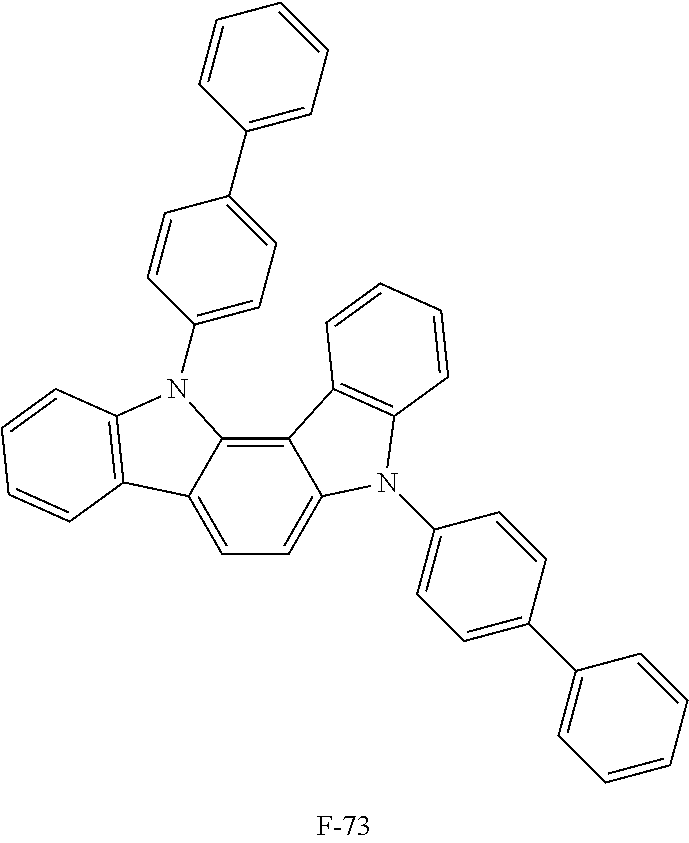



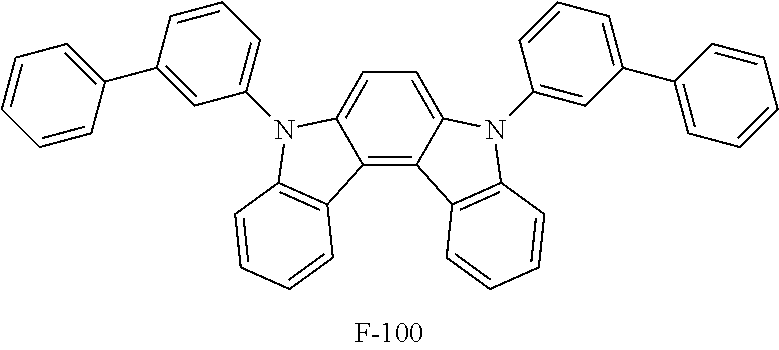
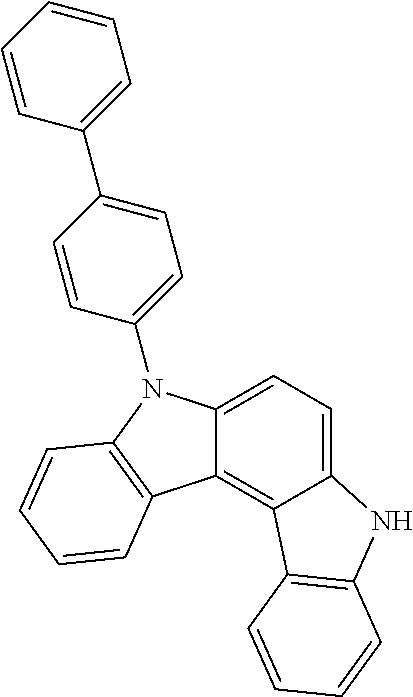



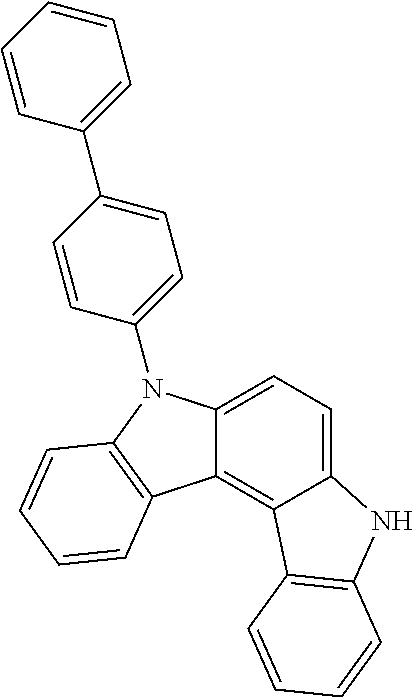

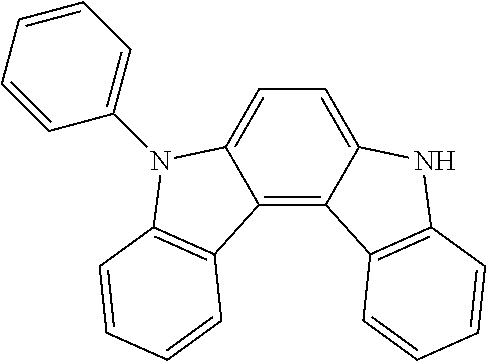
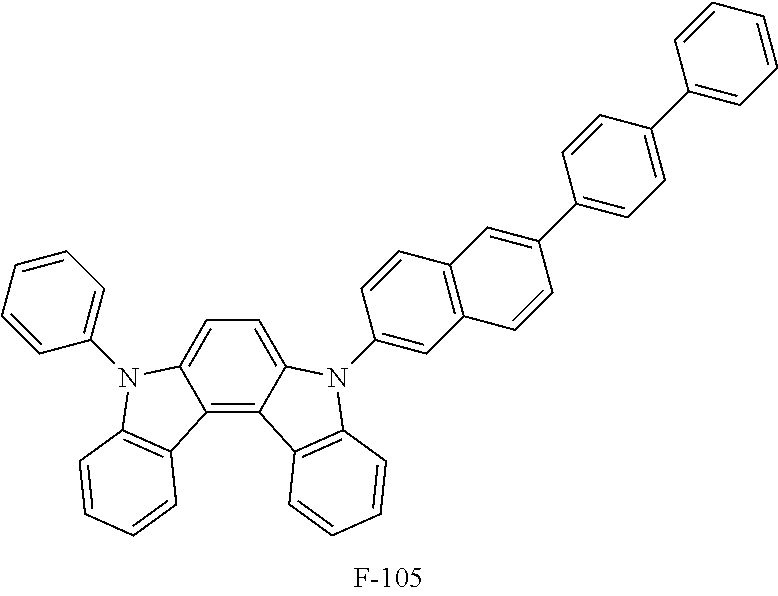
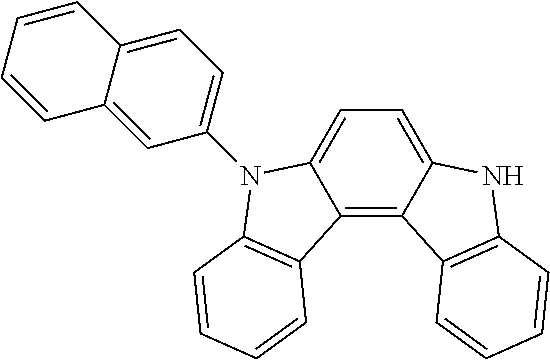
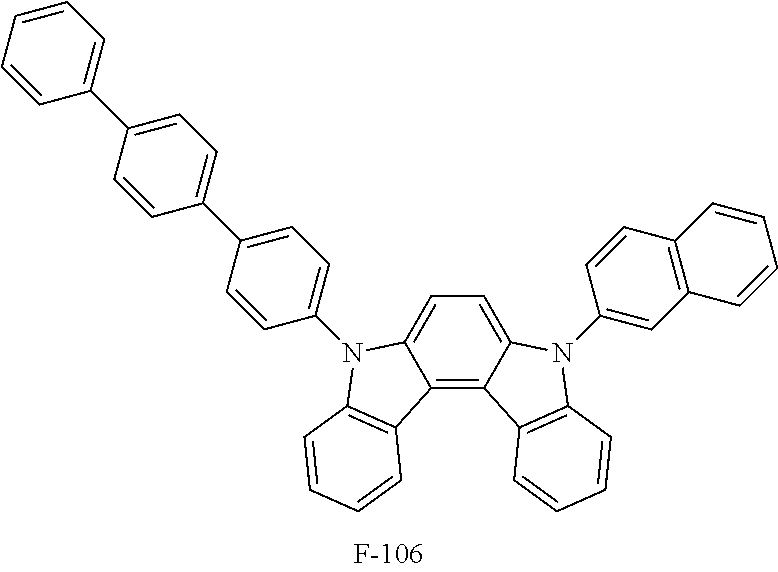


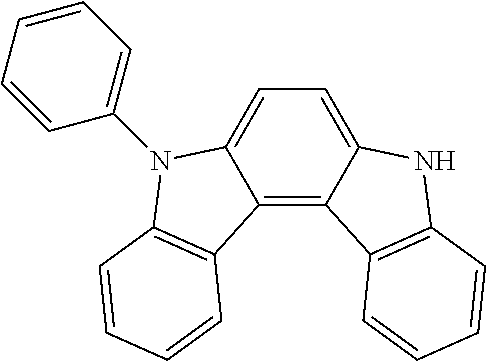
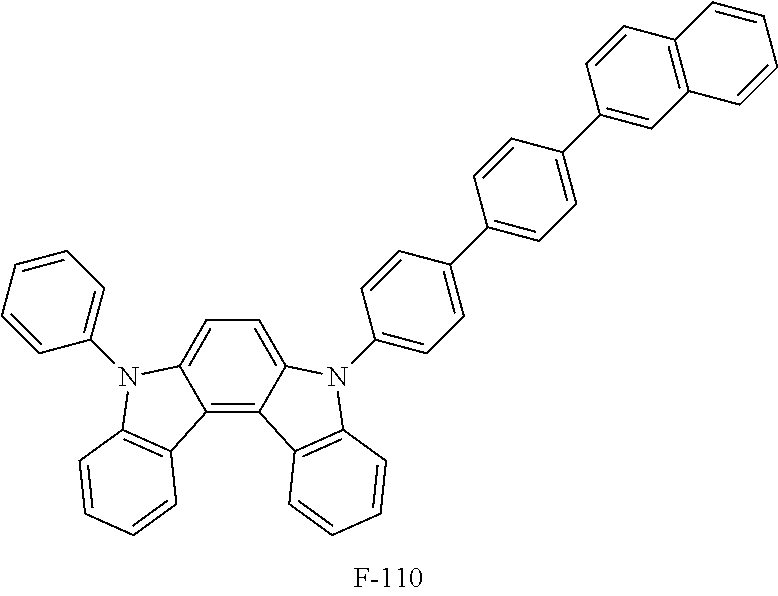



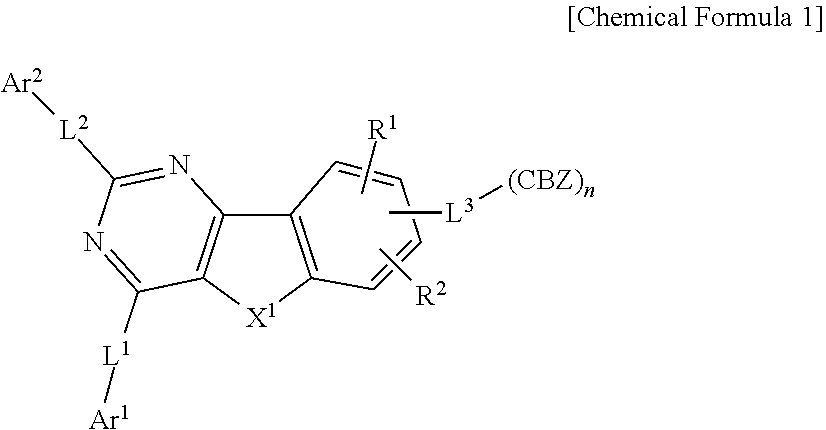



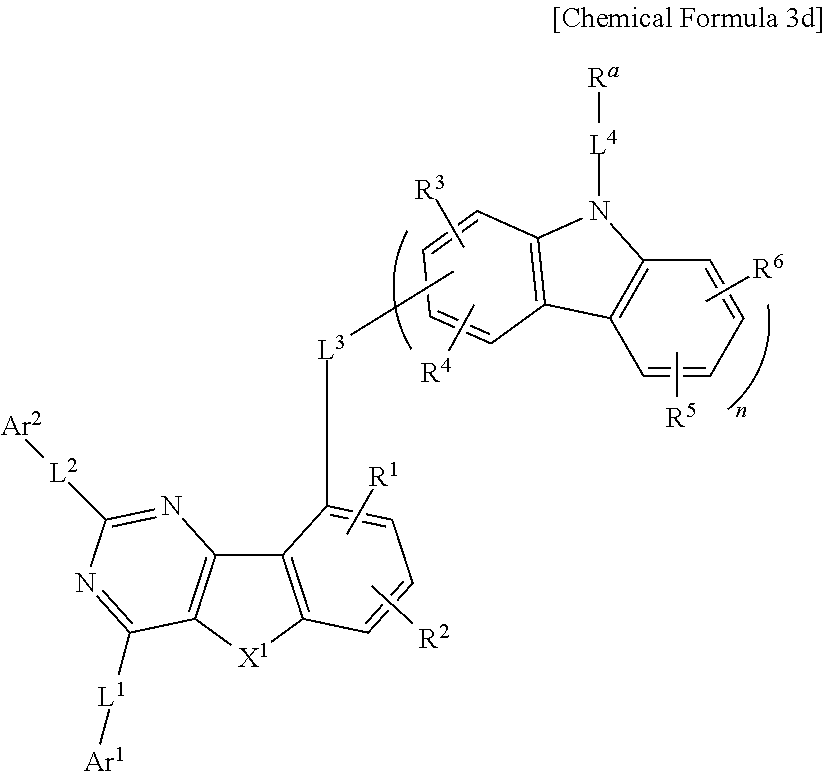




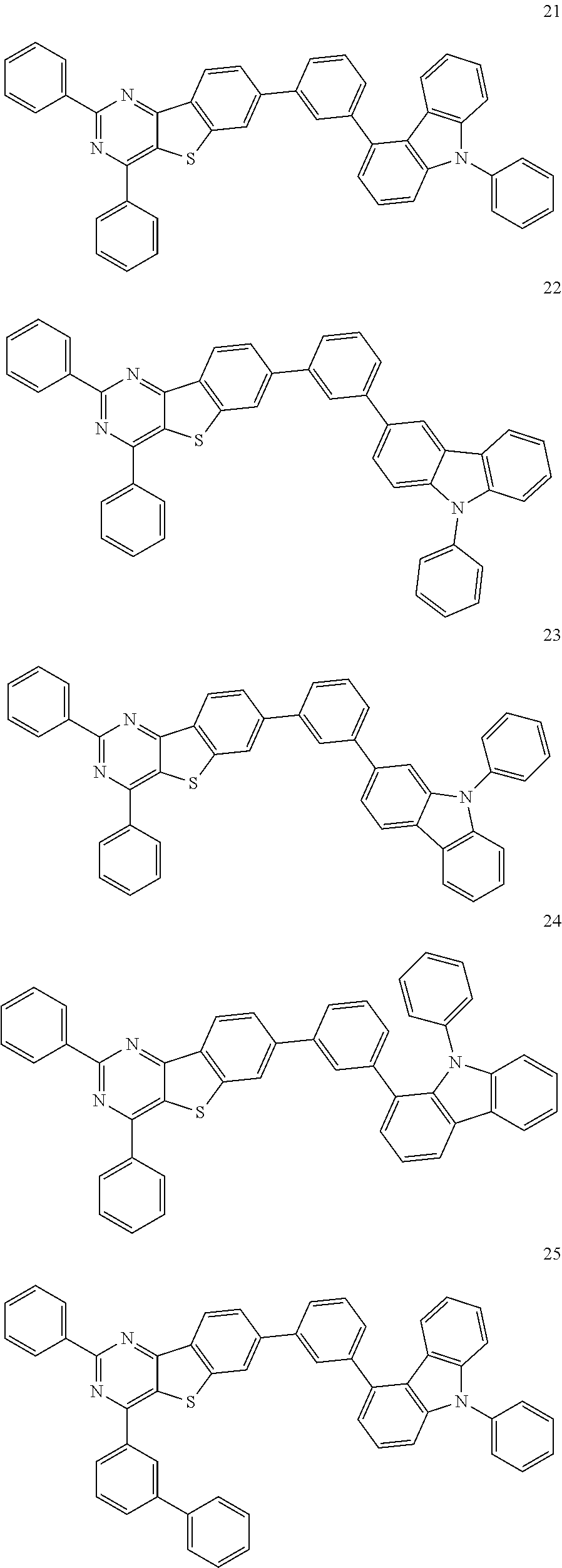

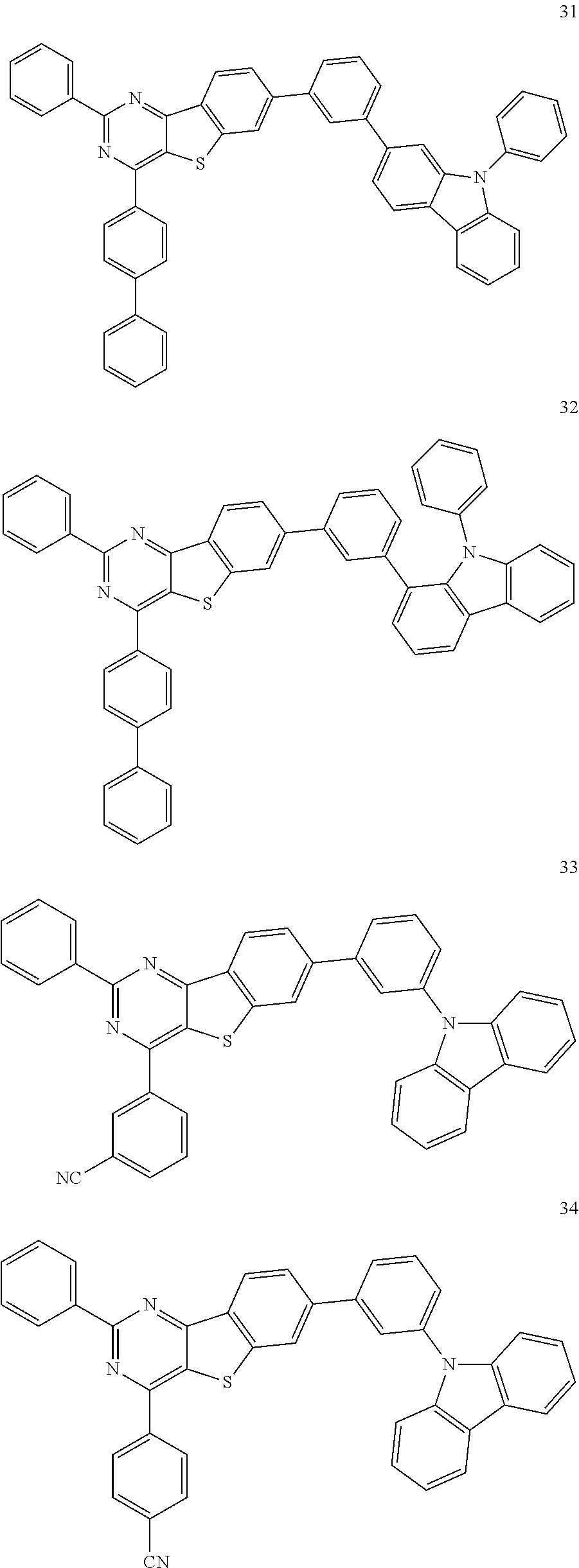

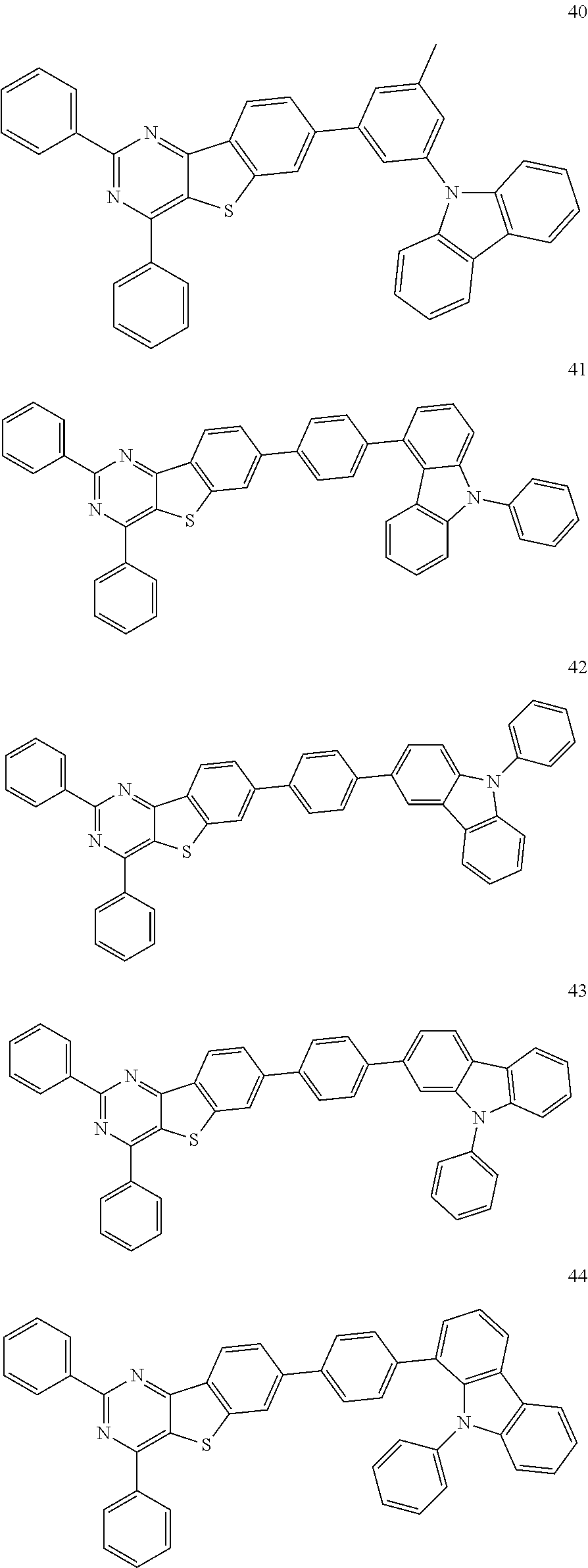

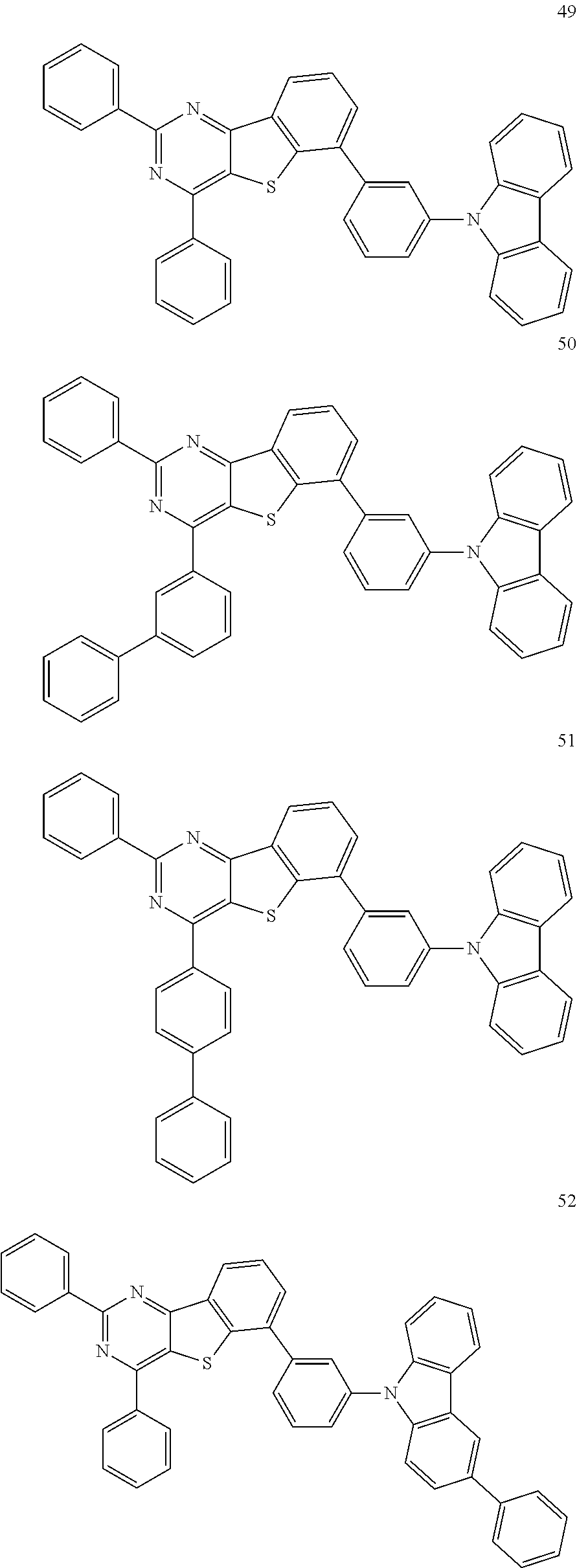
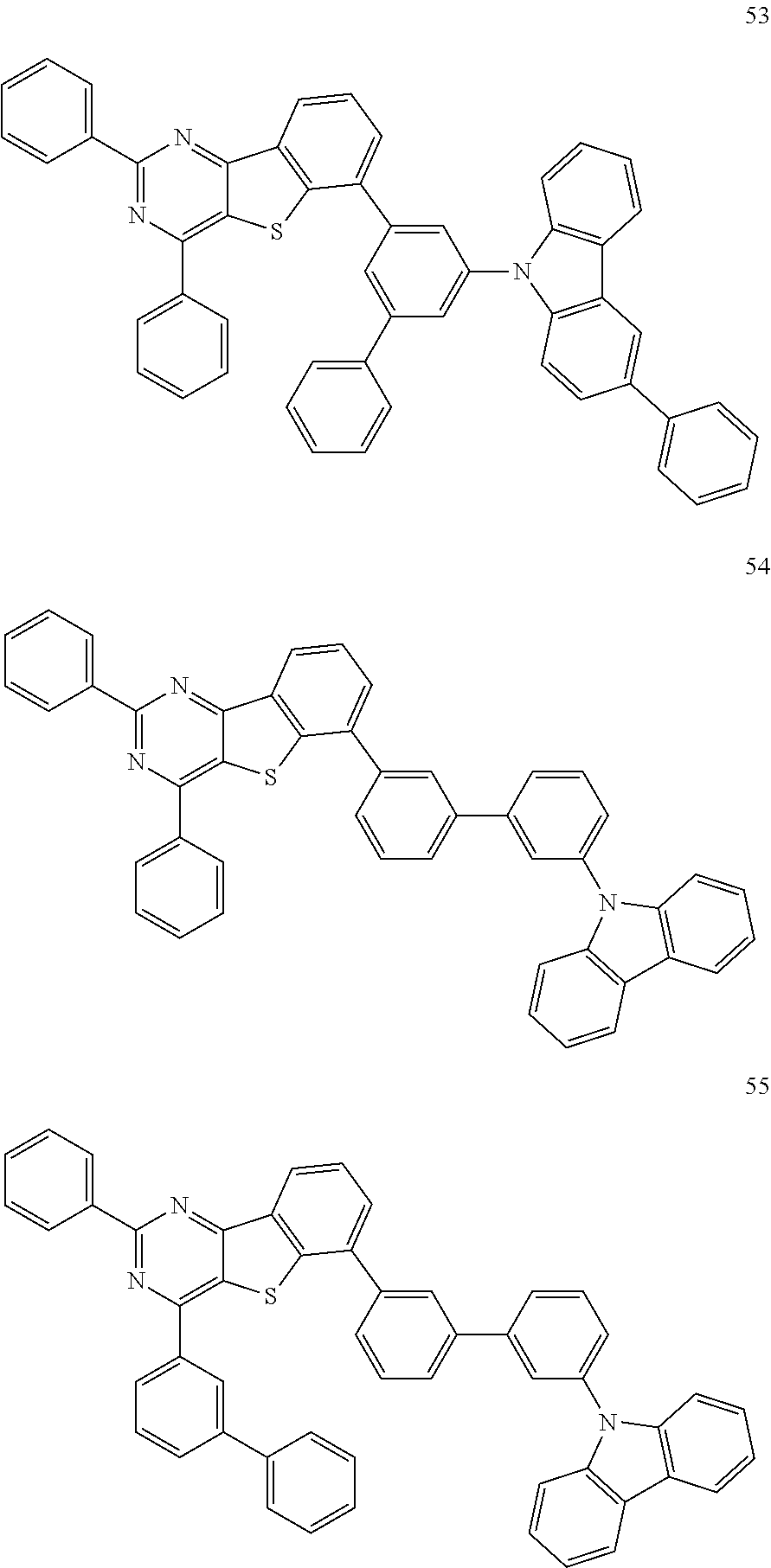





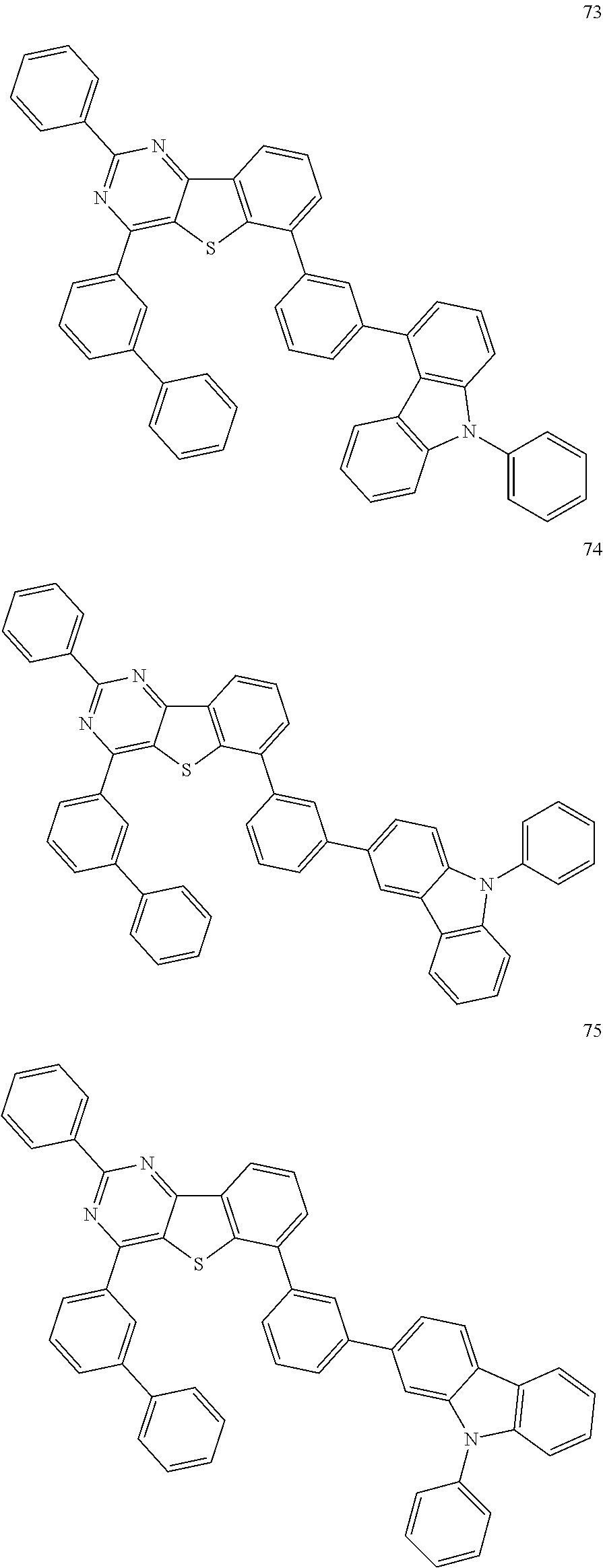
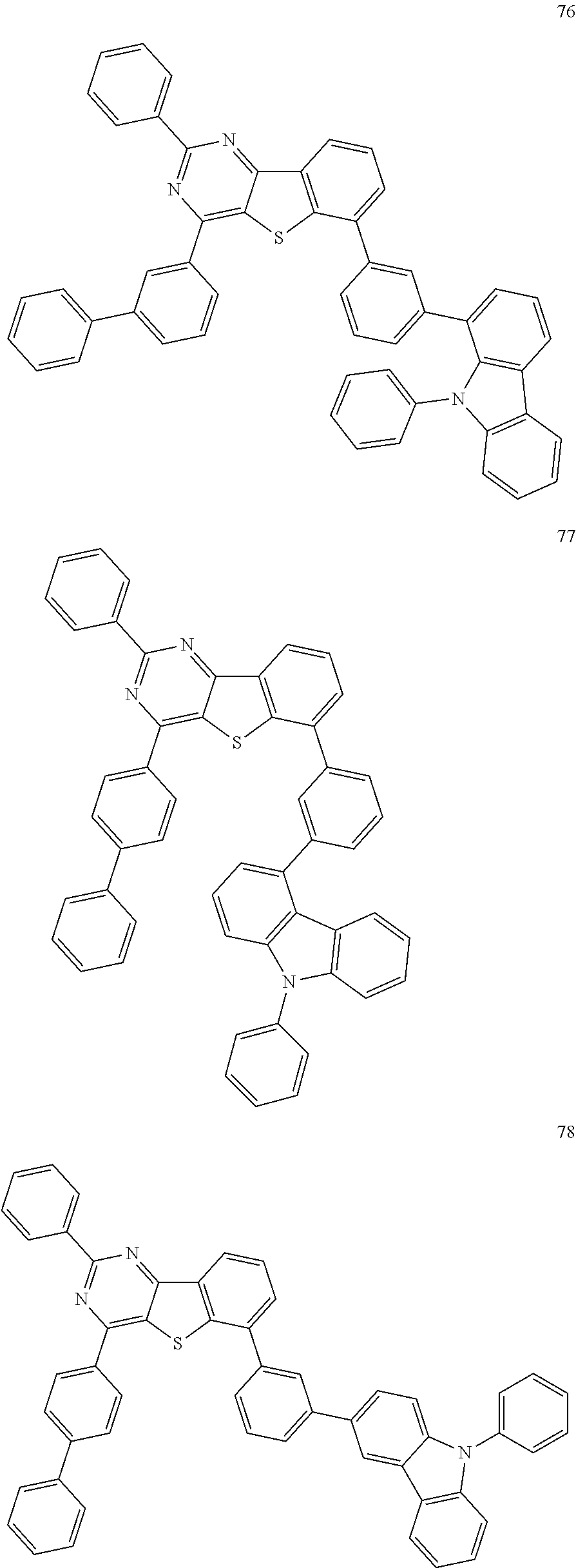




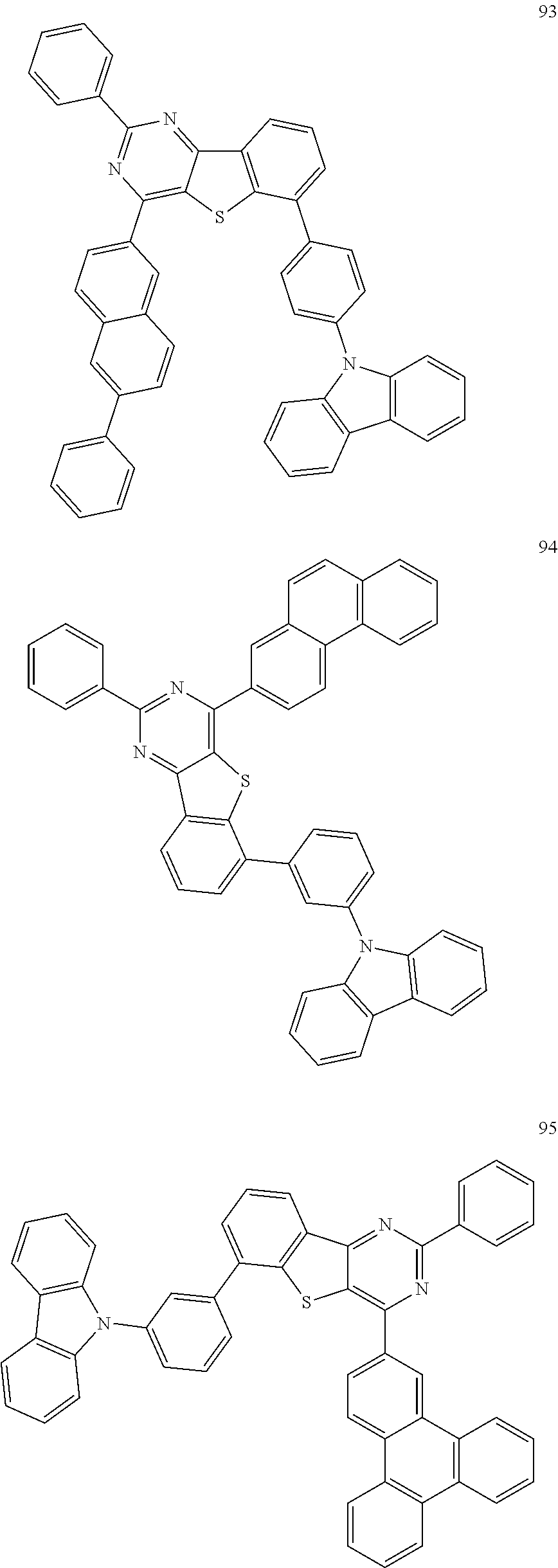
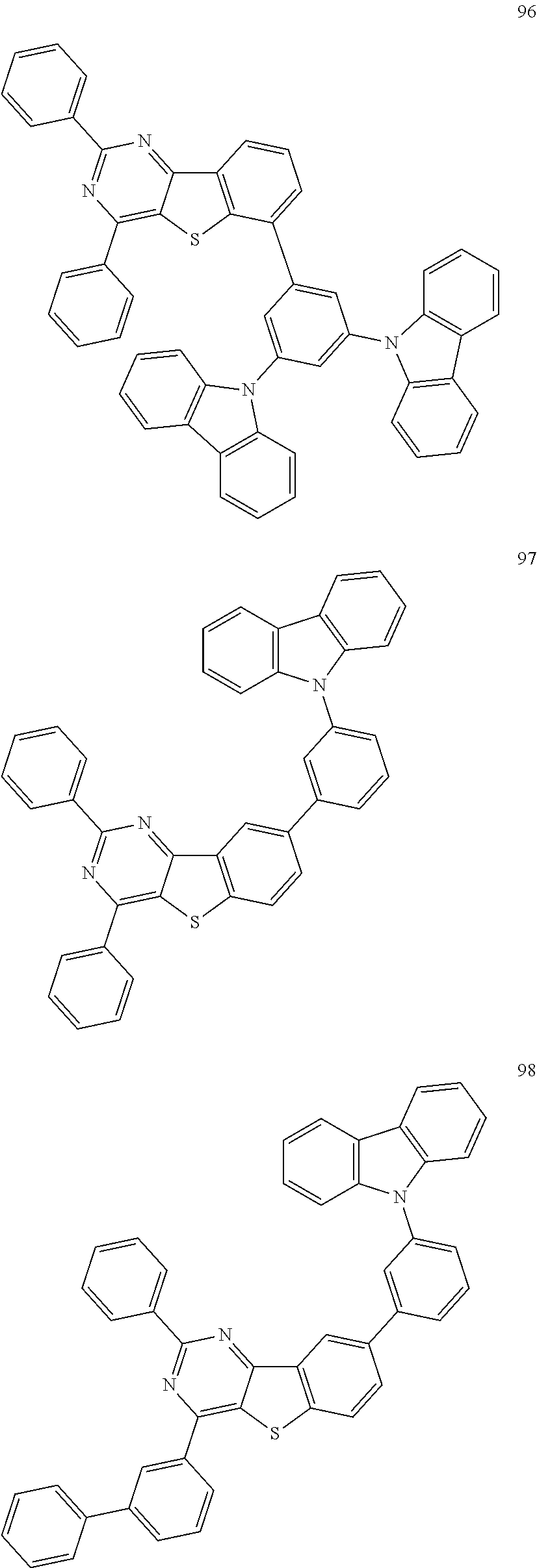










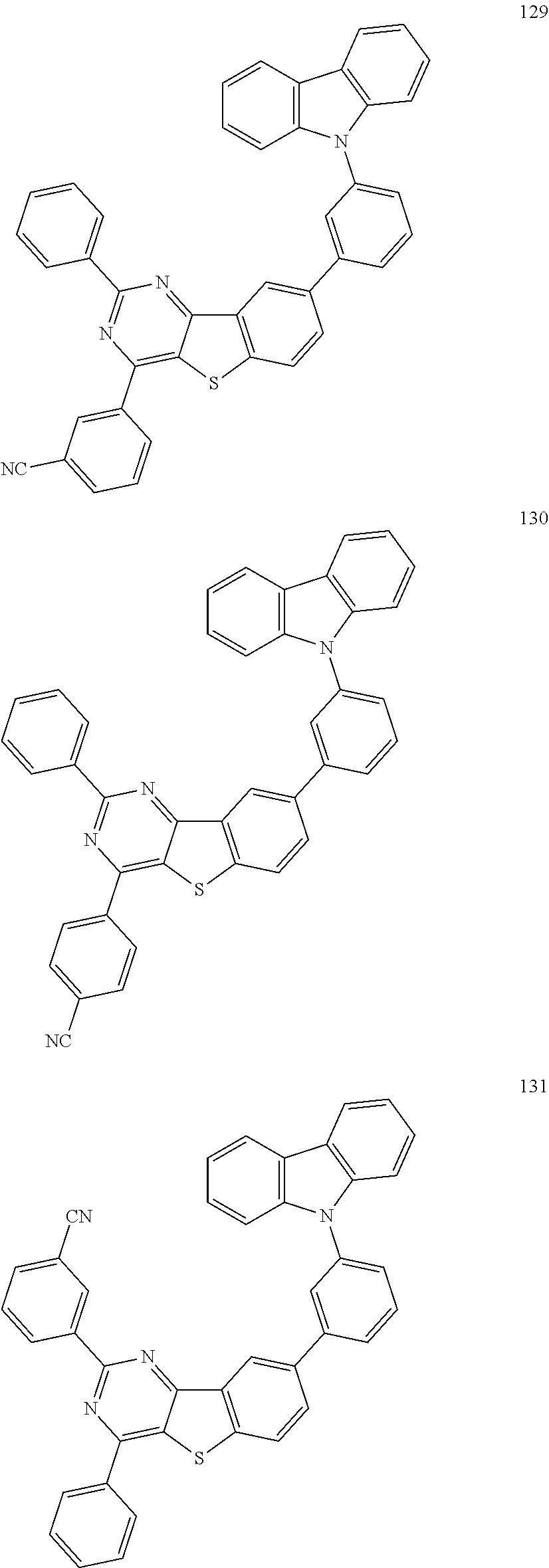









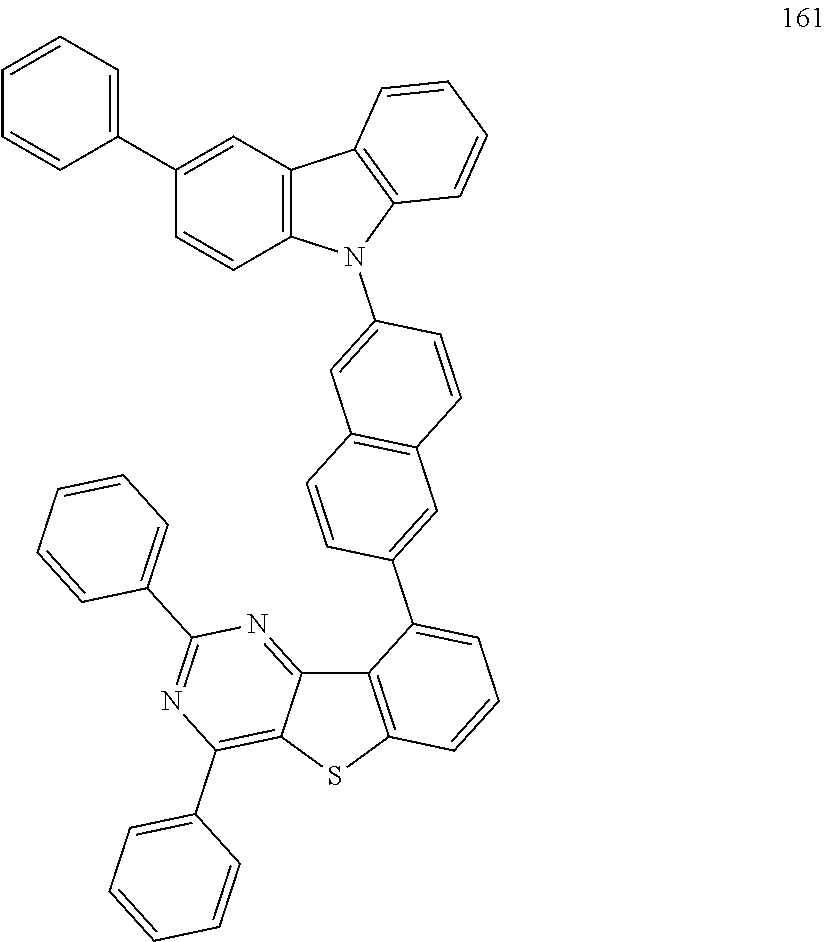






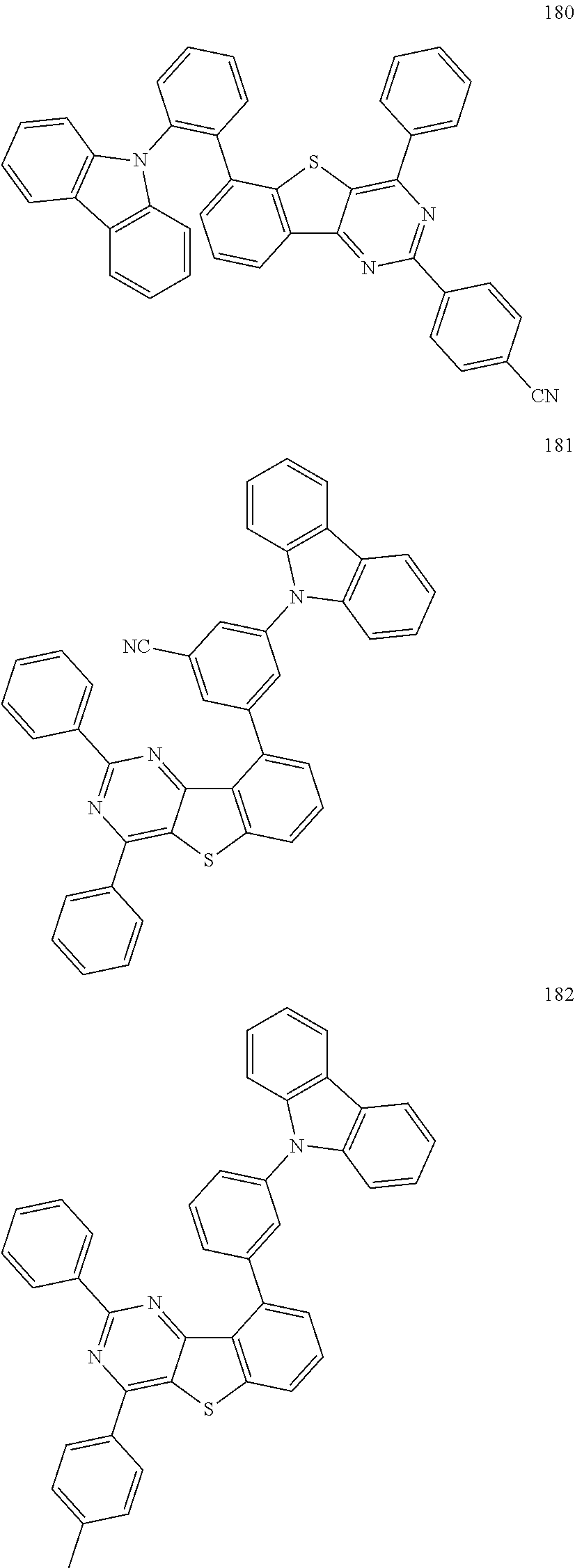

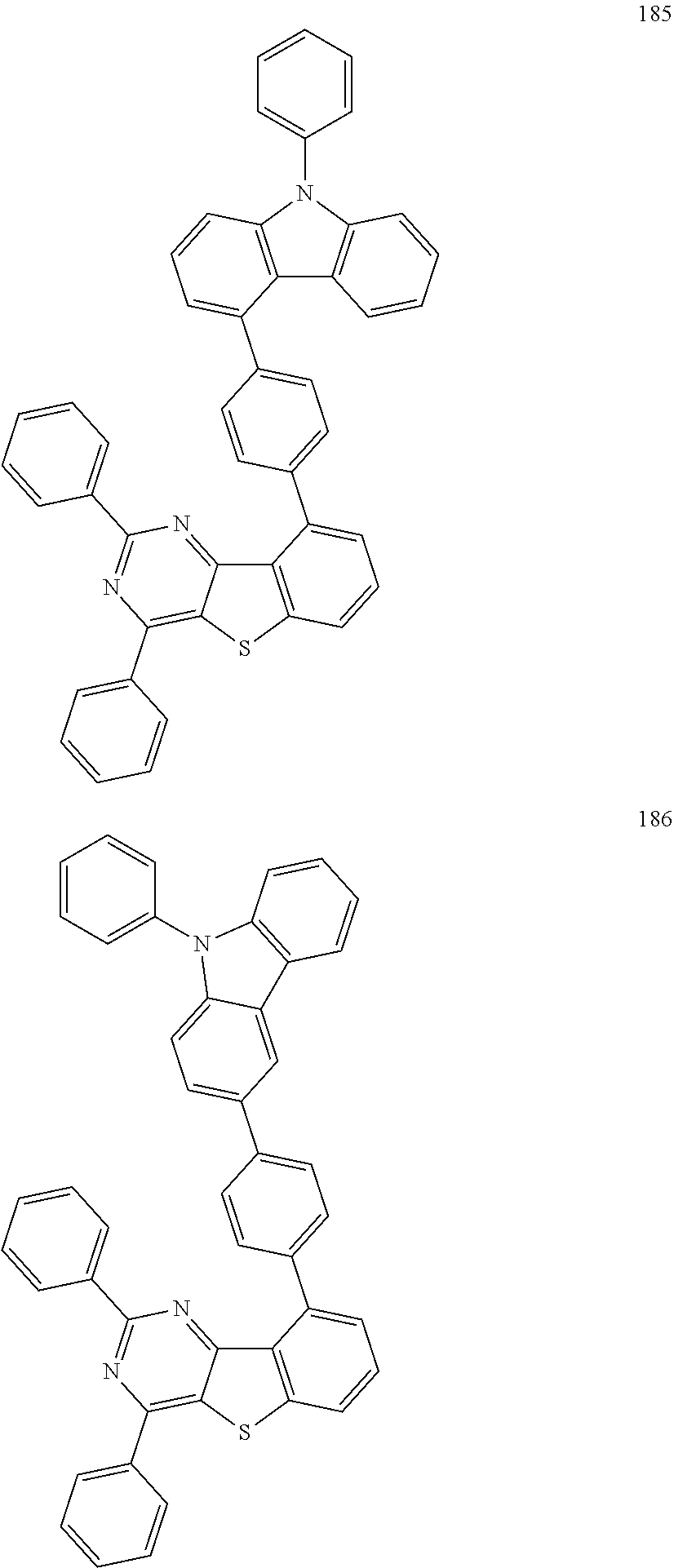

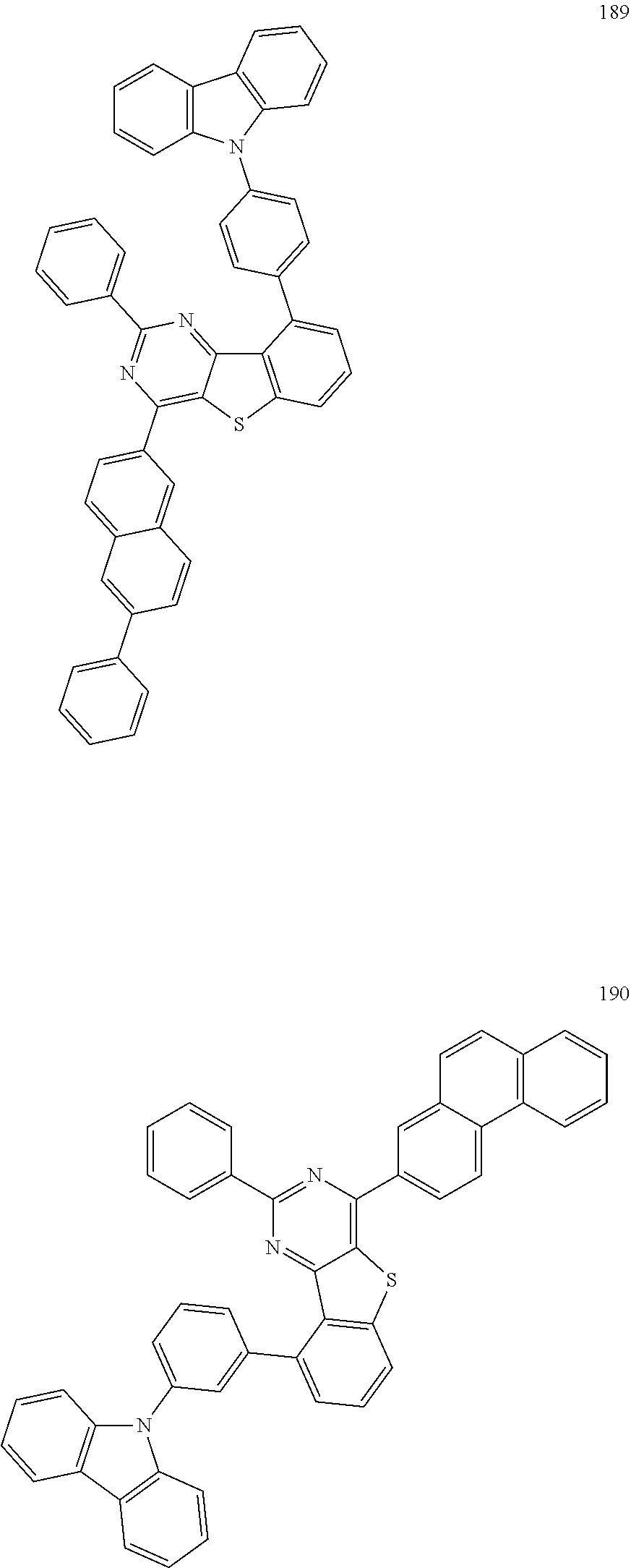


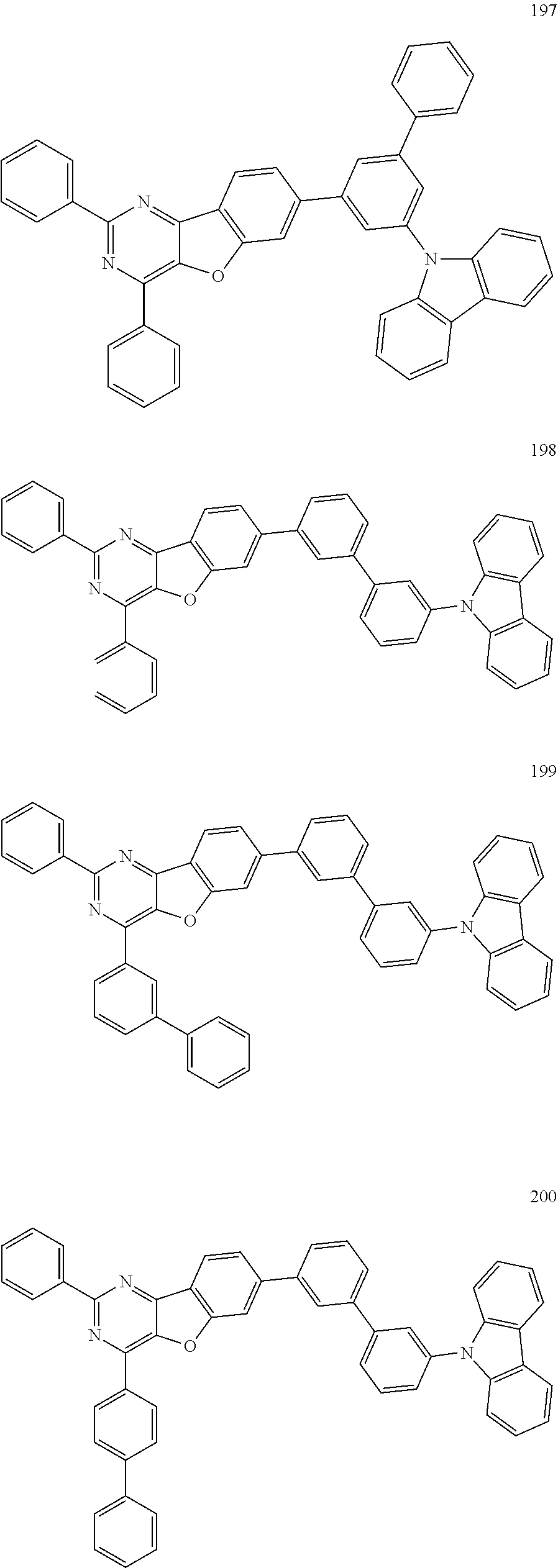




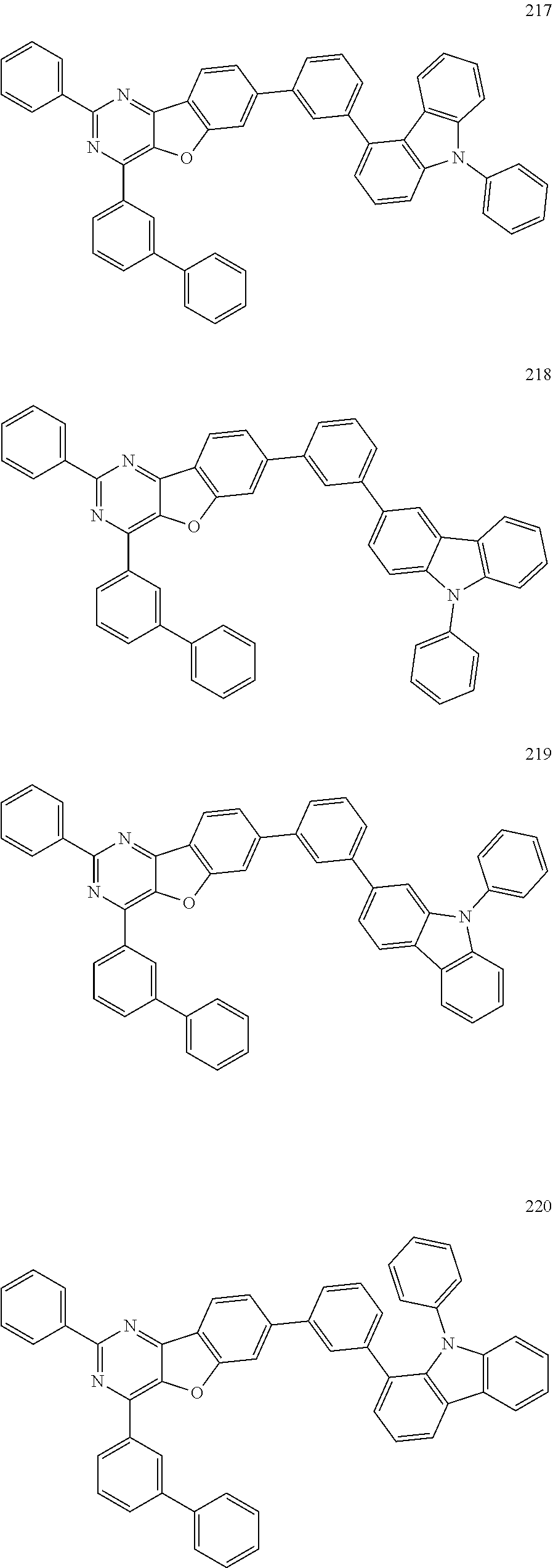


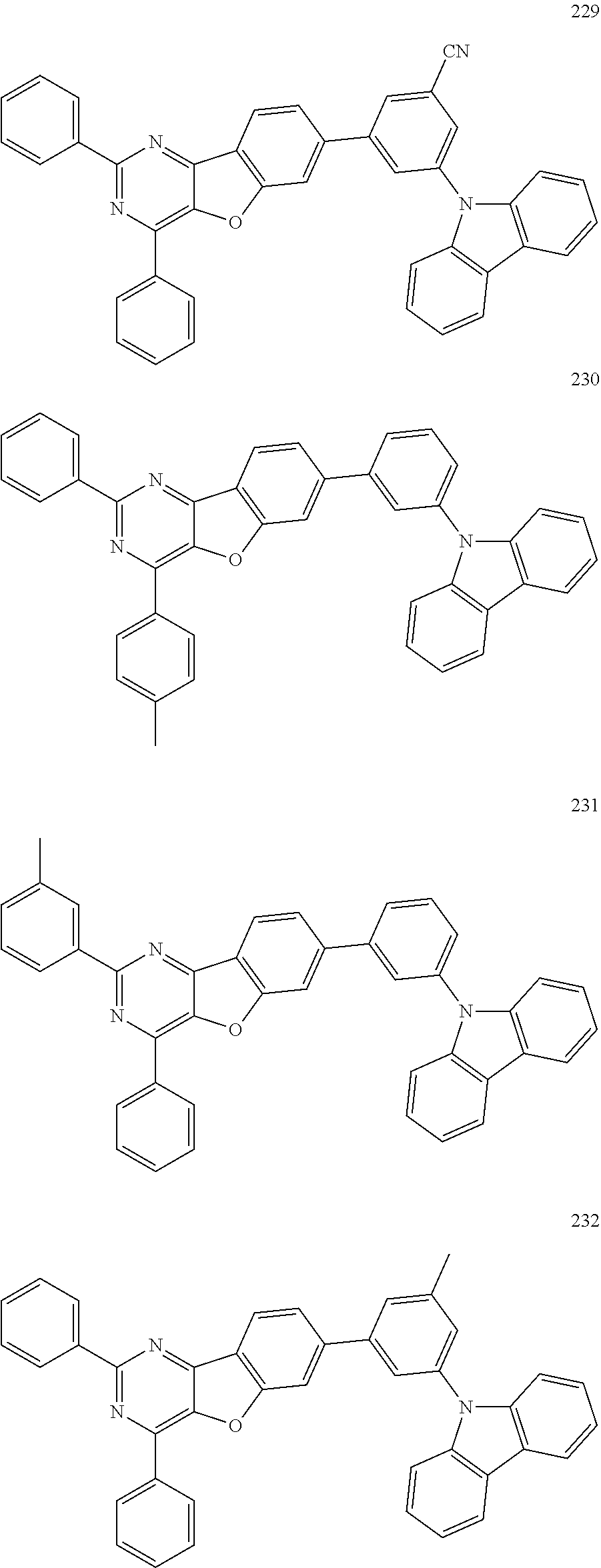






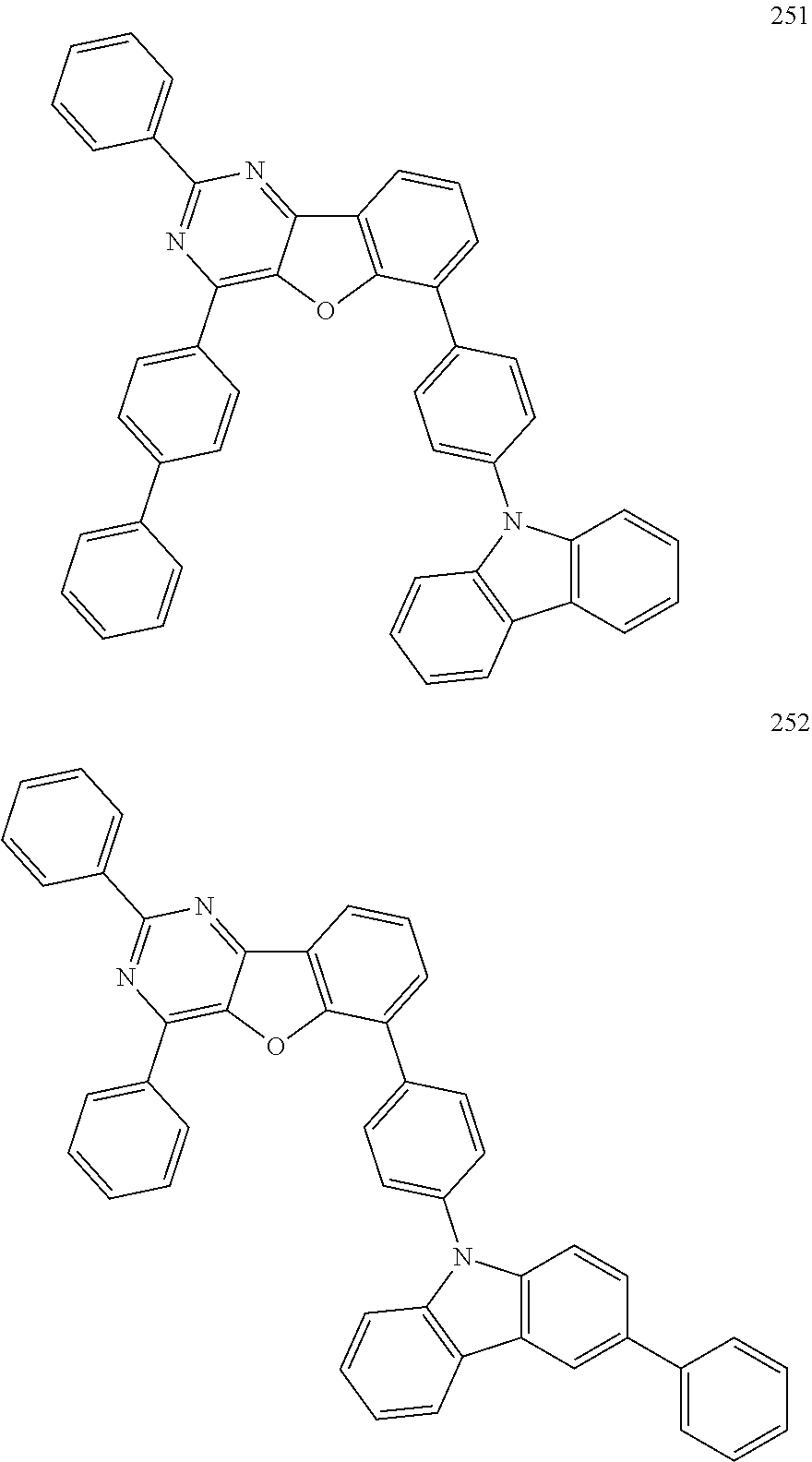





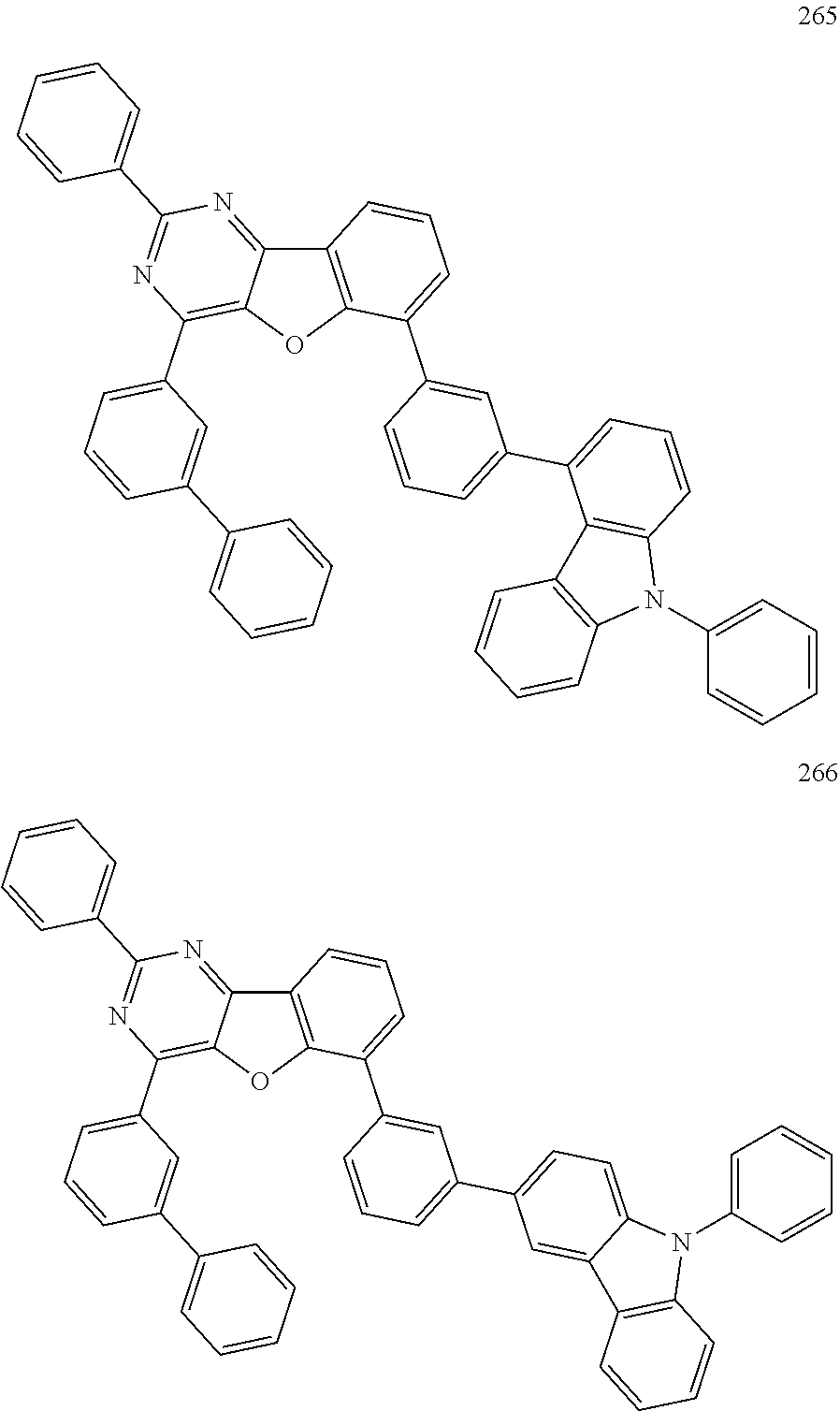
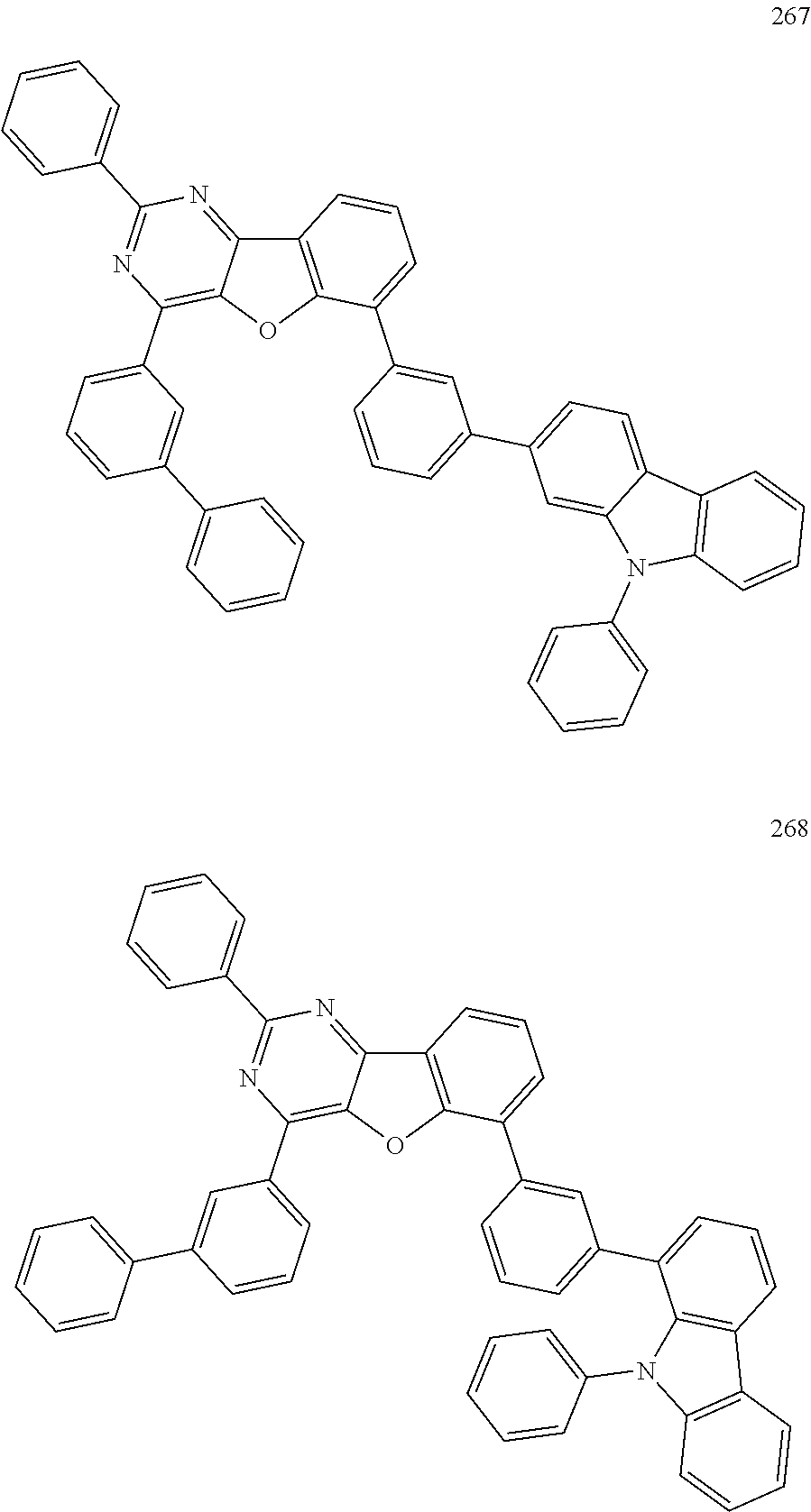

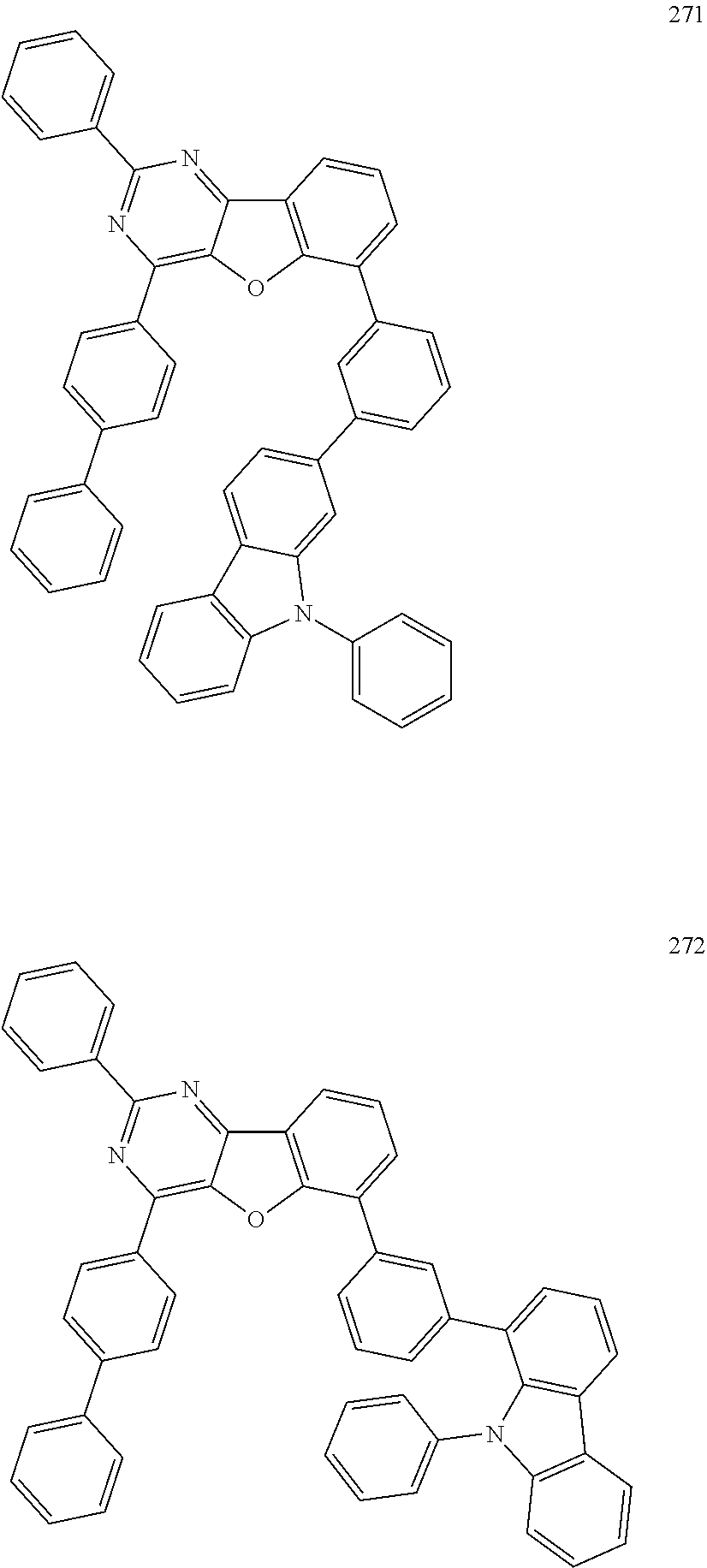



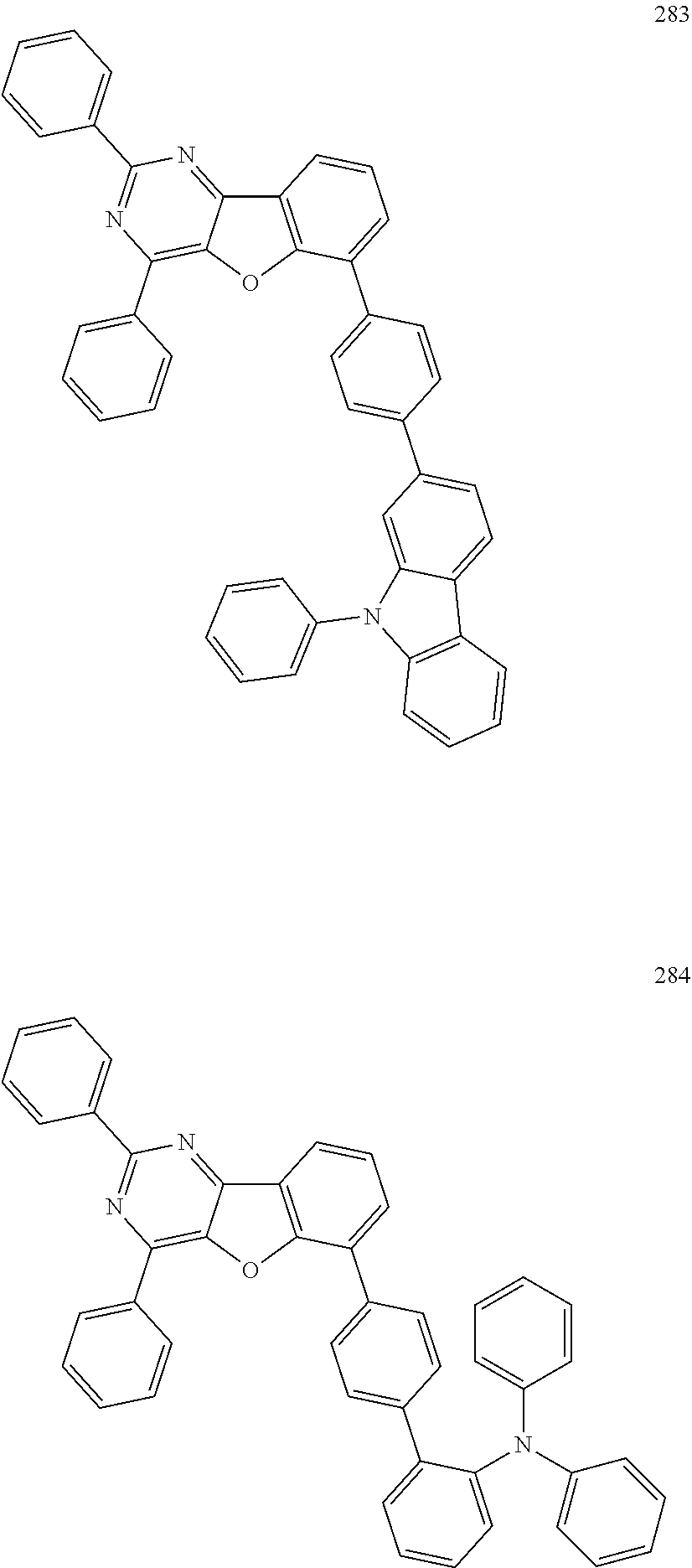
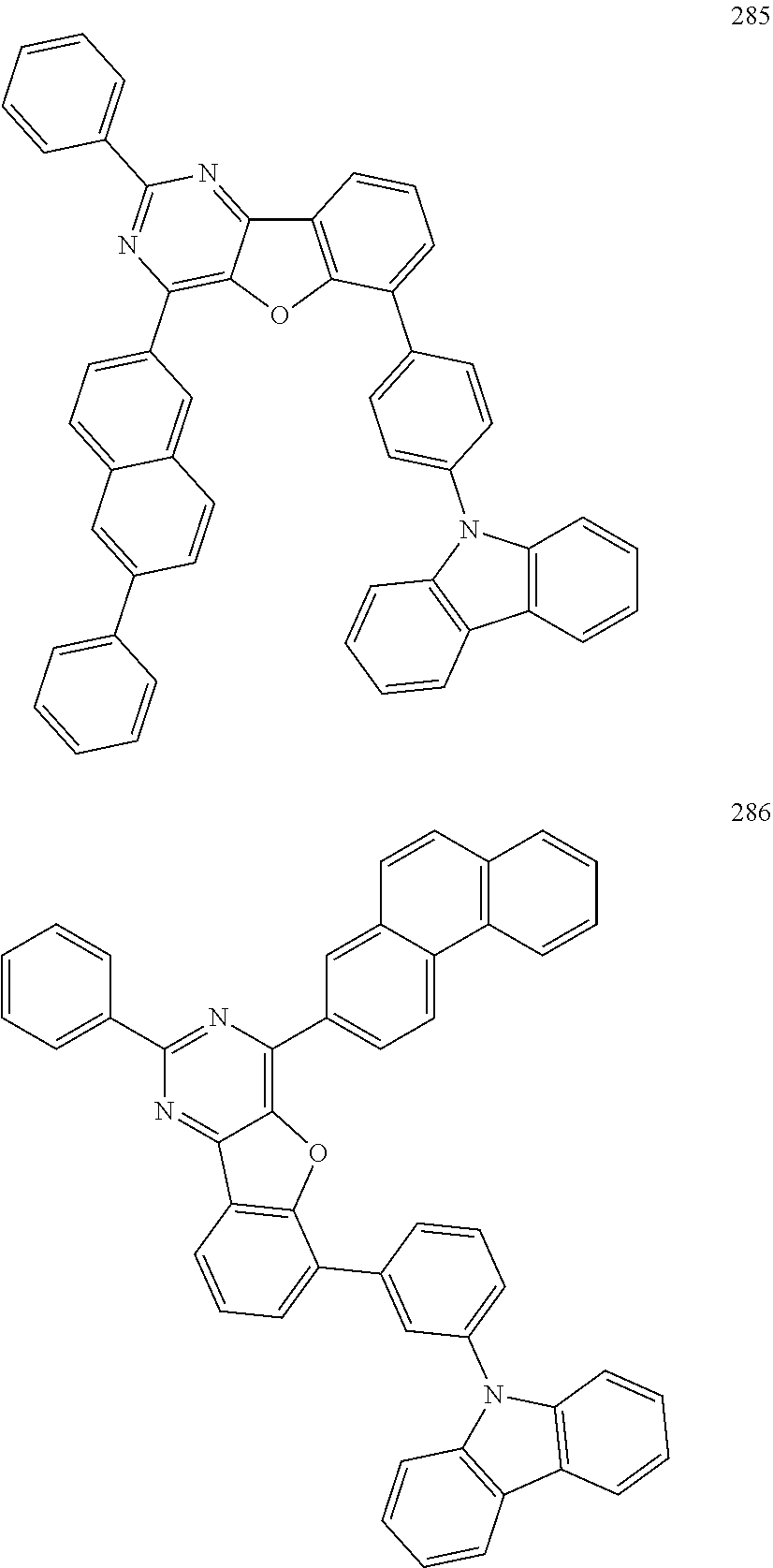
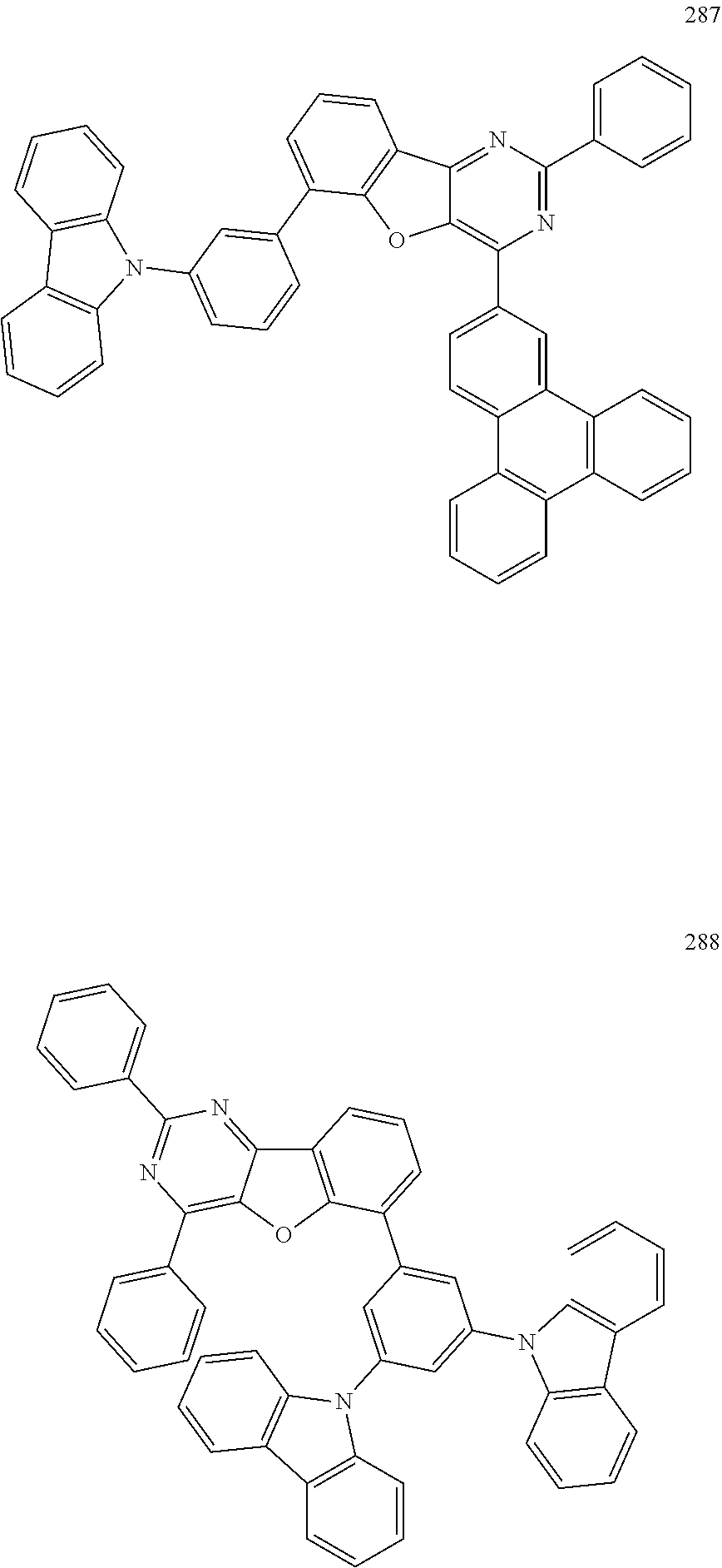

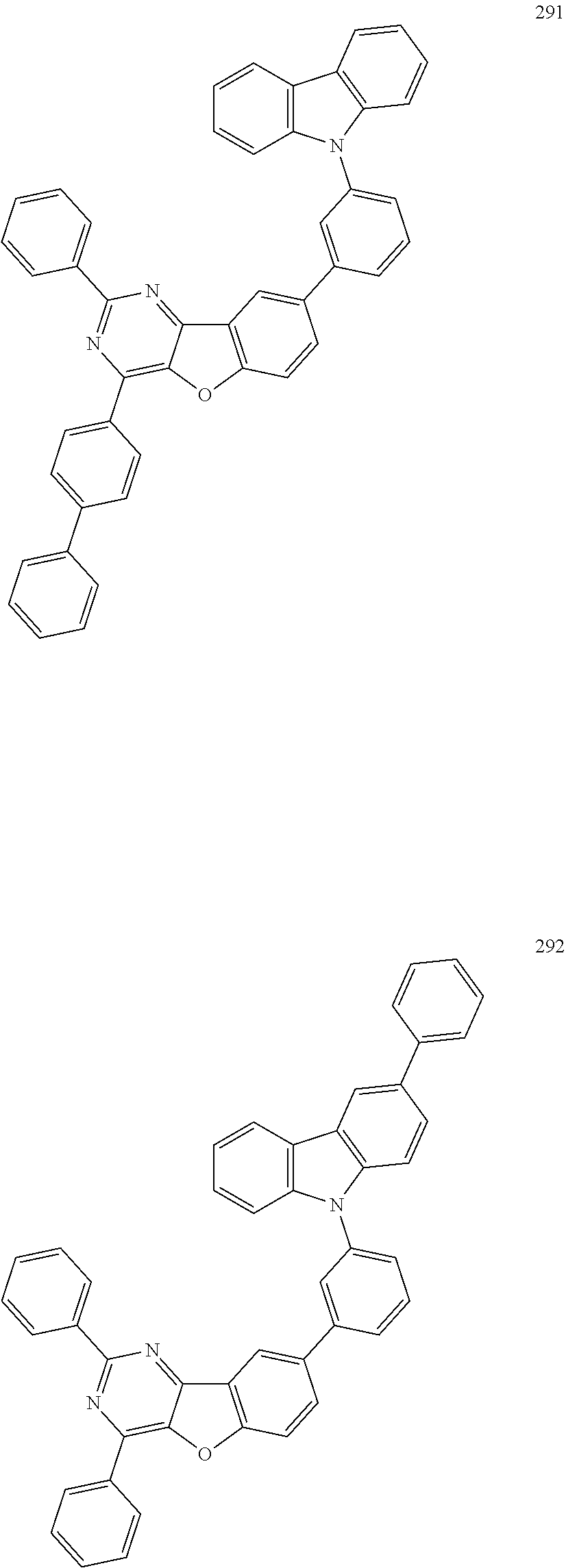

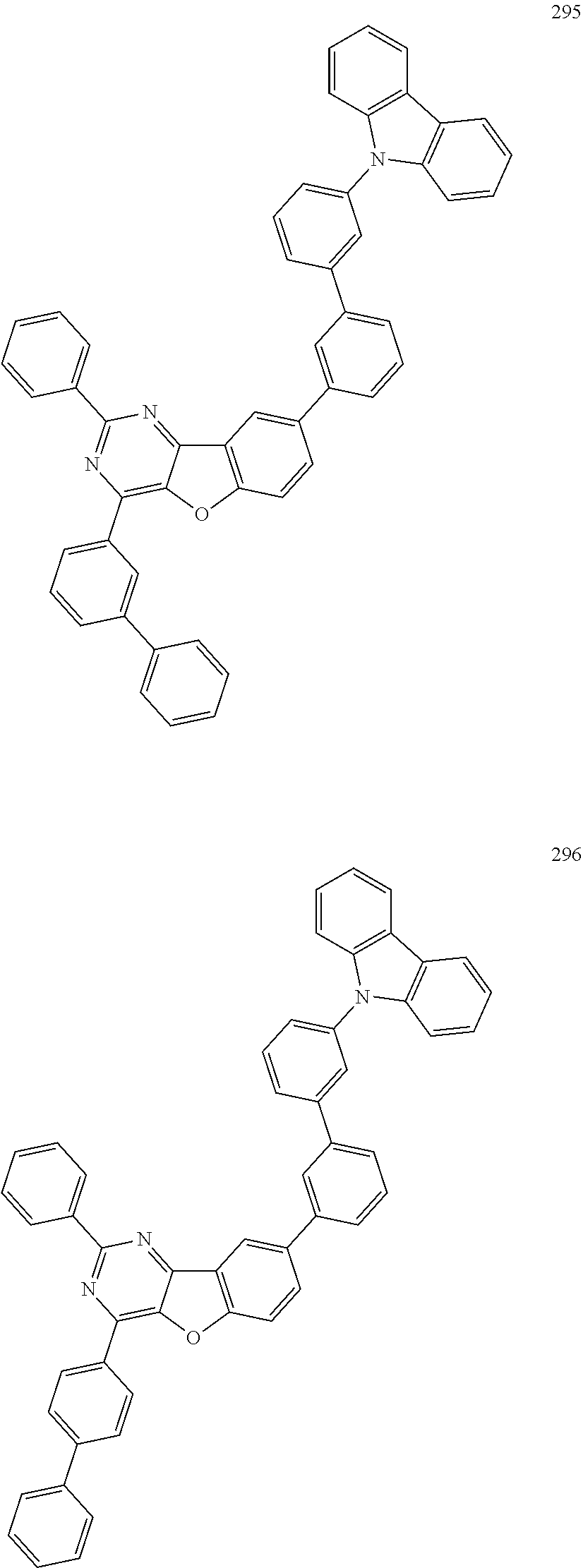
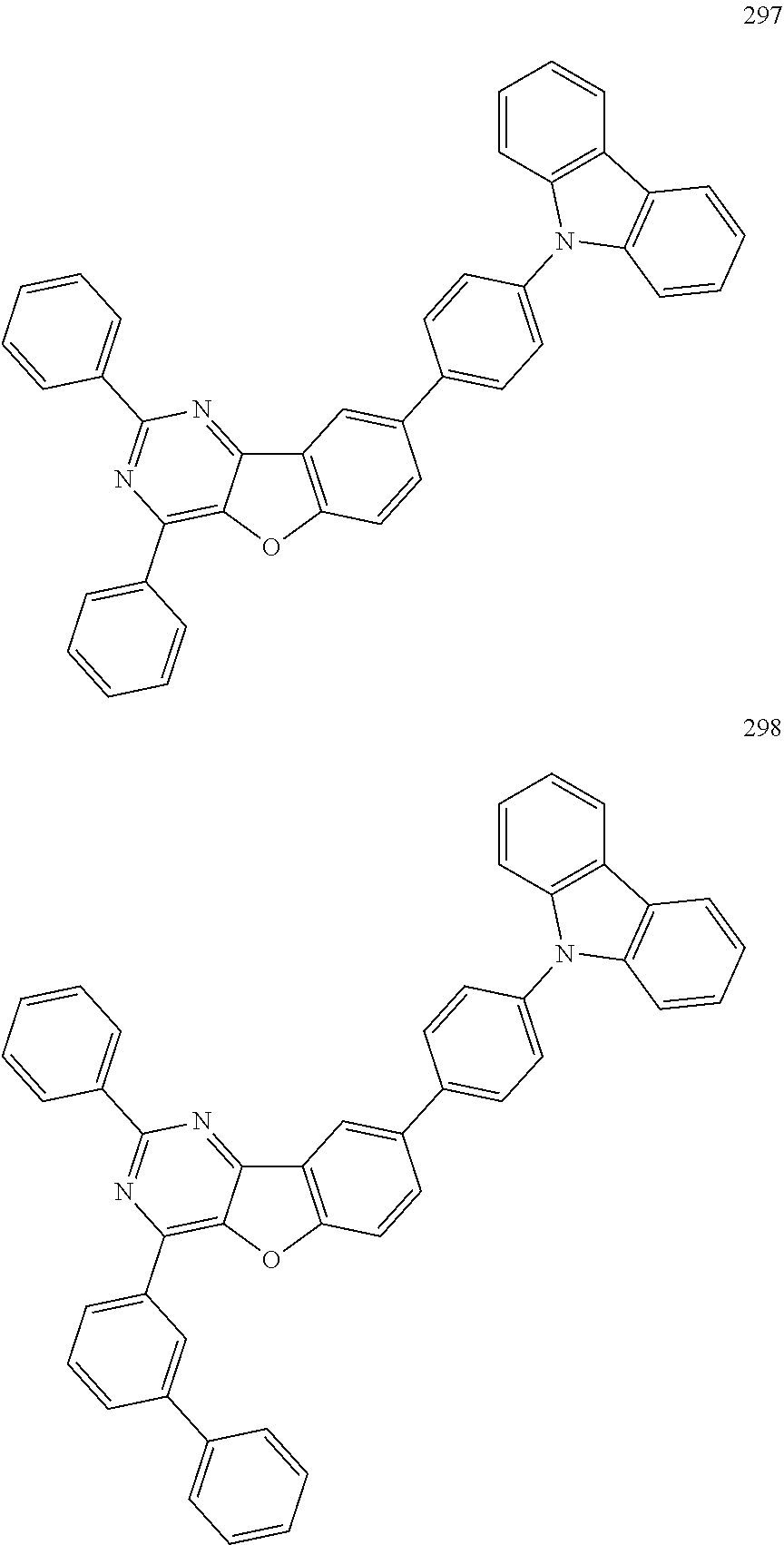




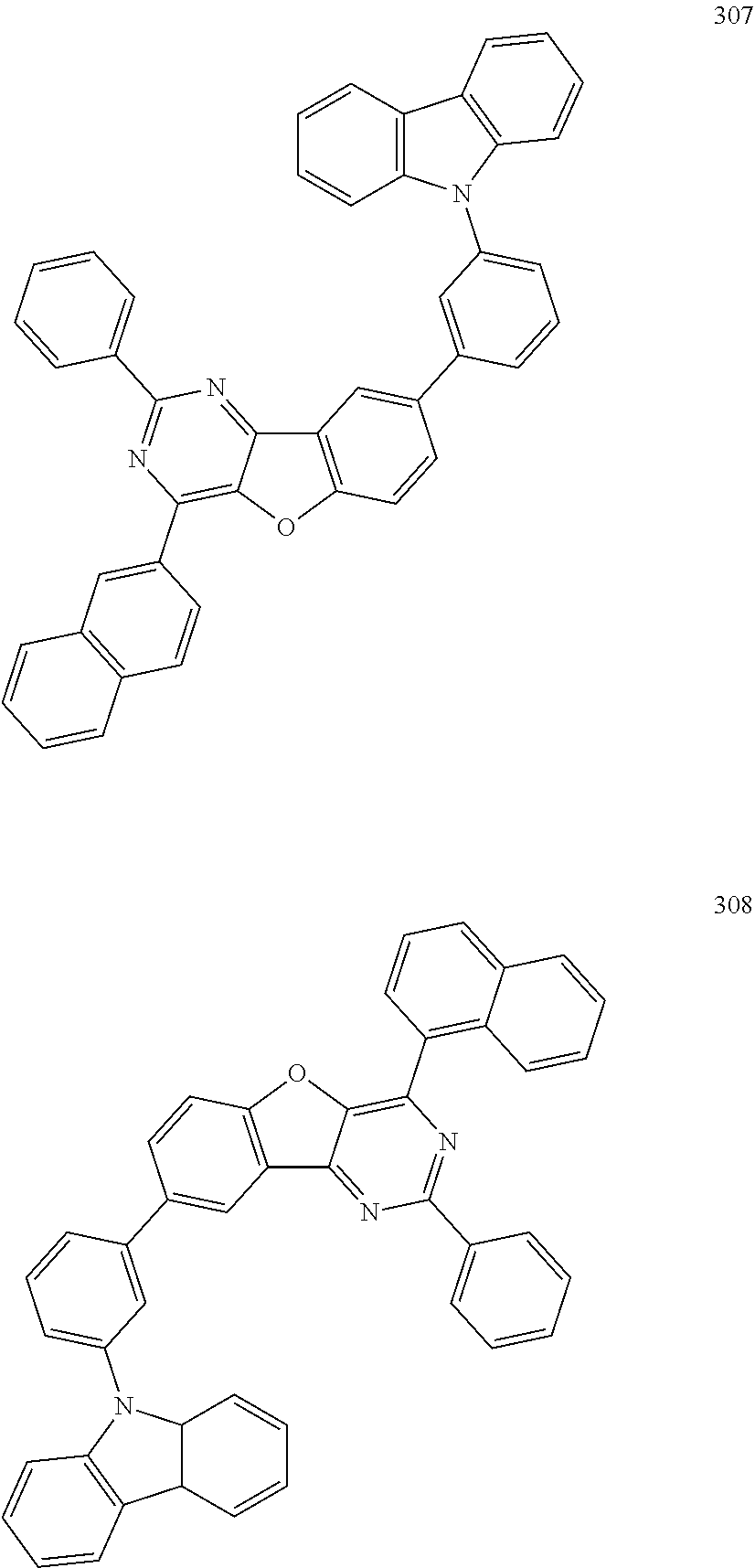




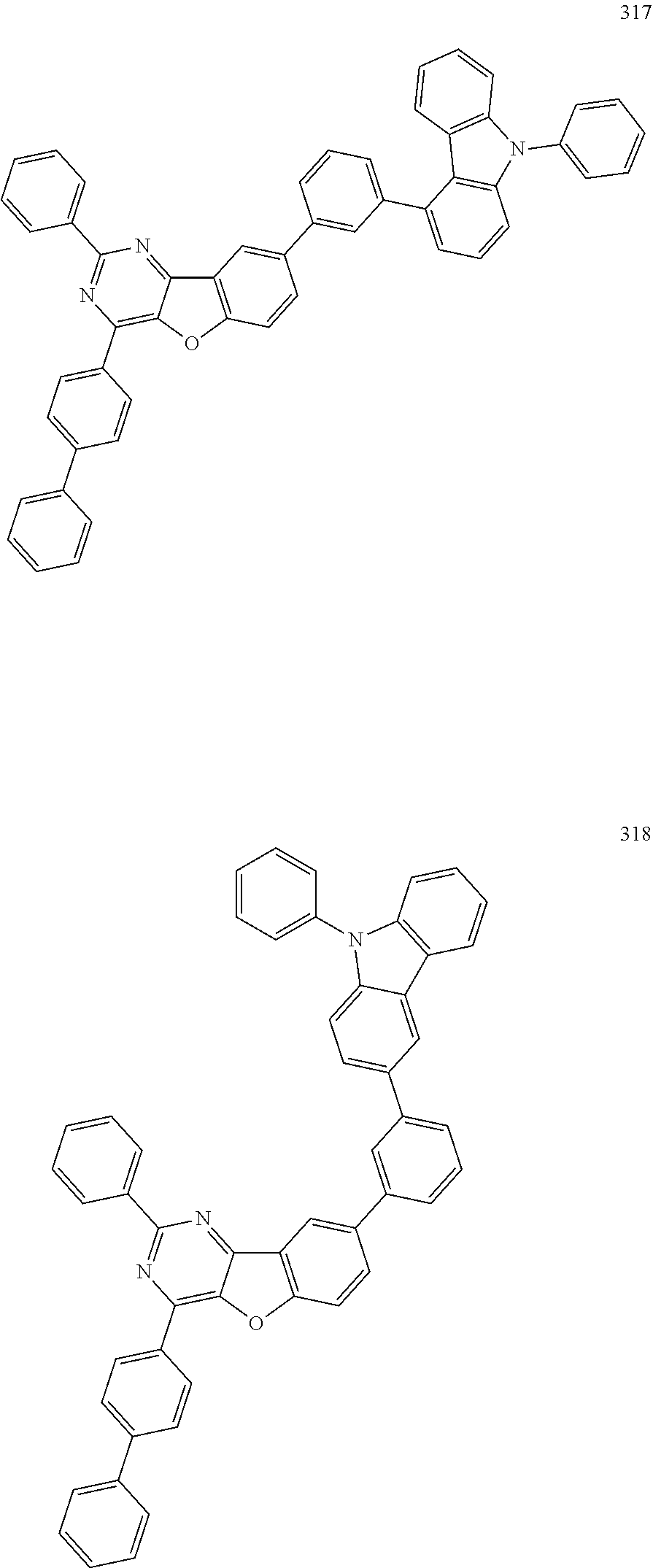

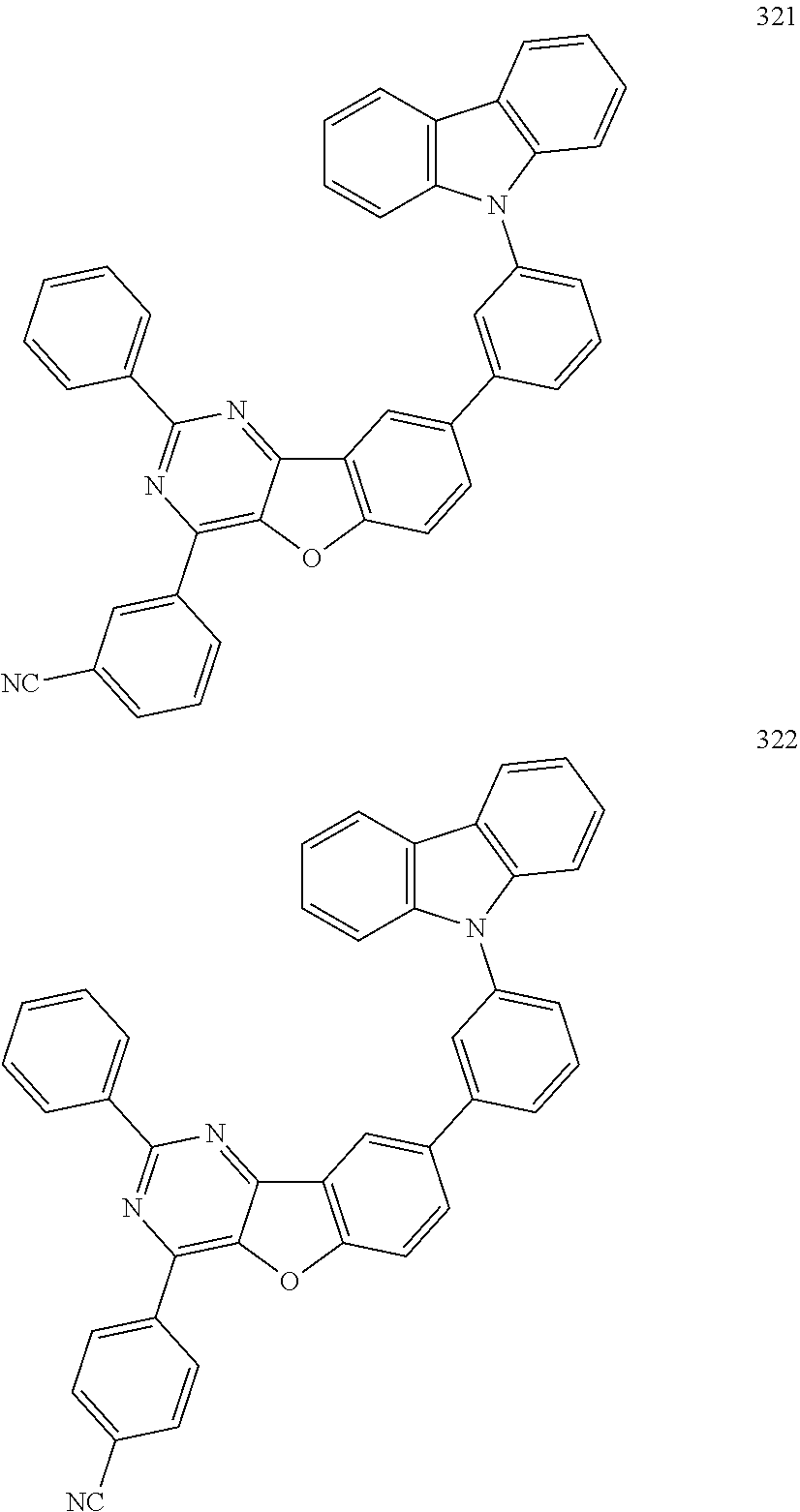

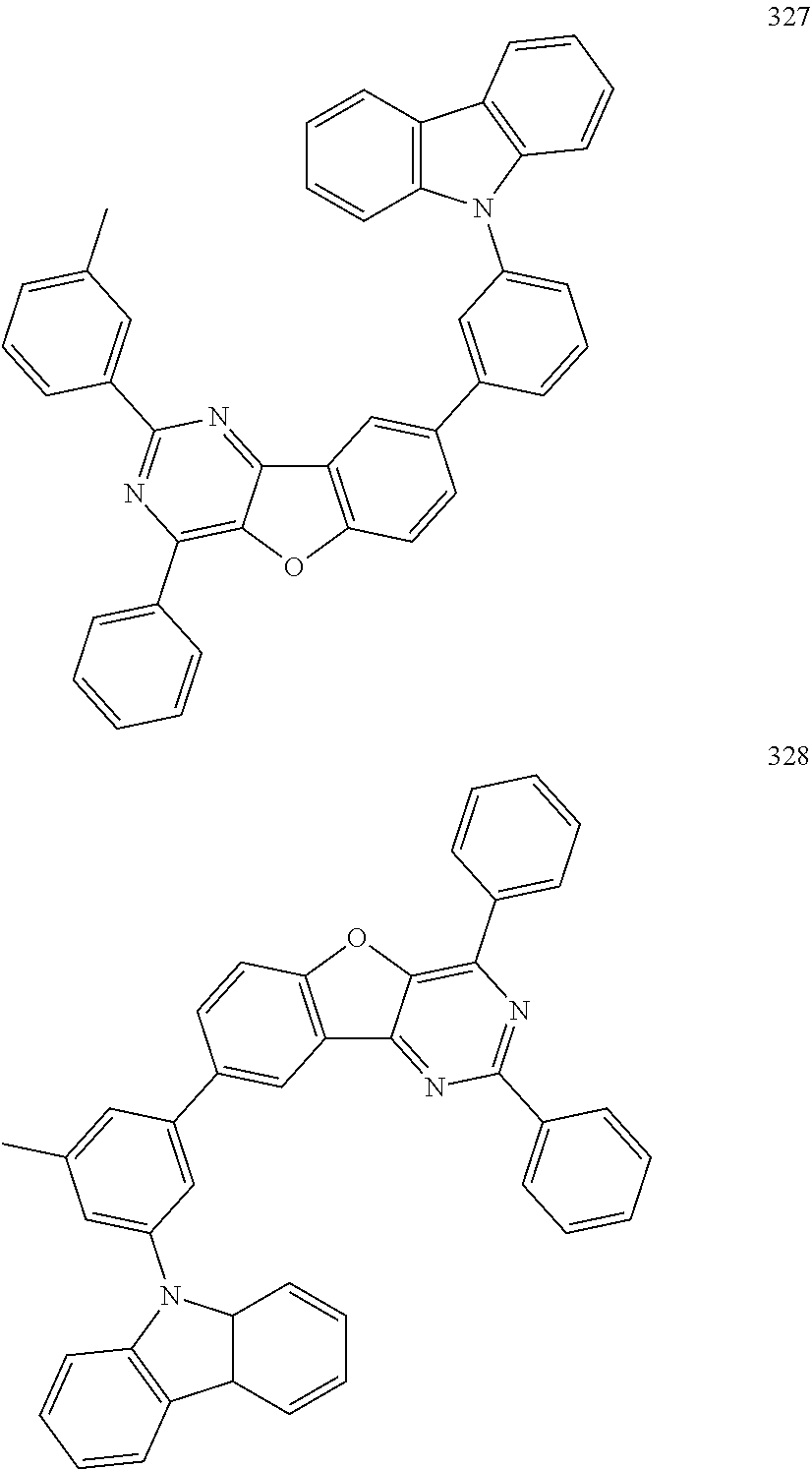


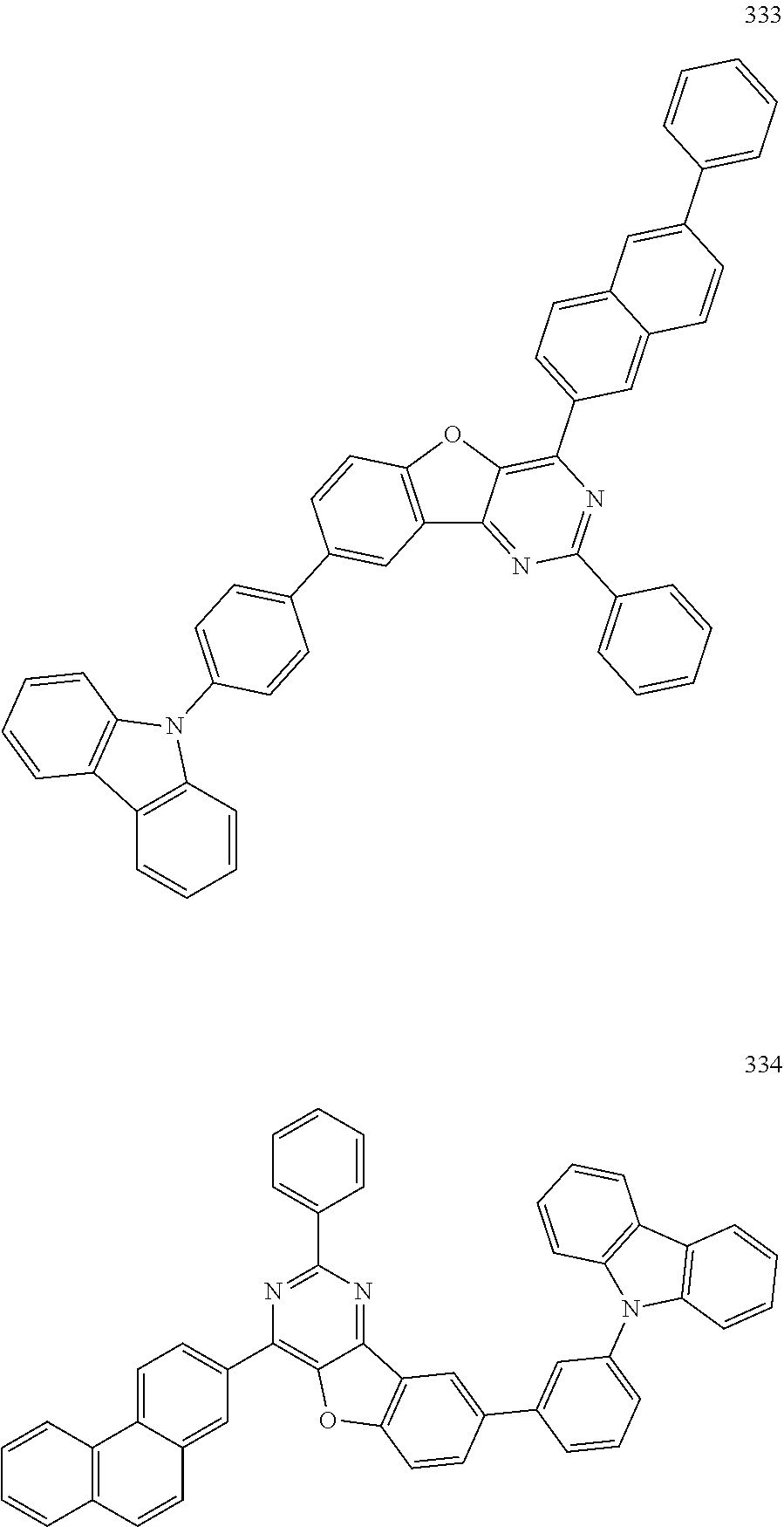
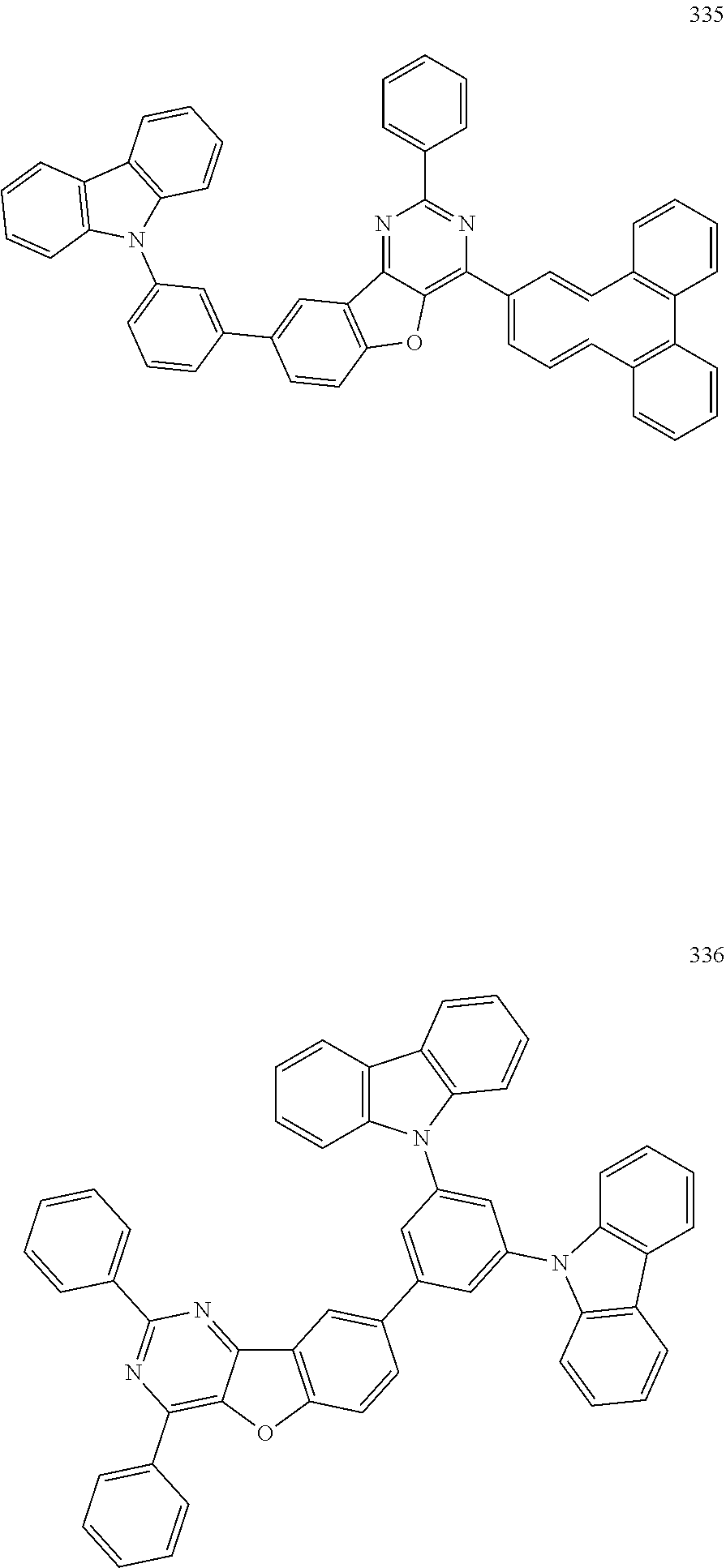
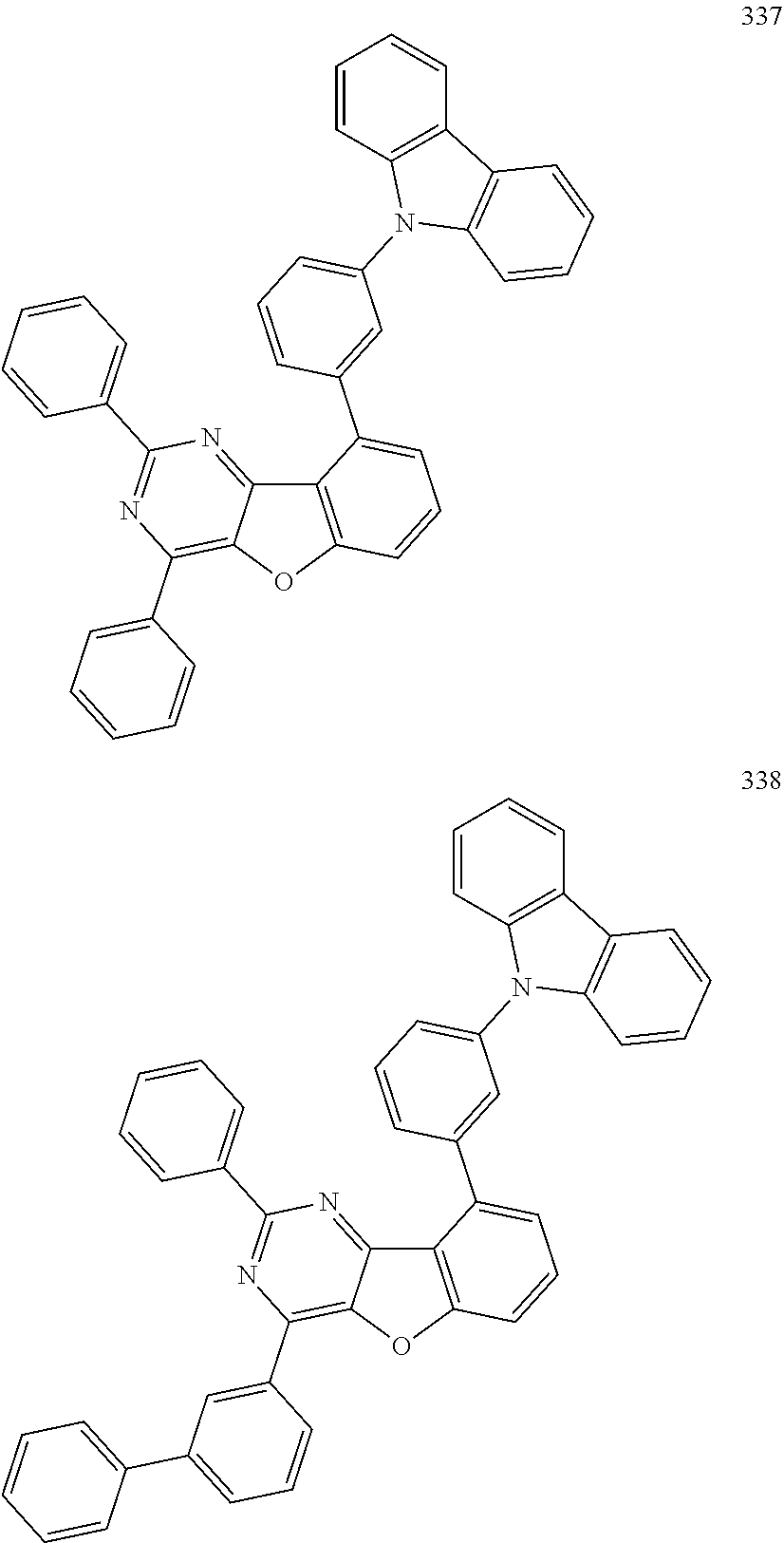
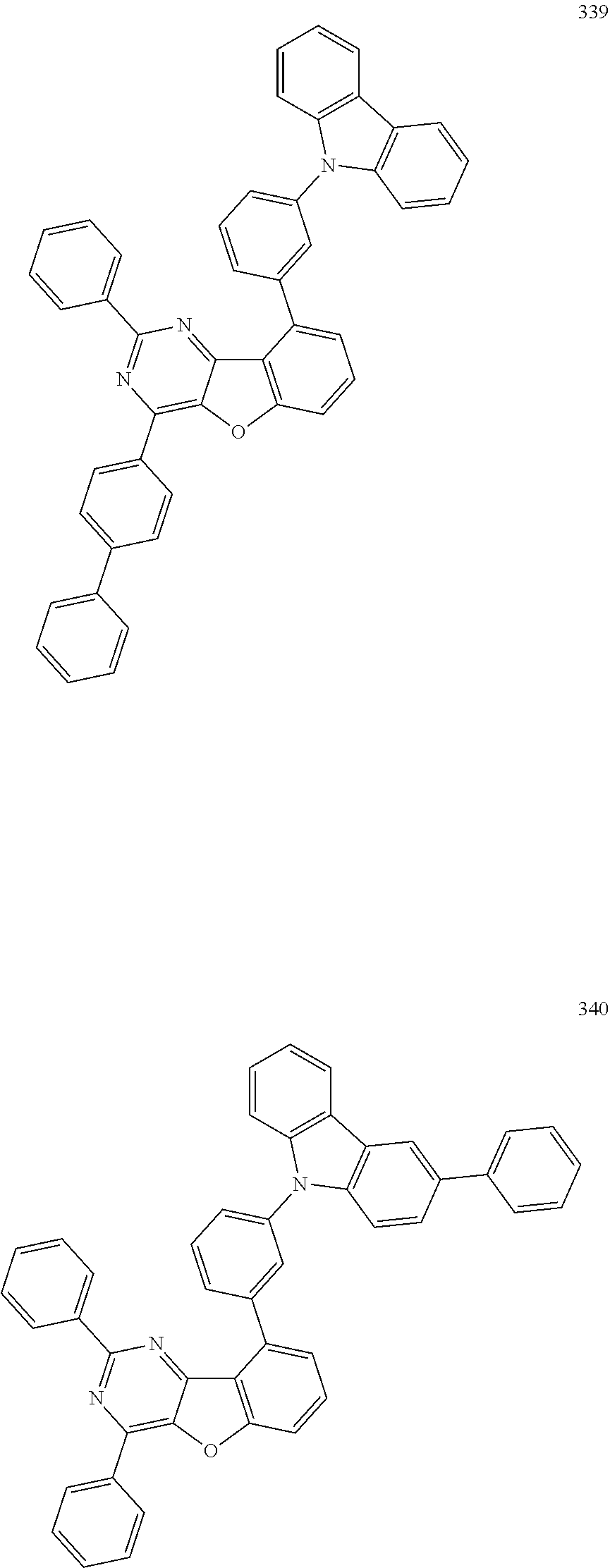



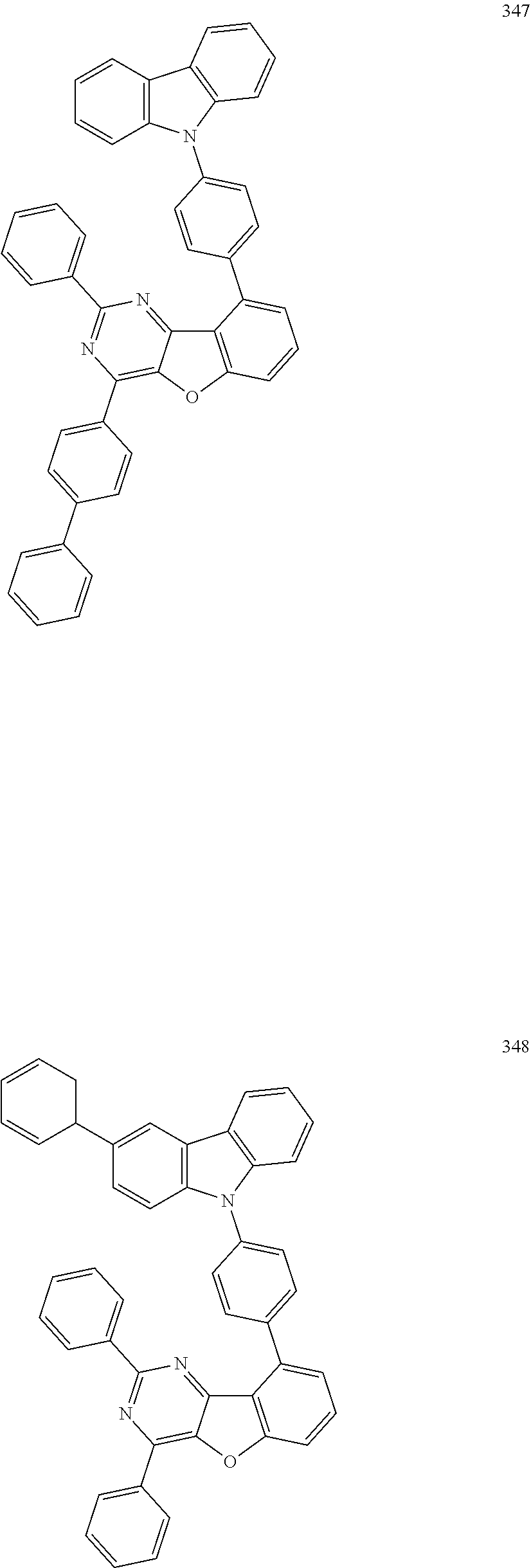
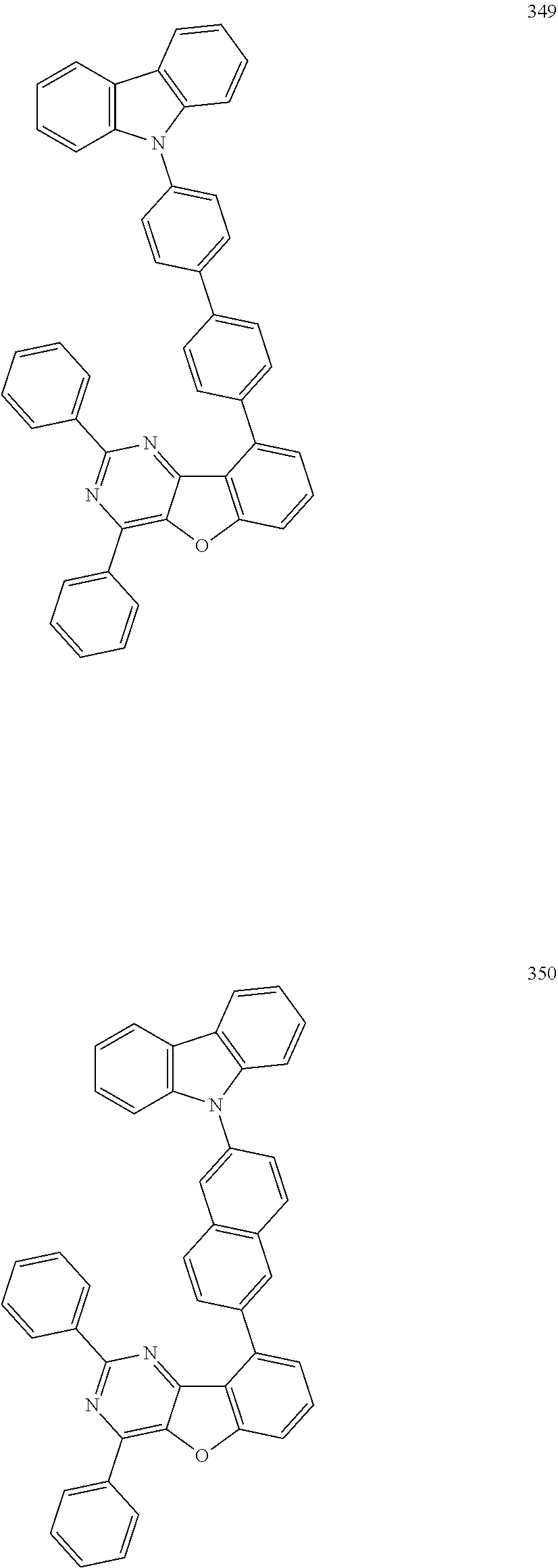


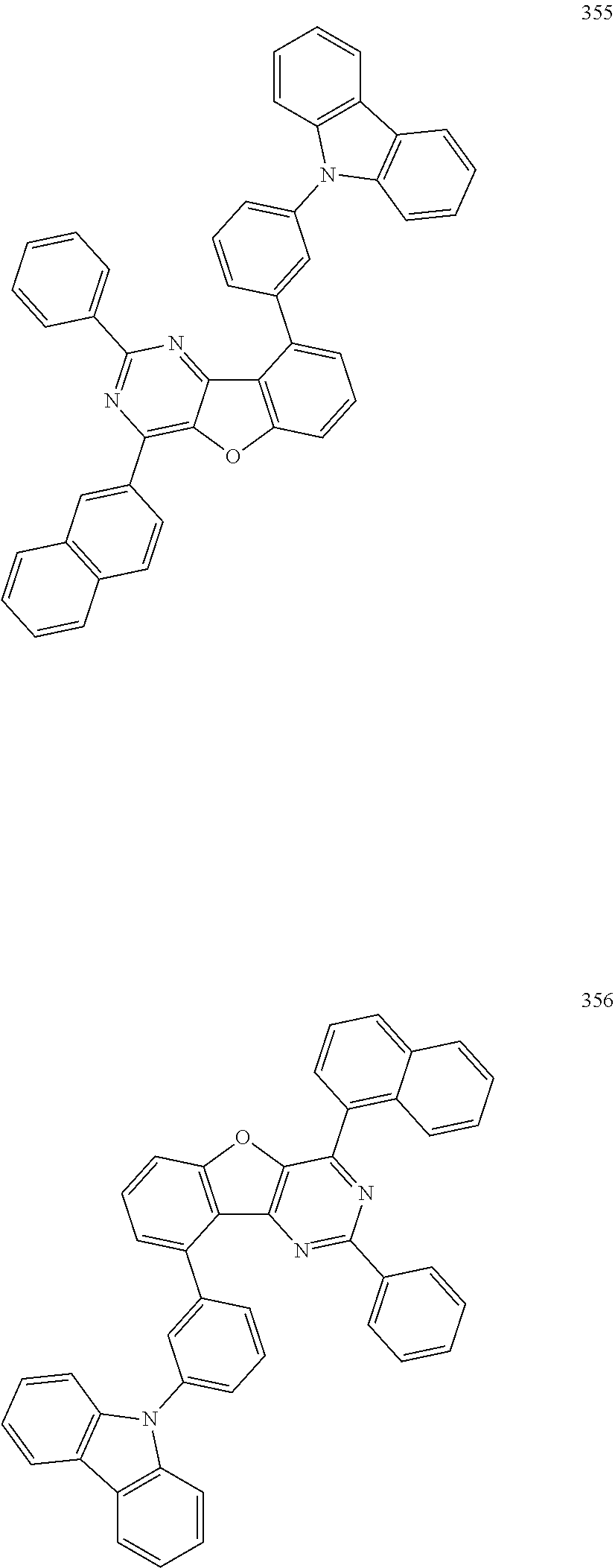





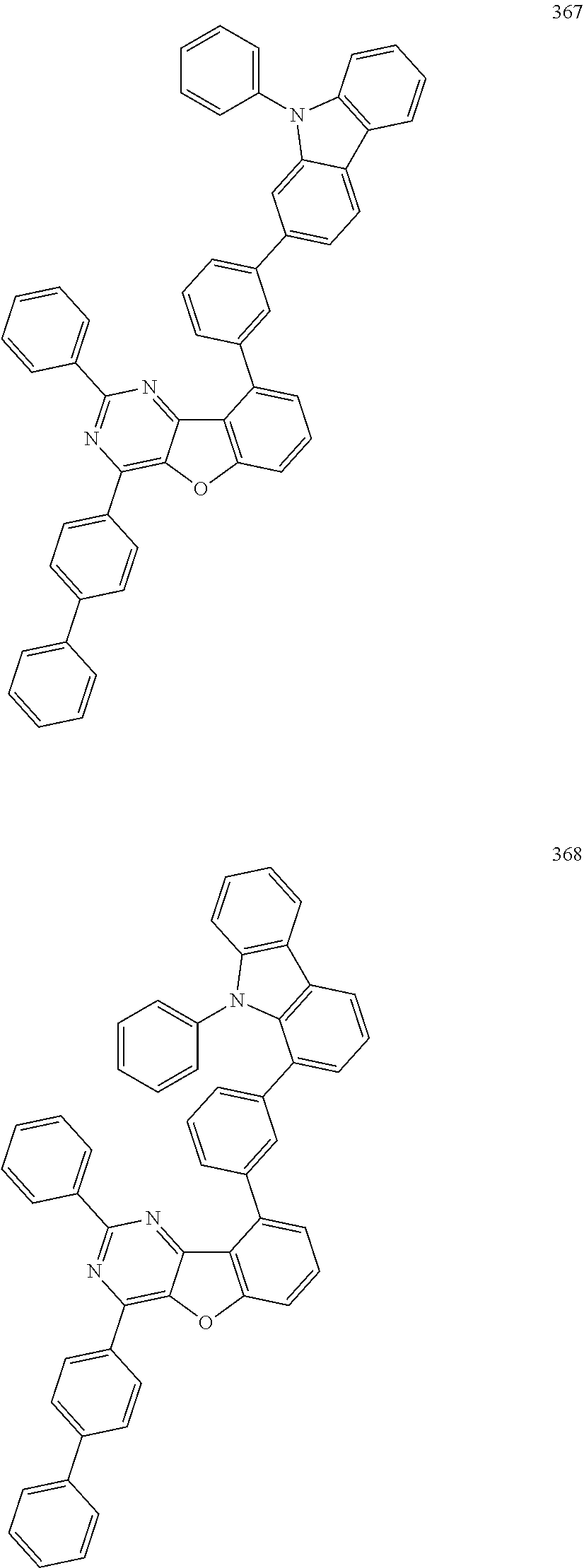


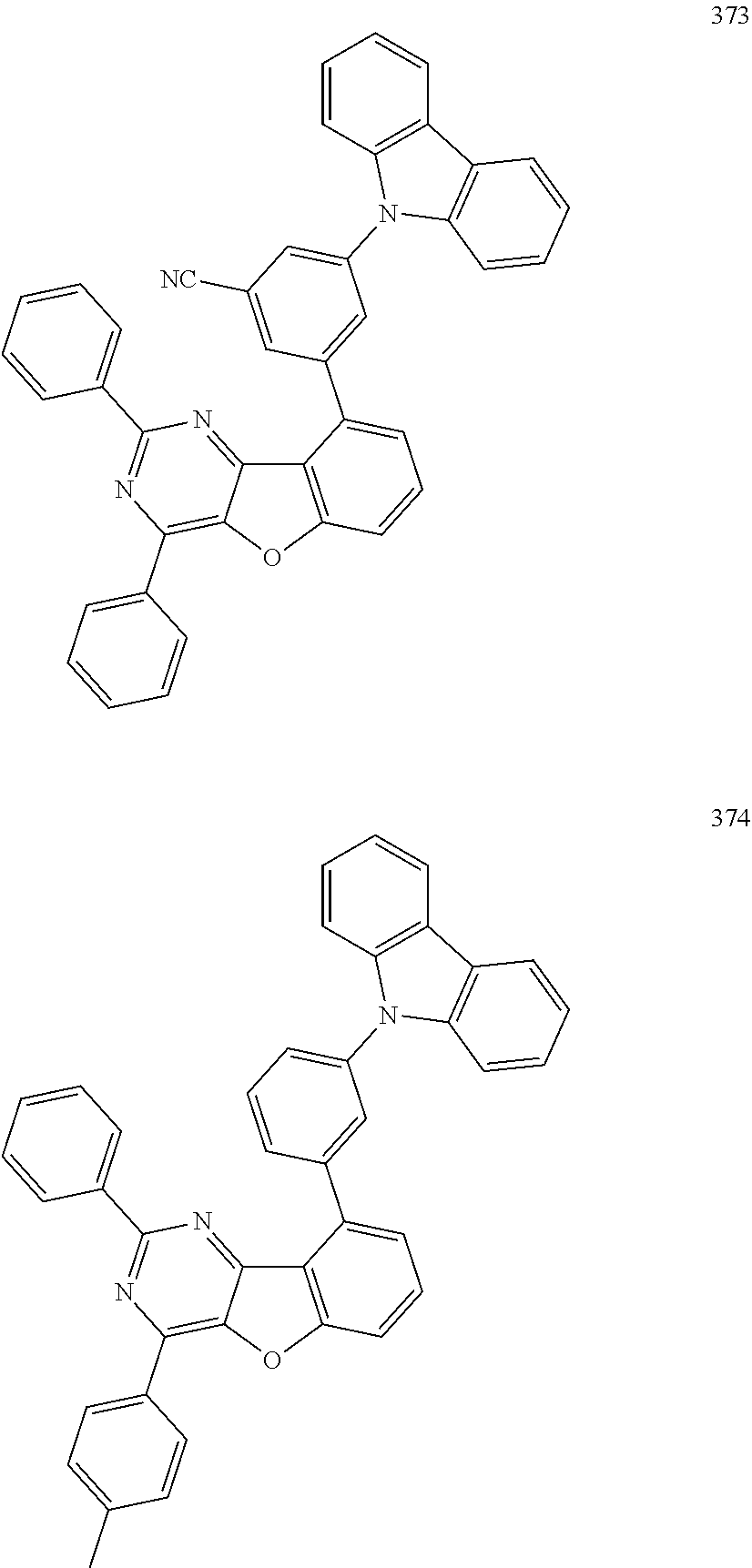

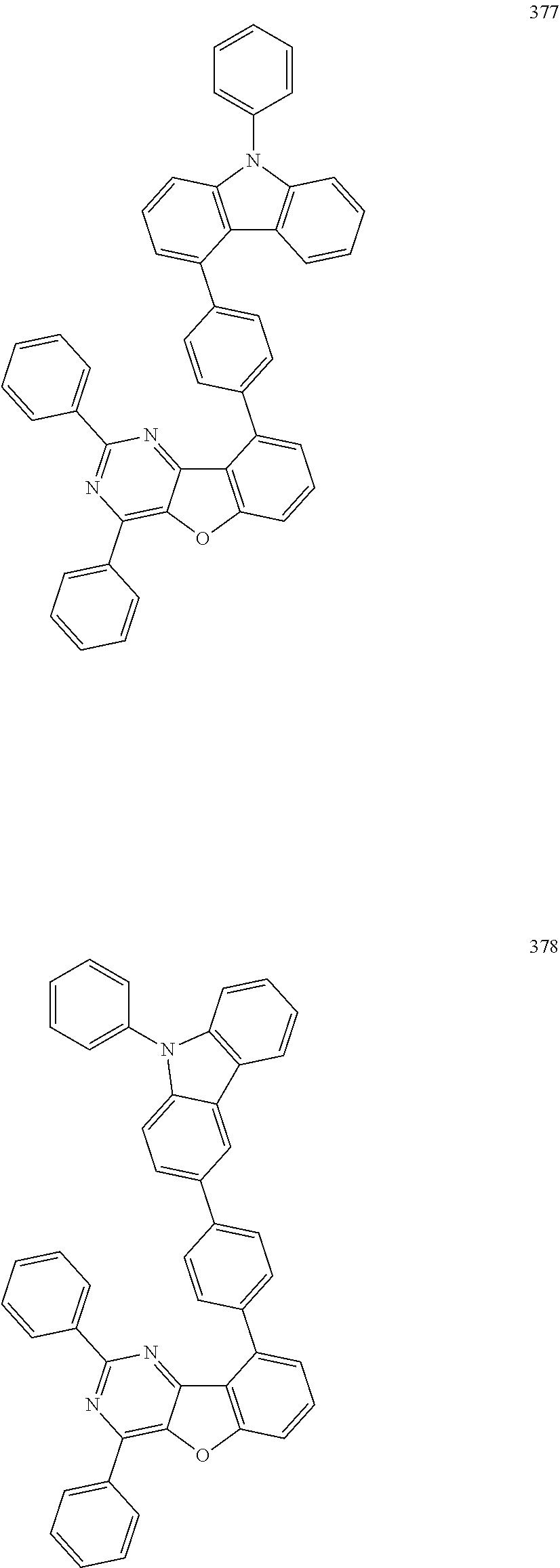
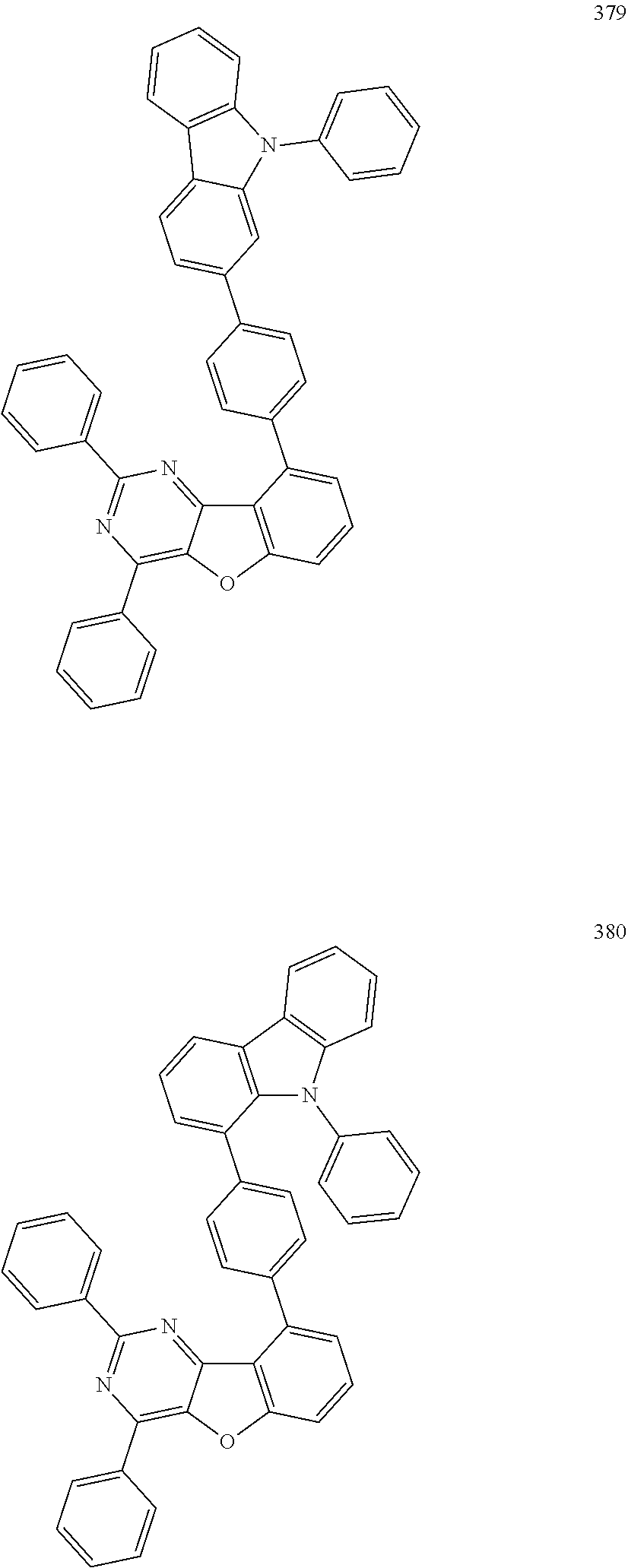
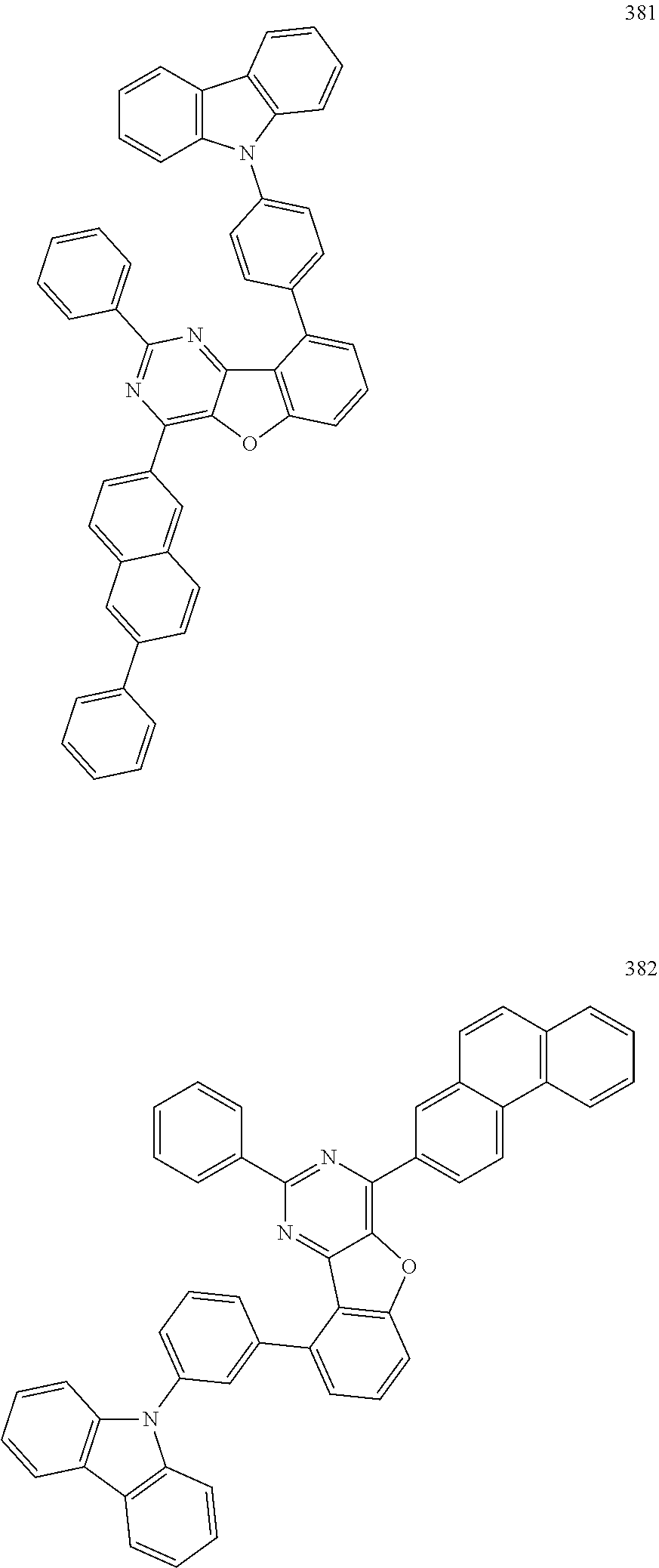



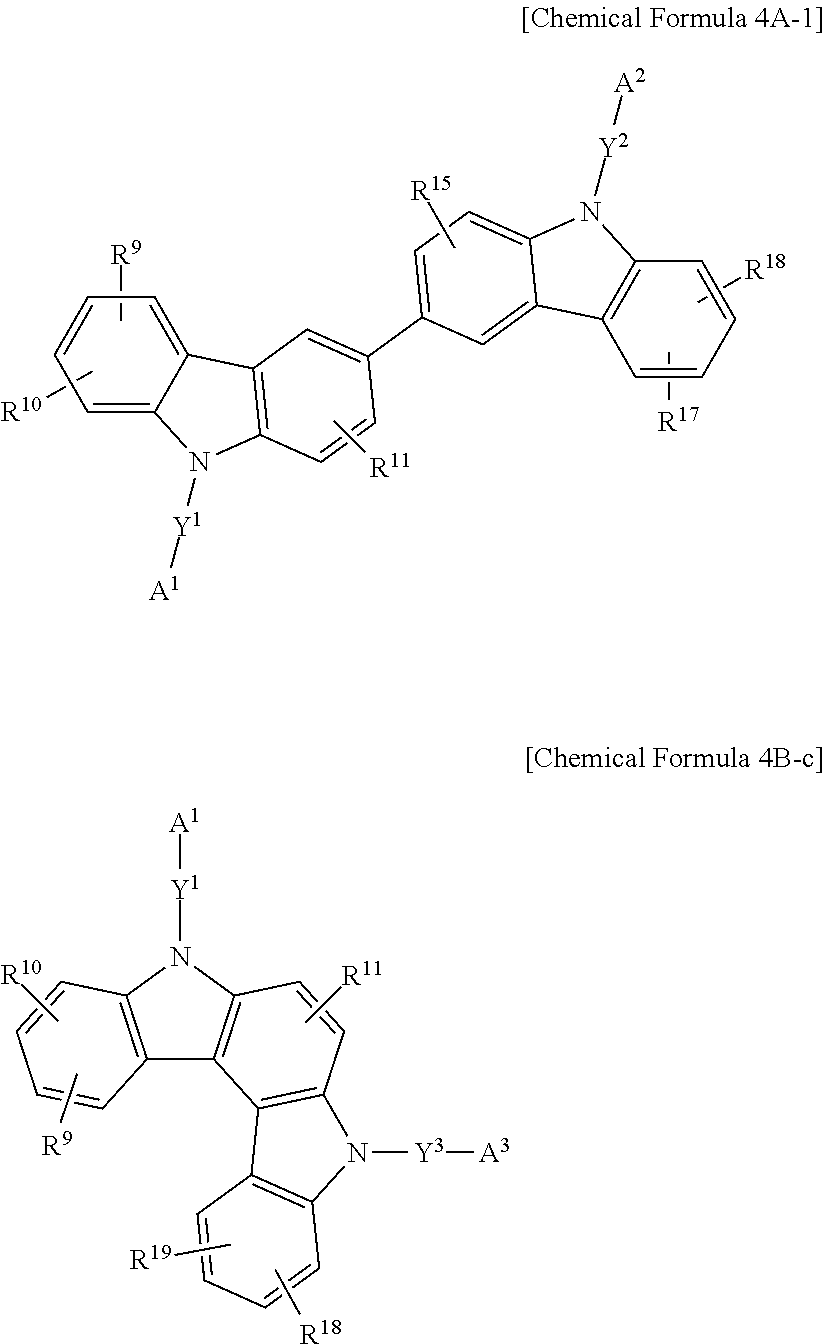
D00000
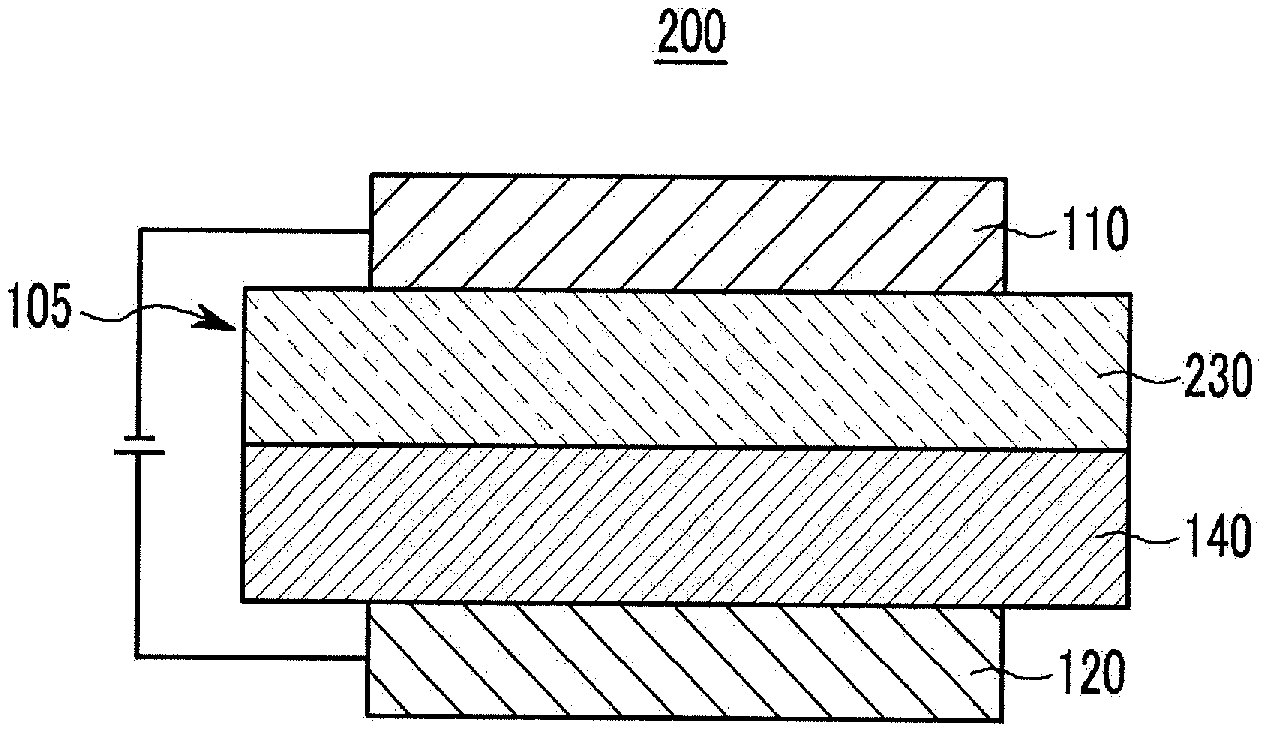
D00001
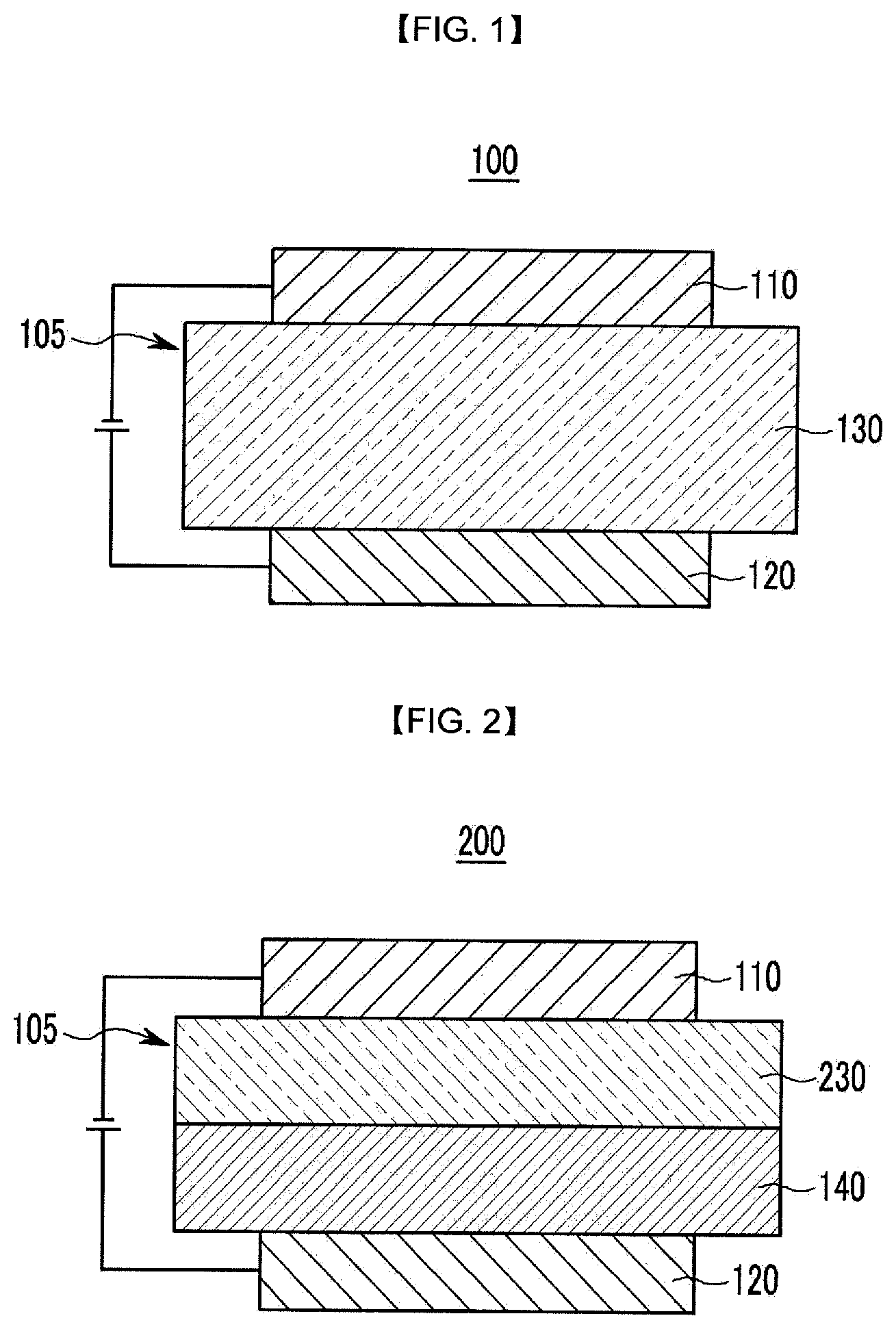
XML
uspto.report is an independent third-party trademark research tool that is not affiliated, endorsed, or sponsored by the United States Patent and Trademark Office (USPTO) or any other governmental organization. The information provided by uspto.report is based on publicly available data at the time of writing and is intended for informational purposes only.
While we strive to provide accurate and up-to-date information, we do not guarantee the accuracy, completeness, reliability, or suitability of the information displayed on this site. The use of this site is at your own risk. Any reliance you place on such information is therefore strictly at your own risk.
All official trademark data, including owner information, should be verified by visiting the official USPTO website at www.uspto.gov. This site is not intended to replace professional legal advice and should not be used as a substitute for consulting with a legal professional who is knowledgeable about trademark law.